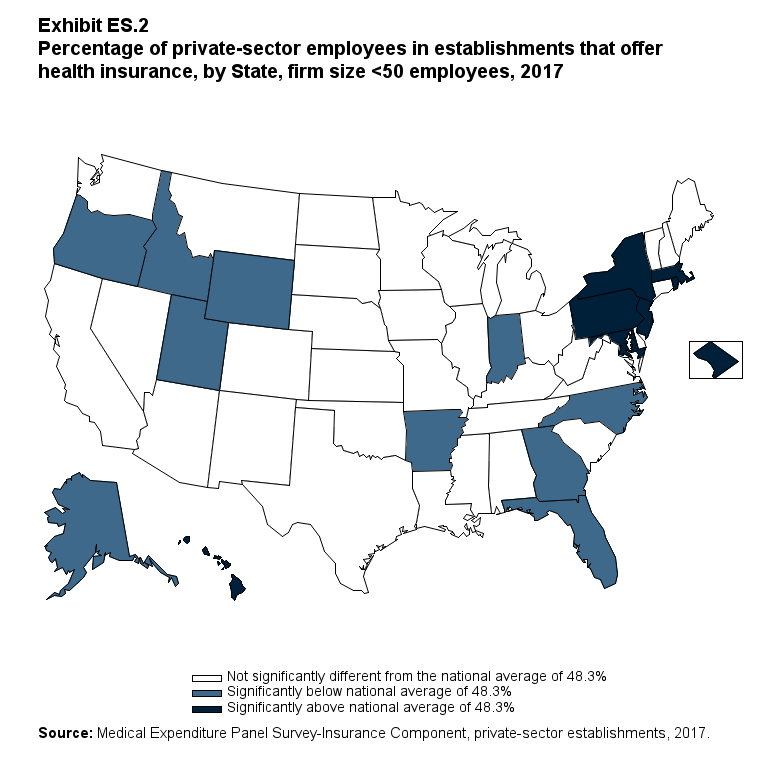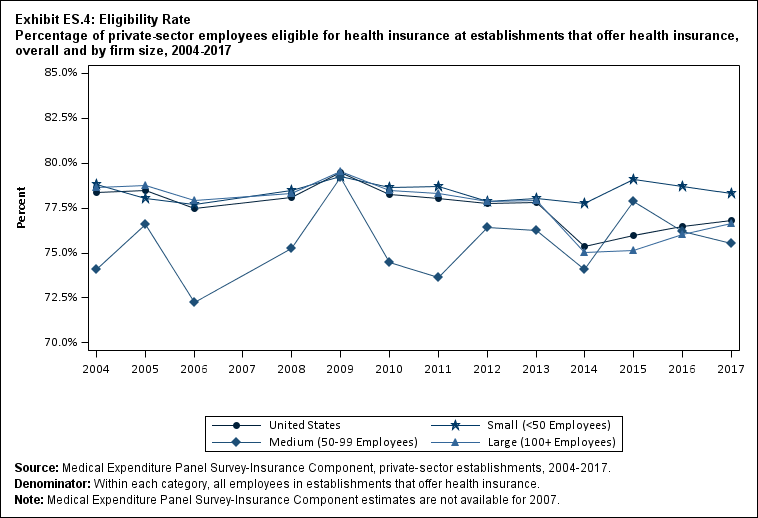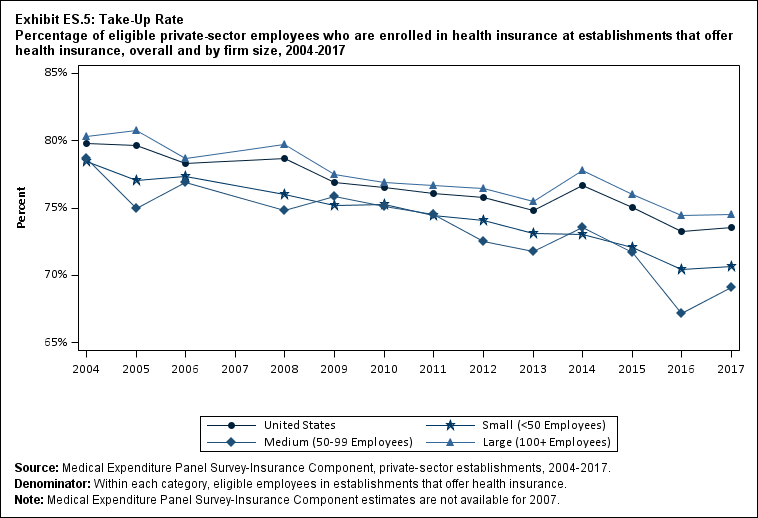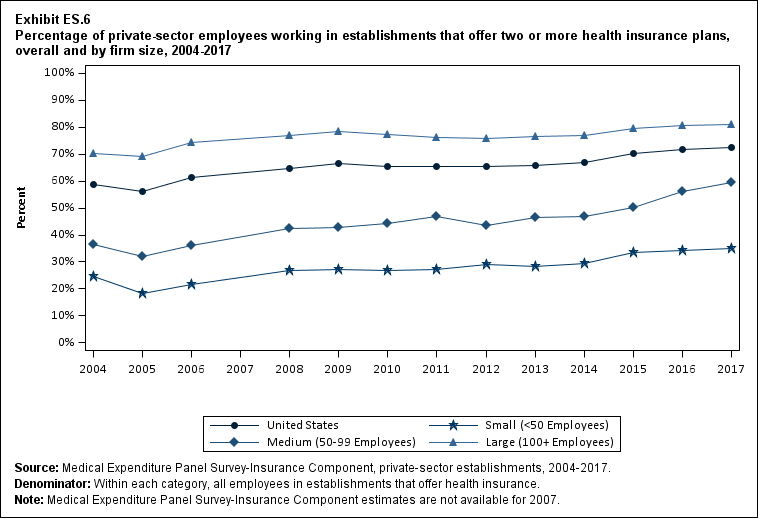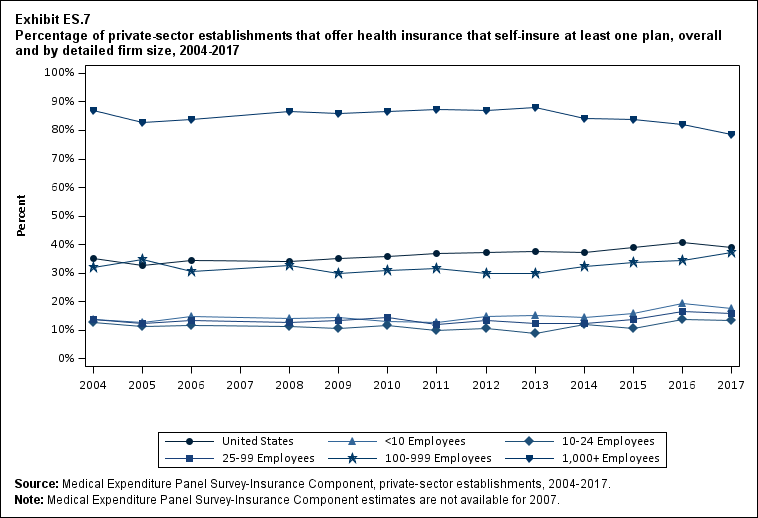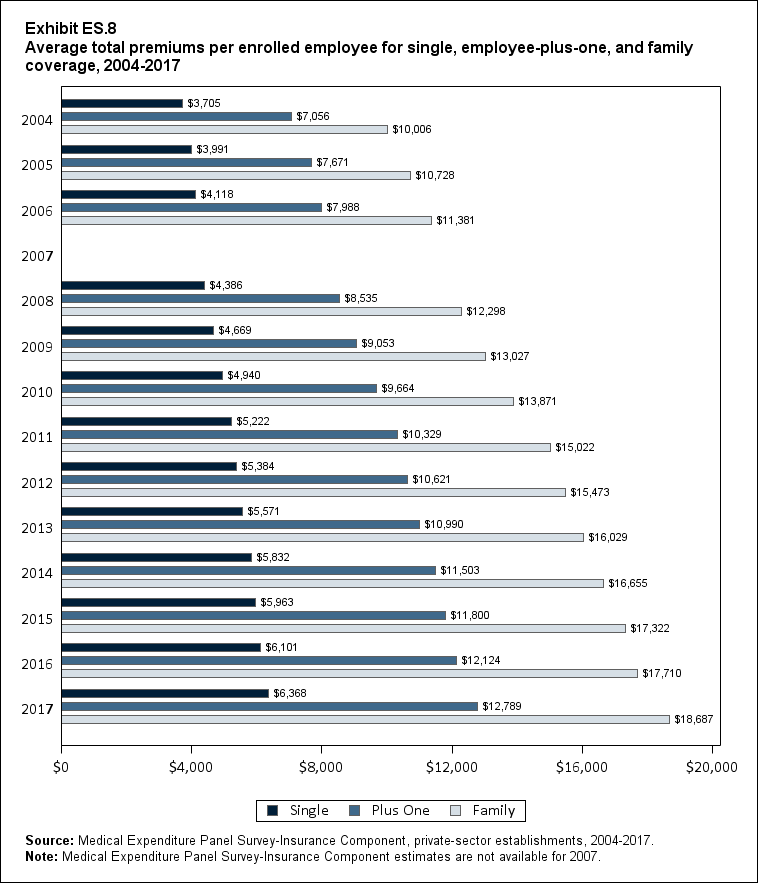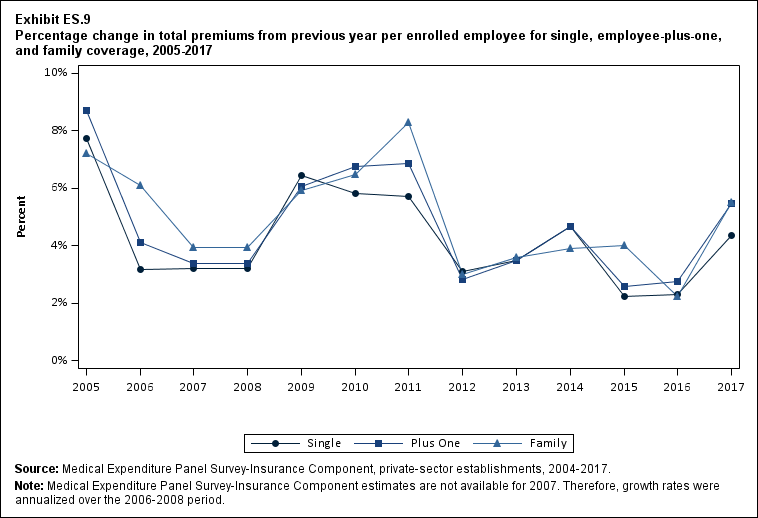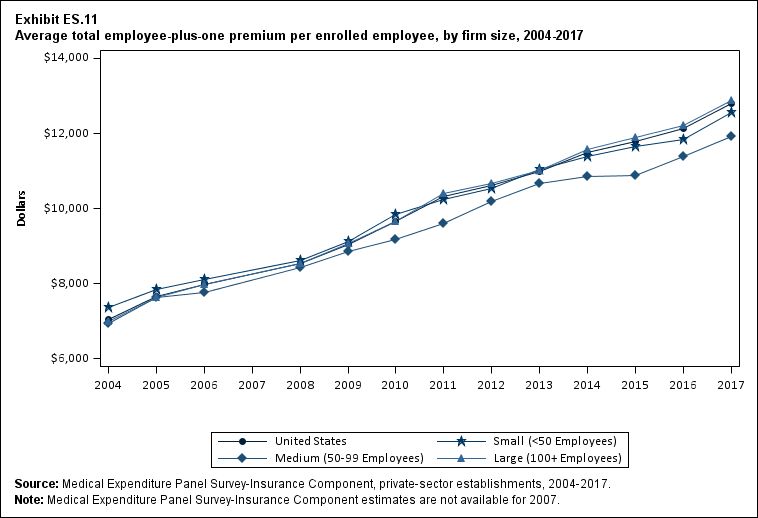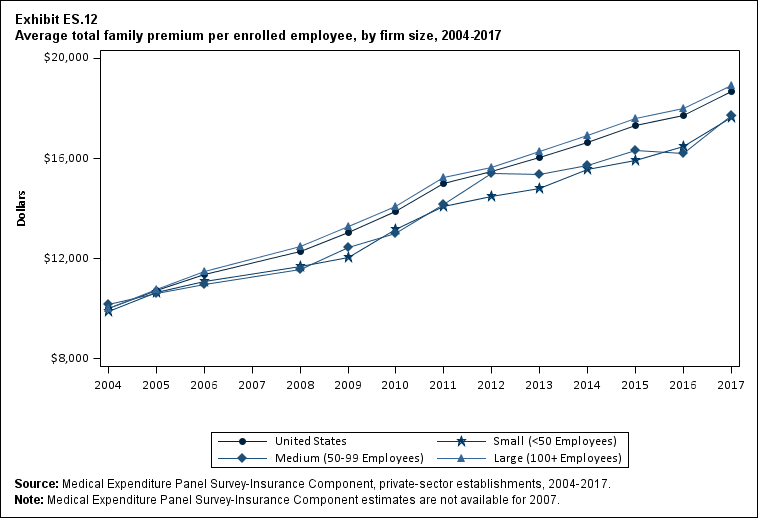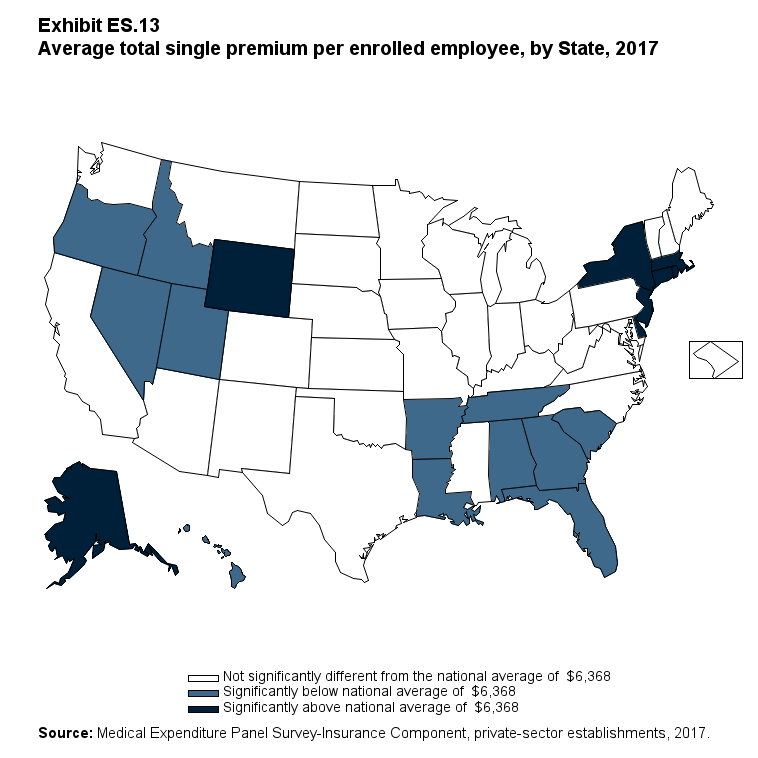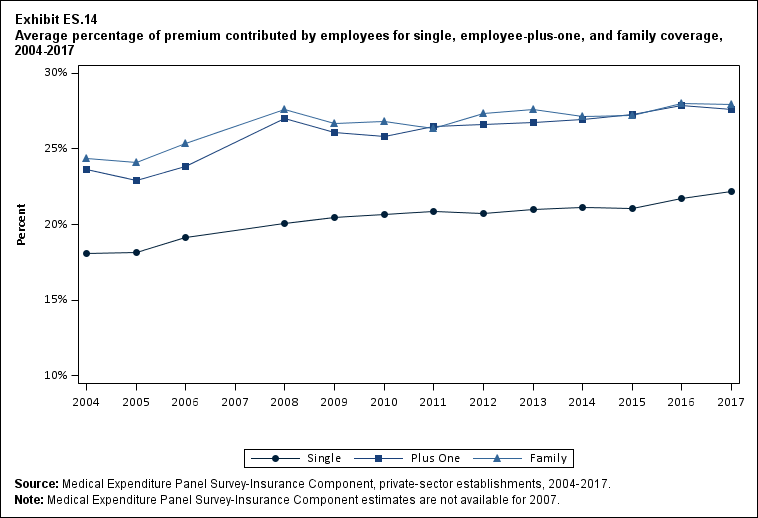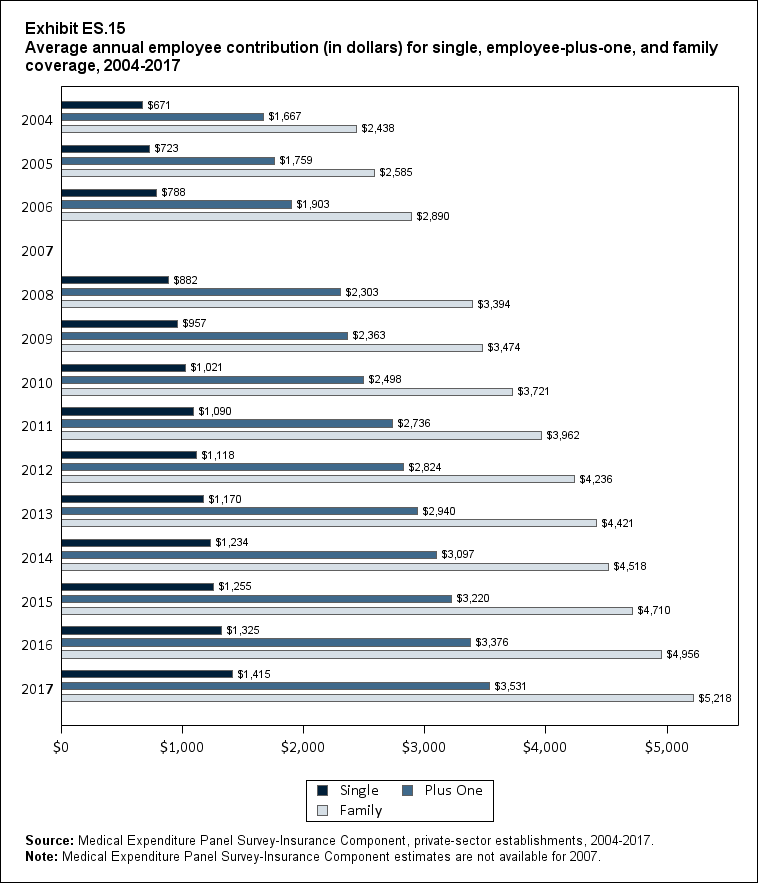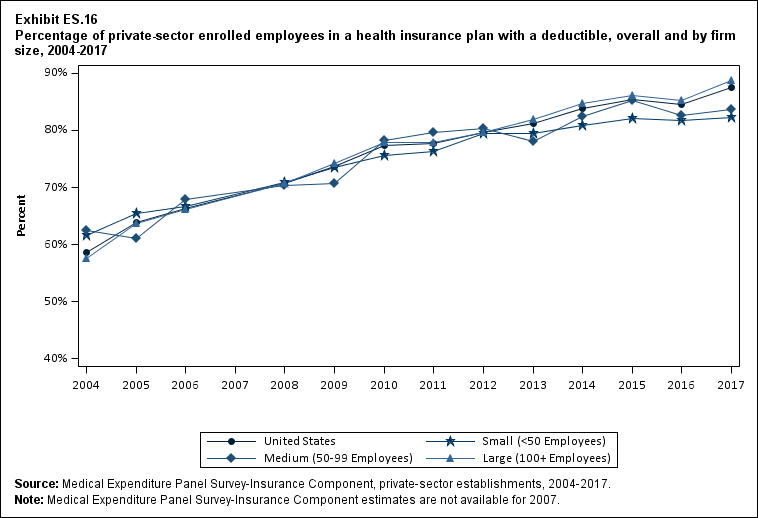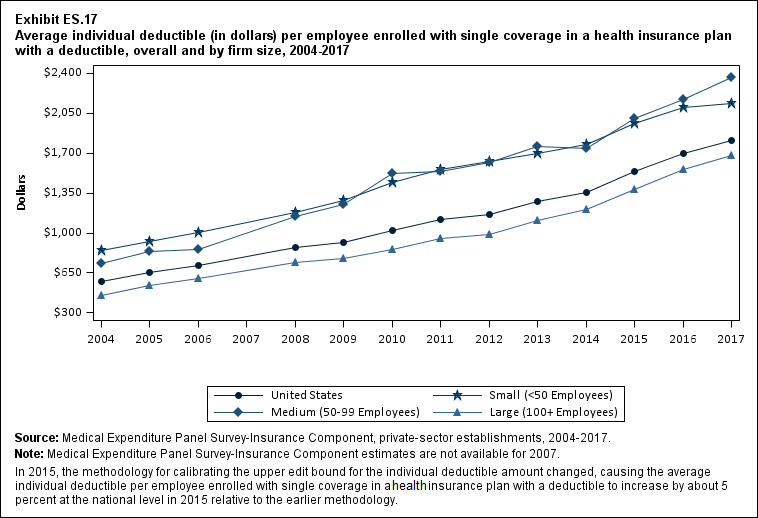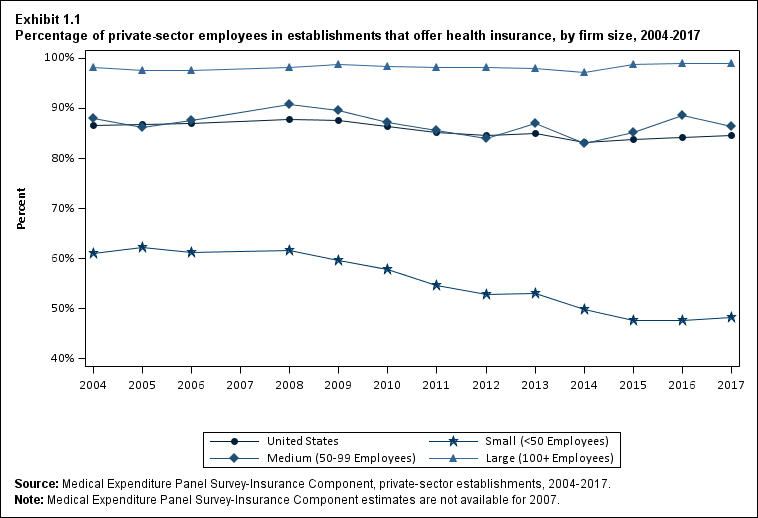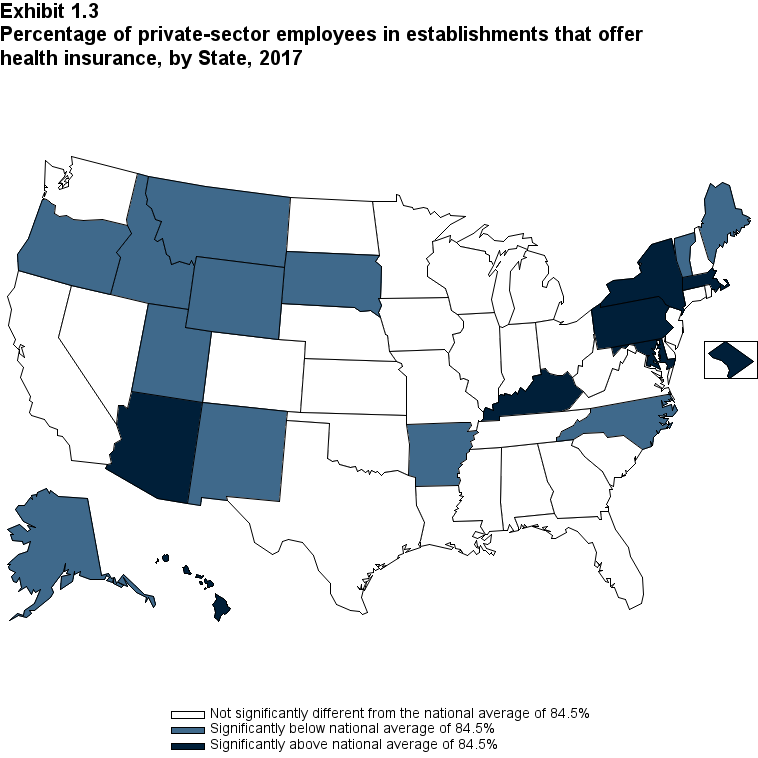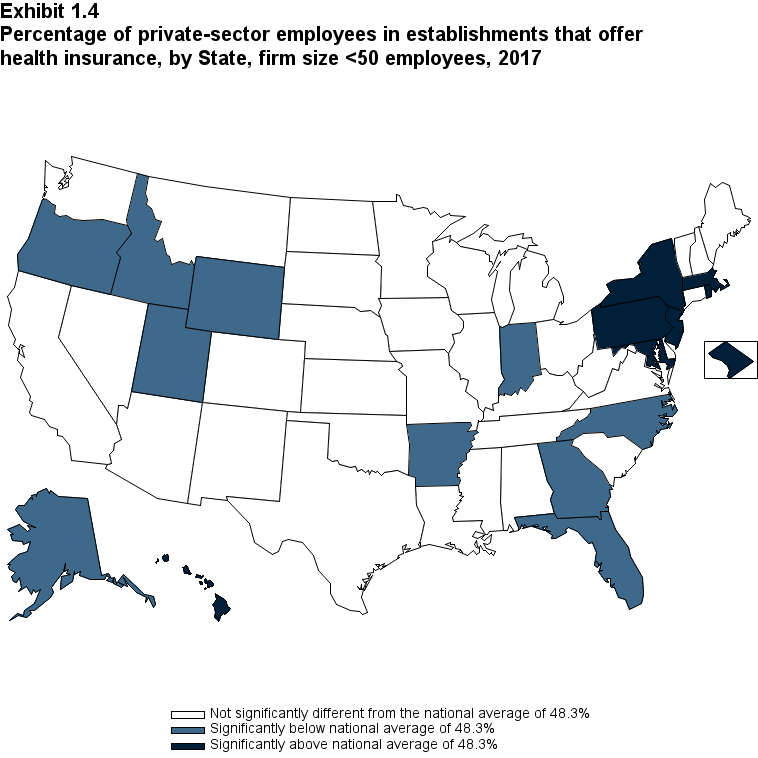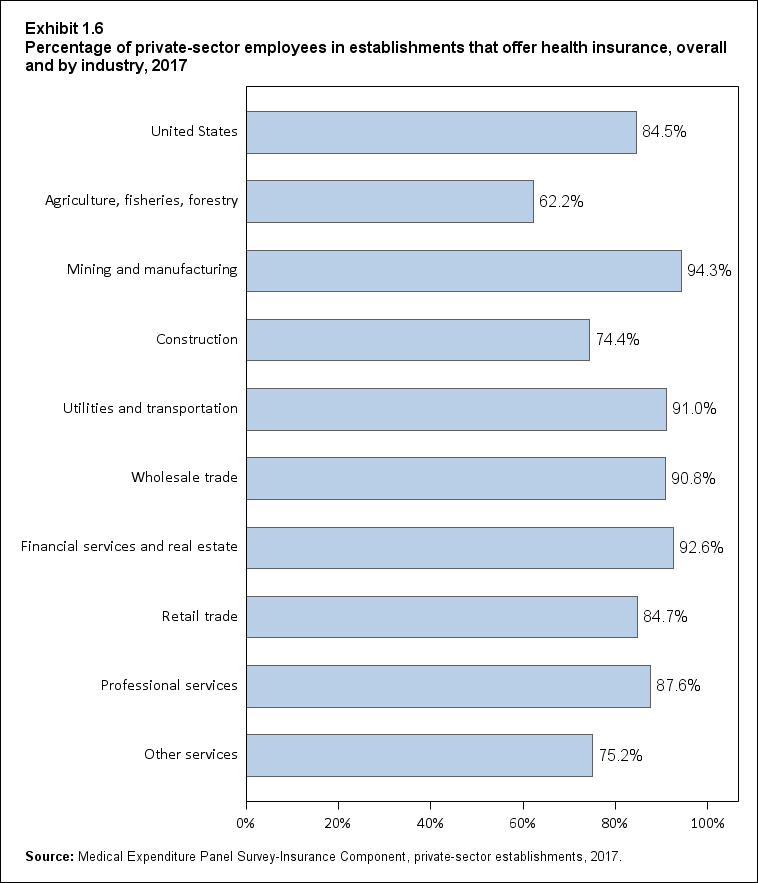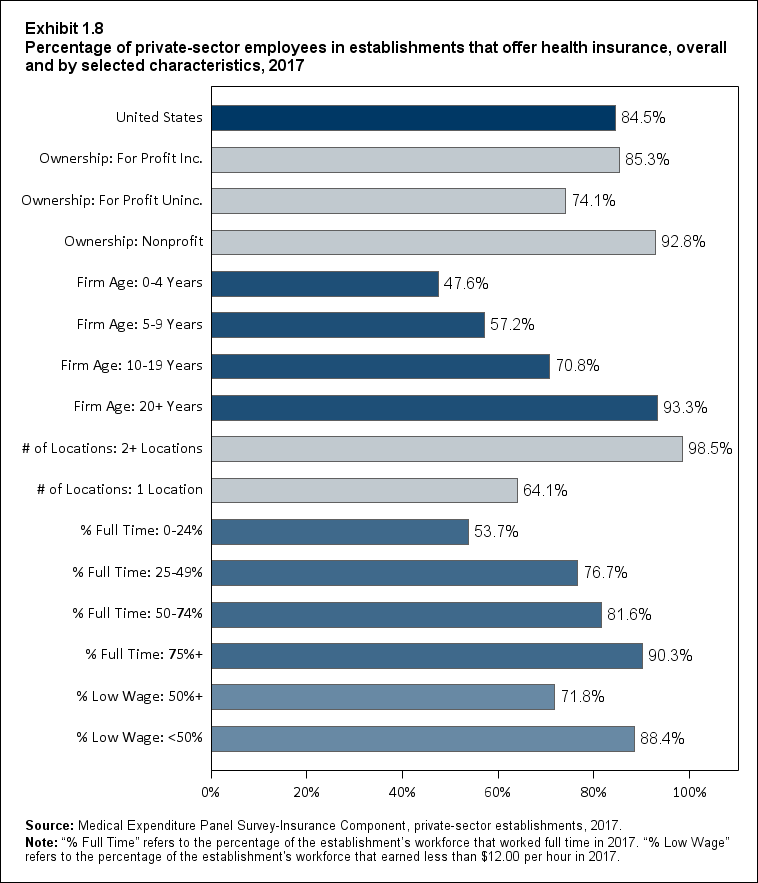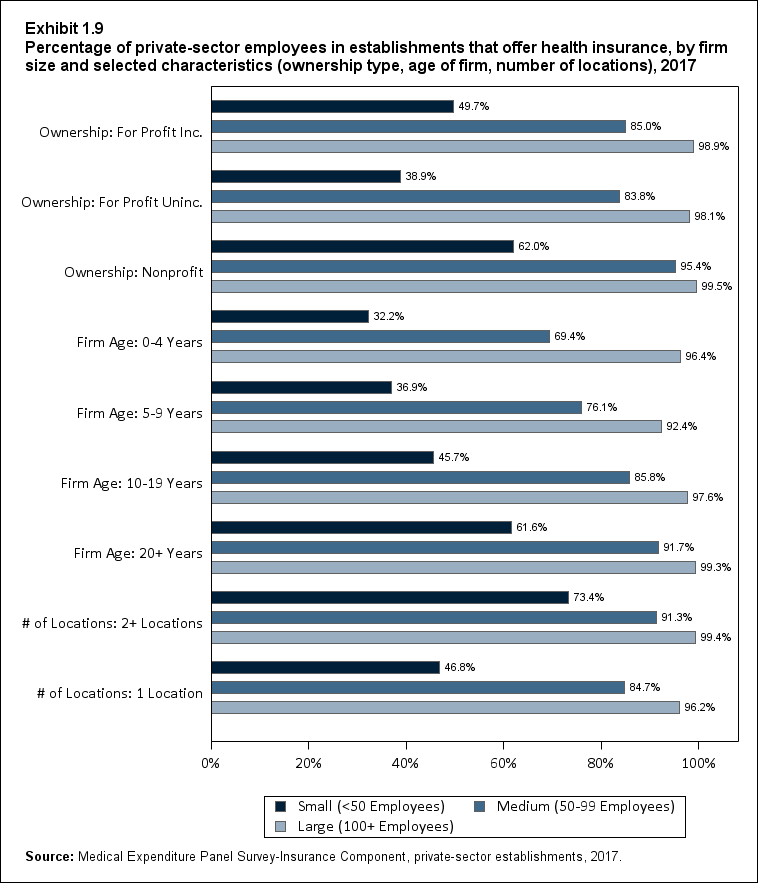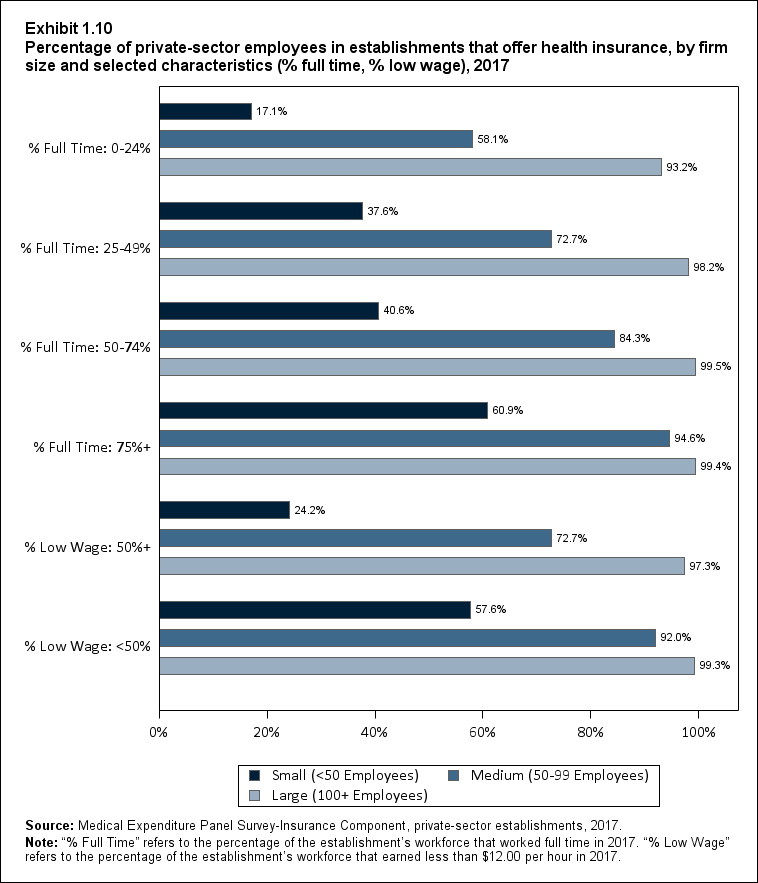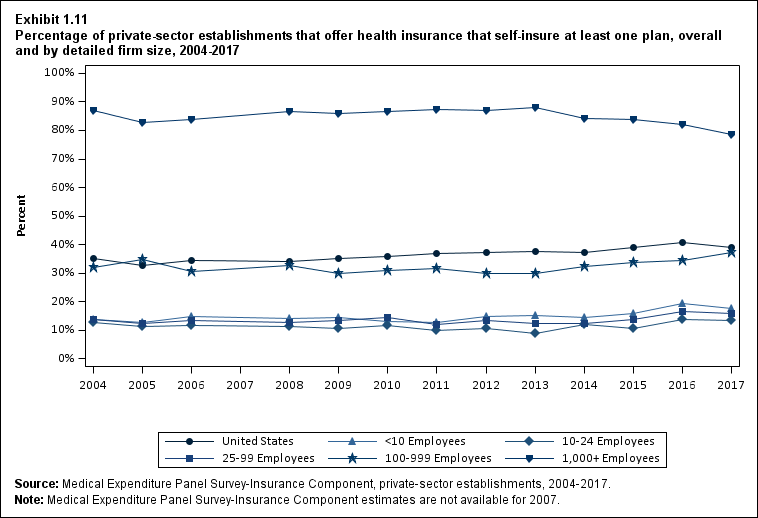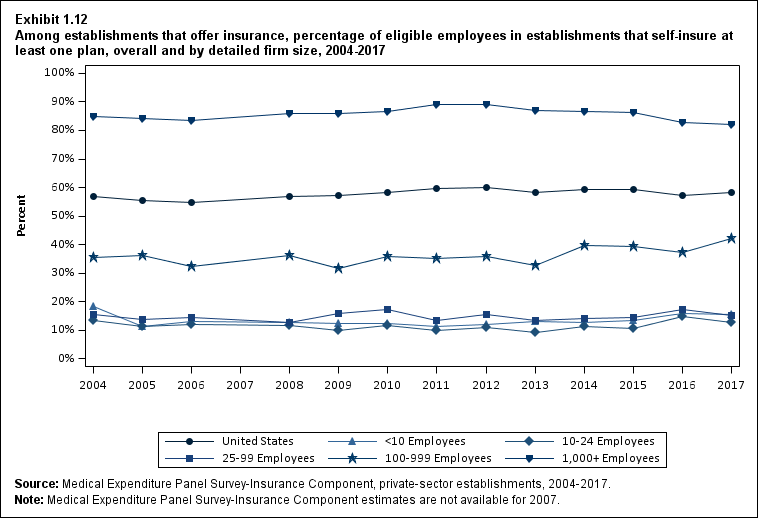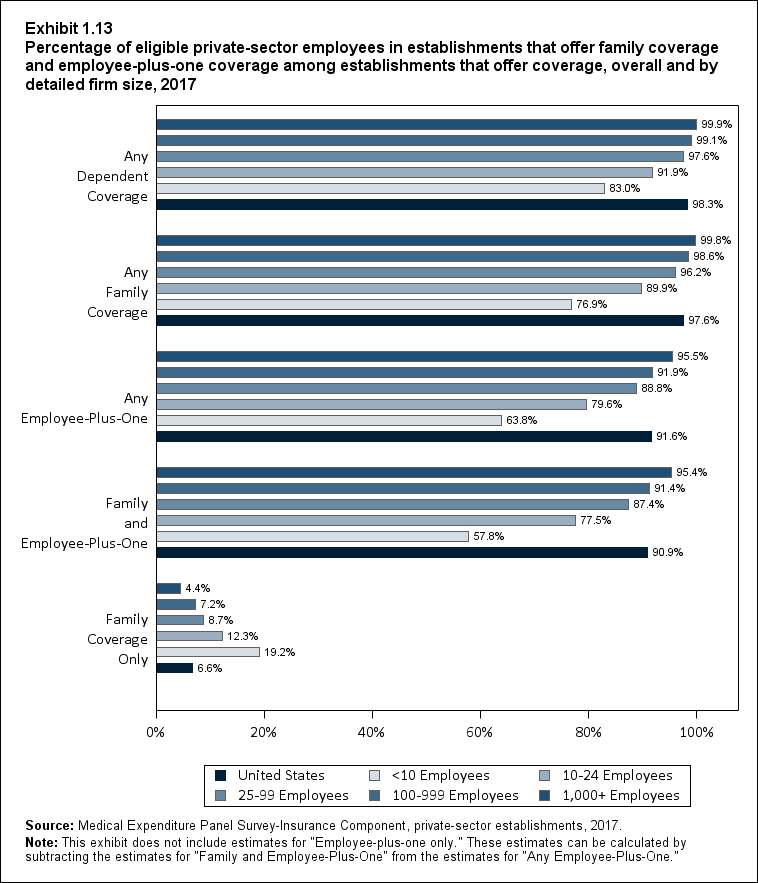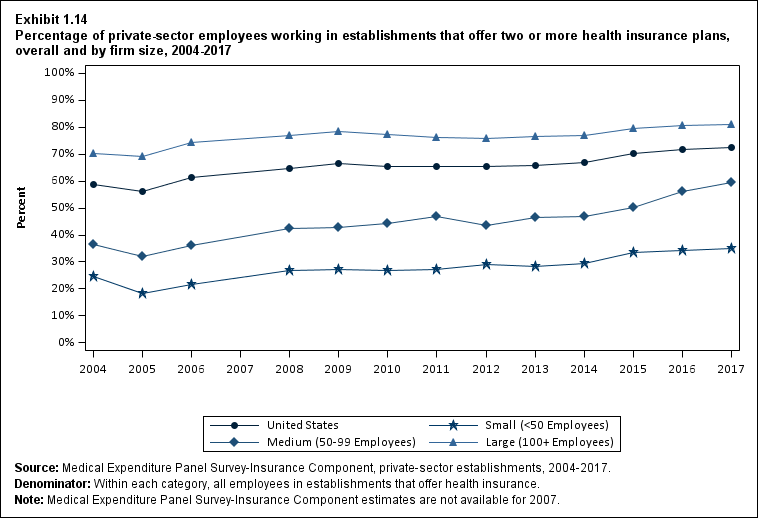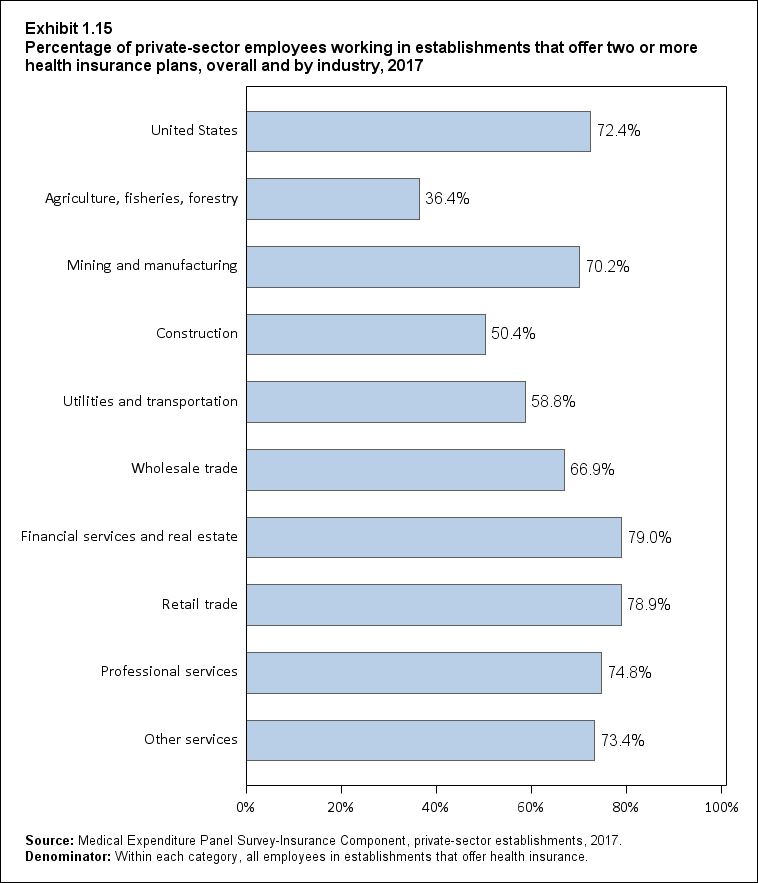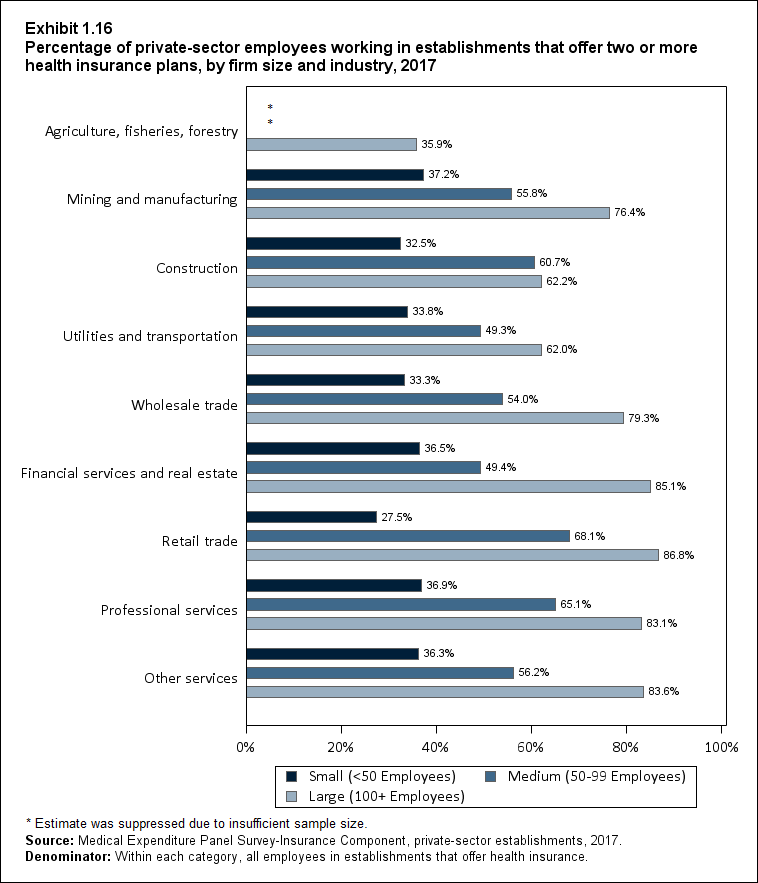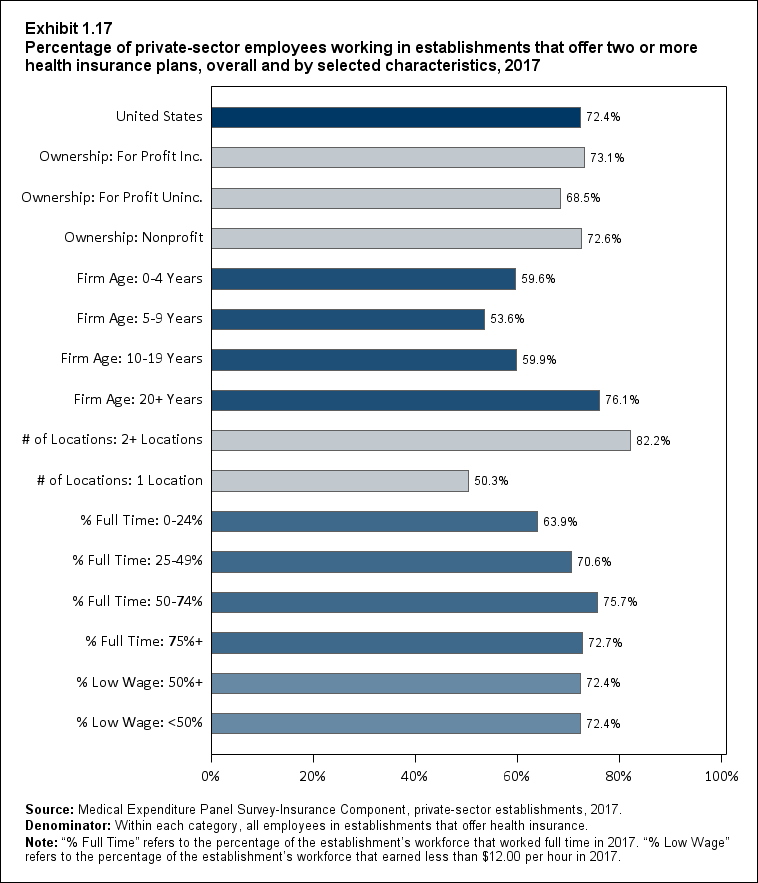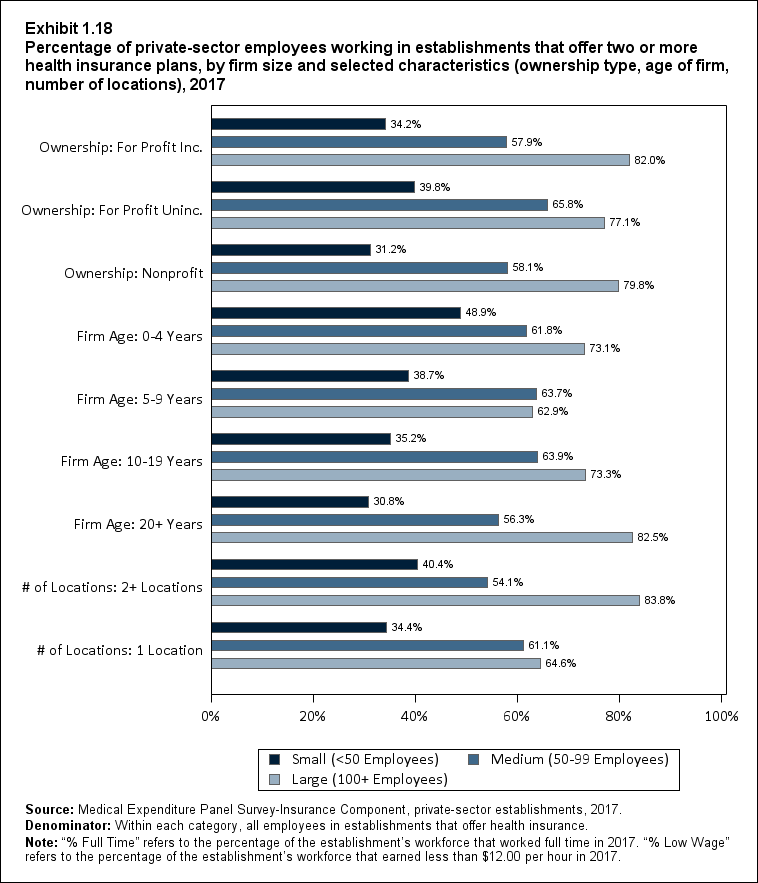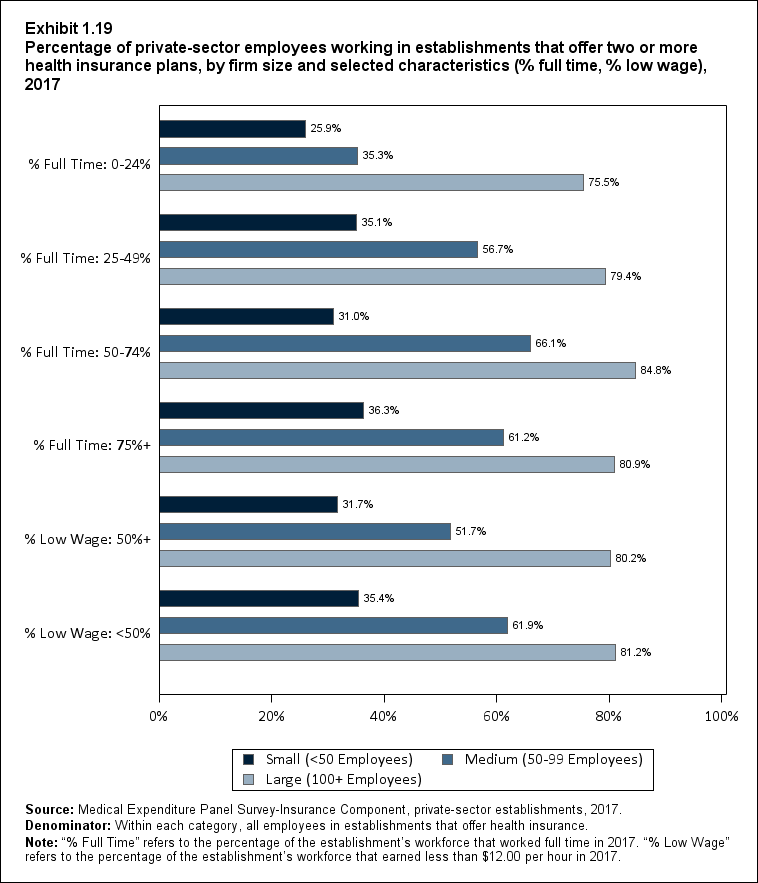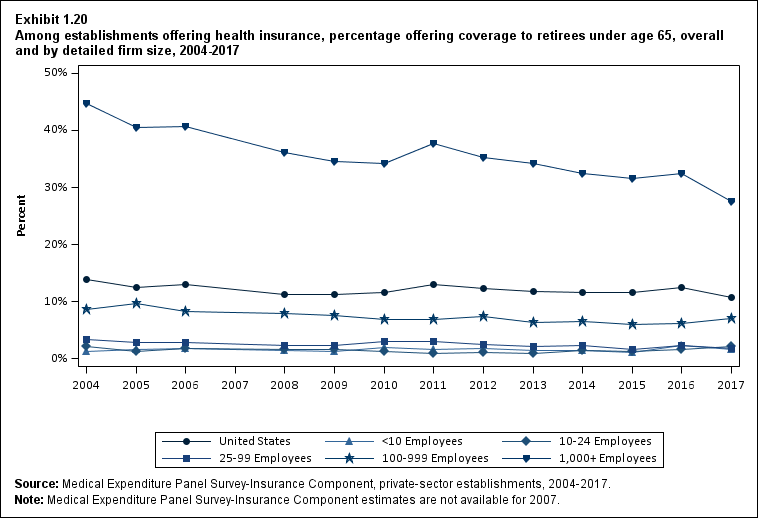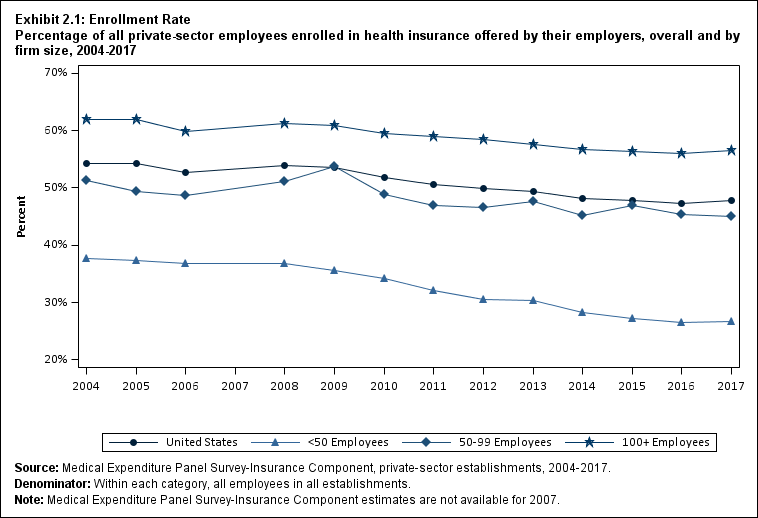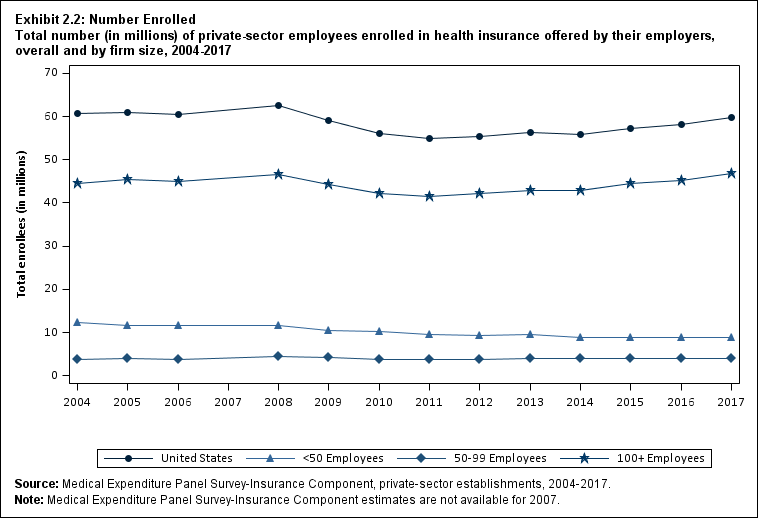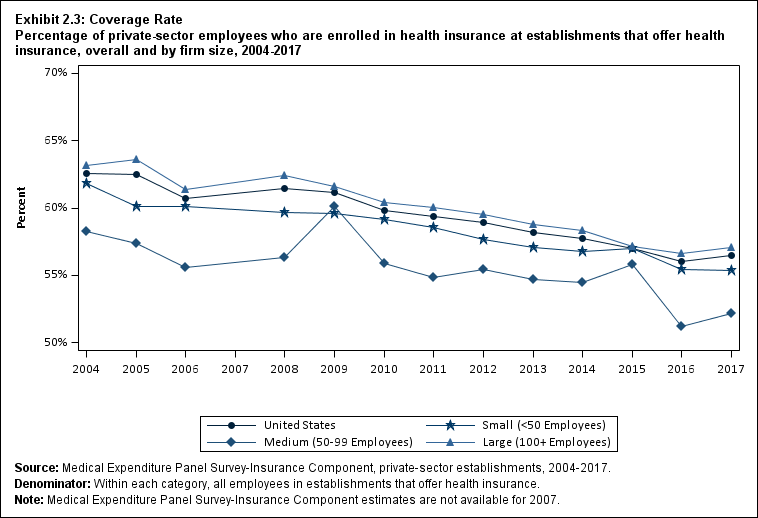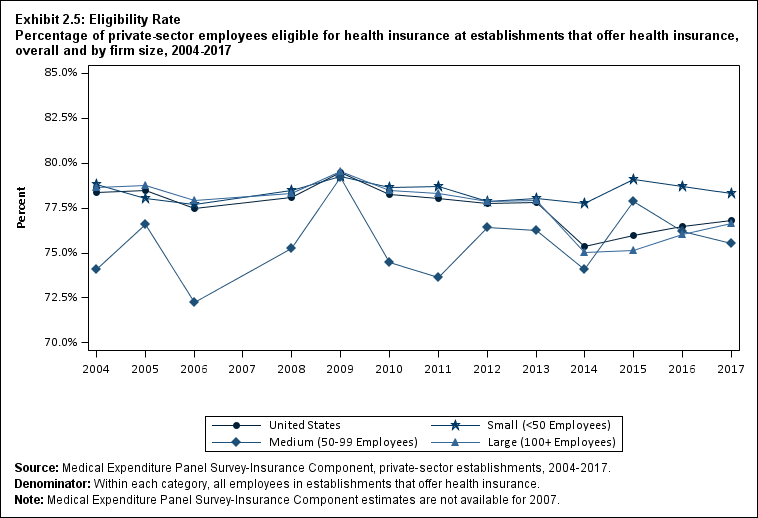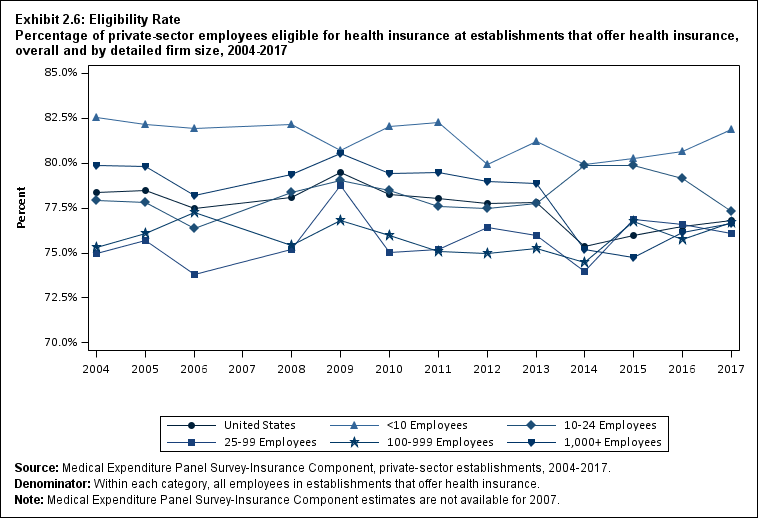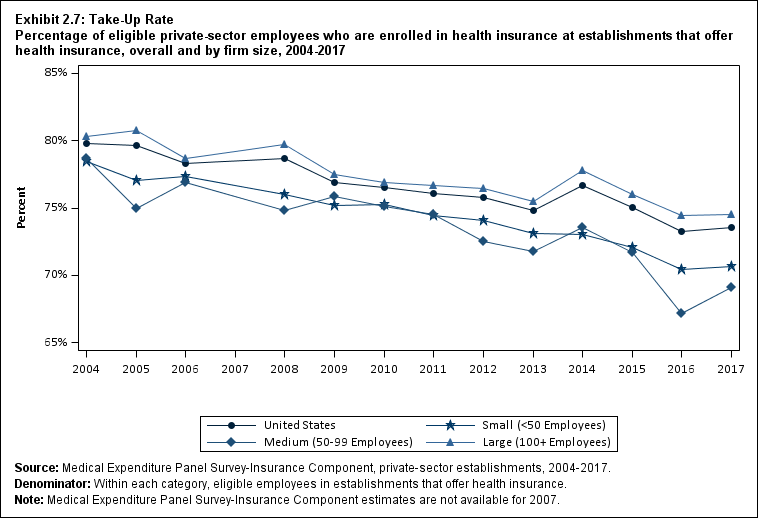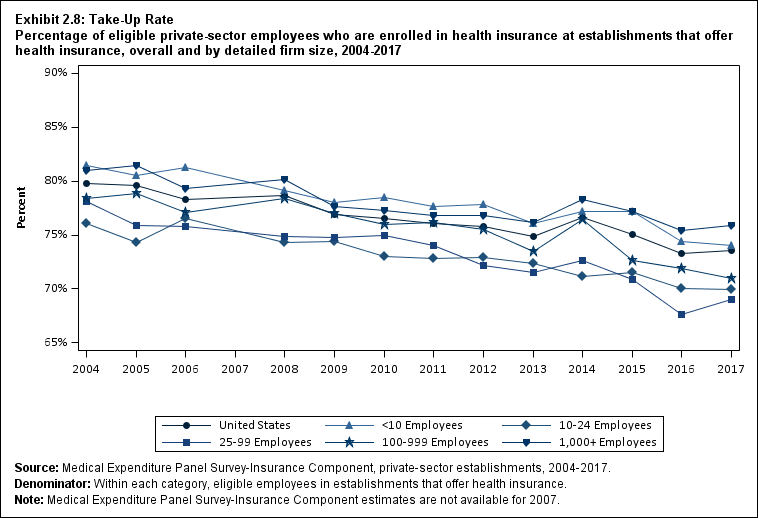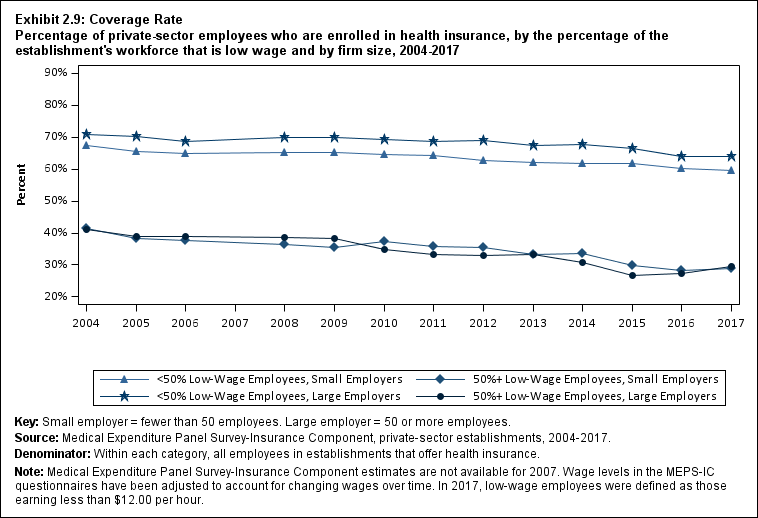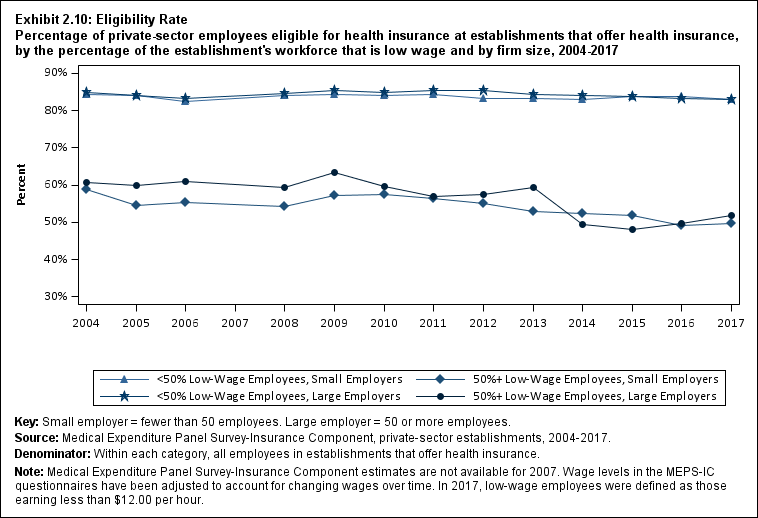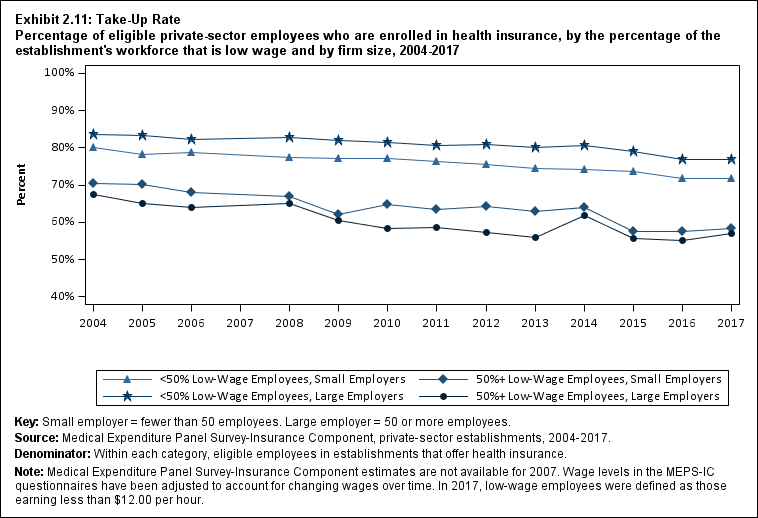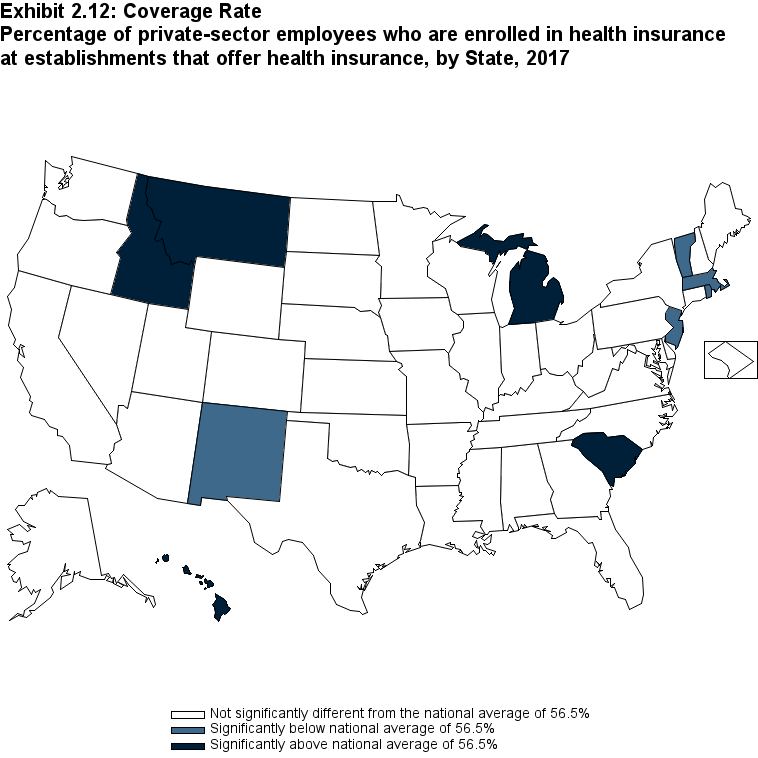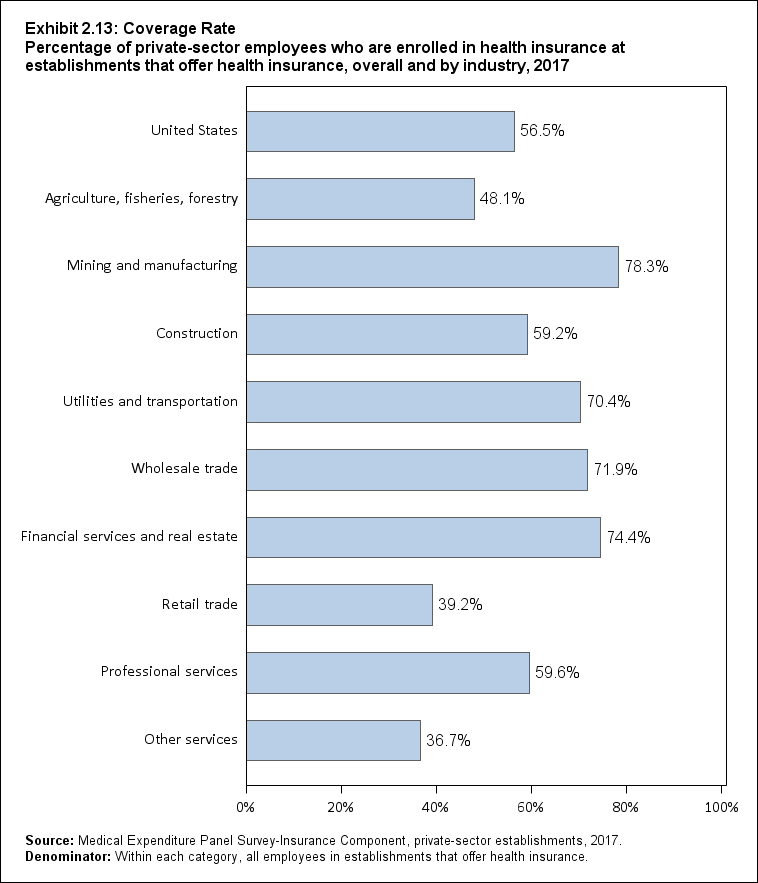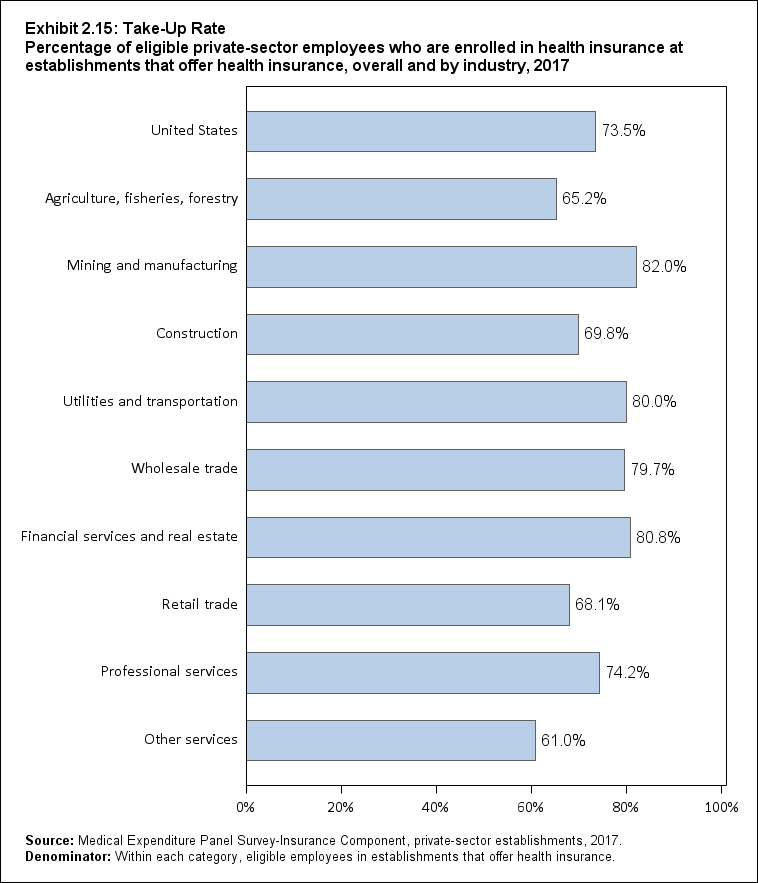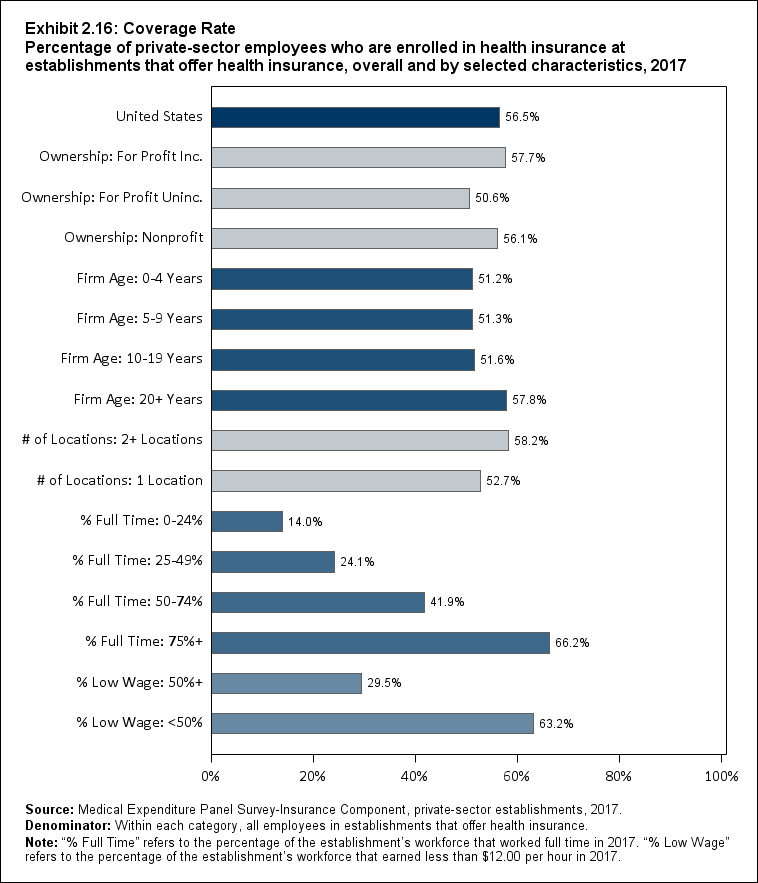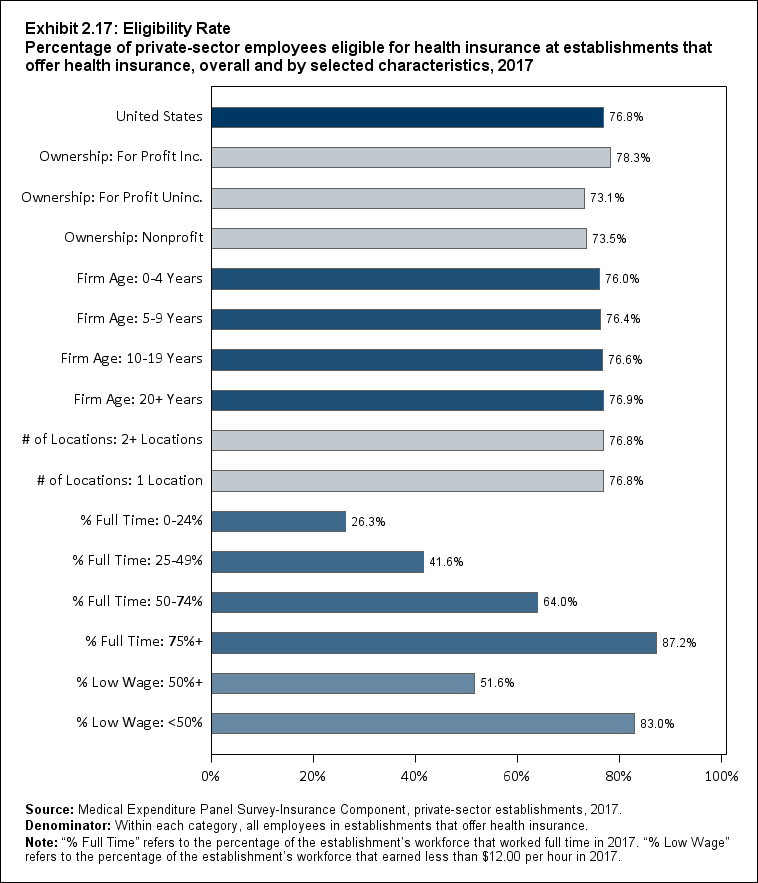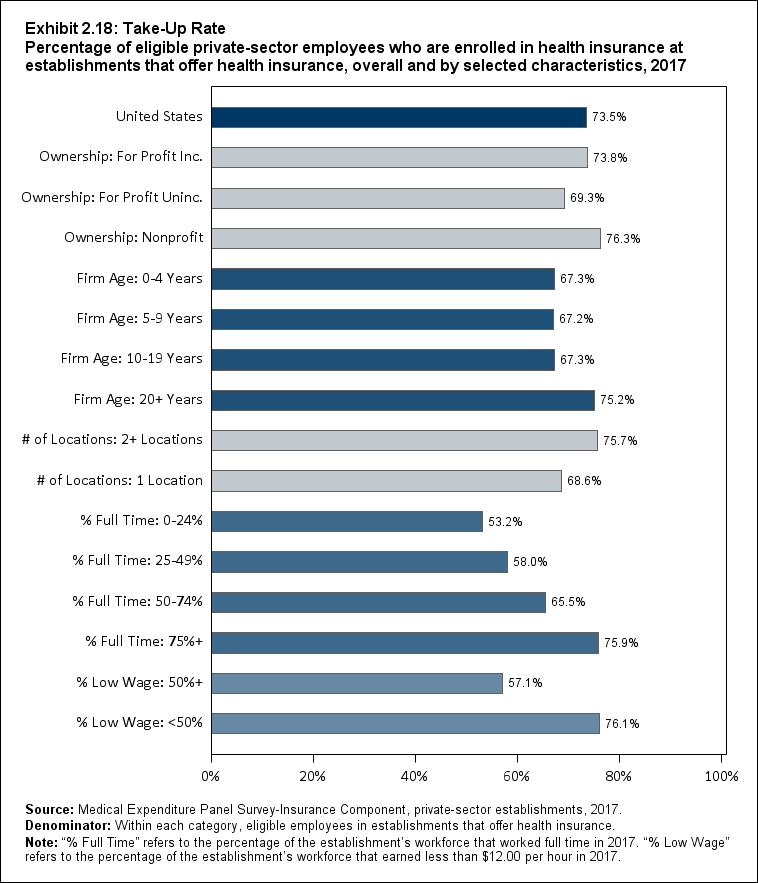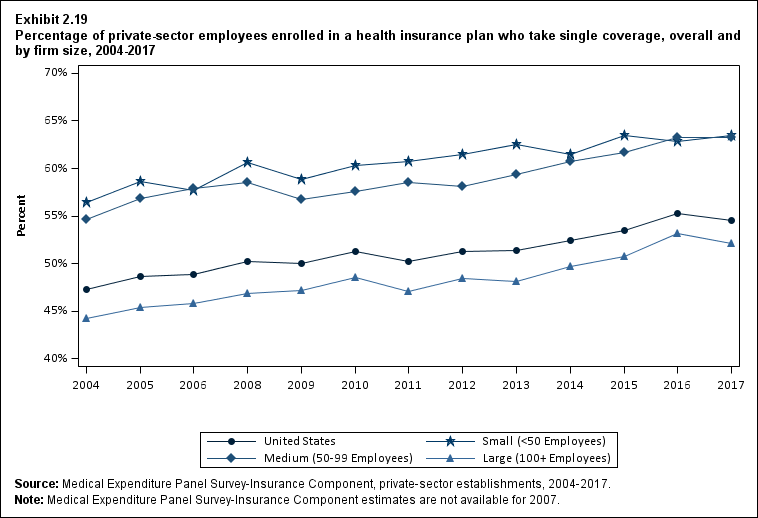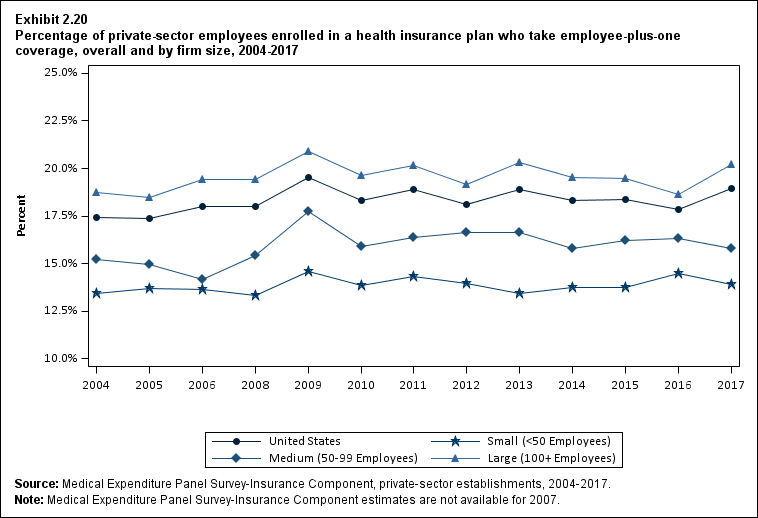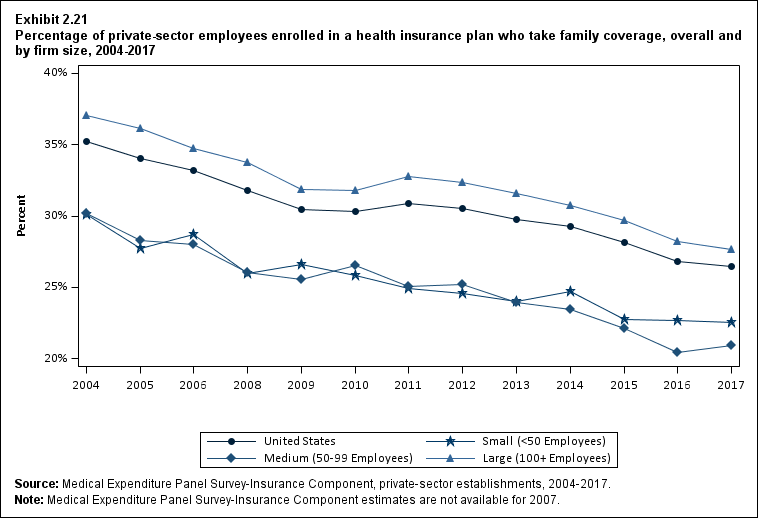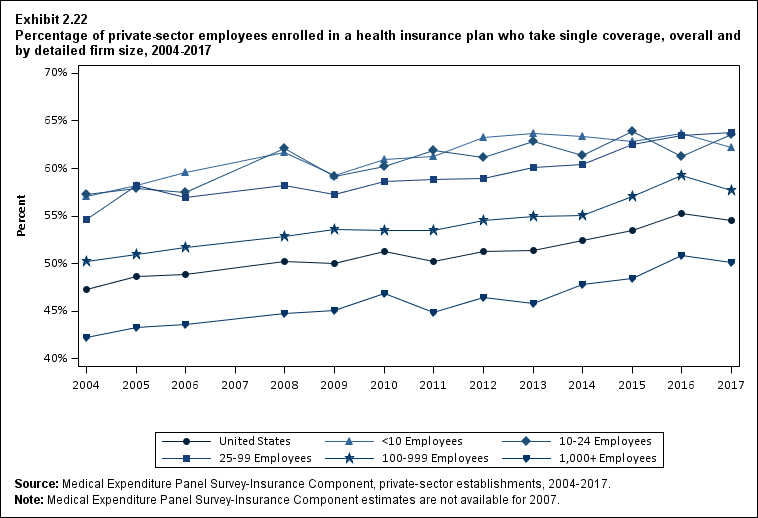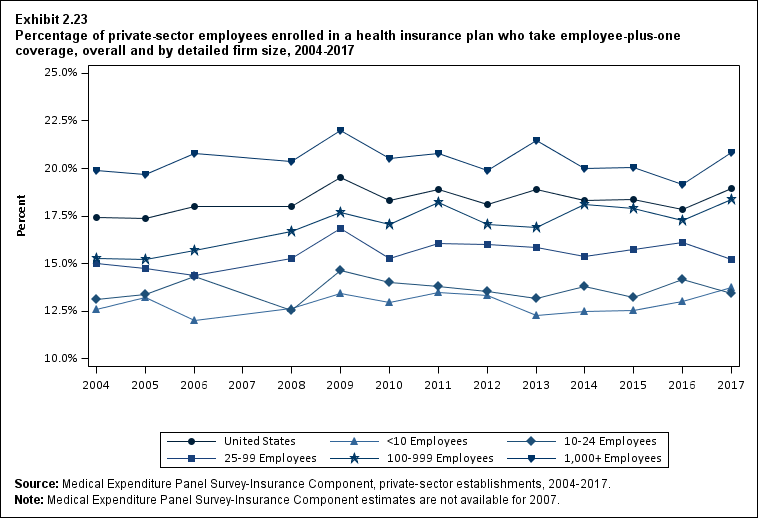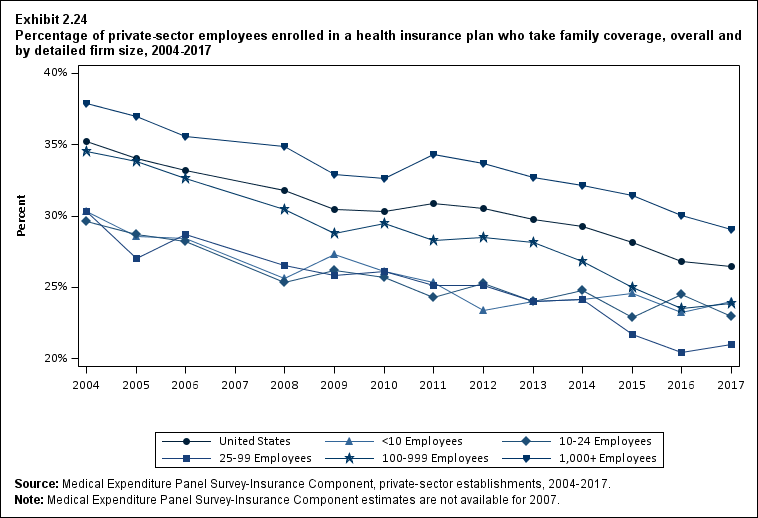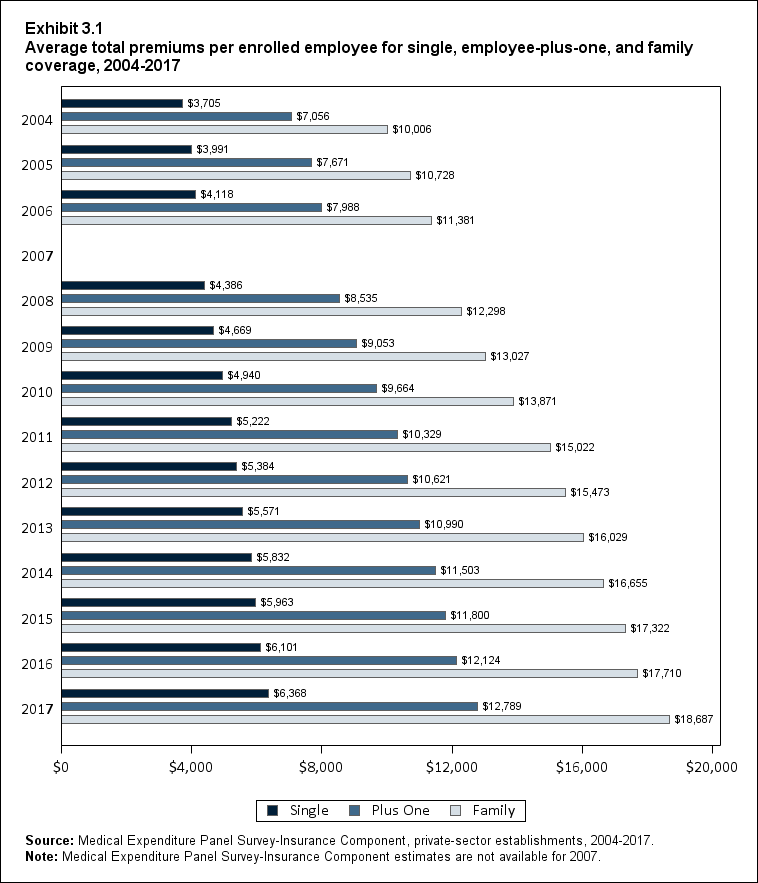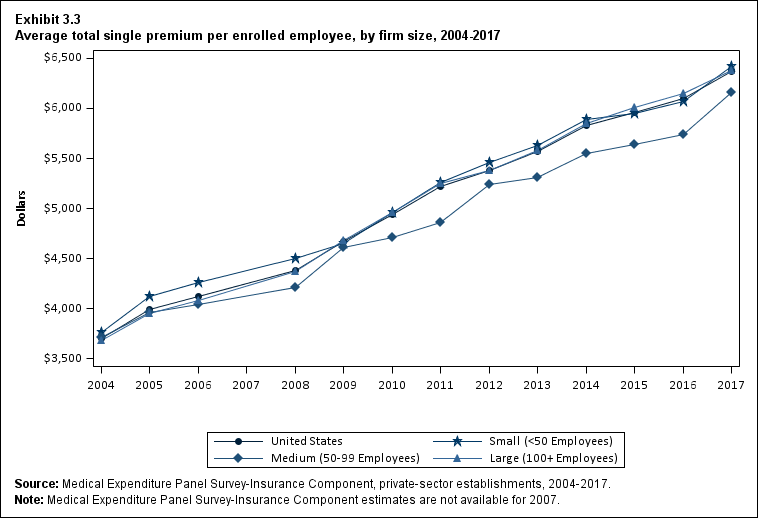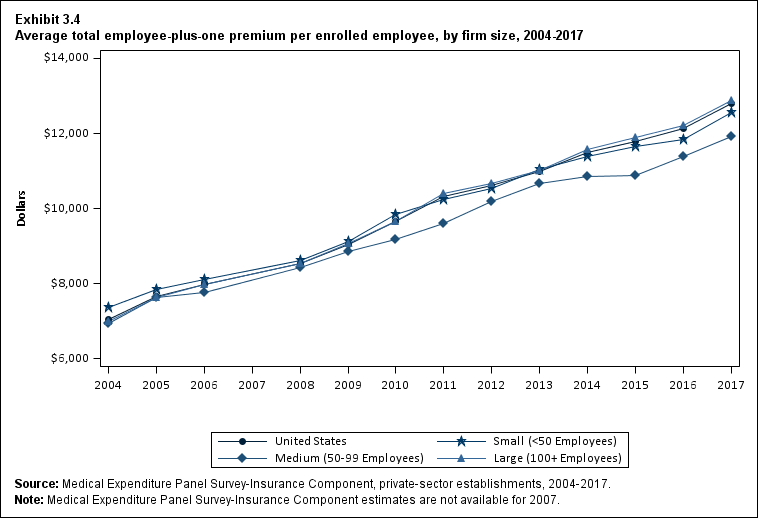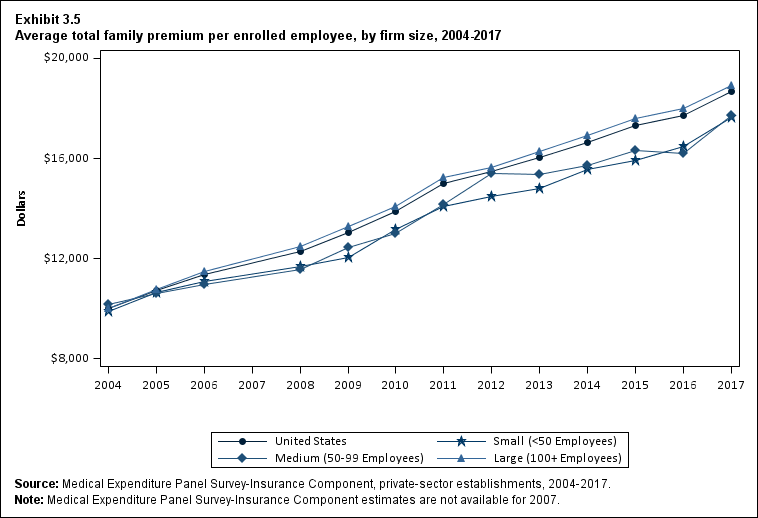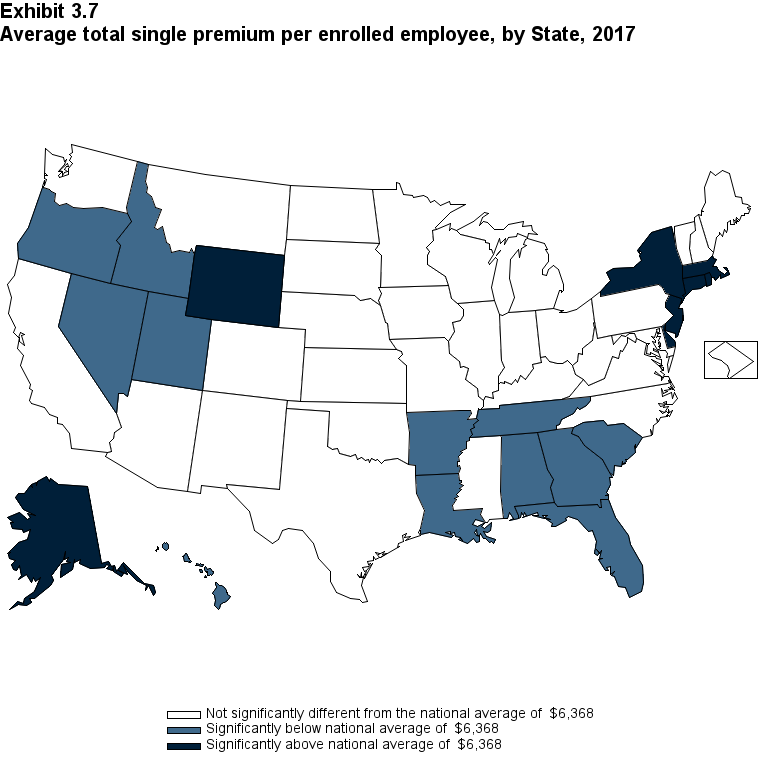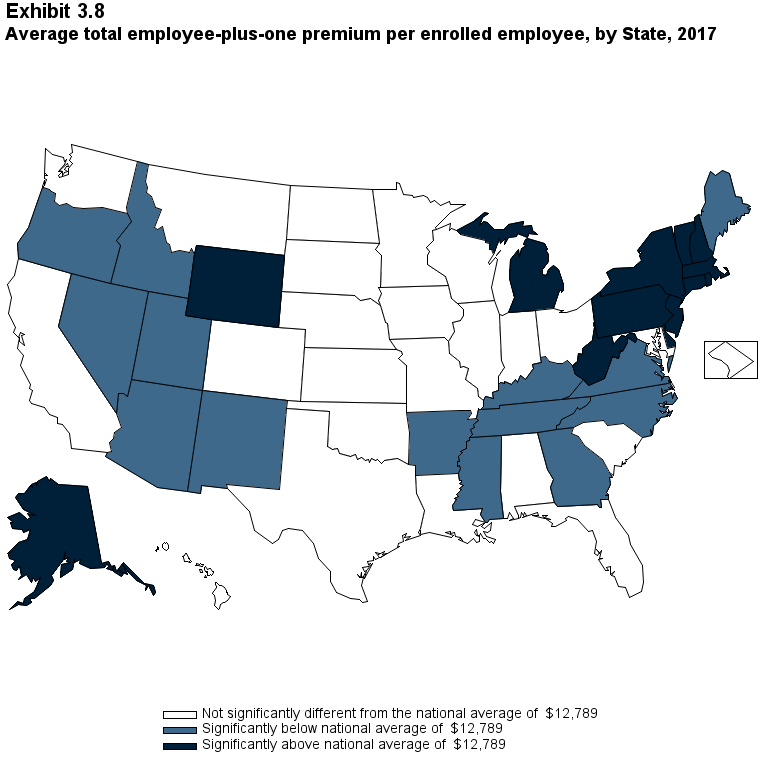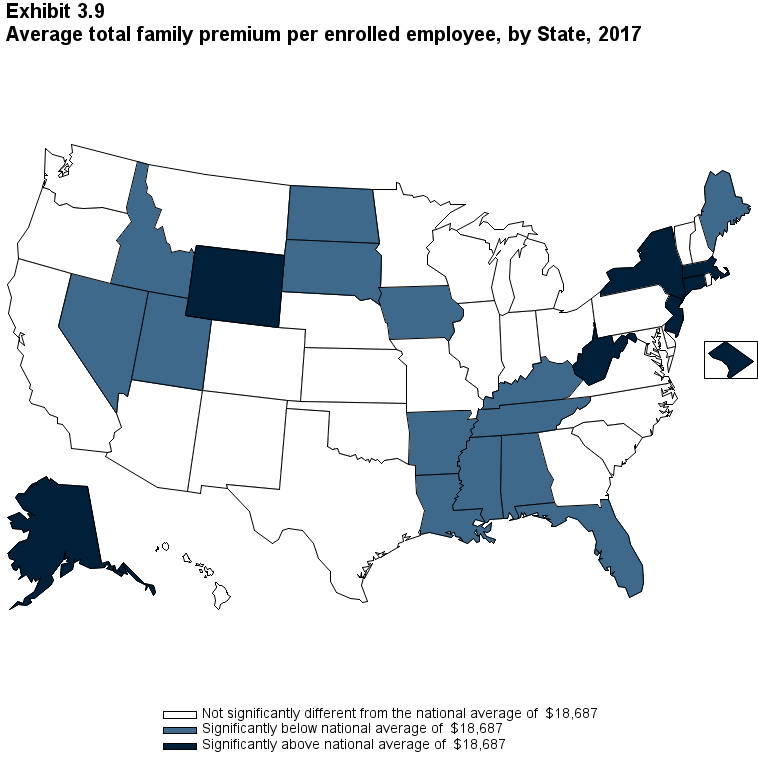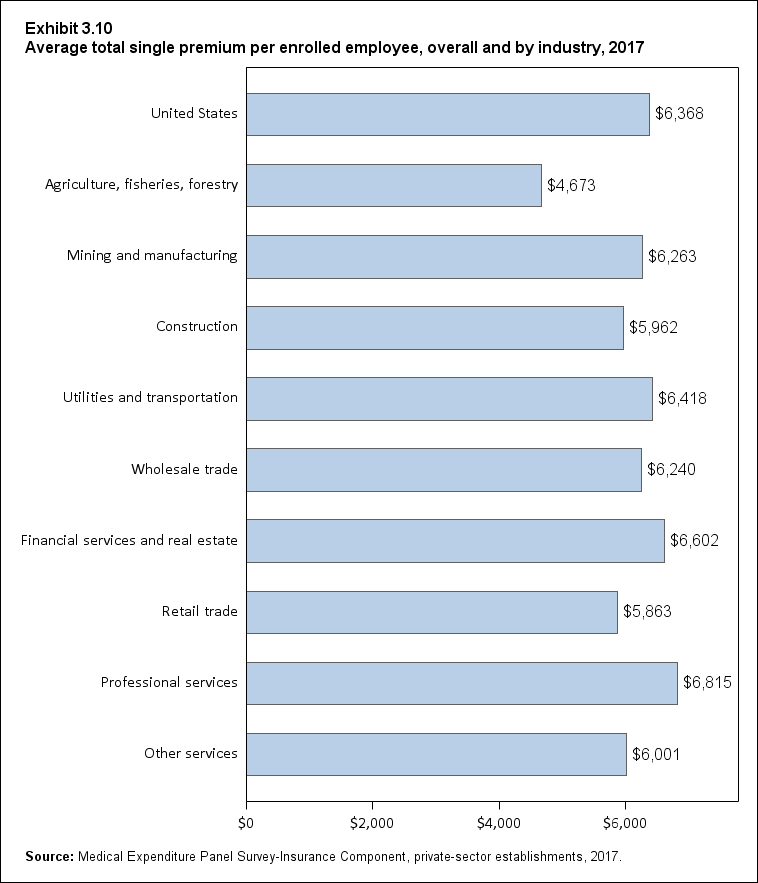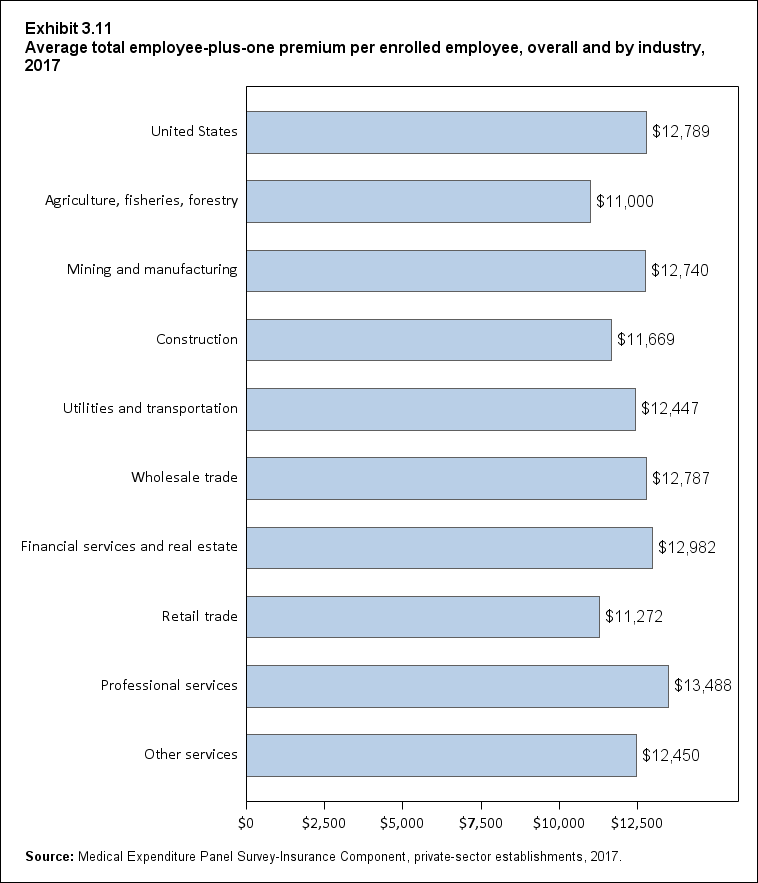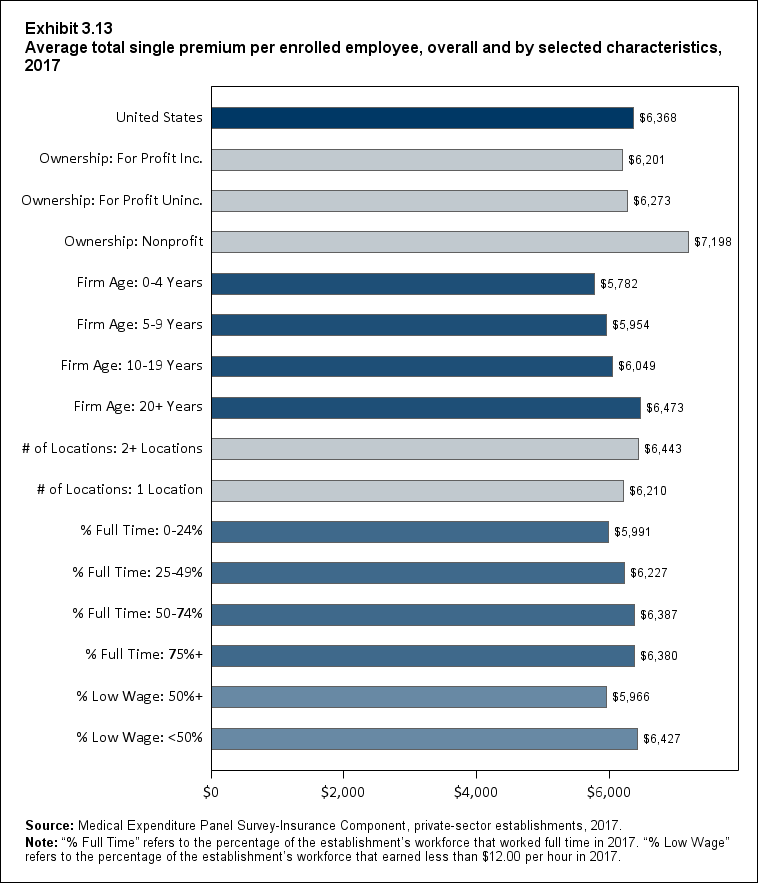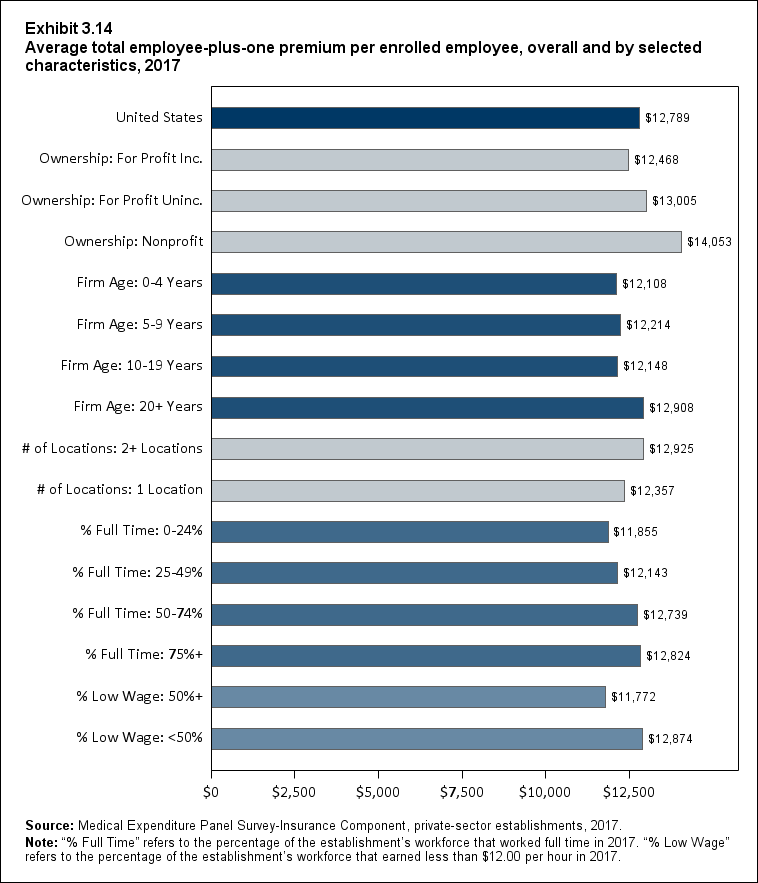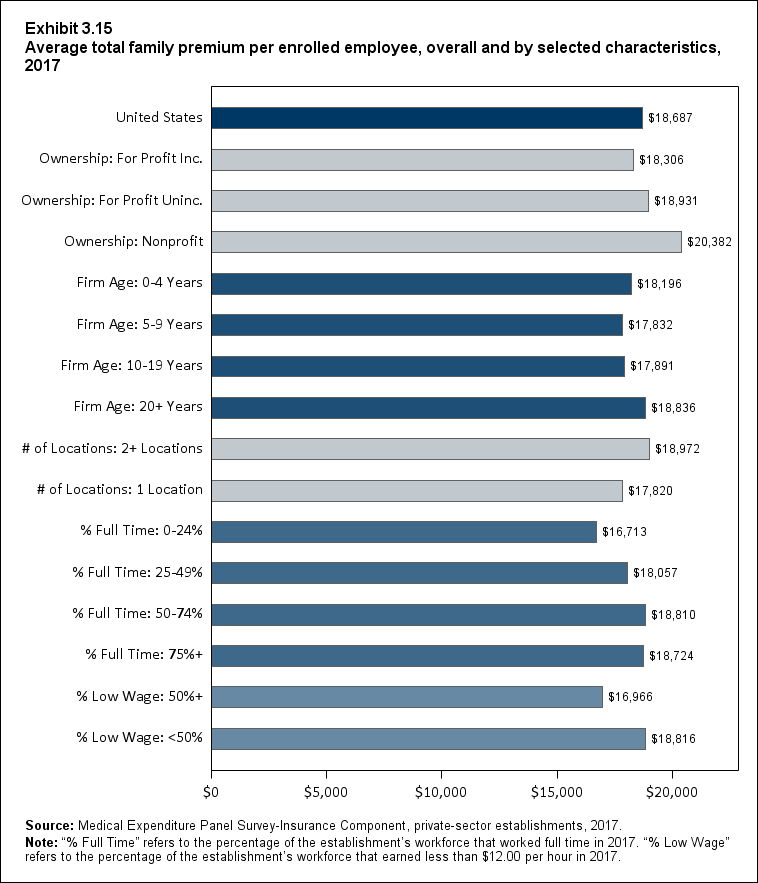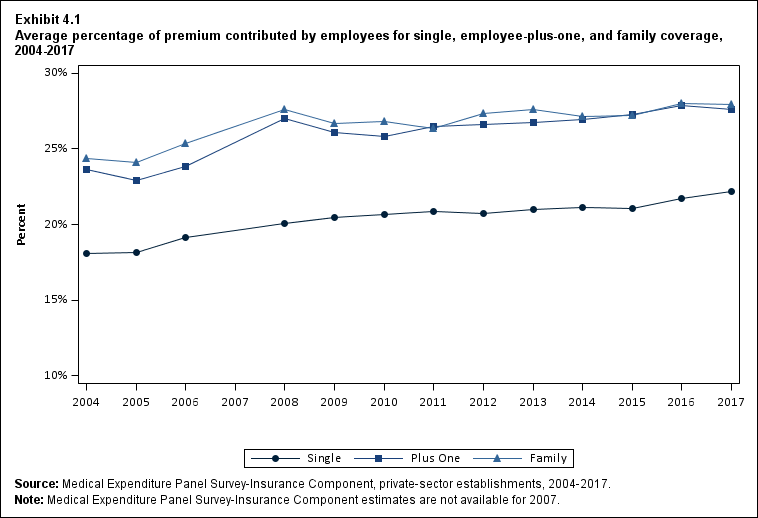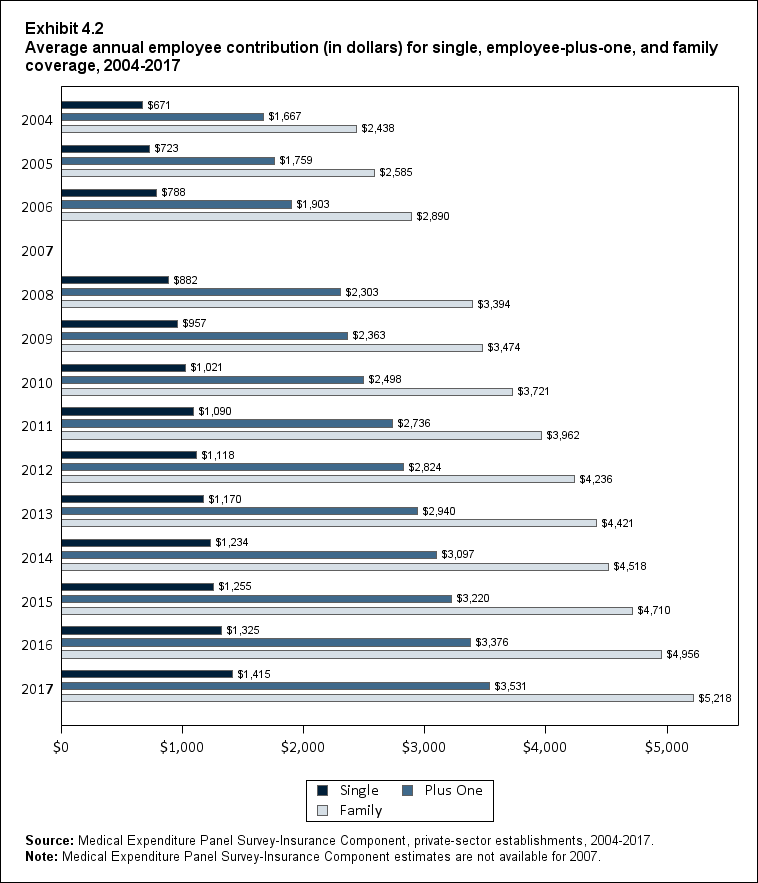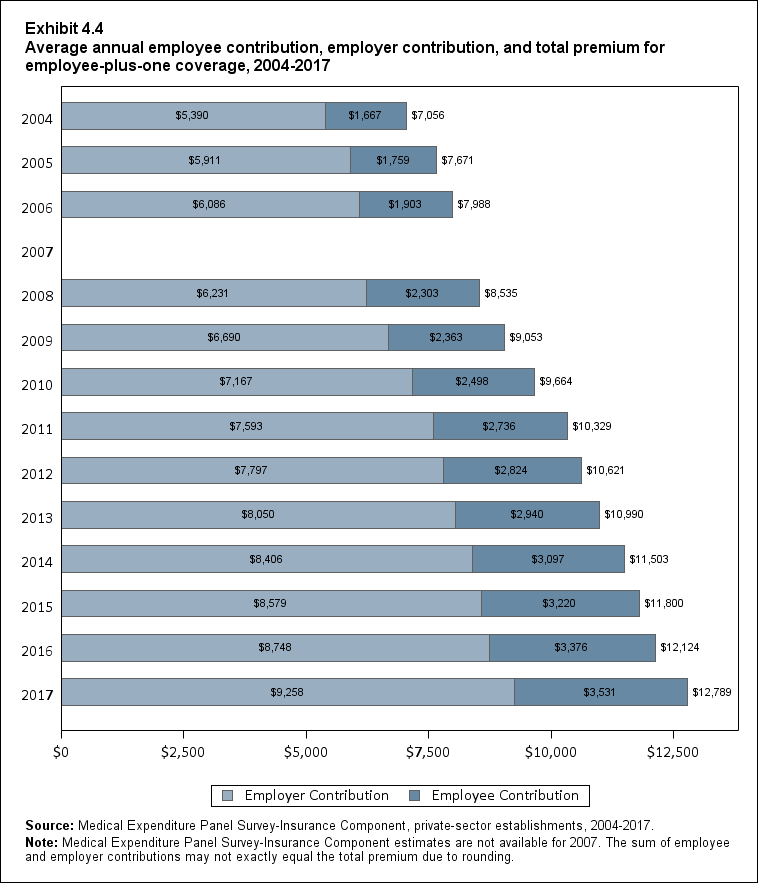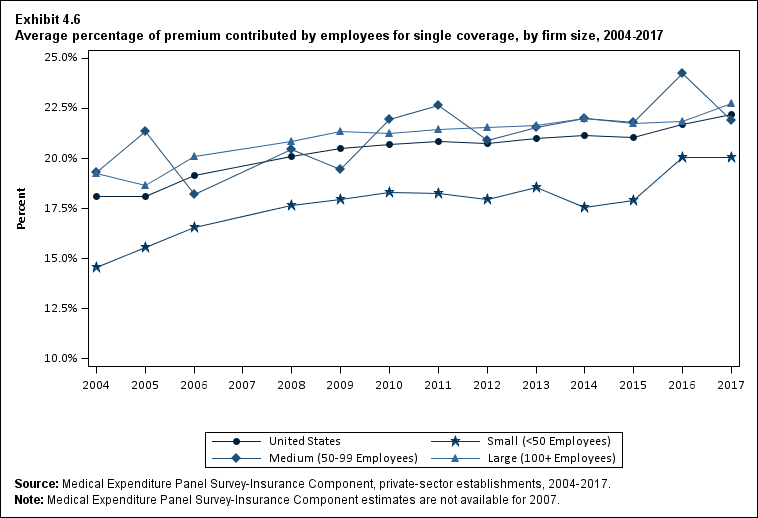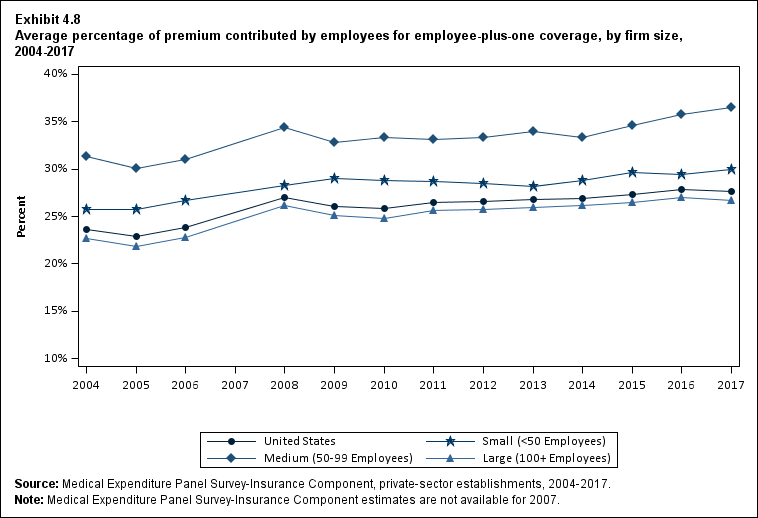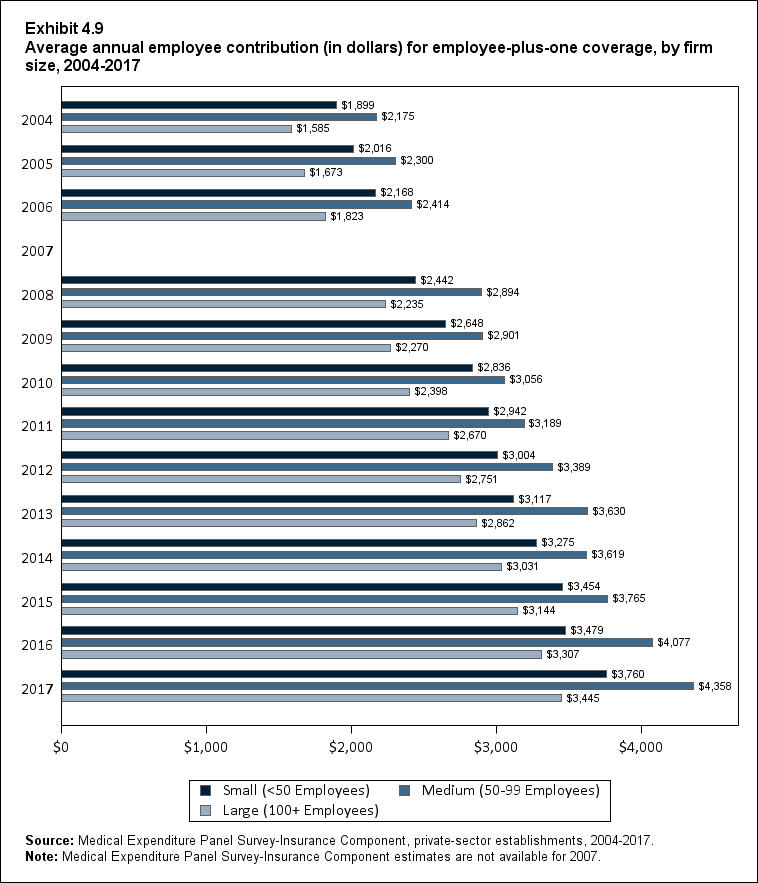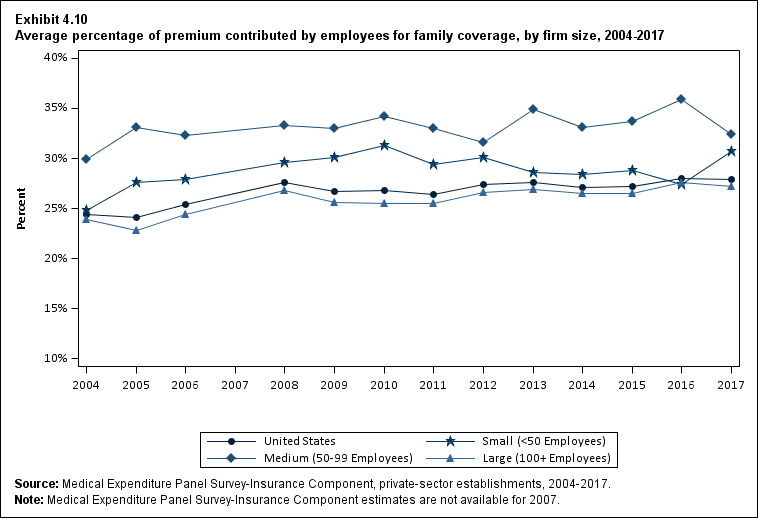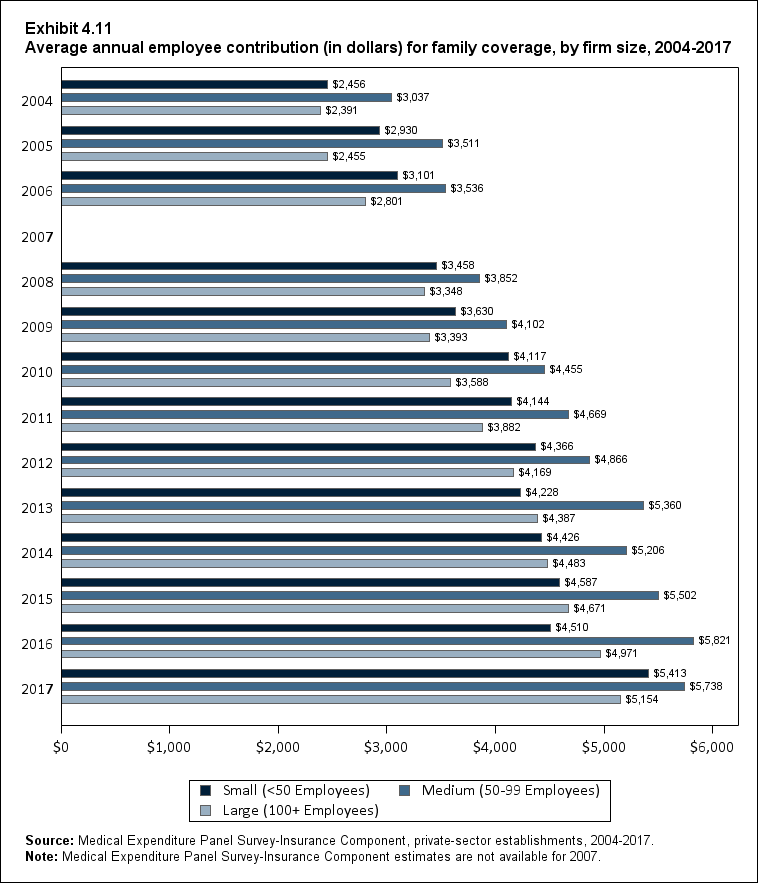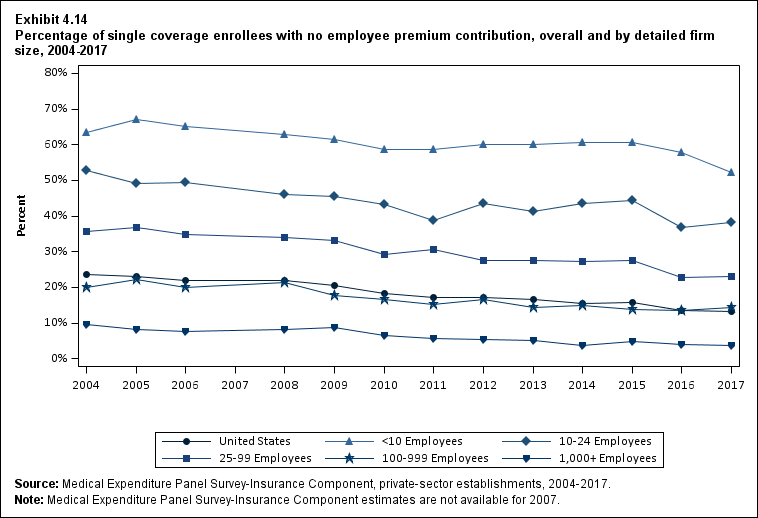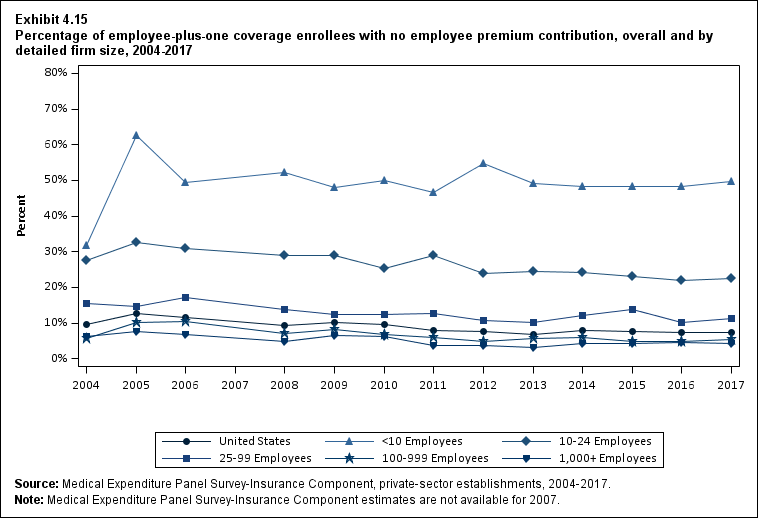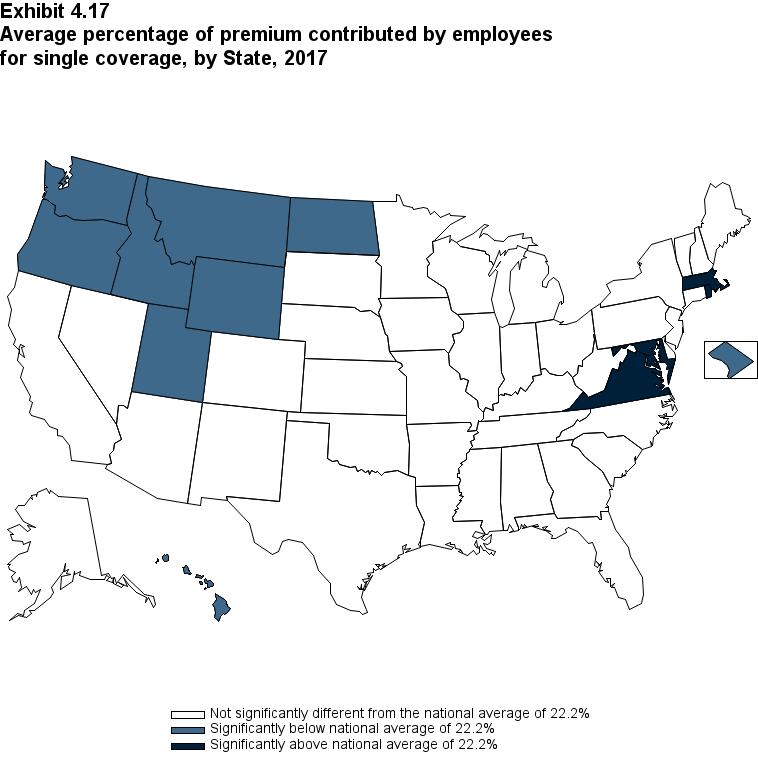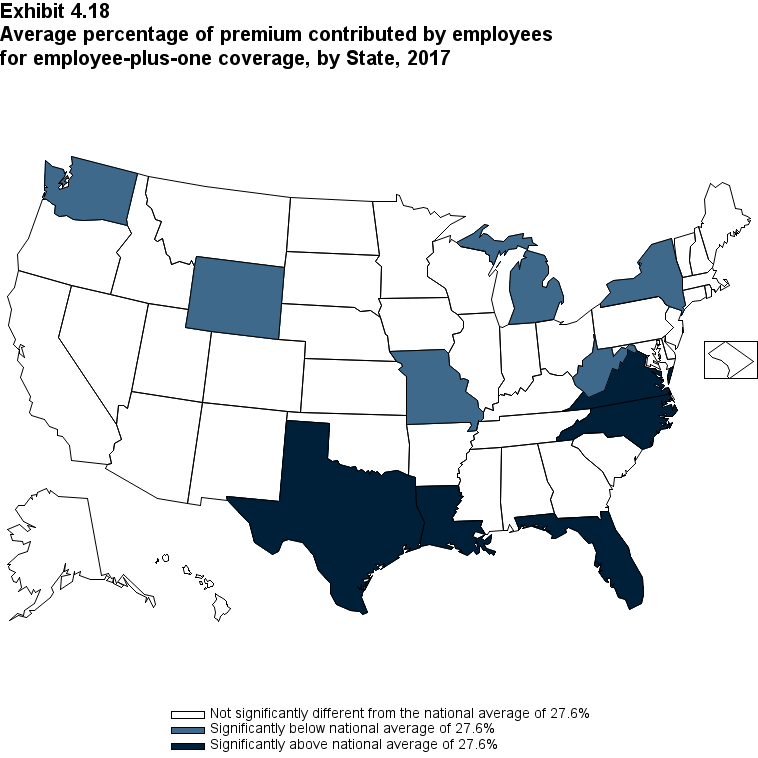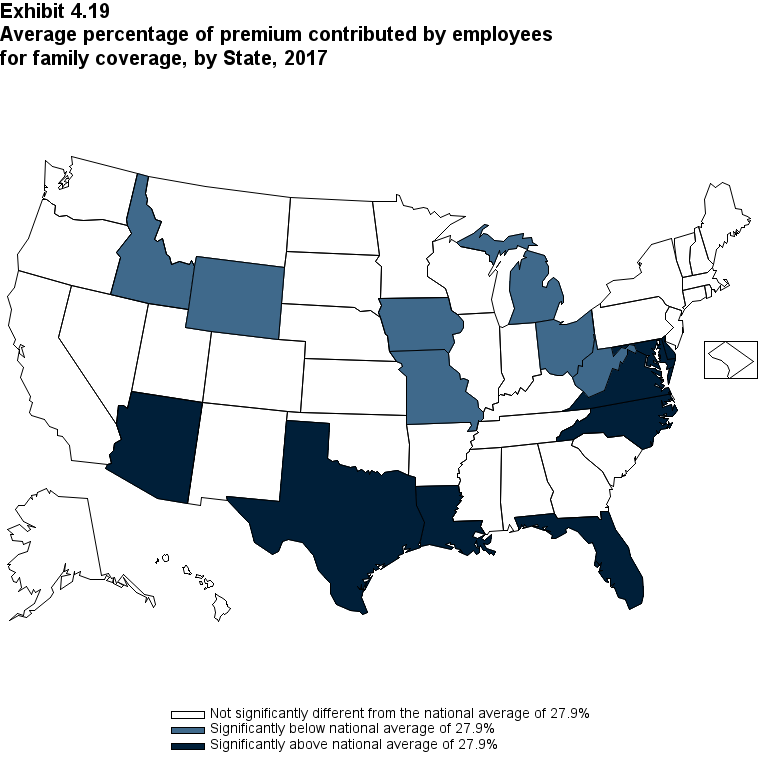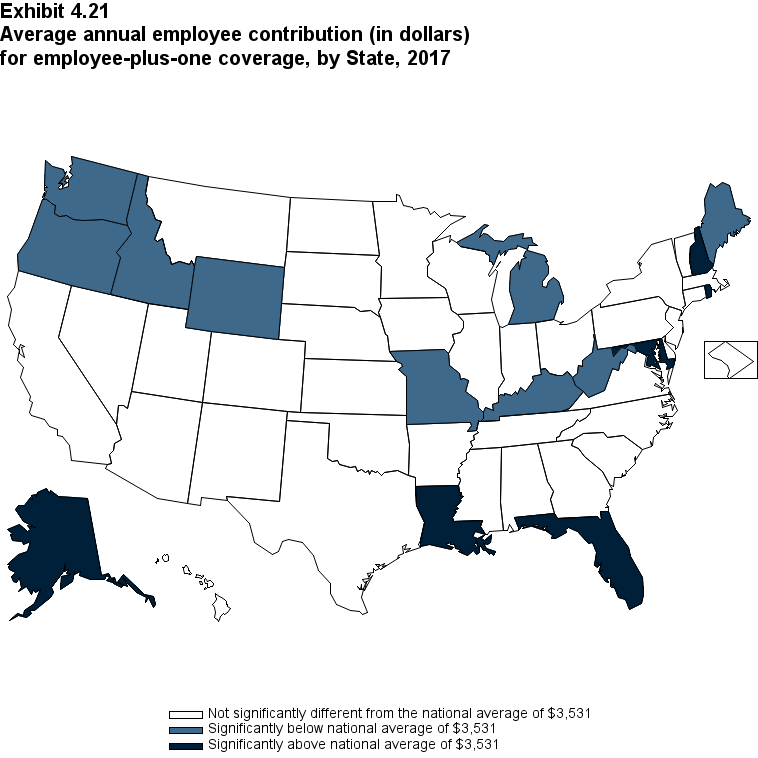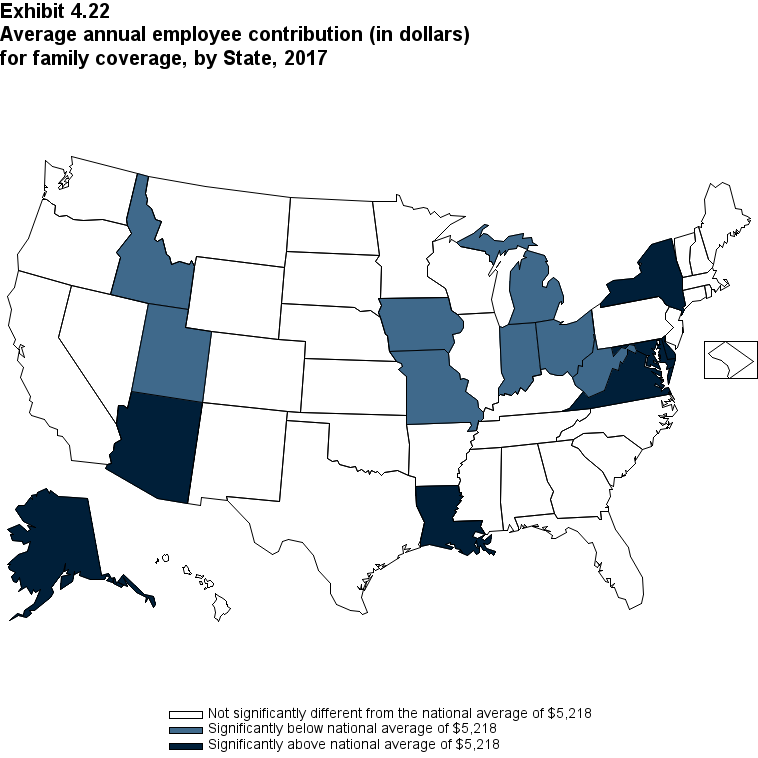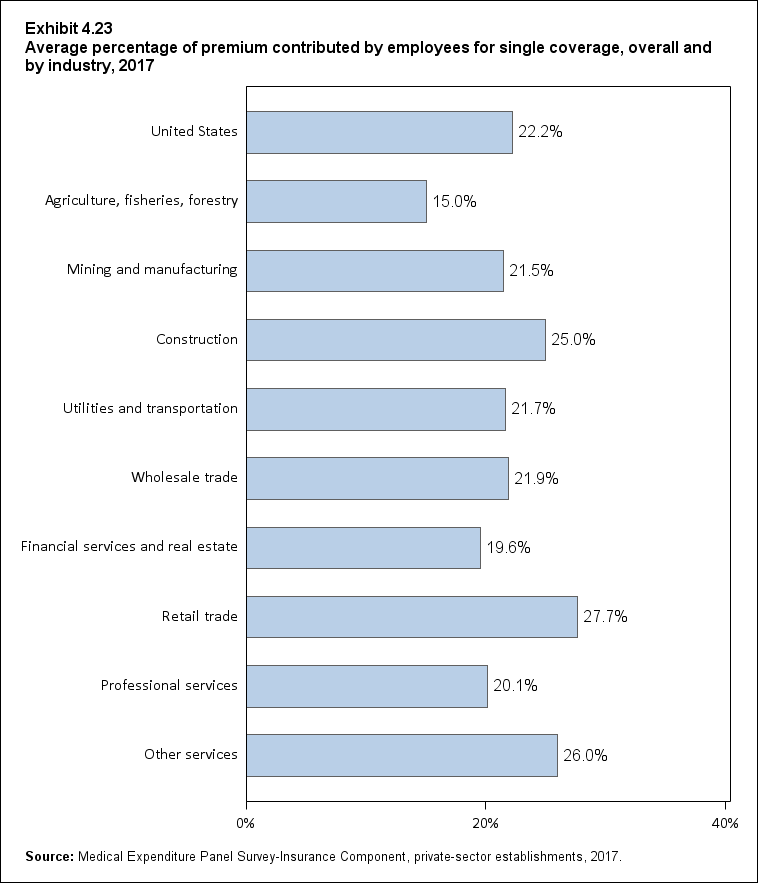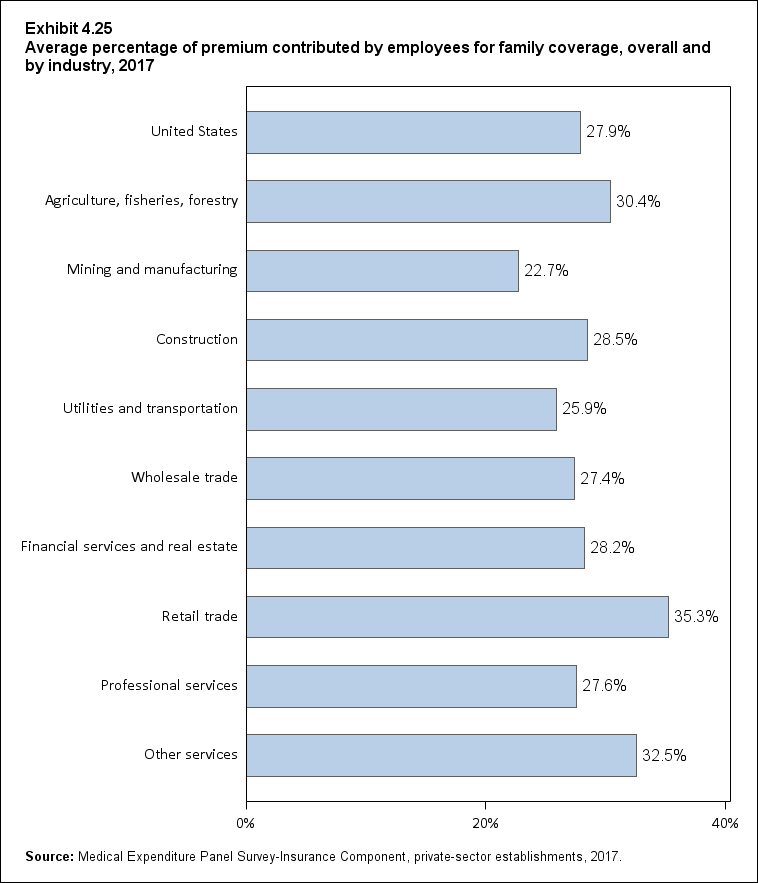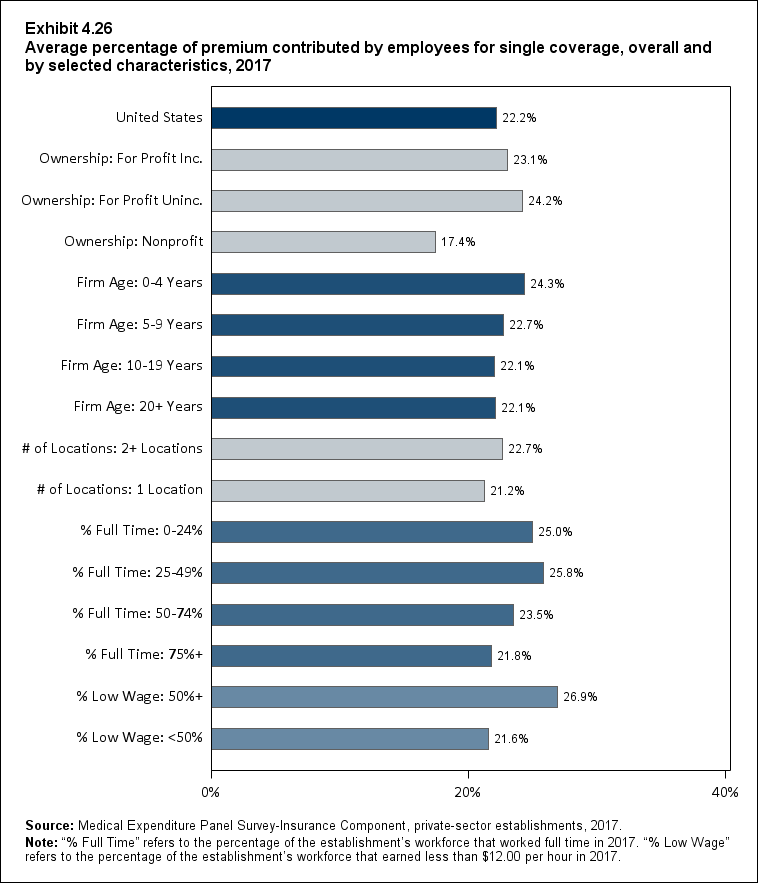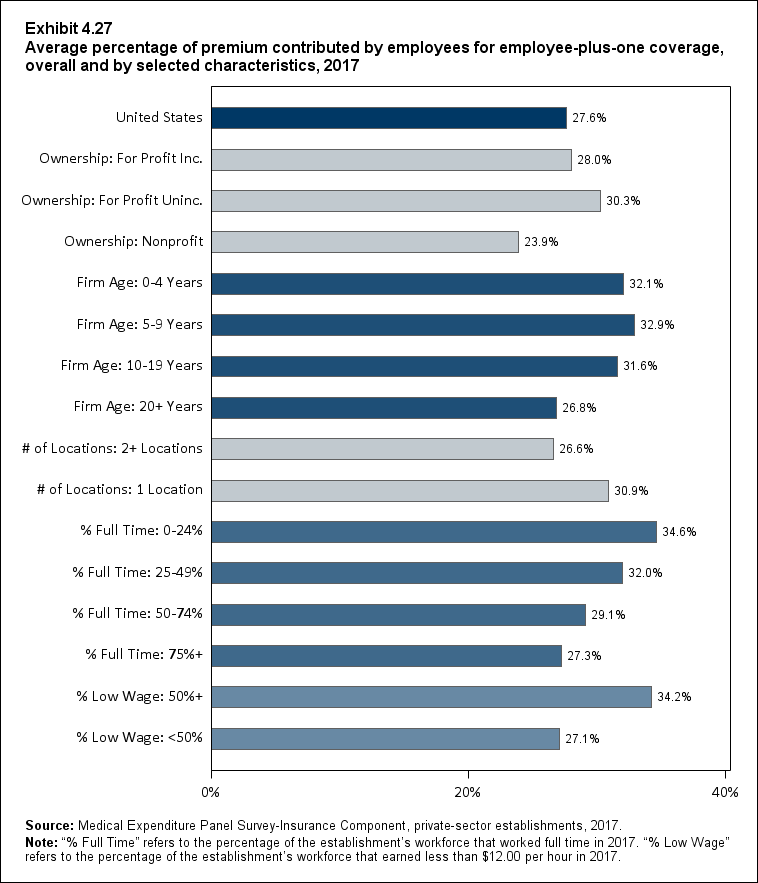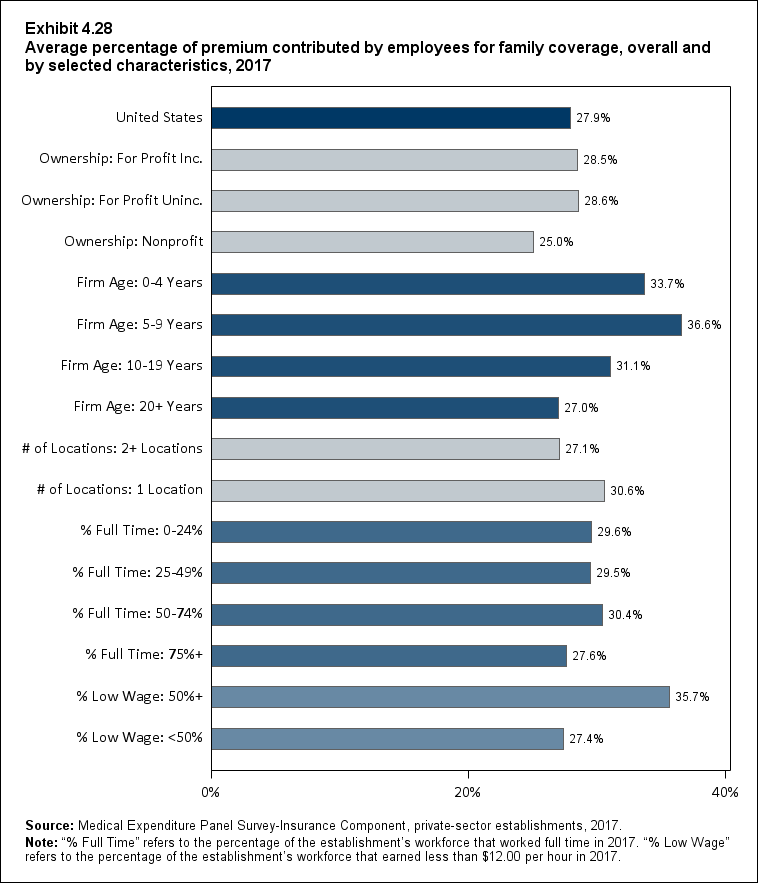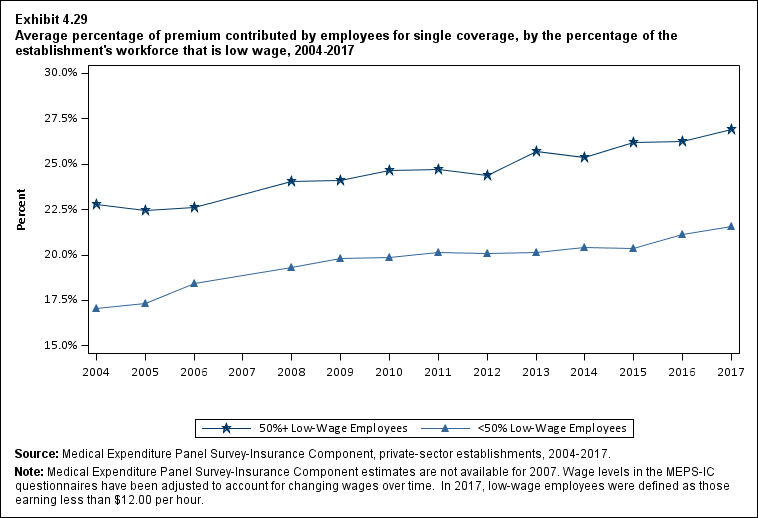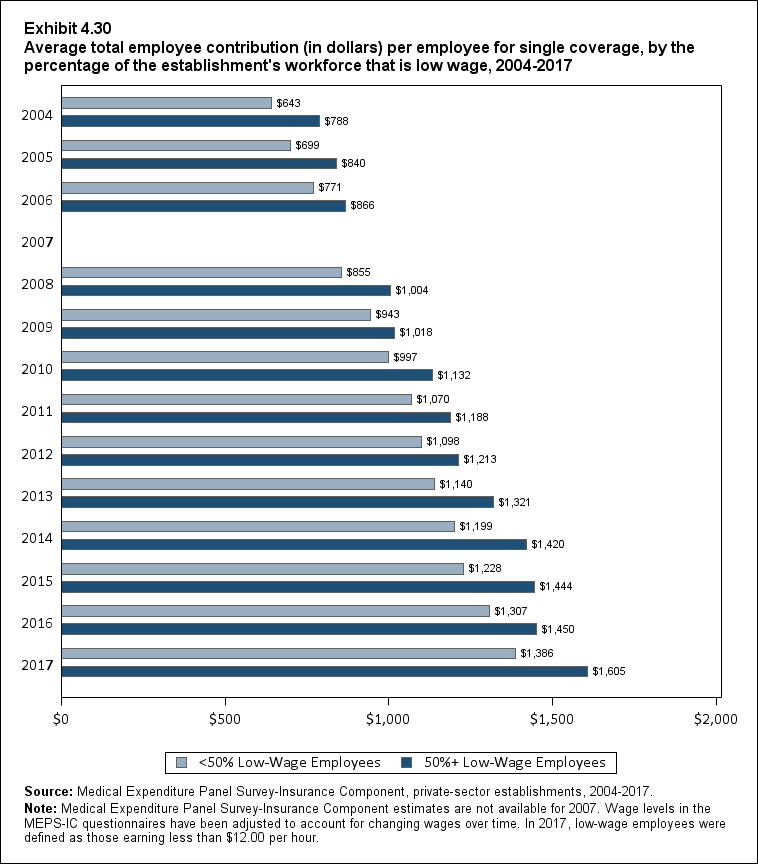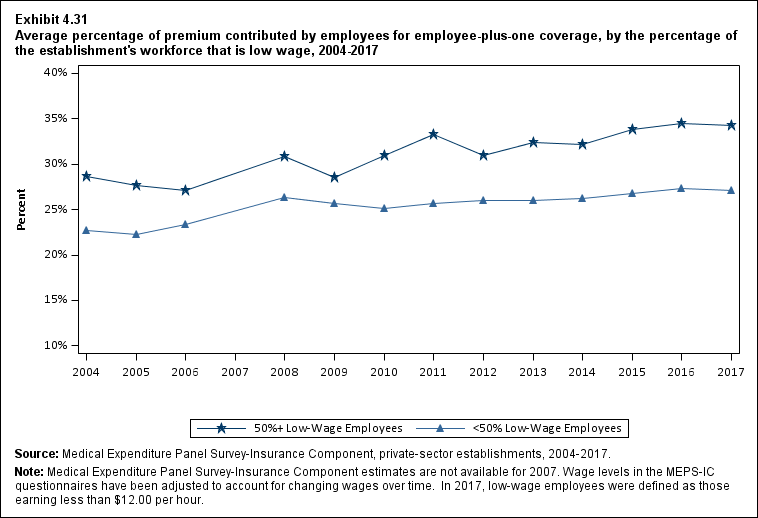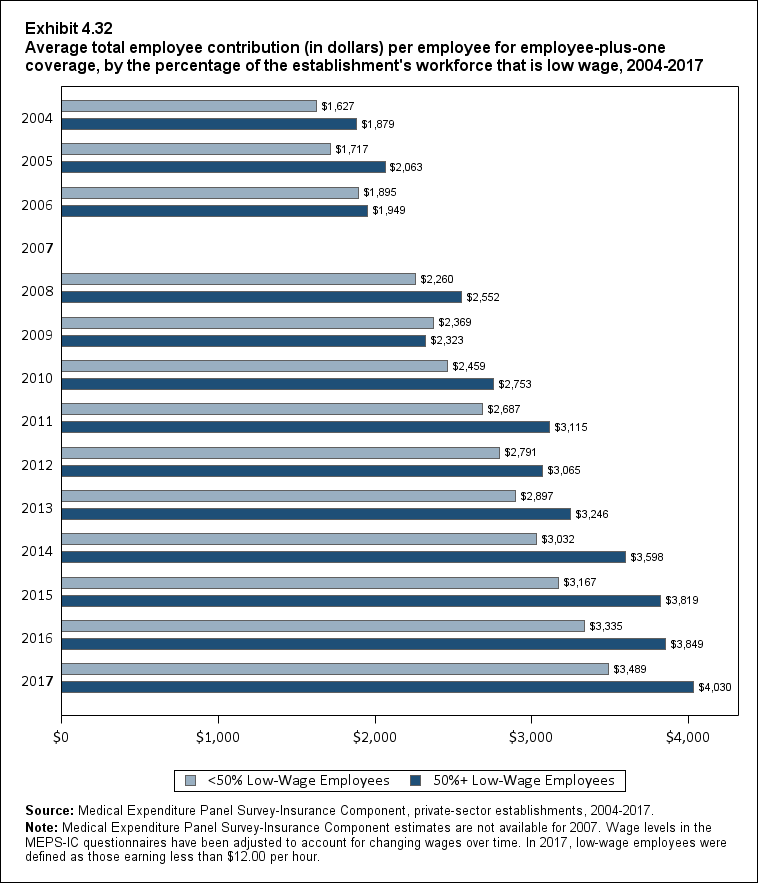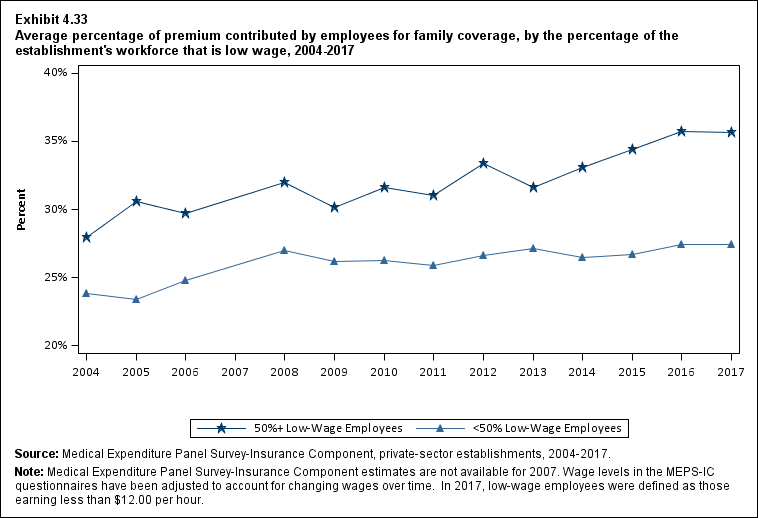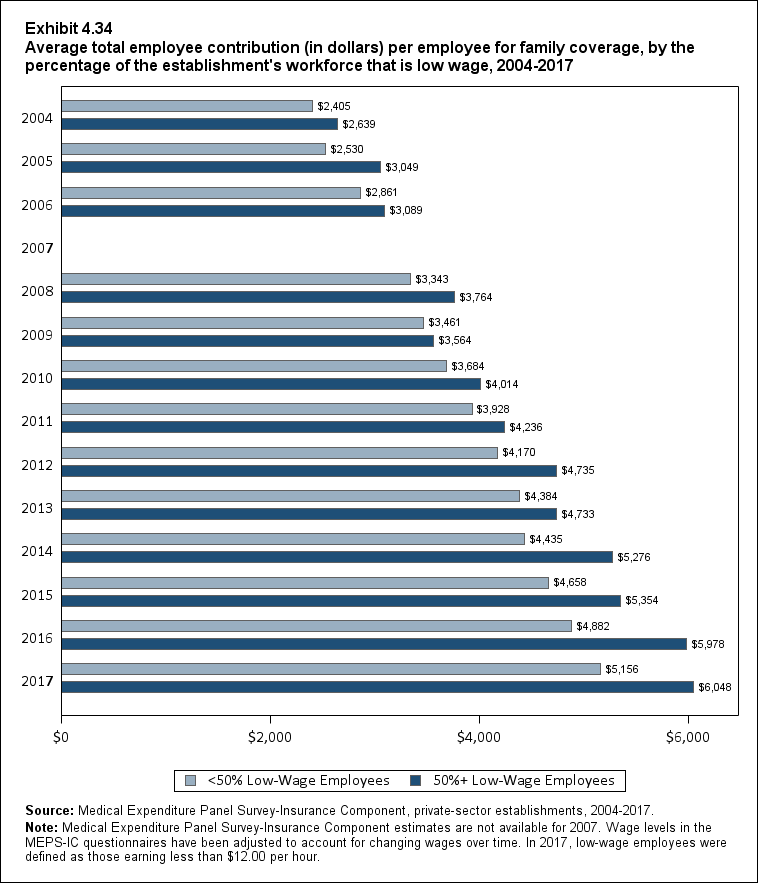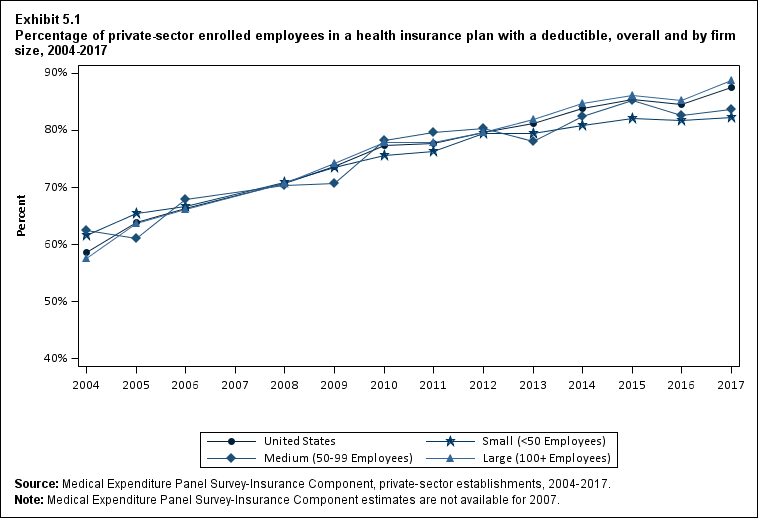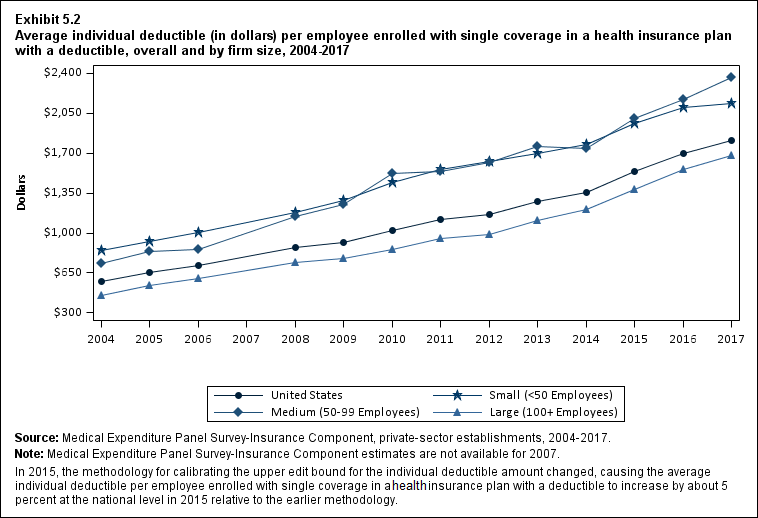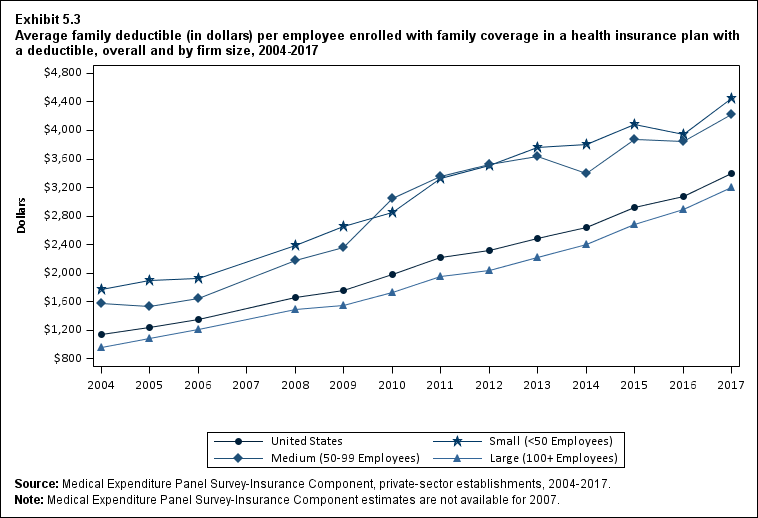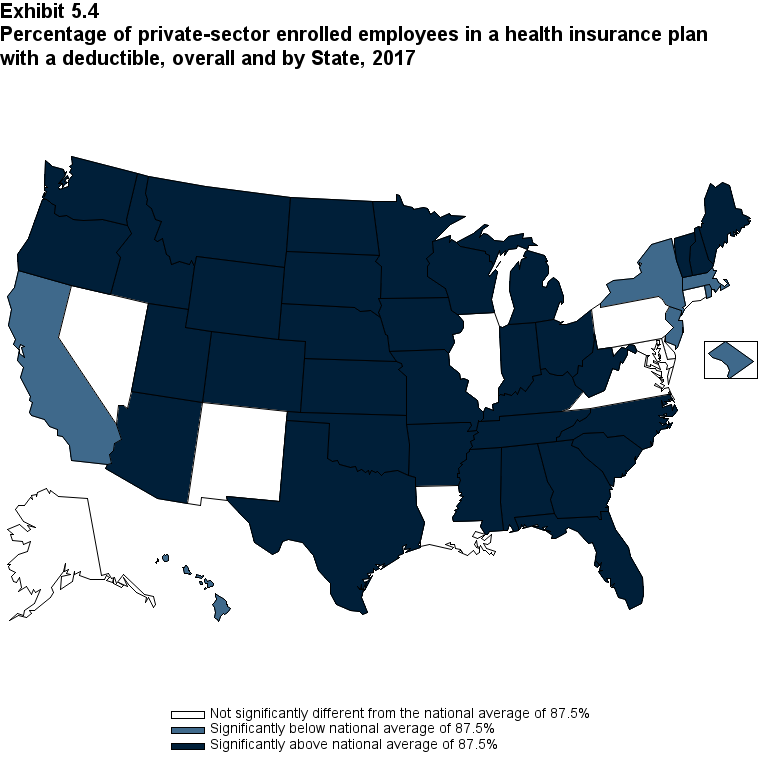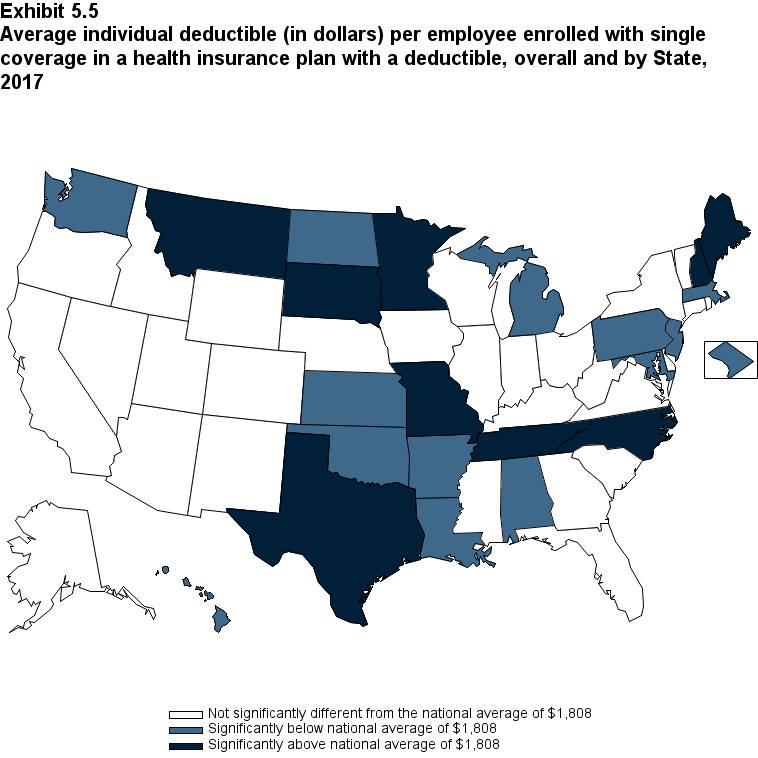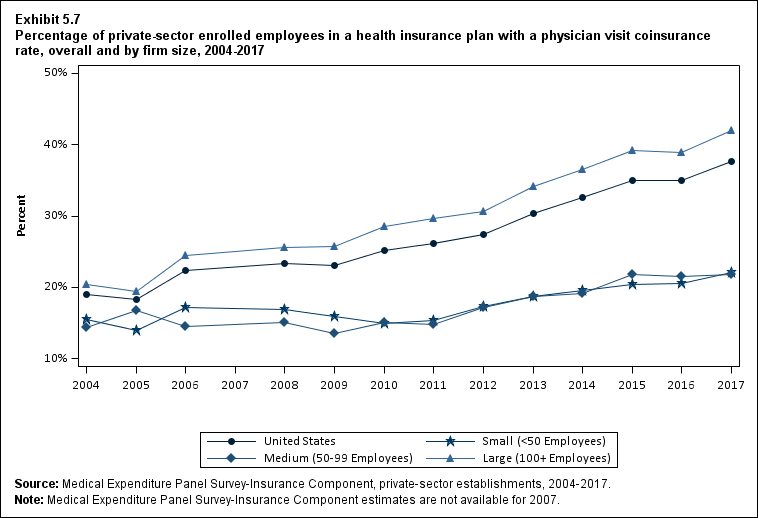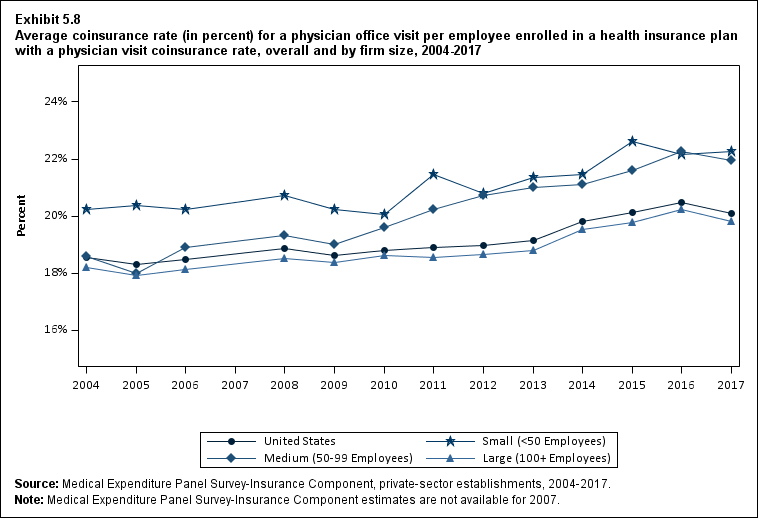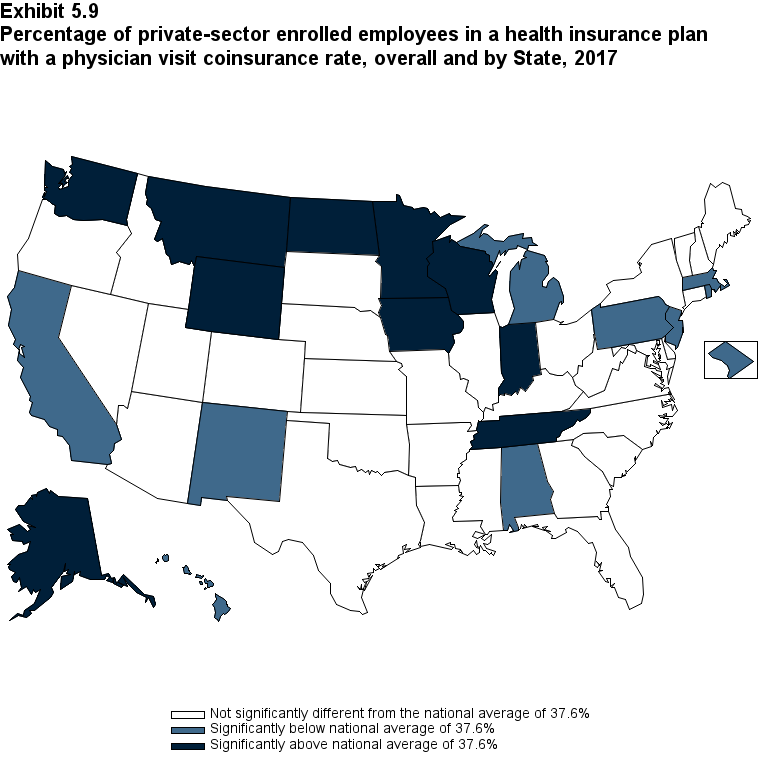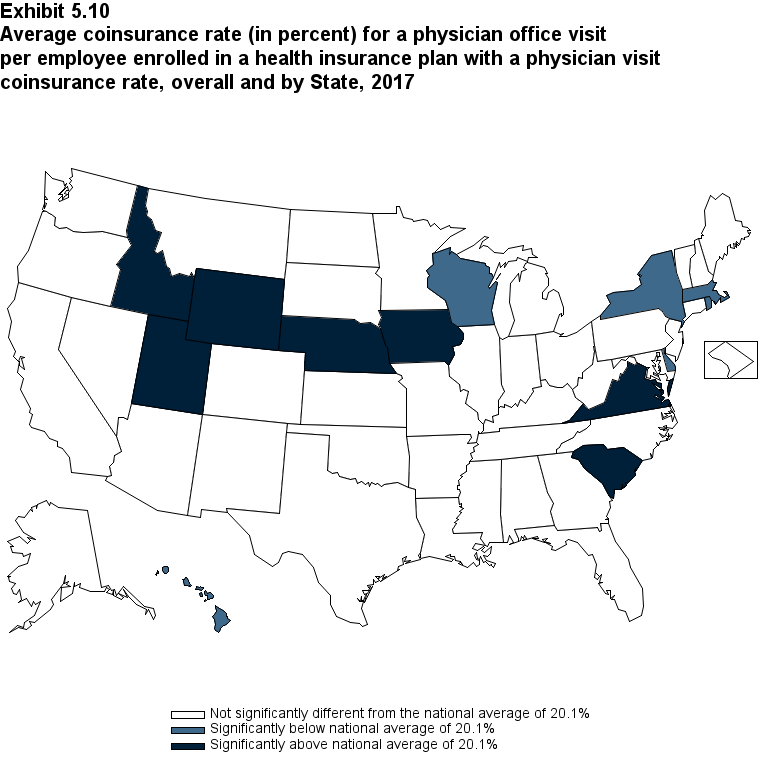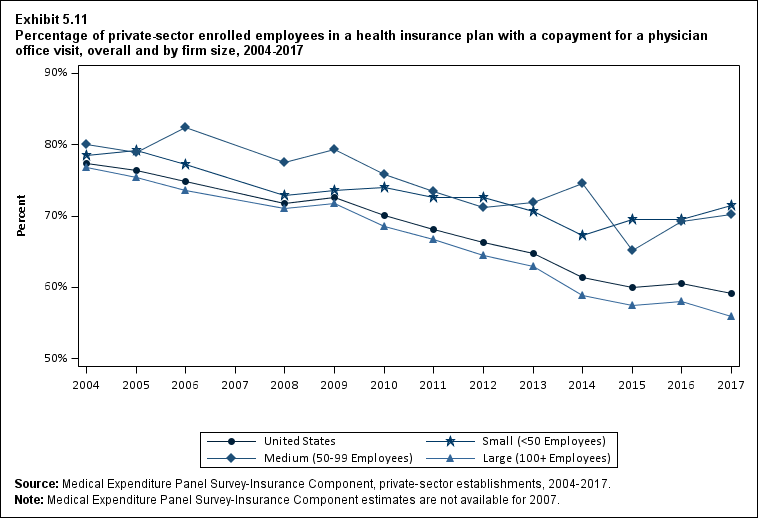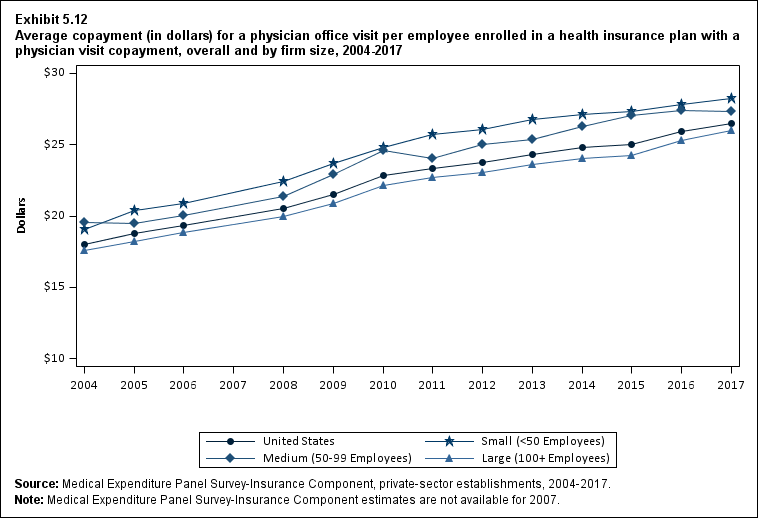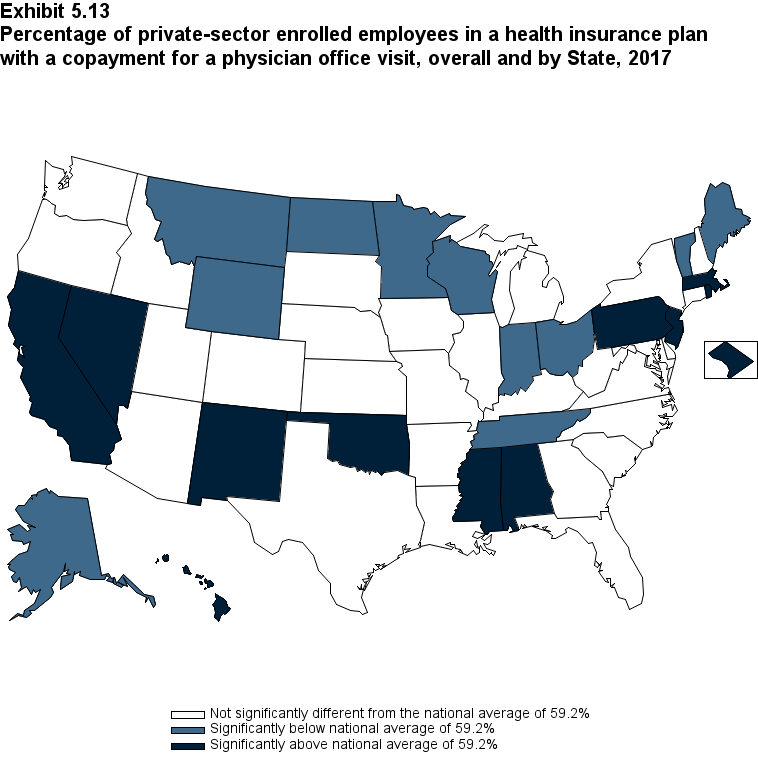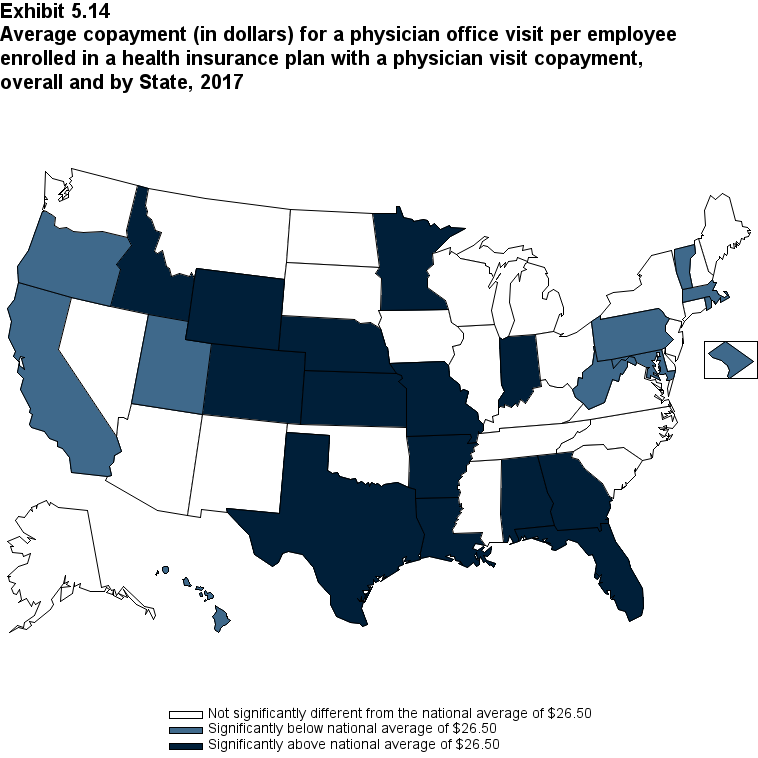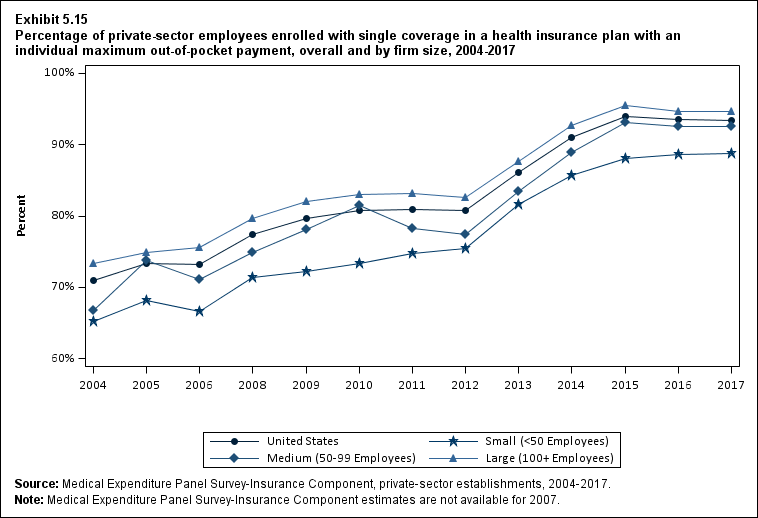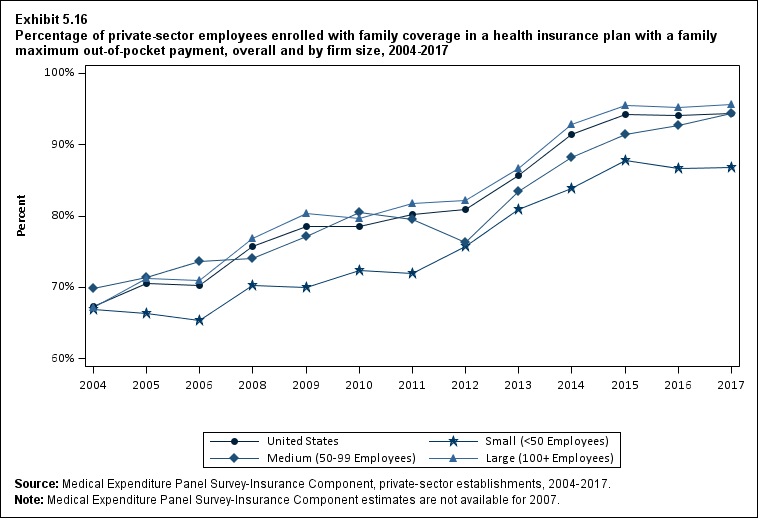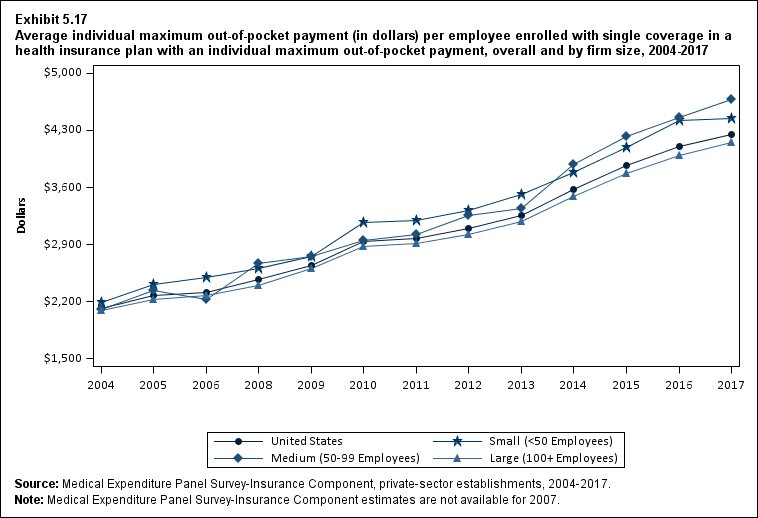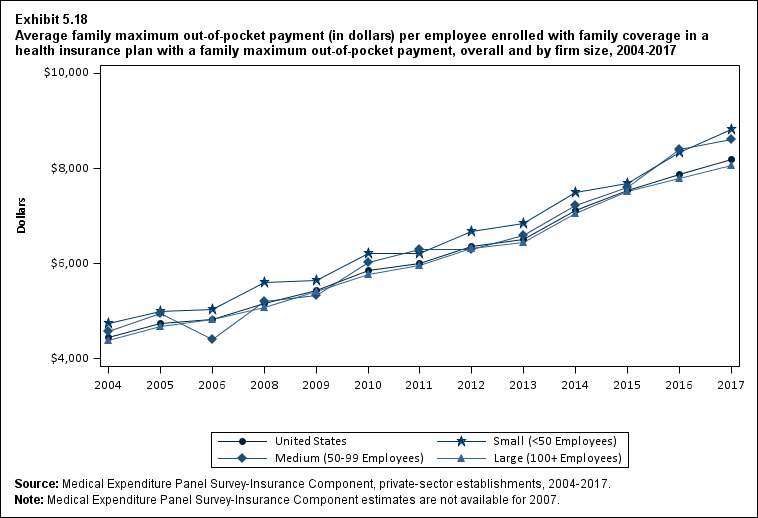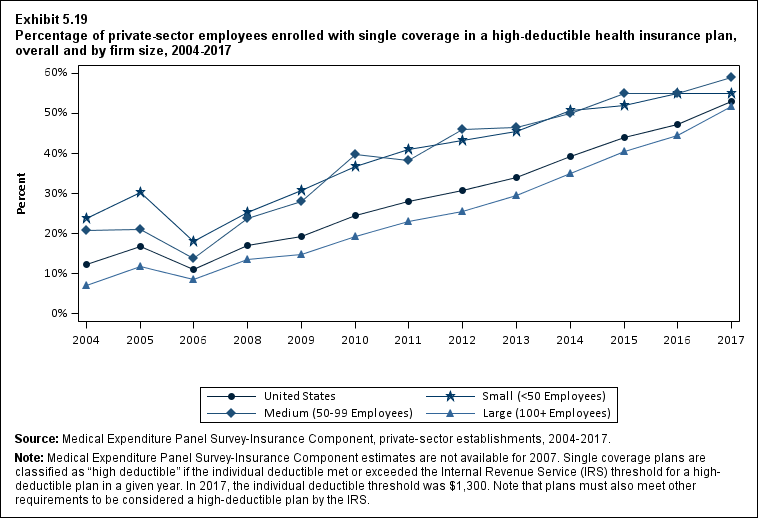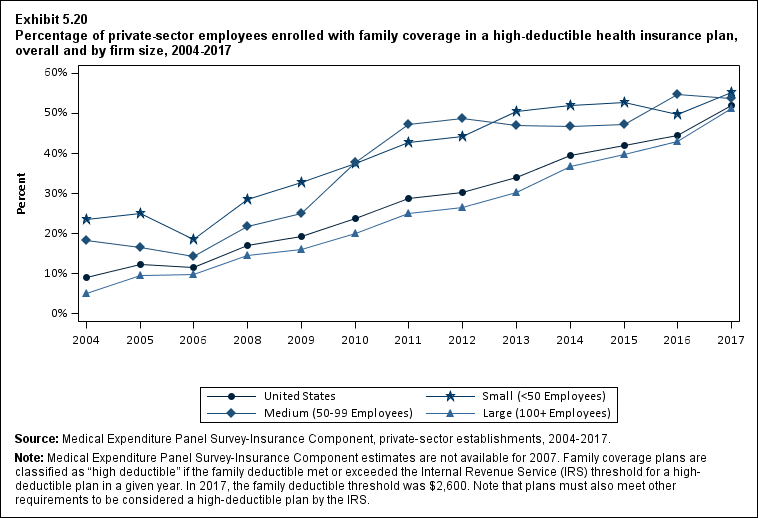Chartbook #22: Medical Expenditure Panel Survey Insurance Component 2017 Chartbook
Acknowledgments
This chartbook was prepared by Jessica Vistnes, G. Edward
Miller, Philip Cooper, Patricia Keenan, and Asako Moriya of the Center for
Financing, Access, and Cost Trends (CFACT) in the Agency for Healthcare
Research and Quality (AHRQ). Primary editing was performed by Jessica Vistnes
and Edward Miller.
The authors appreciate the efforts of Eneli Coakley, Zhengyi
Fang, and Bidong Liu of Social & Scientific Systems, Inc. in preparing the
exhibits in the chartbook, the data production work of Brandon Flanders of the
U.S. Census Bureau, and the production assistance of Doreen Bonnett, Nicole
Shulman, and Michelle Roberts of AHRQ.
Reviewers of this publication were Joel W. Cohen, Director
of CFACT; Steve Machlin, Director of the Division of Statistical Research and
Methods in CFACT; Steve Hill and Julie Hudson, Senior Economists in the Division
of Research and Modeling in CFACT; and Sandy Decker and Paul Jacobs, Service
Fellows in the Division of Research and Modeling in CFACT.
Introduction
Background
Data Presentation
References
Executive Summary
Section 1: Health Insurance Offer Rates
Section 2: Employee Eligibility and Enrollment
Section 3: Health Insurance Premiums
Section 4: Employee and Employer Premium Contributions
Section 5: Employee Cost Sharing
The data used in this report are from the Insurance
Component of the Medical Expenditure Panel Survey. Information about this survey,
including sample design, data collection, sample sizes, and response rates, can
be found at https://meps.ahrq.gov/survey_comp/Insurance.jsp.
This document is in the public domain and may be used and
reprinted without permission except those copyrighted materials noted for which
further reproduction is prohibited without specific permission of copyright
holders.
Agency for Healthcare Research and Quality
5600 Fishers Lane
Rockville, MD 20857
www.ahrq.gov
Medical Expenditure Panel
Survey Insurance Component 2017 Chartbook. Rockville, MD: Agency for Healthcare
Research and Quality; October 2018. AHRQ Publication No. 18(19)-0034. https://meps.ahrq.gov/mepsweb/data_files/publications/cb22/cb22.shtml.
Return to Table of Contents
The Medical Expenditure Panel Survey Insurance Component (MEPS-IC)
is an annual survey of private employers and State and local governments. The
MEPS-IC produces national and State-level estimates of employer-sponsored
insurance, including offered plans, costs, employee eligibility, and number of
enrollees. The MEPS-IC is sponsored by the Agency for Healthcare Research and
Quality and is fielded by the U.S. Census Bureau.
This chartbook provides both single-year and multiyear trend
analyses using private-sector MEPS-IC data from 2004 to 2017. To best convey
key information from the MEPS-IC, the report is presented in five sections: Health
Insurance Offer Rates; Employee Eligibility and Enrollment; Health Insurance
Premiums; Employee and Employer Premium Contributions; and Employee Cost
Sharing. Each section provides charts and discussion with links to MEPS-IC data
tables that contain the estimates and standard errors for each exhibit.
Many of the estimates in this publication are categorized by
firm sizes that are relevant to recent changes in national healthcare policy. Note
that the firm-size categories used in the charts and tables are based on actual
employment counts rather than full-time equivalent (FTE) counts, because the MEPS-IC
does not collect FTE employment figures.
Each section discusses the estimates to highlight trends and
differences by employer and workforce characteristics. If a comparison of
estimates is presented in the discussion, any differences are statistically
significant at the 0.05 level, unless otherwise noted. In some cases,
differences noted in the text, in estimates as well as statistical significance
of comparisons, may vary slightly from calculations performed using data in the
exhibits or MEPS-IC data available on the MEPS website due to rounding.
In addition, compared with tests performed in the 2016
MEPS-IC Chartbook, tests performed in this year's chartbook used estimates
containing additional digits after the decimal place. This change may have
resulted in different conclusions than the 2016 chartbook regarding comparisons
of estimates. All dollar estimates are nominal (not adjusted for inflation).
Return to Table of Contents
The IC is one of three annual component surveys that make up
MEPS. The other two components are the Household Component (HC) and the Medical
Provider Component (MPC). The HC is a nationally representative survey of the
U.S. civilian noninstitutionalized population that collects data at both the
person and household levels. The MPC collects information from a sample of
physicians, hospitals, home health agencies, and pharmacies that provided
services to HC respondents.
The MEPS-IC uses two independent samples: the private sector
and the public sector. The private-sector sample is composed of about 42,000
business establishments from more than 7 million establishments found on the
Business Register at the U.S. Census Bureau, with 5.4 percent of the sample
determined during the data collection process to be out of scope. In 2017, the
response rate for the private sector was 65.8 percent of the remaining in-scope
sample units.
An establishment is a single business entity or location. Firms
(also often referred to as companies) can include one or more establishments. An
example of a multi-establishment firm is a chain of grocery stores, where the
establishments of the firm are the sites of the individual grocery stores. The
charts and tables in this publication report characteristics within firm-based
size categories.
The public-sector sample of the MEPS-IC selects almost 3,000
State and local government agencies. However, this report focuses only on the private
sector. Additional information on MEPS-IC sampling can be found in Sample Design of the 2017 Medical
Expenditure Panel Survey Insurance Component (Davis, 2018).
There was no MEPS-IC survey to collect 2007 data due to the
transition from retrospective to current-year data collection. This
methodological change improved the accuracy and timeliness of the IC estimates.
More information about this design change can be found in Switching From Retrospective to Current-Year Data Collection in the
Medical Expenditure Panel Survey -
Insurance Component (Kearney & Sommers, 2007).
Return to Table of Contents
For purposes of the analyses presented in this chartbook,
the District of Columbia is treated as a State. In addition, exhibits are
organized by category (e.g., premium type, firm size), so references to
exhibits in the text may not be in numeric order (e.g., Exhibits 3.1, 3.3, and
3.5 instead of 3.1, 3.2, and 3.3).
Return to Table of Contents
Davis K. Sample design of
the 2017 Medical Expenditure Panel Survey Insurance Component. Methodology
Report #31. Rockville, MD: Agency for Healthcare Research and Quality; July
2018. https://meps.ahrq.gov/data_files/publications/mr31/mr31.shtml.
Accessed August 17, 2018.
Kearney A, Sommers J. Switching from retrospective to current-year data collection in
the Medical Expenditure Panel Survey - Insurance Component. ICES-III: Third
International Conference on Establishment Surveys, Conference Proceedings, Montréal,
Québec, Canada; June 2007.
Return to Table of Contents
Overview
Employer-sponsored insurance
(ESI) is the primary source of health insurance coverage for individuals under
age 65. This chartbook uses data for private-sector establishments in the
Medical Expenditure Panel Survey-Insurance Component (MEPS-IC) to describe
trends in employer coverage, premiums, and benefits from 2004 to 2017. The MEPS-IC
is an annual survey of private employers and State and local governments and is
designed to be representative of all 50 States and the District of Columbia. The
large sample size (about 42,000 private-sector establishments), combined with a
response rate of 65.8 percent in 2017, permits analyses of variations in ESI by
firm size and across States that are not readily available from other sources.
Examining trends by firm size and across States is important
due to variation in insurance markets along these dimensions. Historically, insurance
markets have differed by firm size due to smaller firms' more limited ability
to pool risk and their higher administrative costs compared with larger firms. State
variation in ESI markets may reflect differences in employment patterns,
healthcare prices, and utilization, as well as differences in State approaches
to regulating private insurance and administering Medicaid.
The period presented in the chartbook, 2004 to 2017, shows
trends through a period of change in national healthcare policy that could have
affected national ESI trends, as well as trends by firm size. This chartbook describes
trends and patterns in ESI overall, by firm size, and by State. All differences
noted are at the 0.05 significance level unless otherwise specified. All dollar
estimates are nominal (not adjusted for inflation).
Summary of Findings
Employee Enrollment in Health Insurance
Between 2016 and 2017, there was no significant change in
the overall percentage of private-sector employees enrolled in a health
insurance plan offered by their employers ("enrollment rate"). There was also
no significant change in the enrollment rate in any firm-size category.
The enrollment rate reflects the combination of employers'
decisions about offering health insurance and employee eligibility for such
coverage, as well as employees' decisions to take up coverage if eligible.
Offer rates, eligibility rates, and take-up rates, as well as coverage rates
among employees offered insurance, are described further below.
Availability of Coverage: Offer Rates
There was no significant change in the overall percentage of
employees working at establishments where insurance was offered ("the offer
rate") between 2016 (84.3 percent) and 2017 (84.5 percent). In addition, there
were no significant year-to-year changes between 2014 and 2016 (Exhibit ES.1).
While there were no significant year-to-year changes between 2014 and 2017,
offer rates increased from 83.2 percent in 2014 to 84.5 percent in 2017, after
decreasing by 1.7 percentage points from 2013 to 2014. These changes resulted
in no significant difference in offer rates between 2013 and 2017. Between 2004
and 2013, the overall percentage of employees who worked for employers that
offered health insurance declined from 86.7 percent to 84.9 percent, with
almost all of the decline occurring between 2009 and 2012.
Return to Table of Contents
Exhibit ES.1 Percentage (standard error) of private-sector employees in establishments that offer health insurance, by firm size, 2004-2017
| Number of Employees |
2004 |
2005 |
2006 |
2008 |
2009 |
2010 |
2011 |
2012 |
2013 |
2014 |
2015 |
2016 |
2017 |
| U.S. |
86.7% |
86.9% |
86.9% |
87.7% |
87.6% |
86.5% |
85.3% |
84.7% |
84.9% |
83.2% |
83.8% |
84.3% |
84.5% |
| (Standard Error) |
(0.3%) |
(0.5%) |
(0.2%) |
(0.3%) |
(0.2%) |
(0.2%) |
(0.2%) |
(0.3%) |
(0.3%) |
(0.3%) |
(0.2%) |
(0.2%) |
(0.2%) |
| <50 |
61.0% |
62.2% |
61.2% |
61.6% |
59.6% |
57.8% |
54.7% |
52.9% |
53.1% |
49.8% |
47.6% |
47.7% |
48.3% |
| (Standard Error) |
(0.5%) |
(0.6%) |
(0.4%) |
(0.5%) |
(0.5%) |
(0.5%) |
(0.4%) |
(0.6%) |
(0.7%) |
(0.6%) |
(0.6%) |
(0.6%) |
(0.6%) |
| 50-99 |
88.0% |
86.2% |
87.6% |
90.7% |
89.6% |
87.3% |
85.6% |
84.1% |
87.0% |
83.0% |
85.3% |
88.6% |
86.3% |
| (Standard Error) |
(1.4%) |
(1.7%) |
(1.2%) |
(0.9%) |
(1.3%) |
(0.9%) |
(1.0%) |
(1.4%) |
(1.0%) |
(1.3%) |
(1.2%) |
(1.0%) |
(1.2%) |
| 100+ |
98.2% |
97.5% |
97.7% |
98.2% |
98.8% |
98.5% |
98.1% |
98.2% |
98.0% |
97.3% |
98.8% |
98.9% |
98.9% |
| (Standard Error) |
(0.3%) |
(0.7%) |
(0.4%) |
(0.3%) |
(0.1%) |
(0.2%) |
(0.2%) |
(0.2%) |
(0.2%) |
(0.2%) |
(0.2%) |
(0.1%) |
(0.2%) |
|
Source: Medical Expenditure Panel Survey-Insurance Component, private-sector establishments, 2004-2017.
Note: Medical Expenditure Panel Survey-Insurance Component estimates are not available for 2007.
|
Return to Table of Contents
There were no significant
changes in offer rates at medium (50 to 99 employees) and large (100 or
more employees) employers from 2016 to 2017 (88.6 percent in 2016 and 86.3
percent in 2017 for medium employers and 98.9 percent for large employers in both
years). There were also no significant changes in the offer rates at small
employers (fewer than 50 employees) between 2016 (47.7 percent) and 2017 (48.3
percent) or between 2015 and 2016. This period of relative stability for small
firms followed a 7-year period between 2008 and 2015 during which offer rates
declined from 61.6 percent to 47.6 percent. From 2016 to 2017, offer rates in the smallest firms (fewer
than 10 workers) increased by 2.4 percentage points to 30.8 percent, the first
significant year-to-year increase in offer rates at firms of this size in the
2004 to 2017 period (Section 1, Exhibit 1.2).
Since almost all large firms offer health insurance
coverage, offer rates among small firms are an important factor contributing to
overall State ESI offer rates, along with the distribution of employers by firm
size in the State. Nationwide, a little less than half (48.3 percent) of
employees of small firms (fewer than 50 employees) worked at establishments
that offered insurance. However, the availability of workplace coverage varied
substantially across the country (Exhibit ES.2).
States with
small-employer offer rates exceeding the national average were the
District of Columbia, Hawaii, Maryland, Massachusetts, New Jersey, New York,
Pennsylvania, and Rhode Island. (Exhibit ES.2). States with small-employer
offer rates below the national average were Alaska, Arkansas, Florida, Georgia,
Idaho, Indiana, North Carolina, Oregon, Utah, and Wyoming (Exhibit ES.2).
Exhibit ES.2 Percentage of private-sector employees (standard error) in establishments that offer health insurance, by State, firm size <50 employees, 2017
| Alabama |
44.7% |
Kentucky |
53.9% |
North Dakota |
54.0% |
| (Standard Error) |
(4.0%) |
(Standard Error) |
(4.4%) |
(Standard Error) |
(3.5%) |
| Alaska |
30.6%* |
Louisiana |
51.4% |
Ohio |
48.3% |
| (Standard Error) |
(3.5%) |
(Standard Error) |
(3.9%) |
(Standard Error) |
(3.4%) |
| Arizona |
45.5% |
Maine |
44.7% |
Oklahoma |
46.0% |
| (Standard Error) |
(4.4%) |
(Standard Error) |
(3.8%) |
(Standard Error) |
(3.8%) |
| Arkansas |
33.5%* |
Maryland |
57.8%* |
Oregon |
37.5%* |
| (Standard Error) |
(4.0%) |
(Standard Error) |
(4.0%) |
(Standard Error) |
(3.3%) |
| California |
50.2% |
Massachusetts |
66.3%* |
Pennsylvania |
56.4%* |
| (Standard Error) |
(2.1%) |
(Standard Error) |
(3.6%) |
(Standard Error) |
(3.0%) |
| Colorado |
45.1% |
Michigan |
52.2% |
Rhode Island |
59.6%* |
| (Standard Error) |
(3.7%) |
(Standard Error) |
(3.8%) |
(Standard Error) |
(4.0%) |
| Connecticut |
54.2% |
Minnesota |
49.6% |
South Carolina |
43.0% |
| (Standard Error) |
(3.8%) |
(Standard Error) |
(3.8%) |
(Standard Error) |
(3.5%) |
| Delaware |
48.3% |
Mississippi |
50.6% |
South Dakota |
44.9% |
| (Standard Error) |
(4.4%) |
(Standard Error) |
(4.0%) |
(Standard Error) |
(3.4%) |
| District of Columbia |
67.0%* |
Missouri |
48.3% |
Tennessee |
47.1% |
| (Standard Error) |
(4.8%) |
(Standard Error) |
(4.2%) |
(Standard Error) |
(4.2%) |
| Florida |
38.7%* |
Montana |
42.1% |
Texas |
43.0% |
| (Standard Error) |
(3.3%) |
(Standard Error) |
(3.6%) |
(Standard Error) |
(2.7%) |
| Georgia |
38.0%* |
Nebraska |
46.7% |
Utah |
33.7%* |
| (Standard Error) |
(4.0%) |
(Standard Error) |
(3.9%) |
(Standard Error) |
(3.6%) |
| Hawaii |
89.2%* |
Nevada |
43.2% |
Vermont |
42.1% |
| (Standard Error) |
(2.4%) |
(Standard Error) |
(4.9%) |
(Standard Error) |
(3.4%) |
| Idaho |
34.9%* |
New Hampshire |
48.2% |
Virginia |
49.3% |
| (Standard Error) |
(3.6%) |
(Standard Error) |
(4.0%) |
(Standard Error) |
(4.4%) |
| Illinois |
49.3% |
New Jersey |
56.6%* |
Washington |
51.2% |
| (Standard Error) |
(4.2%) |
(Standard Error) |
(3.3%) |
(Standard Error) |
(3.8%) |
| Indiana |
40.2%* |
New Mexico |
44.7% |
West Virginia |
44.6% |
| (Standard Error) |
(3.6%) |
(Standard Error) |
(3.8%) |
(Standard Error) |
(4.2%) |
| Iowa |
47.9% |
New York |
59.6%* |
Wisconsin |
40.6% |
| (Standard Error) |
(3.8%) |
(Standard Error) |
(2.7%) |
(Standard Error) |
(4.0%) |
| Kansas |
50.3% |
North Carolina |
33.6%* |
Wyoming |
38.9%* |
| (Standard Error) |
(3.6%) |
(Standard Error) |
(3.3%) |
(Standard Error) |
(3.5%) |
|
Source: Medical Expenditure Panel Survey-Insurance Component, private-sector establishments, 2017.
Note: * Statistically different from the national average of 48.3 percent at p < 0.05.
Note that the standard error on the national estimate of 48.3 percent is 0.62 percent.
|
Return to Table of Contents
Employee Coverage, Eligibility, and Take-Up
Among establishments that offered insurance, 56.5 percent of
employees were enrolled in coverage through their employer (the "coverage
rate") and 76.8 percent were eligible for health insurance (the "eligibility
rate"). Among eligible employees, 73.5 percent were enrolled in their
employer's health insurance (the "take-up rate") (Exhibit ES.3, Exhibit ES.4, Exhibit
ES.5).
Exhibit ES.3: Coverage Rate Percentage (standard error) of private-sector employees who are enrolled in health insurance at establishments that offer health insurance, overall and by firm size, 2004-2017
| Number of Employees |
2004 |
2005 |
2006 |
2008 |
2009 |
2010 |
2011 |
2012 |
2013 |
2014 |
2015 |
2016 |
2017 |
| U.S. |
62.6% |
62.5% |
60.7% |
61.4% |
61.1% |
59.8% |
59.4% |
58.9% |
58.2% |
57.8% |
57.0% |
56.0% |
56.5% |
| (Standard Error) |
(0.5%) |
(0.4%) |
(0.3%) |
(0.4%) |
(0.4%) |
(0.5%) |
(0.2%) |
(0.4%) |
(0.3%) |
(0.4%) |
(0.4%) |
(0.4%) |
(0.4%) |
| <50 |
61.9% |
60.1% |
60.1% |
59.7% |
59.6% |
59.2% |
58.6% |
57.7% |
57.1% |
56.8% |
57.0% |
55.5% |
55.4% |
| (Standard Error) |
(0.5%) |
(0.5%) |
(0.6%) |
(0.2%) |
(0.4%) |
(0.6%) |
(0.5%) |
(0.5%) |
(0.5%) |
(0.6%) |
(0.6%) |
(0.6%) |
(0.6%) |
| 50-99 |
58.3% |
57.4% |
55.6% |
56.3% |
60.1% |
55.9% |
54.9% |
55.4% |
54.7% |
54.5% |
55.8% |
51.2% |
52.2% |
| (Standard Error) |
(1.7%) |
(1.5%) |
(1.6%) |
(1.0%) |
(1.0%) |
(0.8%) |
(1.0%) |
(1.2%) |
(0.8%) |
(1.3%) |
(1.2%) |
(1.2%) |
(1.2%) |
| 100+ |
63.2% |
63.6% |
61.4% |
62.4% |
61.6% |
60.4% |
60.0% |
59.5% |
58.8% |
58.3% |
57.1% |
56.6% |
57.1% |
| (Standard Error) |
(0.7%) |
(0.6%) |
(0.5%) |
(0.5%) |
(0.6%) |
(0.6%) |
(0.3%) |
(0.4%) |
(0.3%) |
(0.5%) |
(0.5%) |
(0.5%) |
(0.5%) |
|
Source: Medical Expenditure Panel Survey-Insurance Component, private-sector establishments, 2004-2017.
Denominator: Within each category, all employees in establishments that offer health insurance.
Note: Medical Expenditure Panel Survey-Insurance Component estimates are not available for 2007.
|
Return to Table of Contents
Exhibit ES.4: Eligibility Rate Percentage (standard error) of private-sector employees eligible for health insurance at establishments that offer health insurance, overall and by firm size, 2004-2017
| Number of Employees |
2004 |
2005 |
2006 |
2008 |
2009 |
2010 |
2011 |
2012 |
2013 |
2014 |
2015 |
2016 |
2017 |
| U.S. |
78.4% |
78.5% |
77.5% |
78.1% |
79.5% |
78.2% |
78.0% |
77.8% |
77.8% |
75.4% |
76.0% |
76.5% |
76.8% |
| (Standard Error) |
(0.4%) |
(0.5%) |
(0.4%) |
(0.4%) |
(0.3%) |
(0.5%) |
(0.4%) |
(0.3%) |
(0.2%) |
(0.4%) |
(0.4%) |
(0.4%) |
(0.4%) |
| <50 |
78.8% |
78.0% |
77.7% |
78.5% |
79.3% |
78.6% |
78.7% |
77.9% |
78.0% |
77.7% |
79.1% |
78.7% |
78.3% |
| (Standard Error) |
(0.6%) |
(0.7%) |
(0.6%) |
(0.4%) |
(0.5%) |
(0.5%) |
(0.6%) |
(0.5%) |
(0.4%) |
(0.6%) |
(0.6%) |
(0.6%) |
(0.6%) |
| 50-99 |
74.1% |
76.6% |
72.3% |
75.3% |
79.2% |
74.5% |
73.6% |
76.4% |
76.2% |
74.1% |
77.8% |
76.2% |
75.5% |
| (Standard Error) |
(1.5%) |
(1.4%) |
(1.5%) |
(1.3%) |
(0.8%) |
(0.6%) |
(1.0%) |
(1.2%) |
(0.8%) |
(1.4%) |
(1.2%) |
(1.2%) |
(1.2%) |
| 100+ |
78.7% |
78.8% |
77.9% |
78.3% |
79.6% |
78.5% |
78.3% |
77.9% |
77.9% |
75.0% |
75.2% |
76.0% |
76.6% |
| (Standard Error) |
(0.6%) |
(0.6%) |
(0.6%) |
(0.4%) |
(0.5%) |
(0.6%) |
(0.4%) |
(0.3%) |
(0.3%) |
(0.5%) |
(0.5%) |
(0.4%) |
(0.5%) |
|
Source: Medical Expenditure Panel Survey-Insurance Component, private-sector establishments, 2004-2017.
Denominator: Within each category, all employees in establishments that offer health insurance.
Note: Medical Expenditure Panel Survey-Insurance Component estimates are not available for 2007.
|
Return to Table of Contents
Exhibit ES.5: Take-Up Rate Percentage (standard error) of eligible private-sector employees who are enrolled in health insurance at establishments that offer health insurance, overall and by firm size, 2004-2017
| Number of Employees |
2004 |
2005 |
2006 |
2008 |
2009 |
2010 |
2011 |
2012 |
2013 |
2014 |
2015 |
2016 |
2017 |
| U.S. |
79.8% |
79.6% |
78.3% |
78.7% |
76.9% |
76.5% |
76.1% |
75.8% |
74.8% |
76.7% |
75.0% |
73.3% |
73.5% |
| (Standard Error) |
(0.3%) |
(0.3%) |
(0.3%) |
(0.3%) |
(0.3%) |
(0.2%) |
(0.3%) |
(0.3%) |
(0.2%) |
(0.3%) |
(0.3%) |
(0.3%) |
(0.3%) |
| <50 |
78.5% |
77.0% |
77.4% |
76.0% |
75.2% |
75.3% |
74.4% |
74.1% |
73.1% |
73.0% |
72.1% |
70.4% |
70.7% |
| (Standard Error) |
(0.5%) |
(0.6%) |
(0.7%) |
(0.3%) |
(0.3%) |
(0.6%) |
(0.4%) |
(0.4%) |
(0.6%) |
(0.5%) |
(0.5%) |
(0.5%) |
(0.6%) |
| 50-99 |
78.7% |
74.9% |
76.9% |
74.9% |
75.9% |
75.1% |
74.5% |
72.5% |
71.8% |
73.5% |
71.7% |
67.2% |
69.1% |
| (Standard Error) |
(1.2%) |
(1.2%) |
(1.3%) |
(0.5%) |
(0.9%) |
(0.7%) |
(0.6%) |
(0.8%) |
(1.0%) |
(1.0%) |
(1.1%) |
(1.2%) |
(1.1%) |
| 100+ |
80.3% |
80.7% |
78.7% |
79.7% |
77.5% |
76.9% |
76.7% |
76.4% |
75.5% |
77.8% |
76.0% |
74.4% |
74.5% |
| (Standard Error) |
(0.4%) |
(0.5%) |
(0.4%) |
(0.4%) |
(0.5%) |
(0.3%) |
(0.3%) |
(0.4%) |
(0.3%) |
(0.3%) |
(0.3%) |
(0.4%) |
(0.4%) |
|
Source: Medical Expenditure Panel Survey-Insurance Component, private-sector establishments, 2004-2017.
Denominator: Within each category, eligible employees in establishments that offer health insurance.
Note: Medical Expenditure Panel Survey-Insurance Component estimates are not available for 2007.
|
Return to Table of Contents
There were no significant changes in coverage, eligibility,
or take-up rates between 2016 and 2017. However, coverage, eligibility, and
take-up rates in 2017 were lower than earlier in the 2004 to 2017 period. Specifically,
coverage rates were significantly lower in 2017 than in all years from 2004 to
2014 and eligibility rates were significantly lower than in all years from 2004
to 2013 except 2006. Take-up rates were significantly lower in 2017 than in all
years from 2004 to 2015.
Choice of Plans
There was no significant change in the percentage of
employees with a choice of plans between 2016 and 2017 (71.7 percent in 2016
and 72.4 percent in 2017). This followed a period where these rates increased
by 3.2 percentage points from 2014 to 2015 and by 1.5 percentage points from
2015 to 2016 (p <0.10). The availability of plan choice was significantly
higher in 2017 than in 2004 for small employers (34.9 percent vs. 24.7
percent), medium employers (59.3 percent vs. 36.7 percent), and large employers
(81.0 percent vs. 70.2 percent) (Exhibit ES.6).
Exhibit ES.6 Percentage (standard error) of private-sector employees working in establishments that offer two or more health insurance plans, overall and by firm size, 2004-2017
| Number of Employees |
2004 |
2005 |
2006 |
2008 |
2009 |
2010 |
2011 |
2012 |
2013 |
2014 |
2015 |
2016 |
2017 |
| U.S. |
58.6% |
56.3% |
61.4% |
64.8% |
66.5% |
65.6% |
65.5% |
65.3% |
66.0% |
67.0% |
70.2% |
71.7% |
72.4% |
| (Standard Error) |
(0.8%) |
(0.8%) |
(0.7%) |
(0.6%) |
(0.7%) |
(0.8%) |
(0.5%) |
(0.7%) |
(0.6%) |
(0.6%) |
(0.5%) |
(0.5%) |
(0.5%) |
| <50 |
24.7% |
18.2% |
21.5% |
26.8% |
27.3% |
26.7% |
27.2% |
29.3% |
28.4% |
29.6% |
33.6% |
34.2% |
34.9% |
| (Standard Error) |
(0.9%) |
(1.1%) |
(1.1%) |
(0.7%) |
(0.9%) |
(0.8%) |
(0.9%) |
(0.8%) |
(1.0%) |
(0.9%) |
(1.1%) |
(1.0%) |
(1.0%) |
| 50-99 |
36.7% |
32.1% |
36.0% |
42.5% |
42.8% |
44.1% |
46.8% |
43.7% |
46.6% |
46.8% |
50.2% |
56.2% |
59.3% |
| (Standard Error) |
(2.5%) |
(2.5%) |
(2.4%) |
(1.7%) |
(2.0%) |
(1.9%) |
(2.2%) |
(1.7%) |
(2.2%) |
(2.1%) |
(2.2%) |
(2.0%) |
(1.9%) |
| 100+ |
70.2% |
69.0% |
74.3% |
76.9% |
78.5% |
77.3% |
76.3% |
75.7% |
76.5% |
77.0% |
79.7% |
80.7% |
81.0% |
| (Standard Error) |
(0.9%) |
(0.9%) |
(0.6%) |
(0.7%) |
(0.7%) |
(1.0%) |
(0.7%) |
(0.7%) |
(0.7%) |
(0.6%) |
(0.6%) |
(0.6%) |
(0.6%) |
|
Source: Medical Expenditure Panel Survey-Insurance Component, private-sector establishments, 2004-2017.
Denominator: Within each category, all employees in establishments that offer health insurance.
Note: Medical Expenditure Panel Survey-Insurance Component estimates are not available for 2007.
|
Return to Table of Contents
Self-Insured Plans
Between 2015 and 2017, the percentage of offering
establishments that self-insured at least one plan first rose and then fell
back to its 2015 level in 2017 (39.0 percent in 2015, 40.7 percent in 2016,
39.2 percent in 2017; p <0.10 for the 2016 to 2017 decline) (Exhibit ES.7). The
largest firms were the only firm size category to experience a significant
change in the percentage of establishments that self-insured at least one plan
from 2016 to 2017, falling from 81.9 percent to 78.6 percent. This decline
brought the 2017 level for the largest firms to its lowest level in the 2004 to
2017 period.
Among employers that offered
insurance, 13.3 percent to 17.7 percent of establishments in the three firm-size
categories with fewer than 100 workers self-insured at least one plan in 2017.
By contrast, 37.2 percent and 78.6 percent of offering establishments in firms
with 100 to 999 and 1,000 or more employees, respectively, self-insured at
least one plan. There were similar differences by firm size in the percentage
of eligible employees who worked for an employer that self-insured at least one
plan (Section 1, Exhibit 1.12).
Exhibit ES.7 Percentage (standard error) of private-sector establishments that offer health insurance that self-insure at least one plan, overall and by detailed firm size, 2004-2017
| Number of Employees |
2004 |
2005 |
2006 |
2008 |
2009 |
2010 |
2011 |
2012 |
2013 |
2014 |
2015 |
2016 |
2017 |
| U.S. |
35.0% |
32.7% |
34.4% |
34.2% |
35.1% |
35.8% |
36.9% |
37.2% |
37.6% |
37.2% |
39.0% |
40.7% |
39.2% |
| (Standard Error) |
(0.7%) |
(0.5%) |
(0.5%) |
(0.4%) |
(0.4%) |
(0.5%) |
(0.5%) |
(0.5%) |
(0.5%) |
(0.5%) |
(0.5%) |
(0.6%) |
(0.6%) |
| <10 |
13.7% |
12.7% |
14.9% |
14.0% |
14.6% |
13.1% |
12.6% |
14.9% |
15.2% |
14.4% |
15.8% |
19.3% |
17.7% |
| (Standard Error) |
(0.6%) |
(0.8%) |
(0.9%) |
(0.8%) |
(0.7%) |
(0.5%) |
(0.8%) |
(0.9%) |
(0.4%) |
(0.8%) |
(1.0%) |
(1.4%) |
(1.4%) |
| 10-24 |
12.7% |
11.2% |
11.6% |
11.1% |
10.4% |
11.6% |
9.9% |
10.7% |
9.0% |
12.0% |
10.6% |
13.6% |
13.3% |
| (Standard Error) |
(0.7%) |
(0.5%) |
(0.6%) |
(0.9%) |
(0.4%) |
(0.8%) |
(0.7%) |
(0.7%) |
(0.7%) |
(1.0%) |
(1.0%) |
(1.1%) |
(1.2%) |
| 25-99 |
13.9% |
12.2% |
13.5% |
12.6% |
13.4% |
14.3% |
12.2% |
13.5% |
12.4% |
12.2% |
13.7% |
16.6% |
16.0% |
| (Standard Error) |
(0.9%) |
(0.9%) |
(0.7%) |
(0.8%) |
(0.7%) |
(0.7%) |
(0.7%) |
(0.7%) |
(0.7%) |
(0.8%) |
(0.9%) |
(0.9%) |
(0.9%) |
| 100-999 |
31.8% |
34.9% |
30.6% |
32.7% |
29.9% |
30.9% |
31.7% |
30.1% |
30.1% |
32.5% |
33.7% |
34.4% |
37.2% |
| (Standard Error) |
(1.3%) |
(1.4%) |
(0.9%) |
(1.3%) |
(0.7%) |
(0.9%) |
(1.1%) |
(0.8%) |
(1.0%) |
(1.2%) |
(1.2%) |
(1.2%) |
(1.3%) |
| 1,000+ |
87.0% |
82.7% |
83.8% |
86.5% |
85.8% |
86.6% |
87.5% |
87.1% |
88.0% |
84.2% |
83.8% |
81.9% |
78.6% |
| (Standard Error) |
(0.6%) |
(0.5%) |
(0.7%) |
(0.5%) |
(0.4%) |
(0.6%) |
(0.5%) |
(0.7%) |
(0.5%) |
(0.8%) |
(0.8%) |
(0.8%) |
(0.8%) |
|
Source: Medical Expenditure Panel Survey-Insurance Component, private-sector establishments, 2004-2017.
Note: Medical Expenditure Panel Survey-Insurance Component estimates are not available for 2007.
|
Return to Table of Contents
Premiums
In 2017, average annual health insurance premiums per
enrolled employee with private-sector employer coverage were $6,368 for single
coverage, $12,789 for employee-plus-one coverage, and $18,687 for family
coverage. These amounts represent increases of 4.4 percent for single coverage
and 5.5 percent for both employee-plus-one and family coverage over 2016 levels
(Exhibit ES.8).
The 2016 to 2017 growth rates for single premiums and
employee-plus-one premiums (4.4 percent and 5.5 percent, respectively) were
higher than the growth rates for these types of coverage from 2014 to 2015 and
2015 to 2016, which ranged from 2.2 percent to 2.7 percent. The 2016 to 2017
growth rate for family premiums (5.5 percent) was higher than the growth rate
for 2015 to 2016 (2.2 percent). Between 2004 and 2017, premiums for the three
types of coverage grew by between 71.9 percent and 86.8 percent (average annual
growth rates of between 4.3 percent and 4.9 percent, data not shown).
From 2016 to 2017, growth rates for all three types of premiums
were close to smoothed longer term growth rates (data not shown). Specifically,
there were no significant differences between the 2016 to 2017 growth rates and
the average annual growth rate from 2004 to 2017 for single coverage (4.4
percent vs. 4.3 percent), employee-plus-one coverage (5.5 percent vs. 4.7
percent), or family coverage (5.5 percent vs. 4.9 percent) (Exhibit ES.9).
From 2010 through 2017, average single premiums were lower
in medium firms (50 to 99 employees) than in small (fewer than 50 employees) or
large firms (100 or more employees) (p <0.10 for the differences in 2017)
(Exhibit ES.10). From 2004 to 2017, there were no significant differences by
firm size in the growth of single premiums, as single premiums grew by 70.6
percent ($3,763 to $6,421) in small firms, 66.1 percent ($3,711 to $6,163) in
medium firms, and 73.1 percent ($3,684 to $6,377) in large firms (Exhibit ES.10).
In 2004, employee-plus-one premiums were higher in small
firms ($7,373) than in medium firms ($6,945) or large firms ($7,002). From 2004
to 2017, however, employee-plus-one premiums grew more rapidly in large firms
(83.9 percent) than in medium firms (71.8 percent) and small firms (70.3
percent). By 2017, average employee-plus-one premiums in large firms ($12,878)
were higher than in medium firms ($11,931) and small firms ($12,558) (p
<0.10) (Exhibit ES.11).
Exhibit ES.8 Average total premiums (standard error) per enrolled employee for single, employee-plus-one and family coverage, 2004-2017
| Coverage |
2004 |
2005 |
2006 |
2008 |
2009 |
2010 |
2011 |
2012 |
2013 |
2014 |
2015 |
2016 |
2017 |
| Single |
$3,705 |
$3,991 |
$4,118 |
$4,386 |
$4,669 |
$4,940 |
$5,222 |
$5,384 |
$5,571 |
$5,832 |
$5,963 |
$6,101 |
$6,368 |
| (Standard Error) |
($16) |
($24) |
($25) |
($15) |
($21) |
($22) |
($26) |
($28) |
($23) |
($25) |
($26) |
($27) |
($28) |
| Plus One |
$7,056 |
$7,671 |
$7,988 |
$8,535 |
$9,053 |
$9,664 |
$10,329 |
$10,621 |
$10,990 |
$11,503 |
$11,800 |
$12,124 |
$12,789 |
| (Standard Error) |
($39) |
($44) |
($48) |
($43) |
($34) |
($60) |
($105) |
($56) |
($54) |
($60) |
($58) |
($60) |
($70) |
| Family |
$10,006 |
$10,728 |
$11,381 |
$12,298 |
$13,027 |
$13,871 |
$15,022 |
$15,473 |
$16,029 |
$16,655 |
$17,322 |
$17,710 |
$18,687 |
| (Standard Error) |
($28) |
($41) |
($32) |
($81) |
($25) |
($75) |
($98) |
($95) |
($61) |
($79) |
($95) |
($84) |
($105) |
|
Source: Medical Expenditure Panel Survey-Insurance Component, private-sector establishments, 2004-2017.
Note: Medical Expenditure Panel Survey-Insurance Component estimates are not available for 2007.
|
Return to Table of Contents
Exhibit ES.9 Percentage change (standard error) in total premiums from previous year per enrolled employee for single, employee-plus-one, and family coverage, 2005-2017
| Year |
Single |
Employee-Plus-One |
Family |
| 2005 |
7.7% |
8.7% |
7.2% |
| (Standard Error) |
(0.8%) |
(0.9%) |
(0.5%) |
| 2006 |
3.2% |
4.1% |
6.1% |
| (Standard Error) |
(0.9%) |
(0.9%) |
(0.5%) |
| 2007 |
3.2% |
3.4% |
4.0% |
| (Standard Error) |
(0.8%) |
(0.8%) |
(0.8%) |
| 2008 |
3.2% |
3.4% |
4.0% |
| (Standard Error) |
(0.8%) |
(0.8%) |
(0.8%) |
| 2009 |
6.5% |
6.1% |
5.9% |
| (Standard Error) |
(0.6%) |
(0.7%) |
(0.7%) |
| 2010 |
5.8% |
6.7% |
6.5% |
| (Standard Error) |
(0.7%) |
(0.8%) |
(0.6%) |
| 2011 |
5.7% |
6.9% |
8.3% |
| (Standard Error) |
(0.7%) |
(1.3%) |
(0.9%) |
| 2012 |
3.1% |
2.8% |
3.0% |
| (Standard Error) |
(0.7%) |
(1.2%) |
(0.9%) |
| 2013 |
3.5% |
3.5% |
3.6% |
| (Standard Error) |
(0.7%) |
(0.7%) |
(0.7%) |
| 2014 |
4.7% |
4.7% |
3.9% |
| (Standard Error) |
(0.6%) |
(0.7%) |
(0.6%) |
| 2015 |
2.2% |
2.6% |
4.0% |
| (Standard Error) |
(0.6%) |
(0.7%) |
(0.8%) |
| 2016 |
2.3% |
2.7% |
2.2% |
| (Standard Error) |
(0.6%) |
(0.7%) |
(0.7%) |
| 2017 |
4.4% |
5.5% |
5.5% |
| (Standard Error) |
(0.7%) |
(0.8%) |
(0.8%) |
|
Source: Medical Expenditure Panel Survey-Insurance Component, private-sector establishments, 2004-2017.
Note: Medical Expenditure Panel Survey-Insurance Component estimates are not available for 2007.
Therefore, growth rates were annualized over the 2006-2008 period.
|
Return to Table of Contents
Exhibit ES.10 Average total single premium (standard error) per enrolled employee, by firm size, 2004-2017
| Number of Employees |
2004 |
2005 |
2006 |
2008 |
2009 |
2010 |
2011 |
2012 |
2013 |
2014 |
2015 |
2016 |
2017 |
| U.S. |
$3,705 |
$3,991 |
$4,118 |
$4,386 |
$4,669 |
$4,940 |
$5,222 |
$5,384 |
$5,571 |
$5,832 |
$5,963 |
$6,101 |
$6,368 |
| (Standard Error) |
($16) |
($24) |
($25) |
($15) |
($21) |
($22) |
($26) |
($28) |
($23) |
($25) |
($26) |
($27) |
($28) |
| <50 |
$3,763 |
$4,121 |
$4,260 |
$4,501 |
$4,652 |
$4,956 |
$5,258 |
$5,460 |
$5,628 |
$5,886 |
$5,947 |
$6,070 |
$6,421 |
| (Standard Error) |
($44) |
($45) |
($34) |
($31) |
($31) |
($34) |
($39) |
($60) |
($39) |
($55) |
($55) |
($53) |
($61) |
| 50-99 |
$3,711 |
$3,962 |
$4,045 |
$4,215 |
$4,614 |
$4,713 |
$4,861 |
$5,246 |
$5,314 |
$5,549 |
$5,642 |
$5,743 |
$6,163 |
| (Standard Error) |
($90) |
($70) |
($66) |
($37) |
($82) |
($52) |
($75) |
($39) |
($73) |
($82) |
($104) |
($96) |
($121) |
| 100+ |
$3,684 |
$3,950 |
$4,080 |
$4,370 |
$4,681 |
$4,959 |
$5,252 |
$5,378 |
$5,584 |
$5,851 |
$6,006 |
$6,146 |
$6,377 |
| (Standard Error) |
($25) |
($32) |
($32) |
($26) |
($38) |
($23) |
($31) |
($28) |
($29) |
($30) |
($31) |
($32) |
($33) |
|
Source: Medical Expenditure Panel Survey-Insurance Component, private-sector establishments, 2004-2017.
Note: Medical Expenditure Panel Survey-Insurance Component estimates are not available for 2007.
|
Return to Table of Contents
Exhibit ES.11 Average total employee-plus-one premium (standard error) per enrolled employee, by firm size, 2004-2017
| Number of Employees |
2004 |
2005 |
2006 |
2008 |
2009 |
2010 |
2011 |
2012 |
2013 |
2014 |
2015 |
2016 |
2017 |
| U.S. |
$7,056 |
$7,671 |
$7,988 |
$8,535 |
$9,053 |
$9,664 |
$10,329 |
$10,621 |
$10,990 |
$11,503 |
$11,800 |
$12,124 |
$12,789 |
| (Standard Error) |
($39) |
($44) |
($48) |
($43) |
($34) |
($60) |
($105) |
($56) |
($54) |
($60) |
($58) |
($60) |
($70) |
| <50 |
$7,373 |
$7,841 |
$8,105 |
$8,631 |
$9,124 |
$9,850 |
$10,253 |
$10,524 |
$11,050 |
$11,386 |
$11,666 |
$11,833 |
$12,558 |
| (Standard Error) |
($125) |
($115) |
($113) |
($110) |
($119) |
($80) |
($104) |
($121) |
($92) |
($163) |
($158) |
($156) |
($170) |
| 50-99 |
$6,945 |
$7,645 |
$7,774 |
$8,421 |
$8,852 |
$9,166 |
$9,615 |
$10,178 |
$10,673 |
$10,845 |
$10,885 |
$11,389 |
$11,931 |
| (Standard Error) |
($165) |
($138) |
($167) |
($88) |
($148) |
($124) |
($192) |
($185) |
($330) |
($187) |
($198) |
($227) |
($232) |
| 100+ |
$7,002 |
$7,640 |
$7,981 |
$8,527 |
$9,058 |
$9,669 |
$10,394 |
$10,672 |
$11,006 |
$11,571 |
$11,892 |
$12,225 |
$12,878 |
| (Standard Error) |
($40) |
($60) |
($61) |
($60) |
($34) |
($62) |
($113) |
($70) |
($59) |
($68) |
($66) |
($68) |
($79) |
|
Source: Medical Expenditure Panel Survey-Insurance Component, private-sector establishments, 2004-2017.
Note: Medical Expenditure Panel Survey-Insurance Component estimates are not available for 2007.
|
Return to Table of Contents
In 2004, there were no statistically significant differences
in average family premiums by firm size. However, from 2004 to 2017, family
premiums grew faster at large firms than at smaller firms (88.8 percent in
firms with 100 or more employees vs. 74.3 percent in firms with 50 to 99
employees and 78.3 percent in firms with fewer than 50 employees). Thus, by
2017, family premiums in the largest firms ($18,911) were about 7 percent
higher than in firms with 50 to 99 employees ($17,735) and firms with fewer
than 50 employees ($17,649) (Exhibit ES.12).
Exhibit ES.12 Average total family premium (standard error) per enrolled employee, by firm size, 2004-2017
| Number of Employees |
2004 |
2005 |
2006 |
2008 |
2009 |
2010 |
2011 |
2012 |
2013 |
2014 |
2015 |
2016 |
2017 |
| U.S. |
$10,006 |
$10,728 |
$11,381 |
$12,298 |
$13,027 |
$13,871 |
$15,022 |
$15,473 |
$16,029 |
$16,655 |
$17,322 |
$17,710 |
$18,687 |
| (Standard Error) |
($28) |
($41) |
($32) |
($81) |
($25) |
($75) |
($98) |
($95) |
($61) |
($79) |
($95) |
($84) |
($105) |
| <50 |
$9,898 |
$10,632 |
$11,095 |
$11,679 |
$12,041 |
$13,170 |
$14,086 |
$14,496 |
$14,787 |
$15,575 |
$15,919 |
$16,471 |
$17,649 |
| (Standard Error) |
($106) |
($106) |
($116) |
($182) |
($129) |
($111) |
($145) |
($181) |
($89) |
($177) |
($212) |
($207) |
($192) |
| 50-99 |
$10,172 |
$10,619 |
$10,954 |
$11,578 |
$12,431 |
$13,019 |
$14,151 |
$15,421 |
$15,376 |
$15,732 |
$16,336 |
$16,214 |
$17,735 |
| (Standard Error) |
($190) |
($208) |
($301) |
($128) |
($229) |
($153) |
($168) |
($273) |
($268) |
($274) |
($335) |
($348) |
($327) |
| 100+ |
$10,019 |
$10,754 |
$11,471 |
$12,468 |
$13,271 |
$14,074 |
$15,245 |
$15,641 |
$16,284 |
$16,903 |
$17,612 |
$18,000 |
$18,911 |
| (Standard Error) |
($50) |
($55) |
($51) |
($95) |
($33) |
($85) |
($117) |
($114) |
($82) |
($91) |
($110) |
($95) |
($122) |
|
Source: Medical Expenditure Panel Survey-Insurance Component, private-sector establishments, 2004-2017.
Note: Medical Expenditure Panel Survey-Insurance Component estimates are not available for 2007.
|
Return to Table of Contents
One factor that may partially explain higher family premiums
in larger firms is they are much more likely to offer employee-plus-one
coverage than smaller firms (e.g., 95.5 percent of employees in firms with
1,000 or more employees have offers of employee-plus-one coverage compared with
63.8 percent of employees in firms with fewer than 10 employees) (Section 1, Exhibit
1.13). Thus, at large firms, two-person families are less likely to be included
in the risk pool for family policies, and average family premiums would tend to
be higher than they would have been if two-person families were in the family policy
risk pool along with larger families. At many small firms, on the other hand,
workers seeking coverage for themselves and a single dependent may purchase a
family policy if no employee-plus-one coverage is offered, which would tend to
make the average family policy premium lower in those firms.
In total, 12 States had average annual premiums for single
coverage that were significantly lower than the national average of $6,368. These
States were Alabama, Arkansas, Florida, Georgia, Hawaii, Idaho, Louisiana,
Nevada, Oregon, South Carolina, Tennessee, and Utah. Another 8 States had
average annual single premiums that were significantly higher than the national
average. These States were Alaska, Connecticut, Delaware, Massachusetts, New
Jersey, New York, Rhode Island, and Wyoming (Exhibit ES.13).
Exhibit ES.13 Average total single premium (standard error) per enrolled employee, by State, 2017
| Alabama |
$6,075* |
Kentucky |
$6,101 |
North Dakota |
$6,341 |
| (Standard Error) |
($129) |
(Standard Error) |
($160) |
(Standard Error) |
($99) |
| Alaska |
$7,964* |
Louisiana |
$6,026* |
Ohio |
$6,247 |
| (Standard Error) |
($202) |
(Standard Error) |
($155) |
(Standard Error) |
($120) |
| Arizona |
$6,217 |
Maine |
$6,132 |
Oklahoma |
$6,236 |
| (Standard Error) |
($215) |
(Standard Error) |
($152) |
(Standard Error) |
($142) |
| Arkansas |
$5,722* |
Maryland |
$6,577 |
Oregon |
$6,081* |
| (Standard Error) |
($142) |
(Standard Error) |
($185) |
(Standard Error) |
($114) |
| California |
$6,295 |
Massachusetts |
$7,031* |
Pennsylvania |
$6,522 |
| (Standard Error) |
($116) |
(Standard Error) |
($131) |
(Standard Error) |
($107) |
| Colorado |
$6,456 |
Michigan |
$6,388 |
Rhode Island |
$7,048* |
| (Standard Error) |
($145) |
(Standard Error) |
($143) |
(Standard Error) |
($128) |
| Connecticut |
$7,012* |
Minnesota |
$6,268 |
South Carolina |
$6,079* |
| (Standard Error) |
($154) |
(Standard Error) |
($131) |
(Standard Error) |
($135) |
| Delaware |
$7,046* |
Mississippi |
$5,878 |
South Dakota |
$6,533 |
| (Standard Error) |
($214) |
(Standard Error) |
($257) |
(Standard Error) |
($136) |
| District of Columbia |
$6,704 |
Missouri |
$6,354 |
Tennessee |
$6,006* |
| (Standard Error) |
($195) |
(Standard Error) |
($172) |
(Standard Error) |
($138) |
| Florida |
$6,068* |
Montana |
$6,763 |
Texas |
$6,202 |
| (Standard Error) |
($117) |
(Standard Error) |
($228) |
(Standard Error) |
($108) |
| Georgia |
$5,849* |
Nebraska |
$6,305 |
Utah |
$5,568* |
| (Standard Error) |
($137) |
(Standard Error) |
($147) |
(Standard Error) |
($176) |
| Hawaii |
$6,039* |
Nevada |
$5,756* |
Vermont |
$6,551 |
| (Standard Error) |
($128) |
(Standard Error) |
($179) |
(Standard Error) |
($205) |
| Idaho |
$5,858* |
New Hampshire |
$6,670 |
Virginia |
$6,299 |
| (Standard Error) |
($155) |
(Standard Error) |
($184) |
(Standard Error) |
($124) |
| Illinois |
$6,493 |
New Jersey |
$7,074* |
Washington |
$6,495 |
| (Standard Error) |
($156) |
(Standard Error) |
($195) |
(Standard Error) |
($173) |
| Indiana |
$6,162 |
New Mexico |
$6,275 |
West Virginia |
$6,574 |
| (Standard Error) |
($138) |
(Standard Error) |
($160) |
(Standard Error) |
($200) |
| Iowa |
$6,128 |
New York |
$7,309* |
Wisconsin |
$6,437 |
| (Standard Error) |
($129) |
(Standard Error) |
($184) |
(Standard Error) |
($147) |
| Kansas |
$6,107 |
North Carolina |
$6,348 |
Wyoming |
$7,257* |
| (Standard Error) |
($131) |
(Standard Error) |
($125) |
(Standard Error) |
($190) |
|
Source: Medical Expenditure Panel Survey-Insurance Component, private-sector establishments, 2017.
Note: * Statistically different from national average of $6,368 at p < 0.05. Note that the standard error on the national estimate of $6,368 is $28.26.
|
Return to Table of Contents
Employee Premium Contributions
In 2017, enrolled employees paid 22.2 percent of total
premiums for single coverage, 27.6 percent for employee-plus-one coverage, and
27.9 percent for family coverage (Exhibit ES.14). The percentages of premiums
paid by enrolled employees in 2017 for these three coverage types were not
significantly different from their 2016 levels.
Average employee contributions in 2017 were $1,415 for
single coverage, $3,531 for employee-plus-one coverage, and $5,218 for family
coverage, representing increases of 6.8 percent, 4.6 percent, and 5.3 percent,
respectively, over 2016 levels. (Exhibit ES.15).
From 2004 to 2017, the percentage
of premiums contributed by employees increased by 4.1 percentage points, 4.0
percentage points, and 3.5 percentage points for single, employee-plus-one, and
family coverage, respectively (Exhibit ES.14). This was because employee
contributions increased more rapidly than employer contributions over the entire
period for each type of coverage (Section 4, Exhibits 4.1, 4.3, 4.4, and 4.5).
Exhibit ES.14 Average percentage (standard error) of premium contributed by employees for single, employee-plus-one, and family coverage, 2004-2017
| Coverage |
2004 |
2005 |
2006 |
2008 |
2009 |
2010 |
2011 |
2012 |
2013 |
2014 |
2015 |
2016 |
2017 |
| Single |
18.1% |
18.1% |
19.1% |
20.1% |
20.5% |
20.7% |
20.9% |
20.8% |
21.0% |
21.2% |
21.1% |
21.7% |
22.2% |
| (Standard Error) |
(0.2%) |
(0.4%) |
(0.4%) |
(0.2%) |
(0.3%) |
(0.2%) |
(0.2%) |
(0.3%) |
(0.3%) |
(0.2%) |
(0.2%) |
(0.2%) |
(0.2%) |
| Plus One |
23.6% |
22.9% |
23.8% |
27.0% |
26.1% |
25.8% |
26.5% |
26.6% |
26.7% |
26.9% |
27.3% |
27.8% |
27.6% |
| (Standard Error) |
(0.5%) |
(0.4%) |
(0.4%) |
(0.3%) |
(0.3%) |
(0.3%) |
(0.3%) |
(0.4%) |
(0.2%) |
(0.3%) |
(0.3%) |
(0.3%) |
(0.3%) |
| Family |
24.4% |
24.1% |
25.4% |
27.6% |
26.7% |
26.8% |
26.4% |
27.4% |
27.6% |
27.1% |
27.2% |
28.0% |
27.9% |
| (Standard Error) |
(0.4%) |
(0.4%) |
(0.3%) |
(0.4%) |
(0.3%) |
(0.4%) |
(0.3%) |
(0.4%) |
(0.3%) |
(0.3%) |
(0.3%) |
(0.3%) |
(0.4%) |
|
Source: Medical Expenditure Panel Survey-Insurance Component, private-sector establishments, 2004-2017.
Note: Medical Expenditure Panel Survey-Insurance Component estimates are not available for 2007.
|
Return to Table of Contents
Exhibit ES.15 Average annual employee contribution (in dollars) (standard error) for single, employee-plus-one, and family coverage, 2004-2017
| Coverage |
2004 |
2005 |
2006 |
2008 |
2009 |
2010 |
2011 |
2012 |
2013 |
2014 |
2015 |
2016 |
2017 |
| Single |
$671 |
$723 |
$788 |
$882 |
$957 |
$1,021 |
$1,090 |
$1,118 |
$1,170 |
$1,234 |
$1,255 |
$1,325 |
$1,415 |
| (Standard Error) |
($8) |
($14) |
($16) |
($6) |
($13) |
($14) |
($9) |
($14) |
($16) |
($13) |
($14) |
($13) |
($15) |
| Plus One |
$1,667 |
$1,759 |
$1,903 |
$2,303 |
$2,363 |
$2,498 |
$2,736 |
$2,824 |
$2,940 |
$3,097 |
$3,220 |
$3,376 |
$3,531 |
| (Standard Error) |
($40) |
($29) |
($24) |
($22) |
($27) |
($42) |
($36) |
($46) |
($23) |
($40) |
($35) |
($36) |
($39) |
| Family |
$2,438 |
$2,585 |
$2,890 |
$3,394 |
$3,474 |
$3,721 |
$3,962 |
$4,236 |
$4,421 |
$4,518 |
$4,710 |
$4,956 |
$5,218 |
| (Standard Error) |
($39) |
($38) |
($34) |
($54) |
($44) |
($53) |
($42) |
($69) |
($50) |
($48) |
($56) |
($56) |
($64) |
|
Source: Medical Expenditure Panel Survey-Insurance Component, private-sector establishments, 2004-2017.
Note: Medical Expenditure Panel Survey-Insurance Component estimates are not available for 2007.
|
Return to Table of Contents
Plan Benefits: Deductibles
The percentage of enrolled employees in a health insurance
plan with a deductible increased from 2016 (84.5 percent) to 2017 (87.5
percent) (Exhibit ES.16). Except for
2011 and 2016, this percentage increased in every year from 2004 to 2017 (p
<0.10 in 2013). From 2004 to 2017, the percentage of enrollees in plans with
deductibles increased from 58.7 percent to 87.5
percent.
Among enrollees with deductibles, the average individual
deductible increased from $1,696 in 2016 to $1,808 in 2017 (Figure ES.17). The average family deductible
increased from $3,069 in 2016 to $3,396 in 2017(Section 5, Exhibit 5.3).
Average individual deductibles were higher in small ($2,136) and medium firms
($2,361) than in large firms ($1,681) in 2017. Family deductibles were also
higher in small ($4,447) and medium firms ($4,218) than in large firms ($3,195) in 2017.
Exhibit ES.16 Percentage (standard error) of private-sector enrolled employees in a health insurance plan with a deductible, overall and by firm size, 2004-2017
| Number of Employees |
2004 |
2005 |
2006 |
2008 |
2009 |
2010 |
2011 |
2012 |
2013 |
2014 |
2015 |
2016 |
2017 |
| U.S. |
58.7% |
63.9% |
66.4% |
70.7% |
73.8% |
77.5% |
77.8% |
79.6% |
81.3% |
83.9% |
85.4% |
84.5% |
87.5% |
| (Standard Error) |
(0.8%) |
(0.9%) |
(0.6%) |
(0.5%) |
(0.5%) |
(0.3%) |
(0.7%) |
(0.6%) |
(0.7%) |
(0.5%) |
(0.5%) |
(0.5%) |
(0.4%) |
| <50 |
61.6% |
65.5% |
66.6% |
70.9% |
73.5% |
75.7% |
76.3% |
79.5% |
79.5% |
80.8% |
82.1% |
81.7% |
82.3% |
| (Standard Error) |
(0.7%) |
(1.0%) |
(0.7%) |
(0.7%) |
(0.7%) |
(0.7%) |
(0.4%) |
(1.0%) |
(0.8%) |
(0.8%) |
(0.8%) |
(0.8%) |
(0.8%) |
| <50 |
62.5% |
61.1% |
67.9% |
70.3% |
70.6% |
78.2% |
79.6% |
80.3% |
78.0% |
82.4% |
85.3% |
82.5% |
83.7% |
| (Standard Error) |
(2.1%) |
(2.6%) |
(2.6%) |
(1.4%) |
(1.9%) |
(1.5%) |
(1.7%) |
(1.4%) |
(1.1%) |
(1.5%) |
(1.5%) |
(1.5%) |
(1.6%) |
| 100+ |
57.6% |
63.8% |
66.2% |
70.7% |
74.2% |
77.8% |
77.9% |
79.6% |
81.9% |
84.6% |
86.1% |
85.2% |
88.8% |
| (Standard Error) |
(1.0%) |
(1.0%) |
(0.8%) |
(0.6%) |
(0.6%) |
(0.3%) |
(1.0%) |
(0.7%) |
(0.7%) |
(0.6%) |
(0.6%) |
(0.6%) |
(0.4%) |
|
Source: Medical Expenditure Panel Survey-Insurance Component, private-sector establishments, 2004-2017.
Note: Medical Expenditure Panel Survey-Insurance Component estimates are not available for 2007.
|
Return to Table of Contents
Exhibit ES.17 Average individual deductible (in dollars) (standard error) per employee enrolled with single coverage in a health insurance plan with a deductible, overall and by firm size, 2004-2017
| Number of Employees |
2004 |
2005 |
2006 |
2008 |
2009 |
2010 |
2011 |
2012 |
2013 |
2014 |
2015 |
2016 |
2017 |
| U.S. |
$573 |
$652 |
$714 |
$869 |
$917 |
$1,025 |
$1,123 |
$1,167 |
$1,273 |
$1,353 |
$1,541 |
$1,696 |
$1,808 |
| (Standard Error) |
($10) |
($11) |
($9) |
($7) |
($9) |
($18) |
($12) |
($8) |
($20) |
($13) |
($16) |
($16) |
($17) |
| <50 |
$849 |
$929 |
$1,007 |
$1,177 |
$1,283 |
$1,447 |
$1,561 |
$1,628 |
$1,695 |
$1,777 |
$1,964 |
$2,105 |
$2,136 |
| (Standard Error) |
($21) |
($20) |
($20) |
($13) |
($24) |
($21) |
($26) |
($25) |
($24) |
($28) |
($35) |
($34) |
($35) |
| <50 |
$733 |
$836 |
$855 |
$1,149 |
$1,249 |
$1,522 |
$1,543 |
$1,622 |
$1,755 |
$1,744 |
$2,008 |
$2,173 |
$2,361 |
| (Standard Error) |
($50) |
($67) |
($71) |
($62) |
($46) |
($57) |
($49) |
($64) |
($49) |
($59) |
($62) |
($64) |
($85) |
| 100+ |
$457 |
$539 |
$605 |
$740 |
$774 |
$852 |
$951 |
$989 |
$1,106 |
$1,205 |
$1,383 |
$1,558 |
$1,681 |
| (Standard Error) |
($11) |
($9) |
($12) |
($8) |
($7) |
($20) |
($14) |
($10) |
($19) |
($14) |
($18) |
($18) |
($20) |
|
Source: Medical Expenditure Panel Survey-Insurance Component, private-sector establishments, 2004-2017.
Note: Medical Expenditure Panel Survey-Insurance Component estimates are not available for 2007.
In 2015, the methodology for calibrating the upper edit bound for the individual deductible amount changed,
causing the average individual deductible per employee enrolled with single coverage in a health insurance plan with a deductible to increase by about 5 percent at the national level in 2015 relative to the earlier methodology.
|
Conclusion
AHRQ hopes this chartbook helps to make MEPS-IC data more
readily usable by providing trends nationally and by firm size, by presenting
national and State-level estimates in one document, and by providing additional
firm-size cuts relevant to recent policy changes. More information is available
at www.meps.ahrq.gov.
AHRQ welcomes feedback on additional ways to make the data more usable to the
public.
Return to Table of Contents
Availability of Coverage to Active Employees and Retirees
In 2017, almost all employees (98.9 percent) in firms with
100 or more employees worked at establishments that offered health insurance. In
comparison, about half (48.3 percent) of employees at firms with fewer than 50 employees
worked where health insurance was offered (Exhibit 1.1).
Historically, smaller employers have been less likely to offer coverage than larger employers for a number of reasons, including:
- Smaller risk pools, which result in higher premium costs (holding benefits constant),
- Higher administrative costs, and
- Lack of dedicated staff to select and administer health benefits.
Because of changes in national healthcare policy, employers began
facing new incentives regarding their employer-sponsored insurance decisions.
For example, starting in 2014 and throughout the 2014 through 2017 period, most
people were required to either obtain health insurance or make an individual
shared responsibility payment. Employer shared responsibility provisions began
to take effect for employers with 100 or more full-time-equivalent employees in
2015 and for employers with 50 or more employees in 2016.
This section presents estimates of the percentage of
employees who work where coverage is offered (the "offer rate"). It also provides
information on the characteristics of offered coverage, including the availability
of dependent coverage, choice of plans, and retiree coverage. In addition, this
section presents estimates of the percentage of offering establishments that
self-insure at least one plan.
Offer Rates Overall and by Firm Size, 2004 to 2017
All Employers
- There was no significant change in the overall percentage of employees working at establishments where insurance was offered
("the offer rate") between 2016 (84.3 percent) and 2017 (84.5 percent). In addition, there were no significant year-to-year changes between 2014 and 2016 (Exhibit 1.1).
- While there were no significant year-to-year changes between 2014 and 2017, offer rates increased from 83.2 percent in 2014 to 84.5 percent in 2017, after decreasing by 1.7 percentage points from 2013 to
2014. These changes resulted in no significant difference in offer rates between 2013 and 2017.
- Between 2004 and 2013, the overall percentage of
employees who worked for employers that offered health insurance declined from 86.7
percent to 84.9 percent, with almost all of the decline occurring between 2009
and 2012. During that time, offer rates declined in each year (p <0.10 for 2012).
Small Employers (Firms With Fewer Than 50 Employees)
- There were no significant changes in the offer
rates at small employers between 2016 (47.7 percent) and 2017 (48.3 percent) or
between 2015 and 2016. This period of relative stability followed a 7-year
period between 2008 and 2015 during which offer rates declined from 61.6
percent to 47.6 percent, with significant declines in every year except 2013 (Exhibit
1.1).
- From 2016 to 2017, offer rates in the smallest
firms (fewer than 10 workers) increased by 2.4 percentage points to 30.8
percent, the first significant year-to-year increase in offer rates at firms of
this size in the 2004 to 2017 period. This increase offset a 2.0 percentage point
decline from 2015 to 2016 (p <0.10). Between 2008 and 2015, offer rates at
the smallest firms declined each year (except 2012 and 2013), falling from 45.0
percent in 2008 to 30.4 percent in 2015 (Exhibit 1.2).
- There was no statistically significant change in
offer rates for employees in firms with 10 to 24 workers between 2016 (54.0
percent) and 2017 (52.8 percent) or between 2015 and 2016. However, between 2013
and 2015, offer rates at such firms declined by a total of 6.7 percentage
points, 3.8 percentage points from 2013 to 2014 and 2.9 percentage points from
2014 to 2015 (p <0.10). Offer rates for employers of this size were relatively
stable from 2004 to 2008 but declined by 10.2 percentage points between 2008
and 2013, from 69.5 percent in 2008 to 59.3 percent in 2013 (Exhibit 1.2).
Medium Employers (Firms With 50 to 99 Employees)
- There was no significant change in offer rates at medium employers (50 to 99 employees) from 2016 (88.6 percent) to 2017 (86.3
percent). In 2016, the first year that the federally mandated employer shared
responsibility provisions took effect for firms of this size, offer rates increased by 3.3 percentage points, from 85.3 percent in 2015 to 88.6 percent in 2016 (Exhibit 1.1).
- Offer rates in 2017 for medium employers were not significantly higher than in 2015, but they were higher than in 2014 (p <0.10) (Exhibit 1.1).
- From 2013 to 2014, offer rates for employers of this size declined by 4.0 percentage points, after increasing by 2.9 percentage
points from 2012 to 2013 (p <0.10), resulting in no significant difference in the 2012 and 2014 offer rates at medium employers (Exhibit 1.1).
- Between 2008 and 2012, offer rates at medium employers declined from 90.7 percent to 84.1 percent (Exhibit 1.1).
Large Employers (Firms With 100 or More Employees)
- The offer rate at large firms (100 or more employees) was unchanged in the 2-year period between 2015 (98.8 percent) and 2017 (98.9 percent) (Exhibit 1.1).
- Offer rates at firms with 100 to 999 employees were unchanged between 2016 and 2017, after increasing from 2015 to 2016 (p <0.10) (Exhibit 1.2).
- While there were no significant year-to-year changes in offer rates at firms with 1,000 or more employees in the 2015 to
2017 period, offer rates at the largest employers were slightly lower in 2017 (99.5 percent) than in 2015 (99.8 percent, p <0.10) (Exhibit 1.2).
- Offer rates at large employers (100 or more employees) increased from 97.3 percent in 2014 to 98.8 percent in 2015, the
first year that the federally mandated employer shared responsibility provisions took effect for firms of this size. This increase occurred after a 0.7
percentage point decline from 2013 to 2014 and raised the 2015 offer rate for large employers above that for 2013 (Exhibit 1.1).
- The 2014 to 2015 increase in offer rates for large employers occurred among employers with 100 to 999 employees and those
with 1,000 or more employees. Offer rates for employers with 100 to 999 employees increased from 92.7 percent in 2014 to 96.1 percent in 2015,
offsetting the decline that occurred from 2013 (95.2 percent) to 2014 (92.7 percent). Offer rates for the largest employers increased from 99.1 percent to
99.8 percent from 2014 to 2015 (Exhibit 1.2).
Offer Rates by State, 2017
- Nationwide, 84.5 percent of all private-sector employees
worked at establishments that offered insurance. The availability of workplace
coverage varied substantially across the country (Exhibit 1.3). This variation was
driven in part by differences in the distribution of workers by employer size across
States (data not shown) and by differences across States in offer rates at smaller employers (Exhibit 1.4).
- States with offer rates exceeding the national
average were Arizona, District of Columbia, Hawaii, Kentucky, Maryland, Massachusetts, New York, and Pennsylvania (Exhibit 1.3).
- States with offer rates below the national average in 2017 were Alaska, Arkansas, Idaho, Maine, Montana, New Mexico, North
Carolina, Oregon, South Dakota, Utah, Vermont, and Wyoming (Exhibit 1.3).
Offer Rates at Small Employers, by State, 2017
- Nationwide, a little less than half (48.3 percent) of employees of small firms (fewer than 50 employees) worked at
establishments that offered insurance. However, the availability of workplace coverage varied substantially across the country (Exhibit 1.4).
- States with small-employer offer rates exceeding the national average were the District of Columbia, Hawaii, Maryland, Massachusetts,
New Jersey, New York, Pennsylvania, and Rhode Island (Exhibit 1.4).
- States with small-employer offer rates below the national average were Alaska, Arkansas, Florida, Georgia, Idaho, Indiana, North
Carolina, Oregon, Utah, and Wyoming (Exhibit 1.4).
Offer Rates at Employers That Are Predominantly Low Wage vs. Higher Wage Establishments, by Firm Size, 2004 to 2017
- In 2017, workers at predominantly low-wage small employers (fewer than 50 employees) faced offer rates that were less than half the
rate at small employers with higher wages (24.2 percent vs. 57.6 percent)
(Exhibit 1.5). (Predominantly low-wage establishments are defined as those where 50 percent or more of an
establishment's workforce were low wage. Wage levels used in the question about
the wage distribution in the MEPS-IC questionnaire have been adjusted to account for changing wages over time. In 2017, low-wage employees were defined as those earning less than $12.00 per hour.)
- There were no significant changes in offer rates between 2016 and 2017 for any of the four subgroups of establishments jointly
defined by firm size and wage level (Exhibit 1.5).
- There were no significant changes in offer rates at small employers with higher wages (establishments that were not
predominantly low wage) between 2015 (58.4 percent) and 2017 (57.6 percent).
Between 2014 and 2015, offer rates at such employers declined by 2.6 percentage
points, which followed a 4.6 percentage point decline from 2013 to 2014. The total percentage point decline that
occurred from 2013 to 2015 (7.2 percentage points) is about the same as that from 2008 to 2013 (7.6 percentage points). Offer rates at higher wage small
employers in 2017 (57.6 percent) were 14.8 percentage points lower than in 2004 (72.4 percent) (Exhibit 1.5).
- There were no significant changes in offer rates at low-wage small employers between 2015 and 2017. Between 2014 and 2015, offer
rates at such employers declined from 26.6 percent to 23.1 percent. This decrease
followed a period of no significant change from 2012 to 2014. Offer rates at low-wage small employers declined by 10.5 percentage points between 2004 (38.5 percent)
and 2012 (28.0 percent). Most of the decline in offer rates at low-wage small employers in this period occurred after 2008 (Exhibit 1.5).
- Offer rates at large employers (50 or more employees) with a predominantly low-wage workforce remained at a relatively
high level in 2017 (94.0 percent). In the 2-year period between 2014 and 2016, offer rates at such employers increased by a total of 4.9 percentage points, composed
of 1.8 percentage points between 2015 and 2016 and 3.1 percentage points between 2014 and 2015. These increases more than offset the 2.8 percentage point
decline from 2013 to 2014 and brought the 2016 offer rate at large, predominantly low-wage employers (94.5 percent) to one of the highest rates in
the 2004-2016 period, where it remained in 2017 (94.0 percent) (Exhibit 1.5).
Offer Rates by Industry, 2017
- Workers in mining and manufacturing had the highest likelihood of working where health insurance was offered (94.3 percent)
while workers in the agriculture, fisheries, and forestry sector had the lowest offer rate (62.2 percent) among all industry sectors. Workers in construction
and the other services category also had relatively low offer rates (74.4 percent and 75.2 percent, respectively) (Exhibit 1.6).
- Among workers at small firms (fewer than 50 employees), those employed in mining and manufacturing (67.1 percent) or wholesale trade (70.4
percent) had the highest likelihood of working where health insurance was offered (Exhibit 1.7).
Offer Rates by Selected Employer Characteristics, 2017
- Workers at nonprofit employers were more likely to work where health insurance was offered (92.8 percent) than workers at
for-profit employers. Among for-profit employers, the offer rate was higher at incorporated employers (85.3 percent) than at unincorporated employers (74.1 percent) (Exhibit 1.8).
- Offer rates increased with the firm's age, from 47.6 percent at firms 0 to 4 years old to 57.2 percent, 70.8 percent, and 93.3 percent for firms ages 5-9 years, 10-19 years, and 20 or more years,
respectively (Exhibit 1.8).
- Workers at establishments that were part of firms with two or more locations had higher offer rates than those with only one location (98.5 percent vs. 64.1 percent) (Exhibit 1.8).
- Offer rates increased with the percentage of workers at the establishment who worked full time. Workers at establishments
where 75 percent or more of the employees worked full time had an offer rate of 90.3 percent, compared with 81.6 percent, 76.7 percent, and 53.7 percent for
workers at establishments with 50 to 74 percent, 25 to 49 percent, and 0 to 24 percent full-time employees, respectively (Exhibit 1.8).
- Employees in higher wage establishments were more likely to work where health insurance was offered than those in predominantly low-wage establishments (88.4 percent vs. 71.8 percent) (Exhibit 1.8).
Offer Rates by Selected Employer Characteristics and Firm Size, 2017
- Among large firms (100 or more employees), employees who worked at an employer that had been in business fewer than 20 years were
less likely to be offered health insurance than employees at older firms. Offer rates ranged from 92.4 to 97.6 percent at employers in business fewer than 20
years versus 99.3 percent for employers in business 20 years or more (Exhibit 1.9).
- Also among large firms, the offer rate increased with the concentration of full-time workers. In 2017, the offer rate increased
from 93.2 percent for employers with 0 to 24 percent full-time workers to 98.2 percent for employers with 25 to 49 percent full-time workers, and then to 99.5
and 99.4 percent for employers with 50 to 74 percent and 75 percent or more full-time workers, respectively (Exhibit 1.10).
- Overall, 48.3 percent of workers in establishments that were part of firms with fewer than 50 workers were offered
coverage in 2017 (Exhibit 1.1). However, there was substantial variation by establishment characteristics. For example, compared with other categories
(e.g., for profit, only one location), offer rates were notably higher for small employers that:
- Were nonprofit (62.0 percent),
- Were in business for 20 or more years (61.6 percent),
- Had more than one location (73.4 percent),
- Had workforces with 75 percent or more of employees working full time (60.9 percent), or
- Had workforces that were not predominantly low wage (57.6 percent) (Exhibits 1.9 and 1.10).
- Offer rates were lower for workers in predominantly low-wage establishments than in higher wage establishments,
regardless of whether they worked at a firm with fewer than 50 workers (24.2 percent vs. 57.6 percent), 50 to 99 workers (72.7 percent vs. 92.0 percent),
or 100 or more workers (97.3 percent vs. 99.3 percent) (Exhibit 1.10).
Availability of Self-Insured Plans, 2004 to 2017
- Among employers that offered insurance, 13.3 percent
to 17.7 percent of establishments in the three firm size categories with fewer
than 100 workers self-insured at least one plan in 2017. By contrast, 37.2
percent and 78.6 percent of offering establishments in firms with 100 to 999 and
1,000 or more employees, respectively, self-insured at least one plan. There were
similar differences by firm size in the percentage of eligible employees who
worked for an employer that self-insured at least one plan (Exhibits 1.11 and
1.12).
- Between 2015 and 2017, the percentage of offering establishments that self-insured at least one plan first rose and then
fell back to its 2015 level in 2017 (39.0 percent in 2015, 40.7 percent in
2016, 39.2 percent in 2017; p <0.10 for the 2016 to 2017 decline) (Exhibit 1.11).
- The largest firms were the only firm size category to experience a significant change in the percentage of establishments
that self-insured at least one plan from 2016 to 2017, falling from 81.9
percent to 78.6 percent. This decline brought the 2017 level for the largest
firms to its lowest level in the 2004 to 2017 period (Exhibit 1.11).
- Among employers who offered insurance, there was no significant change from 2016 to 2017 in the overall percentage of eligible
employees who worked for an employer that self-insured at least one plan (57.3
percent in 2016 and 58.2 percent in 2017). However, employers with 100 to 999
workers experienced an increase in this measure from 37.4 percent in 2016 to
42.0 percent in 2017, a rate higher than those observed from 2004 to 2013 (Exhibit 1.12).
- In 2016, the percentage of eligible employees at the largest firms who worked for an employer that self-insured declined, but
there was no significant change in 2017. Both the 2016 and 2017 rates for the
largest employers (82.8 percent in 2016 and 82.2 percent in 2017) were lower
than rates from 2008 to 2015, which ranged from 85.8 percent to 89.0 percent) (Exhibit 1.12).
Availability of Dependent Coverage, 2017
- In 2017, 98.3 percent of all workers who were eligible for single coverage were also offered coverage for their dependents. The
likelihood of a dependent coverage offer increased with firm size. In 2017, the percentage of eligible employees who were offered coverage for their dependents was:
- 83.0 percent in firms with fewer than 10 workers,
- 91.9 percent in firms with 10 to 24 workers,
- 97.6 percent in firms with 25 to 99 employees,
- 99.1 percent in firms with 100 to 999 employees, and
- 99.9 percent in firms with 1,000 or more employees (Exhibit 1.13).
- In 2017, 91.6 percent of all eligible workers were offered employee-plus-one coverage as an option in addition to an offer of
single coverage. The likelihood of employee-plus-one coverage as an option increased with firm size. In 2017, the percentage of eligible workers with an offer of
employee-plus-one coverage was:
- 63.8 percent in firms with fewer than 10 employees,
- 79.6 percent in firms with 10 to 24 workers,
- 88.8 percent in firms with 25 to 99 employees, 91.9 percent in firms with 100 to 999 employees, and
- 95.5 percent in firms with 1,000 or more employees (Exhibit 1.13).
Availability of a Choice of Plans at Employers That Offer Health Insurance, by Firm Size, 2004-2017
- The likelihood that a worker at an offering establishment had a choice of plans increased with firm size in all years from
2004 to 2017. In 2017, the percentage of workers with a choice of plans was 34.9 percent in firms with fewer than 50 employees, 59.3 percent in firms with 50 to
99 employees, and 81.0 percent in firms with 100 or more workers (Exhibit 1.14).
- There was no significant change in the percentage of employees with a choice of plans between 2016 and 2017 (71.7
percent in 2016 and 72.4 percent in 2017). This followed a period where these
rates increased by 3.2 percentage points from 2014 to 2015 and by 1.5 percentage points from 2015 to 2016 (p <0.10). The 2015 to 2016 increase
reflected a significant increase in plan choice for medium employers (50 to 99 employees) and the 2014 to 2015 change reflected significant increases for
small (fewer than 50 employees) and large employers (100 or more employees) (Exhibit 1.14).
- The availability of plan choice was significantly higher in 2017 than in 2004 for small employers (34.9 percent vs. 24.7 percent), medium employers (59.3 percent vs. 36.7 percent), and large
employers (81.0 percent vs. 70.2 percent) (Exhibit 1.14).
Availability of a Choice of Plans at Employers That Offer Health Insurance, by Industry and Selected Employer Characteristics, 2017
- Workers in financial services and real estate and in retail trade were more likely to be offered a choice of plans than
workers in all other industries (Exhibit 1.15). Exhibit 1.16 shows variation by firm size.
- Workers at for-profit, unincorporated employers were less likely to be offered a choice of plans than workers at for-profit
incorporated employers or at nonprofit employers (68.5 percent vs. 73.1 percent and 72.6 percent, respectively) (Exhibit 1.17). Exhibit 1.18 shows variation by firm size.
- Workers in firms in business for 20 or more years were more likely to be offered a choice of plans (76.1 percent) than
employees at younger firms (59.6 percent, 53.6 percent, and 59.9 percent at firms in business for 0 to 4, 5 to 9, and 10 to 19 years, respectively) (Exhibit 1.17).
- Workers at establishments that were part of firms with two or more locations were more likely to be offered a choice of
plans than those at firms with only one location (82.2 percent vs. 50.3 percent) (Exhibit 1.17).
- Workers at establishments where 0 to 24 percent of employees worked full time were less likely to be offered a choice of plans
than workers at other establishments (63.9 percent compared with a range of 70.6 percent to 75.7 percent for establishments with 25 percent or more full-time
workers) (Exhibit 1.17). Exhibit 1.19 shows variation by firm size.
- Workers in predominantly low-wage establishments were less likely to be offered a choice of plans than workers in higher wage establishments
if they worked for a medium employer (51.7 percent vs. 61.9 percent) (Exhibit 1.19). However, there was no significant difference in the likelihood of being
offered a choice of plans for U.S. workers overall (72.4 percent for low-wage employers and higher wage employers, Exhibit 1.17) or in small and large firms (Exhibit 1.19).
Availability of Retiree Coverage, 2004 to 2017
- In 2017, workers who retired from establishments that were part of the largest employers (1,000 or more workers) were the most
likely to be offered retiree coverage. In 2017, 27.6 percent of these large employers offered coverage to retirees under age 65, a decline from the 2016
rate of 32.4 percent (Exhibit 1.20). A smaller percentage, 20.3 percent in 2017, offered coverage to retirees age 65 and over, a decline from the 2016 rate of
24.8 percent (Exhibit 1.21).
- In contrast, in 2017, between 1.6 percent and 7.0 percent of establishments in firms in all other size categories (fewer than 10,
10 to 24, 25 to 99, and 100 to 999 workers) offered retiree coverage to retirees under age 65 or age 65 and over (Exhibits 1.20 and 1.21).
- The availability of retiree coverage in the largest firms declined by 17.2 percentage points (under age 65) and 21.8 percentage
points (age 65 and over) between 2004 and 2017. In 2004, 44.8 percent and 42.1 percent of establishments in the largest firms offered coverage to retirees
under age 65 and age 65 and over, respectively. By 2017, 27.6 percent of the largest employers offered retiree coverage to retirees under age 65 and 20.3
percent offered retiree coverage to retirees age 65 and over (Exhibits 1.20 and 1.21).
Return to Table of Contents
Exhibit 1.1 Percentage (standard error) of private-sector employees in establishments that offer health insurance, by firm size, 2004-2017
| Number of Employees |
2004 |
2005 |
2006 |
2008 |
2009 |
2010 |
2011 |
2012 |
2013 |
2014 |
2015 |
2016 |
2017 |
| U.S. |
86.7% |
86.9% |
86.9% |
87.7% |
87.6% |
86.5% |
85.3% |
84.7% |
84.9% |
83.2% |
83.8% |
84.3% |
84.5% |
| (Standard Error) |
(0.3%) |
(0.5%) |
(0.2%) |
(0.3%) |
(0.2%) |
(0.2%) |
(0.2%) |
(0.3%) |
(0.3%) |
(0.3%) |
(0.2%) |
(0.2%) |
(0.2%) |
| <50 |
61.0% |
62.2% |
61.2% |
61.6% |
59.6% |
57.8% |
54.7% |
52.9% |
53.1% |
49.8% |
47.6% |
47.7% |
48.3% |
| (Standard Error) |
(0.5%) |
(0.6%) |
(0.4%) |
(0.5%) |
(0.5%) |
(0.5%) |
(0.4%) |
(0.6%) |
(0.7%) |
(0.6%) |
(0.6%) |
(0.6%) |
(0.6%) |
| 50-99 |
88.0% |
86.2% |
87.6% |
90.7% |
89.6% |
87.3% |
85.6% |
84.1% |
87.0% |
83.0% |
85.3% |
88.6% |
86.3% |
| (Standard Error) |
(1.4%) |
(1.7%) |
(1.2%) |
(0.9%) |
(1.3%) |
(0.9%) |
(1.0%) |
(1.4%) |
(1.0%) |
(1.3%) |
(1.2%) |
(1.0%) |
(1.2%) |
| 100+ |
98.2% |
97.5% |
97.7% |
98.2% |
98.8% |
98.5% |
98.1% |
98.2% |
98.0% |
97.3% |
98.8% |
98.9% |
98.9% |
| (Standard Error) |
(0.3%) |
(0.7%) |
(0.4%) |
(0.3%) |
(0.1%) |
(0.2%) |
(0.2%) |
(0.2%) |
(0.2%) |
(0.2%) |
(0.2%) |
(0.1%) |
(0.2%) |
|
Source: Medical Expenditure Panel Survey-Insurance Component, private-sector establishments, 2004-2017.
Note: Medical Expenditure Panel Survey-Insurance Component estimates are not available for 2007.
|
Return to Table of Contents
Exhibit 1.2 Percentage (standard error) of private-sector employees in establishments that offer health insurance, by detailed firm size, 2004-2017
| Number of Employees |
2004 |
2005 |
2006 |
2008 |
2009 |
2010 |
2011 |
2012 |
2013 |
2014 |
2015 |
2016 |
2017 |
| U.S. |
86.7% |
86.9% |
86.9% |
87.7% |
87.6% |
86.5% |
85.3% |
84.7% |
84.9% |
83.2% |
83.8% |
84.3% |
84.5% |
| (Standard Error) |
(0.3%) |
(0.5%) |
(0.2%) |
(0.3%) |
(0.2%) |
(0.2%) |
(0.2%) |
(0.3%) |
(0.3%) |
(0.3%) |
(0.2%) |
(0.2%) |
(0.2%) |
| <10 |
45.5% |
43.7% |
43.3% |
45.0% |
42.5% |
40.5% |
36.0% |
35.3% |
36.2% |
32.9% |
30.4% |
28.4% |
30.8% |
| (Standard Error) |
(1.0%) |
(0.5%) |
(0.9%) |
(0.7%) |
(0.6%) |
(0.6%) |
(0.6%) |
(0.5%) |
(0.7%) |
(0.7%) |
(0.7%) |
(0.8%) |
(0.8%) |
| 10-24 |
68.4% |
68.2% |
67.4% |
69.5% |
66.6% |
64.7% |
62.7% |
61.7% |
59.3% |
55.5% |
52.6% |
54.0% |
52.8% |
| (Standard Error) |
(0.7%) |
(1.8%) |
(1.2%) |
(0.8%) |
(1.0%) |
(1.2%) |
(0.9%) |
(1.1%) |
(0.6%) |
(1.1%) |
(1.2%) |
(1.2%) |
(1.2%) |
| 25-99 |
84.2% |
85.0% |
85.0% |
85.3% |
85.0% |
83.3% |
80.6% |
78.9% |
81.2% |
77.2% |
77.3% |
80.1% |
78.9% |
| (Standard Error) |
(0.8%) |
(1.1%) |
(0.8%) |
(1.0%) |
(0.7%) |
(0.6%) |
(0.9%) |
(0.7%) |
(0.9%) |
(0.9%) |
(1.0%) |
(0.8%) |
(0.9%) |
| 100-999 |
94.8% |
93.0% |
95.1% |
95.9% |
96.3% |
95.4% |
94.4% |
94.6% |
95.2% |
92.7% |
96.1% |
97.3% |
97.5% |
| (Standard Error) |
(0.9%) |
(2.2%) |
(1.0%) |
(0.7%) |
(0.5%) |
(0.5%) |
(0.6%) |
(0.7%) |
(0.4%) |
(0.7%) |
(0.5%) |
(0.5%) |
(0.4%) |
| 1,000+ |
99.5% |
99.4% |
98.7% |
99.0% |
99.7% |
99.6% |
99.5% |
99.6% |
99.1% |
99.1% |
99.8% |
99.6% |
99.5% |
| (Standard Error) |
(0.1%) |
(0.2%) |
(0.3%) |
(0.4%) |
(0.1%) |
(0.1%) |
(0.1%) |
(0.1%) |
(0.3%) |
(0.2%) |
(0.1%) |
(0.1%) |
(0.1%) |
|
Source: Medical Expenditure Panel Survey-Insurance Component, private-sector establishments, 2004-2017.
Note: Medical Expenditure Panel Survey-Insurance Component estimates are not available for 2007.
|
Return to Table of Contents
Exhibit 1.3 Percentage of private-sector employees (standard error) in establishments that offer, health insurance, by State, 2017
| Alabama |
84.9% |
Kentucky |
87.2%* |
North Dakota |
83.7% |
| (Standard Error) |
(1.3%) |
(Standard Error) |
(1.1%) |
(Standard Error) |
(1.3%) |
| Alaska |
72.5%* |
Louisiana |
85.3% |
Ohio |
85.8% |
| (Standard Error) |
(1.9%) |
(Standard Error) |
(1.3%) |
(Standard Error) |
(1.1%) |
| Arizona |
87.4%* |
Maine |
79.5%* |
Oklahoma |
82.7% |
| (Standard Error) |
(1.3%) |
(Standard Error) |
(1.5%) |
(Standard Error) |
(1.4%) |
| Arkansas |
78.6%* |
Maryland |
87.3%* |
Oregon |
77.7%* |
| (Standard Error) |
(2.3%) |
(Standard Error) |
(1.3%) |
(Standard Error) |
(1.7%) |
| California |
83.8% |
Massachusetts |
90.2%* |
Pennsylvania |
87.6%* |
| (Standard Error) |
(0.9%) |
(Standard Error) |
(1.1%) |
(Standard Error) |
(0.9%) |
| Colorado |
82.6% |
Michigan |
85.2% |
Rhode Island |
86.1% |
| (Standard Error) |
(1.4%) |
(Standard Error) |
(1.6%) |
(Standard Error) |
(1.4%) |
| Connecticut |
86.1% |
Minnesota |
82.9% |
South Carolina |
84.2% |
| (Standard Error) |
(1.1%) |
(Standard Error) |
(1.5%) |
(Standard Error) |
(1.2%) |
| Delaware |
83.4% |
Mississippi |
85.4% |
South Dakota |
81.8%* |
| (Standard Error) |
(1.7%) |
(Standard Error) |
(1.4%) |
(Standard Error) |
(1.3%) |
| District of Columbia |
92.3%* |
Missouri |
86.3% |
Tennessee |
86.6% |
| (Standard Error) |
(1.2%) |
(Standard Error) |
(1.5%) |
(Standard Error) |
(1.1%) |
| Florida |
82.9% |
Montana |
73.2%* |
Texas |
85.0% |
| (Standard Error) |
(1.2%) |
(Standard Error) |
(1.9%) |
(Standard Error) |
(0.8%) |
| Georgia |
82.1% |
Nebraska |
81.9% |
Utah |
79.7%* |
| (Standard Error) |
(1.5%) |
(Standard Error) |
(1.6%) |
(Standard Error) |
(1.6%) |
| Hawaii |
92.1%* |
Nevada |
86.2% |
Vermont |
74.6%* |
| (Standard Error) |
(3.1%) |
(Standard Error) |
(1.3%) |
(Standard Error) |
(1.8%) |
| Idaho |
74.5%* |
New Hampshire |
83.8% |
Virginia |
84.5% |
| (Standard Error) |
(1.8%) |
(Standard Error) |
(1.4%) |
(Standard Error) |
(1.8%) |
| Illinois |
86.7% |
New Jersey |
85.3% |
Washington |
84.5% |
| (Standard Error) |
(1.2%) |
(Standard Error) |
(1.3%) |
(Standard Error) |
(1.3%) |
| Indiana |
81.6% |
New Mexico |
79.9%* |
West Virginia |
83.5% |
| (Standard Error) |
(2.4%) |
(Standard Error) |
(1.6%) |
(Standard Error) |
(1.4%) |
| Iowa |
83.6% |
New York |
87.5%* |
Wisconsin |
82.6% |
| (Standard Error) |
(1.4%) |
(Standard Error) |
(1.0%) |
(Standard Error) |
(1.3%) |
| Kansas |
84.5% |
North Carolina |
79.1%* |
Wyoming |
69.5%* |
| (Standard Error) |
(1.3%) |
(Standard Error) |
(1.4%) |
(Standard Error) |
(2.1%) |
|
Source: Medical Expenditure Panel Survey-Insurance Component, private-sector establishments, 2017.
Note: * Statistically different from the national average of 84.5 percent at p < 0.05. Note that the standard error on the national estimate of 84.5 percent is 0.23 percent.
|
Return to Table of Contents
Exhibit 1.4 Percentage of private-sector employees (standard error) in establishments that offer health insurance, by State, firm size <50 employees, 2017
| Alabama |
44.7% |
Kentucky |
53.9% |
North Dakota |
54.0% |
| (Standard Error) |
(4.0%) |
(Standard Error) |
(4.4%) |
(Standard Error) |
(3.5%) |
| Alaska |
30.6%* |
Louisiana |
51.4% |
Ohio |
48.3% |
| (Standard Error) |
(3.5%) |
(Standard Error) |
(3.9%) |
(Standard Error) |
(3.4%) |
| Arizona |
45.5% |
Maine |
44.7% |
Oklahoma |
46.0% |
| (Standard Error) |
(4.4%) |
(Standard Error) |
(3.8%) |
(Standard Error) |
(3.8%) |
| Arkansas |
33.5%* |
Maryland |
57.8%* |
Oregon |
37.5%* |
| (Standard Error) |
(4.0%) |
(Standard Error) |
(4.0%) |
(Standard Error) |
(3.3%) |
| California |
50.2% |
Massachusetts |
66.3%* |
Pennsylvania |
56.4%* |
| (Standard Error) |
(2.1%) |
(Standard Error) |
(3.6%) |
(Standard Error) |
(3.0%) |
| Colorado |
45.1% |
Michigan |
52.2% |
Rhode Island |
59.6%* |
| (Standard Error) |
(3.7%) |
(Standard Error) |
(3.8%) |
(Standard Error) |
(4.0%) |
| Connecticut |
54.2% |
Minnesota |
49.6% |
South Carolina |
43.0% |
| (Standard Error) |
(3.8%) |
(Standard Error) |
(3.8%) |
(Standard Error) |
(3.5%) |
| Delaware |
48.3% |
Mississippi |
50.6% |
South Dakota |
44.9% |
| (Standard Error) |
(4.4%) |
(Standard Error) |
(4.0%) |
(Standard Error) |
(3.4%) |
| District of Columbia |
67.0%* |
Missouri |
48.3% |
Tennessee |
47.1% |
| (Standard Error) |
(4.8%) |
(Standard Error) |
(4.2%) |
(Standard Error) |
(4.2%) |
| Florida |
38.7%* |
Montana |
42.1% |
Texas |
43.0% |
| (Standard Error) |
(3.3%) |
(Standard Error) |
(3.6%) |
(Standard Error) |
(2.7%) |
| Georgia |
38.0%* |
Nebraska |
46.7% |
Utah |
33.7%* |
| (Standard Error) |
(4.0%) |
(Standard Error) |
(3.9%) |
(Standard Error) |
(3.6%) |
| Hawaii |
89.2%* |
Nevada |
43.2% |
Vermont |
42.1% |
| (Standard Error) |
(2.4%) |
(Standard Error) |
(4.9%) |
(Standard Error) |
(3.4%) |
| Idaho |
34.9%* |
New Hampshire |
48.2% |
Virginia |
49.3% |
| (Standard Error) |
(3.6%) |
(Standard Error) |
(4.0%) |
(Standard Error) |
(4.4%) |
| Illinois |
49.3% |
New Jersey |
56.6%* |
Washington |
51.2% |
| (Standard Error) |
(4.2%) |
(Standard Error) |
(3.3%) |
(Standard Error) |
(3.8%) |
| Indiana |
40.2%* |
New Mexico |
44.7% |
West Virginia |
44.6% |
| (Standard Error) |
(3.6%) |
(Standard Error) |
(3.8%) |
(Standard Error) |
(4.2%) |
| Iowa |
47.9% |
New York |
59.6%* |
Wisconsin |
40.6% |
| (Standard Error) |
(3.8%) |
(Standard Error) |
(2.7%) |
(Standard Error) |
(4.0%) |
| Kansas |
50.3% |
North Carolina |
33.6%* |
Wyoming |
38.9%* |
| (Standard Error) |
(3.6%) |
(Standard Error) |
(3.3%) |
(Standard Error) |
(3.5%) |
|
Source: Medical Expenditure Panel Survey-Insurance Component, private-sector establishments, 2017.
Note: * Statistically different from the national average of 48.3 percent at p < 0.05. Note that the standard error on the national estimate of 48.3 percent is 0.62 percent.
|
Return to Table of Contents
Exhibit 1.5 Percentage (standard error) of private-sector employees in establishments that offer health insurance, by the percentage of the establishment's workforce that is low wage and by firm size, 2004-2017
| Low Wage |
2004 |
2005 |
2006 |
2008 |
2009 |
2010 |
2011 |
2012 |
2013 |
2014 |
2015 |
2016 |
2017 |
| <50% Low-Wage Employees, Small Employers |
72.4% |
71.6% |
72.2% |
73.2% |
71.6% |
70.2% |
68.0% |
66.8% |
65.6% |
61.0% |
58.4% |
56.9% |
57.6% |
| (Standard Error) |
(0.5%) |
(0.7%) |
(0.4%) |
(0.5%) |
(0.5%) |
(0.5%) |
(0.4%) |
(0.3%) |
(0.6%) |
(0.7%) |
(0.7%) |
(0.7%) |
(0.7%) |
| 50%+ Low-Wage Employees, Small Employers |
38.5% |
41.1% |
35.8% |
36.8% |
34.3% |
34.1% |
30.6% |
28.0% |
28.0% |
26.6% |
23.1% |
24.4% |
24.2% |
| (Standard Error) |
(0.8%) |
(1.2%) |
(1.2%) |
(1.2%) |
(0.8%) |
(0.7%) |
(0.9%) |
(1.0%) |
(1.2%) |
(1.1%) |
(1.1%) |
(1.3%) |
(1.2%) |
| <50% Low-Wage Employees, Large Employers |
99.1% |
98.7% |
98.4% |
98.4% |
99.1% |
98.9% |
98.9% |
98.6% |
98.7% |
98.2% |
98.9% |
98.9% |
98.7% |
| (Standard Error) |
(0.2%) |
(0.3%) |
(0.2%) |
(0.4%) |
(0.2%) |
(0.2%) |
(0.2%) |
(0.1%) |
(0.1%) |
(0.2%) |
(0.1%) |
(0.2%) |
(0.2%) |
| 50%+ Low-Wage Employees, Large Employers |
92.5% |
89.4% |
92.1% |
94.8% |
94.7% |
93.5% |
91.4% |
92.2% |
92.4% |
89.6% |
92.7% |
94.5% |
94.0% |
| (Standard Error) |
(1.1%) |
(2.2%) |
(1.2%) |
(0.5%) |
(0.4%) |
(0.6%) |
(0.7%) |
(0.6%) |
(0.7%) |
(0.7%) |
(0.6%) |
(0.5%) |
(0.6%) |
|
Key: Small employers = fewer than 50 employees. Large employers = 50 or more employees.
Source: Medical Expenditure Panel Survey-Insurance Component, private-sector establishments, 2004-2017.
Note: Medical Expenditure Panel Survey-Insurance Component estimates are not available for 2007. Wage levels in the MEPS-IC questionnaires have been adjusted to account for changing wages over time. In 2017, low-wage employees were defined as those earning less than $12.00 per hour.
|
Return to Table of Contents
Exhibit 1.6 Percentage (standard error) of private-sector employees in establishments that offer health insurance, overall and by industry, 2017
| Industry |
Percentage |
| United States |
84.5% |
| (Standard Error) |
(0.2%) |
| Agriculture, fisheries, forestry |
62.2% |
| (Standard Error) |
(5.2%) |
| Mining and manufacturing |
94.3% |
| (Standard Error) |
(0.4%) |
| Construction |
74.4% |
| (Standard Error) |
(1.4%) |
| Utilities and transportation |
91.0% |
| (Standard Error) |
(1.0%) |
| Wholesale trade |
90.8% |
| (Standard Error) |
(0.8%) |
| Financial services and real estate |
92.6% |
| (Standard Error) |
(0.6%) |
| Retail trade |
84.7% |
| (Standard Error) |
(0.7%) |
| Professional services |
87.6% |
| (Standard Error) |
(0.5%) |
| Other services |
75.2% |
| (Standard Error) |
(0.7%) |
|
Source: Medical Expenditure Panel Survey-Insurance Component, private-sector establishments, 2017.
|
Return to Table of Contents
Exhibit 1.7 Percentage (standard error) of private-sector employees in establishments that offer health insurance, by firm size and industry, 2017
| Industry |
<50 employees |
50-99 employees |
100 or more employees |
| Agriculture, fisheries, forestry |
27.3% |
60.2% |
89.4% |
| (Standard Error) |
(5.0%) |
(14.9%) |
(6.8%) |
| Mining and manufacturing |
67.1% |
97.1% |
99.5% |
| (Standard Error) |
(2.2%) |
(1.2%) |
(0.2%) |
| Construction |
53.7% |
96.1% |
99.4% |
| (Standard Error) |
(2.1%) |
(1.7%) |
(0.6%) |
| Utilities and transportation |
52.6% |
86.7% |
99.5% |
| (Standard Error) |
(3.9%) |
(7.2%) |
(0.4%) |
| Wholesale trade |
70.4% |
92.8% |
99.8% |
| (Standard Error) |
(2.3%) |
(3.5%) |
(0.2%) |
| Financial services and real estate |
56.1% |
95.6% |
99.9% |
| (Standard Error) |
(2.3%) |
(2.7%) |
(0.1%) |
| Retail trade |
40.5% |
90.7% |
99.6% |
| (Standard Error) |
(1.9%) |
(2.7%) |
(0.2%) |
| Professional services |
56.1% |
88.0% |
98.3% |
| (Standard Error) |
(1.2%) |
(2.0%) |
(0.4%) |
| Other services |
36.3% |
75.7% |
98.5% |
| (Standard Error) |
(1.2%) |
(3.0%) |
(0.3%) |
|
Source: Medical Expenditure Panel Survey-Insurance Component, private-sector establishments, 2017.
|
Return to Table of Contents
Exhibit 1.8 Percentage (standard error) of private-sector employees in establishments that offer health insurance, overall and by selected characteristics, 2017
| Employer Characteristics |
Percentage |
| United States |
84.5% |
| (Standard Error) |
(0.2%) |
| Ownership: For Profit Inc. |
85.3% |
| (Standard Error) |
(0.3%) |
| Ownership: For Profit Uninc. |
74.1% |
| (Standard Error) |
(0.9%) |
| Ownership: Nonprofit |
92.8% |
| (Standard Error) |
(0.5%) |
| Firm Age: 0-4 Years |
47.6% |
| (Standard Error) |
(1.9%) |
| Firm Age: 5-9 Years |
57.2% |
| (Standard Error) |
(1.6%) |
| Firm Age: 10-19 Years |
70.8% |
| (Standard Error) |
(0.9%) |
| Firm Age: 20+ Years |
93.3% |
| (Standard Error) |
(0.2%) |
| # of Locations: 2+ Locations |
98.5% |
| (Standard Error) |
(0.1%) |
| # of Locations: 1 Location |
64.1% |
| (Standard Error) |
(0.6%) |
| % Full Time: 0-24% |
53.7% |
| (Standard Error) |
(1.4%) |
| % Full Time: 25-49% |
76.7% |
| (Standard Error) |
(1.2%) |
| % Full Time: 50-74% |
81.6% |
| (Standard Error) |
(0.8%) |
| % Full Time: 75%+ |
90.3% |
| (Standard Error) |
(0.2%) |
| % Low Wage: 50%+ |
71.8% |
| (Standard Error) |
(0.7%) |
| % Low Wage: <50% |
88.4% |
| (Standard Error) |
(0.2%) |
|
Source: Medical Expenditure Panel Survey-Insurance Component, private-sector establishments, 2017.
Note: "% Full Time" refers to the percentage of the establishment's workforce that worked full time in 2017. "% Low Wage" refers to the percentage of the establishment's workforce that earned less than $12.00 per hour in 2017.
|
Return to Table of Contents
Exhibit 1.9 Percentage (standard error) of private-sector employees in establishments that offer health insurance, by firm size and selected characteristics (ownership type, age of firm, number of locations), 2017
| Employer Characteristics |
<50 employees |
50-99 employees |
100 or more employees |
| Ownership: For Profit Inc. |
49.7% |
85.0% |
98.9% |
| (Standard Error) |
(0.8%) |
(1.6%) |
(0.2%) |
| Ownership: For Profit Uninc. |
38.9% |
83.8% |
98.1% |
| (Standard Error) |
(1.3%) |
(2.5%) |
(0.6%) |
| Ownership: Nonprofit |
62.0% |
95.4% |
99.5% |
| (Standard Error) |
(1.9%) |
(1.9%) |
(0.3%) |
| Firm Age: 0-4 Years |
32.2% |
69.4% |
96.4% |
| (Standard Error) |
(1.7%) |
(6.9%) |
(1.4%) |
| Firm Age: 5-9 Years |
36.9% |
76.1% |
92.4% |
| (Standard Error) |
(1.7%) |
(3.9%) |
(2.6%) |
| Firm Age: 10-19 Years |
45.7% |
85.8% |
97.6% |
| (Standard Error) |
(1.2%) |
(2.2%) |
(0.8%) |
| Firm Age: 20+ Years |
61.6% |
91.7% |
99.3% |
| (Standard Error) |
(0.9%) |
(1.1%) |
(0.1%) |
| # of Locations: 2+ Locations |
73.4% |
91.3% |
99.4% |
| (Standard Error) |
(2.3%) |
(1.3%) |
(0.1%) |
| # of Locations: 1 Location |
46.8% |
84.7% |
96.2% |
| (Standard Error) |
(0.6%) |
(1.5%) |
(0.8%) |
|
Source: Medical Expenditure Panel Survey-Insurance Component, private-sector establishments, 2017.
|
Return to Table of Contents
Exhibit 1.10 Percentage (standard error) of private-sector employees in establishments that offer health insurance, by firm size and selected characteristics (% full time, % low wage), 2017
| Employer Characteristics |
<50 employees |
50-99 employees |
100 or more employees |
| % Full Time: 0-24% |
17.1% |
58.1% |
93.2% |
| (Standard Error) |
(1.3%) |
(4.8%) |
(1.2%) |
| % Full Time: 25-49% |
37.6% |
72.7% |
98.2% |
| (Standard Error) |
(2.1%) |
(6.0%) |
(0.5%) |
| % Full Time: 50-74% |
40.6% |
84.3% |
99.5% |
| (Standard Error) |
(1.7%) |
(3.0%) |
(0.2%) |
| % Full Time: 75%+ |
60.9% |
94.6% |
99.4% |
| (Standard Error) |
(0.8%) |
(0.8%) |
(0.2%) |
| % Low Wage: 50%+ |
24.2% |
72.7% |
97.3% |
| (Standard Error) |
(1.2%) |
(3.1%) |
(0.5%) |
| % Low Wage: <50% |
57.6% |
92.0% |
99.3% |
| (Standard Error) |
(0.7%) |
(1.0%) |
(0.1%) |
|
Source: Medical Expenditure Panel Survey-Insurance Component, private-sector establishments, 2017.
Note: "% Full Time" refers to the percentage of the establishment's workforce that worked full time in 2017. "% Low Wage" refers to the percentage of the establishment's workforce that earned less than $12.00 per hour in 2017.
|
Return to Table of Contents
Exhibit 1.11 Percentage (standard error) of private-sector establishments that offer health insurance that self-insure at least one plan, overall and by detailed firm size, 2004-2017
| Number of Employees |
2004 |
2005 |
2006 |
2008 |
2009 |
2010 |
2011 |
2012 |
2013 |
2014 |
2015 |
2016 |
2017 |
| U.S. |
35.0% |
32.7% |
34.4% |
34.2% |
35.1% |
35.8% |
36.9% |
37.2% |
37.6% |
37.2% |
39.0% |
40.7% |
39.2% |
| (Standard Error) |
(0.7%) |
(0.5%) |
(0.5%) |
(0.4%) |
(0.4%) |
(0.5%) |
(0.5%) |
(0.5%) |
(0.5%) |
(0.5%) |
(0.5%) |
(0.6%) |
(0.6%) |
| <10 |
13.7% |
12.7% |
14.9% |
14.0% |
14.6% |
13.1% |
12.6% |
14.9% |
15.2% |
14.4% |
15.8% |
19.3% |
17.7% |
| (Standard Error) |
(0.6%) |
(0.8%) |
(0.9%) |
(0.8%) |
(0.7%) |
(0.5%) |
(0.8%) |
(0.9%) |
(0.4%) |
(0.8%) |
(1.0%) |
(1.4%) |
(1.4%) |
| 10-24 |
12.7% |
11.2% |
11.6% |
11.1% |
10.4% |
11.6% |
9.9% |
10.7% |
9.0% |
12.0% |
10.6% |
13.6% |
13.3% |
| (Standard Error) |
(0.7%) |
(0.5%) |
(0.6%) |
(0.9%) |
(0.4%) |
(0.8%) |
(0.7%) |
(0.7%) |
(0.7%) |
(1.0%) |
(1.0%) |
(1.1%) |
(1.2%) |
| 25-99 |
13.9% |
12.2% |
13.5% |
12.6% |
13.4% |
14.3% |
12.2% |
13.5% |
12.4% |
12.2% |
13.7% |
16.6% |
16.0% |
| (Standard Error) |
(0.9%) |
(0.9%) |
(0.7%) |
(0.8%) |
(0.7%) |
(0.7%) |
(0.7%) |
(0.7%) |
(0.7%) |
(0.8%) |
(0.9%) |
(0.9%) |
(0.9%) |
| 100-999 |
31.8% |
34.9% |
30.6% |
32.7% |
29.9% |
30.9% |
31.7% |
30.1% |
30.1% |
32.5% |
33.7% |
34.4% |
37.2% |
| (Standard Error) |
(1.3%) |
(1.4%) |
(0.9%) |
(1.3%) |
(0.7%) |
(0.9%) |
(1.1%) |
(0.8%) |
(1.0%) |
(1.2%) |
(1.2%) |
(1.2%) |
(1.3%) |
| 1,000+ |
87.0% |
82.7% |
83.8% |
86.5% |
85.8% |
86.6% |
87.5% |
87.1% |
88.0% |
84.2% |
83.8% |
81.9% |
78.6% |
| (Standard Error) |
(0.6%) |
(0.5%) |
(0.7%) |
(0.5%) |
(0.4%) |
(0.6%) |
(0.5%) |
(0.7%) |
(0.5%) |
(0.8%) |
(0.8%) |
(0.8%) |
(0.8%) |
|
Source: Medical Expenditure Panel Survey-Insurance Component, private-sector establishments, 2004-2017.
Note: Medical Expenditure Panel Survey-Insurance Component estimates are not available for 2007.
|
Return to Table of Contents
Exhibit 1.12 Among establishments that offer insurance, percentage (standard error) of eligible employees in establishments that self-insure at least one plan, overall and by detailed firm size, 2004-2017
| Number of Employees |
2004 |
2005 |
2006 |
2008 |
2009 |
2010 |
2011 |
2012 |
2013 |
2014 |
2015 |
2016 |
2017 |
| U.S. |
57.0% |
55.5% |
54.9% |
56.8% |
57.2% |
58.4% |
59.6% |
60.1% |
58.1% |
59.2% |
59.1% |
57.3% |
58.2% |
| (Standard Error) |
(0.7%) |
(0.8%) |
(0.7%) |
(0.5%) |
(0.7%) |
(0.7%) |
(0.6%) |
(0.7%) |
(0.6%) |
(0.6%) |
(0.6%) |
(0.6%) |
(0.6%) |
| <10 |
18.3% |
11.3% |
13.1% |
12.9% |
12.3% |
12.5% |
11.5% |
12.0% |
13.2% |
12.9% |
13.5% |
15.7% |
15.6% |
| (Standard Error) |
(2.1%) |
(0.8%) |
(0.8%) |
(0.8%) |
(0.6%) |
(0.6%) |
(0.9%) |
(0.9%) |
(0.8%) |
(0.9%) |
(1.1%) |
(1.2%) |
(1.3%) |
| 10-24 |
13.3% |
11.2% |
12.0% |
11.5% |
9.8% |
11.5% |
10.1% |
11.1% |
9.1% |
11.4% |
10.5% |
14.9% |
12.8% |
| (Standard Error) |
(1.2%) |
(0.8%) |
(0.9%) |
(1.3%) |
(0.5%) |
(1.0%) |
(0.8%) |
(1.0%) |
(0.9%) |
(1.2%) |
(1.1%) |
(1.3%) |
(1.2%) |
| 25-99 |
15.7% |
13.8% |
14.4% |
12.8% |
16.0% |
17.3% |
13.5% |
15.5% |
13.4% |
14.0% |
14.5% |
17.1% |
15.3% |
| (Standard Error) |
(0.9%) |
(1.5%) |
(1.0%) |
(1.1%) |
(1.0%) |
(1.1%) |
(0.8%) |
(0.9%) |
(0.8%) |
(1.1%) |
(1.1%) |
(1.1%) |
(1.0%) |
| 100-999 |
35.5% |
36.3% |
32.4% |
36.1% |
31.7% |
35.7% |
35.0% |
35.7% |
32.6% |
39.5% |
39.5% |
37.4% |
42.0% |
| (Standard Error) |
(1.5%) |
(1.1%) |
(1.4%) |
(1.0%) |
(1.8%) |
(1.4%) |
(1.2%) |
(1.4%) |
(1.0%) |
(1.4%) |
(1.5%) |
(1.3%) |
(1.4%) |
| 1,000+ |
84.8% |
84.2% |
83.4% |
85.9% |
85.8% |
86.6% |
89.0% |
89.0% |
86.9% |
86.6% |
86.4% |
82.8% |
82.2% |
| (Standard Error) |
(0.9%) |
(0.9%) |
(1.0%) |
(0.7%) |
(0.7%) |
(0.6%) |
(0.4%) |
(0.5%) |
(0.4%) |
(0.7%) |
(0.7%) |
(0.8%) |
(0.7%) |
|
Source: Medical Expenditure Panel Survey-Insurance Component, private-sector establishments, 2004-2017.
Note: Medical Expenditure Panel Survey-Insurance Component estimates are not available for 2007.
|
Return to Table of Contents
Exhibit 1.13 Percentage (standard error) of eligible employees in establishments that offer family coverage and employee-plus-one coverage among establishments that offer coverage, overall and by detailed firm size, 2017
| Coverage |
U.S. |
<10 |
10-24 |
25-99 |
100-999 |
1,000+ |
| Any Dependent Coverage |
98.3% |
83.0% |
91.9% |
97.6% |
99.1% |
99.9% |
| (Standard Error) |
(0.1%) |
(1.3%) |
(0.9%) |
(0.4%) |
(0.4%) |
(0.0%) |
| Any Family Coverage |
97.6% |
76.9% |
89.9% |
96.2% |
98.6% |
99.8% |
| (Standard Error) |
(0.1%) |
(1.4%) |
(1.0%) |
(0.5%) |
(0.4%) |
(0.0%) |
| Any Employee-Plus-One |
91.6% |
63.8% |
79.6% |
88.8% |
91.9% |
95.5% |
| (Standard Error) |
(0.4%) |
(1.6%) |
(1.4%) |
(0.9%) |
(0.8%) |
(0.5%) |
| Family and Employee-Plus-One |
90.9% |
57.8% |
77.5% |
87.4% |
91.4% |
95.4% |
| (Standard Error) |
(0.4%) |
(1.7%) |
(1.4%) |
(0.9%) |
(0.8%) |
(0.5%) |
| Family Coverage Only |
6.6% |
19.2% |
12.3% |
8.7% |
7.2% |
4.4% |
| (Standard Error) |
(0.4%) |
(1.3%) |
(1.1%) |
(0.8%) |
(0.8%) |
(0.5%) |
|
Source: Medical Expenditure Panel Survey-Insurance Component, private-sector establishments, 2017.
Note: This table does not include a row with estimates for "Employee-plus-one only." These estimates can be calculated by subtracting the estimates for "Family and Employee-Plus-One" from the estimates for "Any Employee-Plus-One."
|
Return to Table of Contents
Exhibit 1.14 Percentage (standard error) of private-sector employees working in establishments that offer two or more health insurance plans, overall and by firm size, 2004-2017
| Number of Employees |
2004 |
2005 |
2006 |
2008 |
2009 |
2010 |
2011 |
2012 |
2013 |
2014 |
2015 |
2016 |
2017 |
| U.S. |
58.6% |
56.3% |
61.4% |
64.8% |
66.5% |
65.6% |
65.5% |
65.3% |
66.0% |
67.0% |
70.2% |
71.7% |
72.4% |
| (Standard Error) |
(0.8%) |
(0.8%) |
(0.7%) |
(0.6%) |
(0.7%) |
(0.8%) |
(0.5%) |
(0.7%) |
(0.6%) |
(0.6%) |
(0.5%) |
(0.5%) |
(0.5%) |
| <50 |
24.7% |
18.2% |
21.5% |
26.8% |
27.3% |
26.7% |
27.2% |
29.3% |
28.4% |
29.6% |
33.6% |
34.2% |
34.9% |
| (Standard Error) |
(0.9%) |
(1.1%) |
(1.1%) |
(0.7%) |
(0.9%) |
(0.8%) |
(0.9%) |
(0.8%) |
(1.0%) |
(0.9%) |
(1.1%) |
(1.0%) |
(1.0%) |
| 50-99 |
36.7% |
32.1% |
36.0% |
42.5% |
42.8% |
44.1% |
46.8% |
43.7% |
46.6% |
46.8% |
50.2% |
56.2% |
59.3% |
| (Standard Error) |
(2.5%) |
(2.5%) |
(2.4%) |
(1.7%) |
(2.0%) |
(1.9%) |
(2.2%) |
(1.7%) |
(2.2%) |
(2.1%) |
(2.2%) |
(2.0%) |
(1.9%) |
| 100+ |
70.2% |
69.0% |
74.3% |
76.9% |
78.5% |
77.3% |
76.3% |
75.7% |
76.5% |
77.0% |
79.7% |
80.7% |
81.0% |
| (Standard Error) |
(0.9%) |
(0.9%) |
(0.6%) |
(0.7%) |
(0.7%) |
(1.0%) |
(0.7%) |
(0.7%) |
(0.7%) |
(0.6%) |
(0.6%) |
(0.6%) |
(0.6%) |
|
Source: Medical Expenditure Panel Survey-Insurance Component, private-sector establishments, 2004-2017.
Denominator: Within each category, all employees in establishments that offer health insurance.
Note: Medical Expenditure Panel Survey-Insurance Component estimates are not available for 2007.
|
Return to Table of Contents
Exhibit 1.15 Percentage (standard error) of private-sector employees in establishments that offer two or more health insurance plans, overall and by industry, 2017
| Industry |
Percentage |
| United States |
72.4% |
| (Standard Error) |
(0.5%) |
| Agriculture, fisheries, forestry |
36.4% |
| (Standard Error) |
(7.6%) |
| Mining and manufacturing |
70.2% |
| (Standard Error) |
(1.5%) |
| Construction |
50.4% |
| (Standard Error) |
(2.7%) |
| Utilities and transportation |
58.8% |
| (Standard Error) |
(3.4%) |
| Wholesale trade |
66.9% |
| (Standard Error) |
(2.0%) |
| Financial services and real estate |
79.0% |
| (Standard Error) |
(1.6%) |
| Retail trade |
78.9% |
| (Standard Error) |
(1.2%) |
| Professional services |
74.8% |
| (Standard Error) |
(0.9%) |
| Other services |
73.4% |
| (Standard Error) |
(1.1%) |
|
Source: Medical Expenditure Panel Survey-Insurance Component, private-sector establishments, 2017.
Denominator: Within each category, all employees in establishments that offer health insurance.
|
Return to Table of Contents
Exhibit 1.16 Percentage (standard error) of private-sector employees in establishments that offer two or more health insurance plans, by firm size and industry, 2017
| Industry |
<50 employees |
50-99 employees |
100 or more employees |
| Agriculture, fisheries, forestry |
* |
* |
35.9% |
| (Standard Error) |
(12.1%) |
(23.2%) |
(9.4%) |
| Mining and manufacturing |
37.2% |
55.8% |
76.4% |
| (Standard Error) |
(3.2%) |
(5.0%) |
(1.6%) |
| Construction |
32.5% |
60.7% |
62.2% |
| (Standard Error) |
(3.4%) |
(6.4%) |
(4.6%) |
| Utilities and transportation |
33.8% |
49.3% |
62.0% |
| (Standard Error) |
(6.1%) |
(11.4%) |
(3.8%) |
| Wholesale trade |
33.3% |
54.0% |
79.3% |
| (Standard Error) |
(3.2%) |
(7.7%) |
(2.3%) |
| Financial services and real estate |
36.5% |
49.4% |
85.1% |
| (Standard Error) |
(3.6%) |
(7.3%) |
(1.6%) |
| Retail trade |
27.5% |
68.1% |
86.8% |
| (Standard Error) |
(3.1%) |
(5.3%) |
(1.1%) |
| Professional services |
36.9% |
65.1% |
83.1% |
| (Standard Error) |
(1.8%) |
(3.6%) |
(1.0%) |
| Other services |
36.3% |
56.2% |
83.6% |
| (Standard Error) |
(2.3%) |
(4.1%) |
(1.2%) |
|
* Estimate was suppressed due to insufficient sample size.
Source: Medical Expenditure Panel Survey-Insurance Component, private-sector establishments, 2017.
Denominator: Within each category, all employees in establishments that offer health insurance.
|
Return to Table of Contents
Exhibit 1.17 Percentage (standard error) of private-sector employees in establishments that offer two or more health insurance plans, by selected characteristics, 2017
| Employer Characteristics |
Percentage |
| United States |
72.4% |
| (Standard Error) |
(0.5%) |
| Ownership: For Profit Inc. |
73.1% |
| (Standard Error) |
(0.6%) |
| Ownership: For Profit Uninc. |
68.5% |
| (Standard Error) |
(1.5%) |
| Ownership: Nonprofit |
72.6% |
| (Standard Error) |
(1.3%) |
| Firm Age: 0-4 Years |
59.6% |
| (Standard Error) |
(3.1%) |
| Firm Age: 5-9 Years |
53.6% |
| (Standard Error) |
(2.7%) |
| Firm Age: 10-19 Years |
59.9% |
| (Standard Error) |
(1.6%) |
| Firm Age: 20+ Years |
76.1% |
| (Standard Error) |
(0.6%) |
| # of Locations: 2+ Locations |
82.2% |
| (Standard Error) |
(0.6%) |
| # of Locations: 1 Location |
50.3% |
| (Standard Error) |
(1.0%) |
| % Full Time: 0-24% |
63.9% |
| (Standard Error) |
(2.2%) |
| % Full Time: 25-49% |
70.6% |
| (Standard Error) |
(1.8%) |
| % Full Time: 50-74% |
75.7% |
| (Standard Error) |
(1.4%) |
| % Full Time: 75%+ |
72.7% |
| (Standard Error) |
(0.6%) |
| % Low Wage: 50%+ |
72.4% |
| (Standard Error) |
(1.1%) |
| % Low Wage: <50% |
72.4% |
| (Standard Error) |
(0.6%) |
|
Source: Medical Expenditure Panel Survey-Insurance Component, private-sector establishments, 2017.
Denominator: Within each category, all employees in establishments that offer health insurance.
Note: "% Full Time" refers to the percentage of the establishment's workforce that worked full time in 2017. "% Low Wage" refers to the percentage of the establishment's workforce that earned less than $12.00 per hour in 2017.
|
Return to Table of Contents
Exhibit 1.18 Percentage (standard error) of private-sector employees in establishments that offer two or more health insurance plans, by firm size and selected characteristics (ownership type, age of firm, number of locations), 2017
| Employer Characteristics |
<50 employees |
50-99 employees |
100 or more employees |
| Ownership: For Profit Inc. |
34.2% |
57.9% |
82.0% |
| (Standard Error) |
(1.2%) |
(2.3%) |
(0.7%) |
| Ownership: For Profit Uninc. |
39.8% |
65.8% |
77.1% |
| (Standard Error) |
(2.3%) |
(4.6%) |
(1.8%) |
| Ownership: Nonprofit |
31.2% |
58.1% |
79.8% |
| (Standard Error) |
(2.7%) |
(5.1%) |
(1.4%) |
| Firm Age: 0-4 Years |
48.9% |
61.8% |
73.1% |
| (Standard Error) |
(3.4%) |
(6.9%) |
(6.5%) |
| Firm Age: 5-9 Years |
38.7% |
63.7% |
62.9% |
| (Standard Error) |
(3.3%) |
(6.1%) |
(4.8%) |
| Firm Age: 10-19 Years |
35.2% |
63.9% |
73.3% |
| (Standard Error) |
(1.9%) |
(3.8%) |
(2.4%) |
| Firm Age: 20+ Years |
30.8% |
56.3% |
82.5% |
| (Standard Error) |
(1.3%) |
(2.5%) |
(0.6%) |
| # of Locations: 2+ Locations |
40.4% |
54.1% |
83.8% |
| (Standard Error) |
(3.4%) |
(3.5%) |
(0.6%) |
| # of Locations: 1 Location |
34.4% |
61.1% |
64.6% |
| (Standard Error) |
(1.1%) |
(2.3%) |
(2.1%) |
|
Source: Medical Expenditure Panel Survey-Insurance Component, private-sector establishments, 2017.
Denominator: Within each category, all employees in establishments that offer health insurance.
Note:"% Full Time" refers to the percentage of the establishment's workforce that worked full time in 2017. "% Low Wage" refers to the percentage of the establishment's workforce that earned less than $12.00 per hour in 2017.
|
Return to Table of Contents
Exhibit 1.19 Percentage (standard error) of private-sector employees in establishments that offer two or more health insurance plans, by firm size and selected characteristics (% full time, % low wage), 2017
| Employer Characteristics |
<50 employees |
50-99 employees |
100 or more employees |
| % Full Time: 0-24% |
25.9% |
35.3% |
75.5% |
| (Standard Error) |
(3.8%) |
(6.8%) |
(2.4%) |
| % Full Time: 25-49% |
35.1% |
56.7% |
79.4% |
| (Standard Error) |
(3.9%) |
(6.8%) |
(2.1%) |
| % Full Time: 50-74% |
31.0% |
66.1% |
84.8% |
| (Standard Error) |
(2.9%) |
(4.7%) |
(1.5%) |
| % Full Time: 75%+ |
36.3% |
61.2% |
80.9% |
| (Standard Error) |
(1.2%) |
(2.3%) |
(0.7%) |
| % Low Wage: 50%+ |
31.7% |
51.7% |
80.2% |
| (Standard Error) |
(3.2%) |
(4.3%) |
(1.2%) |
| % Low Wage: <50% |
35.4% |
61.9% |
81.2% |
| (Standard Error) |
(1.1%) |
(2.1%) |
(0.7%) |
|
Source: Medical Expenditure Panel Survey-Insurance Component, private-sector establishments, 2017.
Denominator: Within each category, all employees in establishments that offer health insurance.
Note: "% Full Time" refers to the percentage of the establishment's workforce that worked full time in 2017. "% Low Wage" refers to the percentage of the establishment's workforce that earned less than $12.00 per hour in 2017.
|
Return to Table of Contents
Exhibit 1.20 Among establishments offering health insurance, percentage (standard error) offering coverage to retirees under age 65, overall and by detailed firm size, 2004-2017
| Number of Employees |
2004 |
2005 |
2006 |
2008 |
2009 |
2010 |
2011 |
2012 |
2013 |
2014 |
2015 |
2016 |
2017 |
| U.S. |
14.0% |
12.5% |
13.0% |
11.2% |
11.2% |
11.6% |
13.1% |
12.3% |
11.9% |
11.6% |
11.6% |
12.5% |
10.8% |
| (Standard Error) |
(0.6%) |
(0.3%) |
(0.4%) |
(0.3%) |
(0.3%) |
(0.4%) |
(0.3%) |
(0.3%) |
(0.5%) |
(0.4%) |
(0.4%) |
(0.4%) |
(0.4%) |
| <10 |
1.3% |
1.6% |
1.8% |
1.4% |
1.2% |
2.0% |
1.6% |
1.8% |
1.4% |
1.4% |
1.2% |
2.3% |
1.6% |
| (Standard Error) |
(0.2%) |
(0.3%) |
(0.2%) |
(0.2%) |
(0.2%) |
(0.2%) |
(0.3%) |
(0.2%) |
(0.2%) |
(0.3%) |
(0.3%) |
(0.6%) |
(0.4%) |
| 10-24 |
2.1% |
1.3% |
1.8% |
1.6% |
1.6% |
1.4% |
1.0% |
1.2% |
1.0%✝ |
1.5% |
1.3% |
1.7% |
2.1% |
| (Standard Error) |
(0.4%) |
(0.4%) |
(0.4%) |
(0.2%) |
(0.2%) |
(0.2%) |
(0.2%) |
(0.2%) |
(0.4%) |
(0.4%) |
(0.3%) |
(0.4%) |
(0.5%) |
| 25-99 |
3.3% |
2.9% |
2.9% |
2.4% |
2.4% |
3.0% |
3.1% |
2.4% |
2.2% |
2.4% |
1.7% |
2.3% |
1.9% |
| (Standard Error) |
(0.4%) |
(0.6%) |
(0.4%) |
(0.4%) |
(0.4%) |
(0.4%) |
(0.4%) |
(0.3%) |
(0.3%) |
(0.3%) |
(0.3%) |
(0.4%) |
(0.3%) |
| 100-999 |
8.7% |
9.8% |
8.3% |
8.0% |
7.5% |
6.9% |
6.8% |
7.4% |
6.3% |
6.6% |
6.0% |
6.2% |
7.0% |
| (Standard Error) |
(0.8%) |
(0.6%) |
(0.6%) |
(0.6%) |
(0.4%) |
(0.6%) |
(0.2%) |
(0.6%) |
(0.6%) |
(0.6%) |
(0.6%) |
(0.7%) |
(0.7%) |
| 1,000+ |
44.8% |
40.5% |
40.6% |
36.1% |
34.5% |
34.2% |
37.7% |
35.3% |
34.3% |
32.5% |
31.6% |
32.4% |
27.6% |
| (Standard Error) |
(1.8%) |
(1.2%) |
(1.5%) |
(0.9%) |
(1.2%) |
(1.3%) |
(0.9%) |
(1.1%) |
(0.9%) |
(1.2%) |
(1.1%) |
(1.0%) |
(1.0%) |
|
✝ Estimate does not meet standard of reliability or precision.
Source: Medical Expenditure Panel Survey-Insurance Component, private-sector establishments, 2004-2017.
Note: Medical Expenditure Panel Survey-Insurance Component estimates are not available for 2007.
|
Return to Table of Contents
Exhibit 1.21 Among establishments offering health insurance, percentage (standard error) offering coverage to retirees age 65 and over, overall and by detailed firm size, 2004-2017
| Number of Employees |
2004 |
2005 |
2006 |
2008 |
2009 |
2010 |
2011 |
2012 |
2013 |
2014 |
2015 |
2016 |
2017 |
| U.S. |
13.6% |
12.7% |
12.4% |
10.5% |
11.3% |
10.8% |
11.9% |
11.6% |
10.5% |
10.3% |
10.4% |
10.5% |
8.6% |
| (Standard Error) |
(0.6%) |
(0.2%) |
(0.4%) |
(0.4%) |
(0.3%) |
(0.4%) |
(0.3%) |
(0.4%) |
(0.4%) |
(0.4%) |
(0.4%) |
(0.4%) |
(0.4%) |
| <10 |
1.4% |
2.3% |
2.5% |
2.3% |
2.6% |
2.2% |
2.5% |
2.6% |
2.1% |
2.0% |
2.2% |
3.4% |
2.3% |
| (Standard Error) |
(0.2%) |
(0.3%) |
(0.3%) |
(0.2%) |
(0.3%) |
(0.3%) |
(0.2%) |
(0.3%) |
(0.4%) |
(0.3%) |
(0.4%) |
(0.7%) |
(0.5%) |
| 10-24 |
2.6% |
3.1% |
3.6% |
3.4% |
2.7% |
2.3% |
2.3% |
2.8% |
2.2% |
2.4% |
2.4% |
2.7% |
2.7% |
| (Standard Error) |
(0.3%) |
(0.6%) |
(0.5%) |
(0.7%) |
(0.3%) |
(0.5%) |
(0.4%) |
(0.5%) |
(0.6%) |
(0.5%) |
(0.5%) |
(0.5%) |
(0.5%) |
| 25-99 |
4.9% |
5.0% |
4.3% |
2.9% |
3.4% |
3.3% |
3.7% |
3.4% |
3.4% |
2.9% |
3.1% |
2.6% |
2.9% |
| (Standard Error) |
(0.5%) |
(0.8%) |
(0.4%) |
(0.3%) |
(0.2%) |
(0.3%) |
(0.4%) |
(0.3%) |
(0.4%) |
(0.4%) |
(0.5%) |
(0.4%) |
(0.4%) |
| 100-999 |
9.4% |
10.1% |
8.3% |
7.7% |
8.6% |
7.8% |
6.5% |
7.5% |
6.3% |
7.1% |
5.5% |
5.9% |
5.7% |
| (Standard Error) |
(0.5%) |
(0.5%) |
(0.9%) |
(0.7%) |
(0.4%) |
(0.4%) |
(0.4%) |
(0.8%) |
(0.7%) |
(0.6%) |
(0.6%) |
(0.7%) |
(0.6%) |
| 1,000+ |
42.1% |
38.1% |
35.7% |
31.1% |
31.8% |
29.9% |
31.9% |
31.1% |
27.8% |
26.8% |
26.1% |
24.8% |
20.3% |
| (Standard Error) |
(1.2%) |
(0.8%) |
(1.1%) |
(1.0%) |
(1.0%) |
(1.1%) |
(0.9%) |
(1.4%) |
(0.7%) |
(1.2%) |
(1.1%) |
(1.0%) |
(0.9%) |
|
Source: Medical Expenditure Panel Survey-Insurance Component, private-sector establishments, 2004-2017.
Note: Medical Expenditure Panel Survey-Insurance Component estimates are not available for 2007.
|
Return to Table of Contents
In 2017, 47.7 percent of private-sector employees (59.9
million workers) were enrolled in a health plan through their employer ("the
enrollment rate"). Among establishments that offered insurance, 56.5 percent of
employees were enrolled in coverage through their employer (the "coverage
rate") and 76.8 percent were eligible for health insurance (the "eligibility
rate"). Among eligible employees, 73.5 percent were enrolled in their
employer's health insurance (the "take-up rate").
This section presents estimates for 2004 to 2017 for private-sector employees for the following:
- Enrollment rate (percentage of all employees enrolled in their employer's health insurance plan regardless of whether the establishment
offered health insurance). (Note that in this calculation the number of enrollees is equal to zero at employers that do not offer coverage),
- Coverage rate (percentage of all employees enrolled in their employer's health insurance plan at establishments that offered health insurance),
- Eligibility rate (percentage of employees eligible for health insurance through their employer at establishments offering health insurance), and
- Take-up rate (percentage of eligible employees who enrolled in their employer's health insurance).
The coverage rate is equal to the eligibility rate
multiplied by the take-up rate, and the enrollment rate is equal to the
coverage rate multiplied by the offer rate (the percentage of employees who
work at employers that offer insurance). Information on offer rates can be
found in Section 1.
This section also presents estimates for 2004 to 2017 for
the percentage of enrollees in single, employee-plus-one, and family coverage
and examines variation in coverage, eligibility, and take-up rates by firm
size, industry, and other employer characteristics. It also presents coverage
rates by the State in which the establishment was located.
Changes From 2004 to 2017
Overall
- Between 2016 and 2017, there was no significant change in the overall percentage of private-sector employees enrolled in a
health insurance plan offered by their employers ("enrollment rate"). However, the number of enrollees increased from 58.2 million to 59.9 million in this
period (p <0.10) (Exhibits 2.1 and 2.2).
- Among employees in establishments that offered health insurance, there were no significant changes in coverage, eligibility,
or take-up rates between 2016 and 2017. However, coverage, eligibility, and take-up rates in 2017 were lower than earlier in the
2004 to 2017 period. Specifically, coverage rates were significantly lower in 2017 than in all years from 2004 to 2014 and eligibility rates were
significantly lower than in all years from 2004 to 2013 except 2006. Take-up rates were significantly lower in 2017 than in all years from 2004 to 2015 (Exhibits 2.3, 2.5, and 2.7).
- Between 2004 and 2016, coverage rates declined by 6.6 percentage points, with significant year-to-year declines in 2006, 2010,
and 2016 (p <0.10). The decline between 2004 and 2013 reflects a decline in take-up rates as there was no long-term significant decline in eligibility
rates between 2004 and 2013. In contrast, the decline between 2013 and 2016 reflects a decline in the eligibility rate as well as the take-up rate (Exhibits 2.3, 2.5, and 2.7).
By Firm Size
- Between 2016 and 2017, there was no significant change in the enrollment rate in any firm-size category and no significant
change in the number of enrollees in small firms (fewer than 50 employees) and
medium firms (50-99 employees). However, the number of enrollees in large firms
(100 or more employees) increased from 45.3 to 46.9 million (p <0.10) (Exhibits 2.1 and 2.2).
- There were no significant changes in coverage, eligibility, or take-up rates in large firms (100 or more employees) between
2016 and 2017. Within the large firm category, there were also no significant
changes at firms with 100 to 999 and with 1,000 or more employees (Exhibits 2.3 through 2.8).
- Coverage rates in large firms (100 or more employees) were relatively stable between 2015 and 2016 (57.1 percent in 2015
and 56.6 percent in 2016), after declining from 58.3 percent to 57.1 percent between
2014 and 2015 (p <0.10). The 1.7 percentage point decline between 2014 and
2016 for large firms mainly reflects a decline in take-up rates in this 2-year
period, as there were no significant changes in large firms' eligibility rates.
Large firm take-up rates fell by 1.8 percentage points from 2014 to 2015 and by
1.6 percentage points from 2015 to 2016. From 2013 to 2014, there were no
significant changes in coverage rates for employees in large firms due to
offsetting changes from a decline in eligibility (2.9 percentage points) and an
increase in take-up rates (2.3 percentage points) (Exhibits 2.3, 2.5, and 2.7).
- There were no significant changes in coverage, eligibility, or take-up rates in small or medium firms between 2016 and 2017. However,
between 2015 and 2016, coverage rates declined by 1.5 percentage points in small firms (fewer than 50 employees, p <0.10) and by 4.6 percentage points in medium
firms (50-99 employees). These declines reflect decreases in take-up rates, as there were no significant changes in eligibility rates at small or medium firms.
From 2013 to 2014 and from 2014 to 2015, there were no significant changes in coverage, eligibility, or take-up rates for employees in small firms. Comparing
rates in 2013 and 2015 for medium firms, there were also no significant changes in coverage, eligibility, or take-up rates (Exhibits 2.3, 2.5, and 2.7).
- Between 2004 and 2013, coverage rates fell for employees in small, medium, and large firms (p <0.10 for medium firms). Over
this entire period, coverage rates declined by 4.4 percentage points for employees overall (from 62.6 percent in 2004 to 58.2 percent in 2013), although
many of the year-to-year changes were not statistically significant. The decrease in coverage rates across the three firm-size categories reflected
declining take-up rates, since eligibility rates did not significantly change between 2004 and 2013 for employees in any of these categories (Exhibits 2.3, 2.5, and 2.7).
Changes From 2004 to 2017 by Percentage of Establishment's Workforce That Is Low Wage and by Firm Size
- Between 2016 and 2017, coverage rates at large low-wage employers (50 or more employees and 50 percent or more of the
establishment's workforce earning less than $12.00 per hour) increased from 27.4 percent to 29.5 percent and eligibility rates increased from 49.7 percent
to 51.9 percent (p <0.10). There was no significant change in the take-up rate for large low-wage employers in this
period. There were also no significant changes in coverage, eligibility, or take-up rates in the 2016 to 2017 period for small low-wage employers or for
small or large higher-wage employers (Exhibits 2.9, 2.10, and 2.11).
- Between 2015 and 2016, there were no significant changes in coverage rates, eligibility rates, or take-up rates for employees of
large low-wage employers. In the previous year, coverage rates had declined by 3.9 percentage points for employees at such firms due to a 6.3 percentage point
decline in take-up rates. The 2014 to 2015 decline in take-up rates at large low-wage employers reversed a 6.0 percentage point increase from 2013 to 2014. Eligibility
rates at such employers, which had declined by 9.9 percentage points between 2013 and 2014, remained at this lower level in 2015 (48.0 percent) and 2016 (49.7
percent). Despite the 2016 to 2017 increase in eligibility rates for large low-wage employers (p <0.10), the rate in 2017 (51.9 percent) remained below
the 2013 level (59.4 percent) (Exhibits 2.9, 2.10, and 2.11).
- Similar to trends at large low-wage employers, there were no significant changes in coverage rates, eligibility rates, or take-up
rates for workers in small low-wage employers between 2015 and 2016. Coverage rates for workers at such employers had declined by 3.7 percentage points from
2014 to 2015 (p <0.10), reflecting a 6.5 percentage point decline in take-up rates (Exhibits 2.9, 2.10, and 2.11).
- For employees at higher wage large employers, coverage rates declined by 2.2 percentage points between 2015 and 2016,
reflecting a decline in take-up rates of 2.2 percentage points. Coverage rates and take-up rates at higher wage small firms declined by 1.6 percentage points
and 1.9 percentage points, respectively. There were no significant changes in eligibility rates for employees at higher wage employers of either size (Exhibits 2.9, 2.10, and 2.11).
- In 2004, employees in small and large low-wage employers had similar coverage rates (41.4 percent and 41.0 percent,
respectively). Between 2004 and 2013, coverage rates declined for employees at both small and large low-wage employers, with some differences in the exact
timing of the declines. Despite these differences, employees at small and large low-wage employers ended the period with almost identical coverage rates (33.3
percent at small employers and 33.2 percent at large employers in 2013) (Exhibit 2.9).
In 2014 and 2015, coverage rates at large low-wage employers were lower than at small low-wage employers (p <0.10 for 2014). However, in both 2016 and 2017,
there was no significant difference between coverage rates at small and large low-wage employers (28.9 percent and 29.5 percent in 2017, respectively) (Exhibit 2.9).
- Between 2004 and 2017, coverage rates declined by 7.7 and 7.0 percentage points, respectively, at small and large higher wage
employers. Throughout the 2004 to 2017 period, coverage rates were higher at large higher wage employers than at small higher wage employers (Exhibit 2.9).
- Eligibility rates at small low-wage employers were lower than at large low-wage employers for most years in the 2004 to 2013
period. However, between 2013 and 2014, eligibility rates at large low-wage employers fell by 9.9 percentage points. This decline brought the 2014 eligibility
rates for such employers in line with those for small low-wage employers. In 2015, eligibility rates at small low-wage employers were higher than at large
low-wage employers (p <0.10). In both 2016 and 2017, there was no significant difference between eligibility rates for workers at small and large
low-wage employers (Exhibit 2.10).
- Between 2004 and 2013, take-up rates declined for workers at employers in all four wage/size categories. While workers at small low-wage employers had higher take-up rates
than those at large low-wage employers in most years from 2004 through 2013, the 2013 to 2014 rise in the take-up rate at large low-wage employers brought
their rate to a level that was not significantly different from the 2014 level for small low-wage employers (Exhibit 2.11).
- From 2014 to 2016, take-up rates followed similar patterns at large and small low-wage employers and there were no significant differences between rates at these
employers. Take-up rates at large and small low-wage employers declined from 2014 to 2015, and there were no significant changes in rates between 2015 and
2016 for either type of employer (Exhibit 2.11).
Estimates by Selected Characteristics, 2017
Differences by Firm Size, 2017
- In 2017, enrollment rates varied significantly across all firm sizes. Workers in firms with fewer than 50 employees had the lowest
enrollment rate (26.7 percent), workers in medium firms (50-99 employees) had an enrollment rate of 45.0 percent, and workers in large firms (100 or more
employees) had the highest enrollment rate (56.5 percent) (Exhibit 2.1).
- In 2017, the coverage rate was significantly lower in medium firms compared with small and large firms. Workers in small firms
had a lower coverage rate (55.4 percent) than workers in large firms (57.1 percent), which were both higher than the coverage rate in medium firms (52.2 percent) (Exhibit 2.3).
- The different enrollment rates between small and large firms in 2017 reflect higher offer rates and coverage rates at large employers
compared with small employers. The higher enrollment rate for large firms
compared with medium firms also reflects higher offer rates and coverage rates at
large firms compared with medium firms. The higher enrollment rate for medium
firms compared with small firms is driven by the higher offer rate at medium
firms, since workers in medium firms had a lower coverage rate than workers in
small firms (Exhibits 1.1, 2.1, and 2.3).
- In 2017, workers in small firms had higher eligibility rates and lower take-up rates than workers in large firms. The
lower coverage rate for workers in medium firms compared with small firms was
driven by the lower eligibility rate for workers in medium firms compared with
workers in small firms. The lower coverage rate for workers in medium firms compared
with large firms was driven by the lower take-up rate for workers in medium
firms compared with large firms since there was no significant difference in
eligibility rates for workers in medium and large firms (Exhibits 2.3, 2.5, and 2.7).
- The coverage rate in 2017 for workers in the smallest firms (fewer than 10 employees) was higher than coverage rates for
workers in the four other firm sizes (10-24, 25-99, 100-999, and 1,000 or more
employees). This higher coverage rate reflects the higher eligibility rate for
workers in the smallest firms compared with workers in all other firm-size
categories and higher take-up rates compared with workers in all but the very largest firms (Exhibits 2.4, 2.6, and 2.8).
- Workers in the largest firms (1,000 or more employees) had a higher coverage rate than workers in firms with 10 to 24, 25
to 99 workers, and 100 to 999 workers due to a higher take-up rate. The take-up
rate in the largest firms was higher than in all other firm-size categories (p <0.10 for the comparison with the smallest firms) (Exhibits 2.4, 2.6, and 2.8).
Differences by State, 2017
- The coverage rate varied by State in 2017, although most States were not significantly
different from the national average of 56.5 percent. Five States were significantly below the national average: Massachusetts (51.8 percent), New
Jersey (52.1 percent), New Mexico (49.9 percent), Rhode Island (51.2 percent), and Vermont (48.0 percent). The five States significantly above the national
average were Hawaii (61.5 percent), Idaho (61.4 percent), Michigan (61.8 percent), Montana (61.8 percent), and South Carolina (60.5 percent) (Exhibit 2.12).
Differences by Industry, 2017
- Employees working in mining and manufacturing had a higher coverage rate (78.3 percent) than any other sector. The high
coverage rate in mining and manufacturing was due to a higher eligibility rate than all other sectors (95.4 percent) and a higher take-up rate (82.0 percent) than
all sectors except utilities and transportation and financial services and real estate (Exhibits 2.13, 2.14, and 2.15).
- Employees working in utilities and transportation, wholesale trade, and financial services and real estate also
had relatively high coverage rates (70.4 percent, 71.9 percent, and 74.4 percent, respectively). These rates were also due to a combination of high
eligibility rates (88.0 percent, 90.3 percent, and 92.1 percent, respectively) and high take-up rates (80.0 percent, 79.7 percent, and 80.8 percent,
respectively) (Exhibits 2.13, 2.14, and 2.15).
- Conversely, employees working in retail trade and in other services had lower coverage
rates than most sectors (39.2 percent and 36.7 percent, respectively), a product of having lower eligibility rates (57.6 percent and 60.2 percent, respectively)
and lower take-up rates (68.1 percent and 61.0 percent, respectively) than most other sectors (Exhibits 2.13, 2.14, and 2.15).
Differences by Selected Firm Characteristics, 2017
- Employees in establishments that were for profit and unincorporated had a lower coverage rate than employees in establishments
that were either nonprofit or for profit and incorporated (50.6 percent vs. 56.1
percent and 57.7 percent, respectively). The eligibility rate was higher at
for-profit incorporated establishments (78.3 percent) than at for-profit
unincorporated establishments (73.1 percent) and nonprofit establishments (73.5
percent). Employees in nonprofit establishments had a higher take-up rate than
those in for-profit unincorporated establishments or for-profit incorporated
establishments (76.3 percent vs. 69.3 percent and 73.8 percent, respectively) (Exhibits 2.16, 2.17, and 2.18).
- Employees in firms that were 20 years old or older had a higher coverage rate (57.8 percent) than employees in firms that were
less than 5 years old, 5 to 9 years old, and 10 to 19 years old (51.2 percent,
51.3 percent, and 51.6 percent, respectively). Since there were no significant differences
in eligibility rates, the differences in coverage rates were due to a higher
take-up rate for employees in firms 20 years old or older versus younger firms (75.2
percent vs. rates of 67.2 percent or 67.3 percent) (Exhibits 2.16, 2.17, and 2.18).
- Employees in firms with multiple locations had a higher coverage rate than those with a single location (58.2 percent vs. 52.7
percent). Since there was no difference in eligibility rates for firms with
multiple locations and firms with a single location (76.8 percent for both),
the difference in coverage rates was due to a higher take-up rate in firms with
multiple locations (75.7 percent vs. 68.6 percent) (Exhibits 2.16, 2.17, and 2.18).
- The coverage rate increased directly with the percentage of full-time employees at an establishment, increasing from 14.0
percent for employees in establishments with 0 to 24 percent full-time
employees to 66.2 percent in establishments with 75 percent or more full-time
employees. The eligibility rate followed the same pattern, increasing from 26.3
percent to 87.2 percent. Take-up rates also followed a similar pattern,
increasing from 53.2 percent in establishments with 0 to 24 percent full-time
employees to 75.9 percent in firms with 75 percent or more full-time employees
(p <0.10 for the comparison between the two lowest categories) (Exhibits 2.16, 2.17, and 2.18).
- Employees in higher wage establishments (less than 50 percent of the employees earned less than $12.00 an hour) had more than
double the coverage rate of employees in predominantly low-wage establishments
(50 percent or more of the employees earned less than $12.00 an hour) (63.2
percent vs. 29.5 percent). This difference was due to both a higher eligibility
rate (83.0 percent vs. 51.6 percent) and a higher take-up rate (76.1 percent vs.
57.1 percent) among employees in higher wage establishments compared with those
in predominantly low-wage establishments (Exhibits 2.16, 2.17, and 2.18).
Enrollment in Single, Employee-Plus-One, and Family Coverage
Overall
- In 2017, 54.6 percent of enrollees had single coverage, 19.0 percent had employee-plus-one coverage, and 26.5 percent had
family coverage (Exhibits 2.19, 2.20, and 2.21).
- Between 2016 and 2017, the percentage of enrollees with single coverage declined from 55.3 percent to 54.6 percent (p
<0.10) and the percentage with employee-plus-one coverage increased from
17.8 percent to 19.0 percent. There was no significant change in the percentage
of enrollees with family coverage (Exhibits 2.19, 2.20, and 2.21).
- Between 2004 and 2017, the percentage of enrollees with single coverage increased from 47.3 percent to 54.6 percent and
the percentage with employee-plus-one coverage increased from 17.4 percent to
19.0 percent. The percentage with family coverage decreased from 35.2 percent
to 26.5 percent (Exhibits 2.19, 2.20, and 2.21).
By Firm Size
- In 2017, a lower percentage of enrollees in large firms than in small and medium firms enrolled in single coverage (52.1 percent
vs. 63.5 percent and 63.3 percent, respectively). A higher percentage enrolled
in employee-plus-one coverage (20.2 percent vs. 13.9 percent and 15.8 percent,
respectively) and family coverage (27.7 percent vs. 22.6 percent and 20.9
percent, respectively) (Exhibits 2.19, 2.20, and 2.21).
- The percentage of enrollees with employee-plus-one coverage increased with firm size in every year from 2008 through 2017 (Exhibit 2.20).
- Between 2016 and 2017, the percentage of enrollees in large firms (100 or more employees) enrolled in single coverage
declined from 53.1 percent to 52.1 percent and the percentage with employee-plus-one coverage increased from 18.6 percent to 20.2 percent. There
was no significant change in the percentage with family coverage at large firms. There were also no significant changes in single, employee-plus-one, and
family coverage at small or medium firms in this period (Exhibits 2.19, 2.20, and 2.21).
- The 2016 to 2017 decline in single coverage at large firms occurred at firms with 100 to 999 employees (p <0.10) while the
increase in employee-plus-one coverage occurred both at firms with 100 to 999
employees and firms with 1,000 or more employees. While there was no
significant change in family coverage overall or in the large firm category
(100 or more employees), the percentage of enrollees with family coverage in
firms with 1,000 or more employees declined from 30.0 percent in 2016 to 29.1
percent in 2017 (p <0.10) (Exhibits 2.22, 2.23, and 2.24).
Return to Table of Contents
Exhibit 2.1: Enrollment Rate Percentage (standard error) of all private-sector employees enrolled in health insurance offered by their employers, overall and by firm size, 2004-2017
| Number of Employees |
2004 |
2005 |
2006 |
2008 |
2009 |
2010 |
2011 |
2012 |
2013 |
2014 |
2015 |
2016 |
2017 |
| U.S. |
54.2% |
54.3% |
52.8% |
53.9% |
53.5% |
51.8% |
50.6% |
49.9% |
49.4% |
48.1% |
47.8% |
47.2% |
47.7% |
| (Standard Error) |
(0.5%) |
(0.5%) |
(0.3%) |
(0.4%) |
(0.4%) |
(0.5%) |
(0.3%) |
(0.3%) |
(0.3%) |
(0.3%) |
(0.4%) |
(0.3%) |
(0.4%) |
| <50 |
37.7% |
37.4% |
36.8% |
36.8% |
35.5% |
34.2% |
32.0% |
30.5% |
30.3% |
28.3% |
27.1% |
26.5% |
26.7% |
| (Standard Error) |
(0.4%) |
(0.4%) |
(0.4%) |
(0.3%) |
(0.4%) |
(0.6%) |
(0.4%) |
(0.3%) |
(0.4%) |
(0.4%) |
(0.5%) |
(0.4%) |
(0.4%) |
| 50-99 |
51.3% |
49.4% |
48.7% |
51.1% |
53.8% |
48.8% |
46.9% |
46.6% |
47.6% |
45.2% |
47.0% |
45.4% |
45.0% |
| (Standard Error) |
(1.7%) |
(1.0%) |
(1.5%) |
(1.0%) |
(1.1%) |
(1.0%) |
(1.2%) |
(0.7%) |
(0.7%) |
(1.3%) |
(1.3%) |
(1.2%) |
(1.2%) |
| 100+ |
62.0% |
62.0% |
59.9% |
61.3% |
60.9% |
59.5% |
58.9% |
58.5% |
57.7% |
56.7% |
56.4% |
56.0% |
56.5% |
| (Standard Error) |
(0.7%) |
(0.7%) |
(0.6%) |
(0.6%) |
(0.6%) |
(0.6%) |
(0.4%) |
(0.4%) |
(0.3%) |
(0.5%) |
(0.5%) |
(0.5%) |
(0.5%) |
|
Source: Medical Expenditure Panel Survey-Insurance Component, private-sector establishments, 2004-2017.
Denominator: Within each category, all employees in all establishments.
Note: Medical Expenditure Panel Survey-Insurance Component estimates are not available for 2007.
|
Return to Table of Contents
Exhibit 2.2: Number Enrolled Total number (in millions) (standard error) of private-sector employees enrolled in health insurance offered by their employers, overall and by firm size, 2004-2017
| Number of Employees |
2004 |
2005 |
2006 |
2008 |
2009 |
2010 |
2011 |
2012 |
2013 |
2014 |
2015 |
2016 |
2017 |
| U.S. |
60.8 |
60.9 |
60.5 |
62.6 |
59.2 |
56.1 |
54.8 |
55.4 |
56.3 |
55.8 |
57.3 |
58.2 |
59.9 |
| (Standard Error) |
(0.4) |
(0.9) |
(0.7) |
(0.6) |
(0.7) |
(0.8) |
(0.6) |
(0.6) |
(0.7) |
(0.6) |
(0.6) |
(0.6) |
(0.7) |
| <50 |
12.3 |
11.7 |
11.6 |
11.5 |
10.6 |
10.2 |
9.5 |
9.3 |
9.5 |
8.9 |
8.9 |
8.9 |
8.9 |
| (Standard Error) |
(0.2) |
(0.2) |
(0.2) |
(0.1) |
(0.2) |
(0.2) |
(0.1) |
(0.1) |
(0.2) |
(0.1) |
(0.1) |
(0.1) |
(0.1) |
| 50-99 |
3.9 |
3.9 |
3.8 |
4.4 |
4.3 |
3.8 |
3.7 |
3.8 |
4.0 |
4.1 |
4.0 |
4.0 |
4.1 |
| (Standard Error) |
(0.2) |
(0.2) |
(0.2) |
(0.2) |
(0.1) |
(0.2) |
(0.1) |
(0.2) |
(0.2) |
(0.1) |
(0.2) |
(0.1) |
(0.2) |
| 100+ |
44.6 |
45.3 |
45.1 |
46.7 |
44.3 |
42.1 |
41.6 |
42.3 |
42.9 |
42.8 |
44.4 |
45.3 |
46.9 |
| (Standard Error) |
(0.5) |
(0.8) |
(0.9) |
(0.6) |
(0.6) |
(0.8) |
(0.5) |
(0.6) |
(0.7) |
(0.6) |
(0.6) |
(0.6) |
(0.7) |
|
Source: Medical Expenditure Panel Survey-Insurance Component, private-sector establishments, 2004-2017.
Note: Medical Expenditure Panel Survey-Insurance Component estimates are not available for 2007. The sum of estimates by firm size may differ from the U.S. total due to rounding.
|
Return to Table of Contents
Exhibit 2.3: Coverage Rate Percentage (standard error) of private-sector employees who are enrolled in health insurance at establishments that offer health insurance, overall and by firm size, 2004-2017
| Number of Employees |
2004 |
2005 |
2006 |
2008 |
2009 |
2010 |
2011 |
2012 |
2013 |
2014 |
2015 |
2016 |
2017 |
| U.S. |
62.6% |
62.5% |
60.7% |
61.4% |
61.1% |
59.8% |
59.4% |
58.9% |
58.2% |
57.8% |
57.0% |
56.0% |
56.5% |
| (Standard Error) |
(0.5%) |
(0.4%) |
(0.3%) |
(0.4%) |
(0.4%) |
(0.5%) |
(0.2%) |
(0.4%) |
(0.3%) |
(0.4%) |
(0.4%) |
(0.4%) |
(0.4%) |
| <50 |
61.9% |
60.1% |
60.1% |
59.7% |
59.6% |
59.2% |
58.6% |
57.7% |
57.1% |
56.8% |
57.0% |
55.5% |
55.4% |
| (Standard Error) |
(0.5%) |
(0.5%) |
(0.6%) |
(0.2%) |
(0.4%) |
(0.6%) |
(0.5%) |
(0.5%) |
(0.5%) |
(0.6%) |
(0.6%) |
(0.6%) |
(0.6%) |
| 50-99 |
58.3% |
57.4% |
55.6% |
56.3% |
60.1% |
55.9% |
54.9% |
55.4% |
54.7% |
54.5% |
55.8% |
51.2% |
52.2% |
| (Standard Error) |
(1.7%) |
(1.5%) |
(1.6%) |
(1.0%) |
(1.0%) |
(0.8%) |
(1.0%) |
(1.2%) |
(0.8%) |
(1.3%) |
(1.2%) |
(1.2%) |
(1.2%) |
| 100+ |
63.2% |
63.6% |
61.4% |
62.4% |
61.6% |
60.4% |
60.0% |
59.5% |
58.8% |
58.3% |
57.1% |
56.6% |
57.1% |
| (Standard Error) |
(0.7%) |
(0.6%) |
(0.5%) |
(0.5%) |
(0.6%) |
(0.6%) |
(0.3%) |
(0.4%) |
(0.3%) |
(0.5%) |
(0.5%) |
(0.5%) |
(0.5%) |
|
Source: Medical Expenditure Panel Survey-Insurance Component, private-sector establishments, 2004-2017.
Denominator: Within each category, all employees in establishments that offer health insurance.
Note: Medical Expenditure Panel Survey-Insurance Component estimates are not available for 2007.
|
Return to Table of Contents
Exhibit 2.4: Coverage Rate Percentage (standard error) of private-sector employees who are enrolled in health insurance at establishments that offer health insurance, overall and by detailed firm size, 2004-2017
| Number of Employees |
2004 |
2005 |
2006 |
2008 |
2009 |
2010 |
2011 |
2012 |
2013 |
2014 |
2015 |
2016 |
2017 |
| U.S. |
62.6% |
62.5% |
60.7% |
61.4% |
61.1% |
59.8% |
59.4% |
58.9% |
58.2% |
57.8% |
57.0% |
56.0% |
56.5% |
| (Standard Error) |
(0.5%) |
(0.4%) |
(0.3%) |
(0.4%) |
(0.4%) |
(0.5%) |
(0.2%) |
(0.4%) |
(0.3%) |
(0.4%) |
(0.4%) |
(0.4%) |
(0.4%) |
| <10 |
67.3% |
66.2% |
66.6% |
65.0% |
62.9% |
64.4% |
63.9% |
62.2% |
61.8% |
61.7% |
61.9% |
60.0% |
60.6% |
| (Standard Error) |
(0.7%) |
(0.6%) |
(0.8%) |
(0.4%) |
(0.5%) |
(0.5%) |
(0.8%) |
(0.8%) |
(0.4%) |
(0.8%) |
(0.9%) |
(1.1%) |
(1.0%) |
| 10-24 |
59.3% |
57.8% |
58.4% |
58.2% |
58.8% |
57.3% |
56.5% |
56.5% |
56.3% |
56.8% |
57.1% |
55.5% |
54.1% |
| (Standard Error) |
(0.7%) |
(1.0%) |
(0.9%) |
(0.7%) |
(1.0%) |
(0.8%) |
(0.8%) |
(0.8%) |
(0.7%) |
(0.9%) |
(1.0%) |
(1.1%) |
(1.1%) |
| 25-99 |
58.6% |
57.4% |
55.9% |
56.3% |
58.9% |
56.2% |
55.7% |
55.2% |
54.4% |
53.8% |
54.5% |
51.8% |
52.5% |
| (Standard Error) |
(1.0%) |
(1.1%) |
(1.0%) |
(0.6%) |
(0.6%) |
(0.7%) |
(0.7%) |
(0.9%) |
(0.7%) |
(0.9%) |
(0.9%) |
(0.8%) |
(0.8%) |
| 100-999 |
59.0% |
60.0% |
59.5% |
59.1% |
59.2% |
57.7% |
57.2% |
56.6% |
55.3% |
56.9% |
55.8% |
54.5% |
54.4% |
| (Standard Error) |
(0.8%) |
(1.2%) |
(1.1%) |
(0.6%) |
(1.2%) |
(1.1%) |
(0.7%) |
(0.8%) |
(0.6%) |
(0.8%) |
(0.8%) |
(0.8%) |
(0.8%) |
| 1,000+ |
64.7% |
65.0% |
62.1% |
63.7% |
62.5% |
61.4% |
61.1% |
60.6% |
60.1% |
58.8% |
57.7% |
57.5% |
58.1% |
| (Standard Error) |
(0.9%) |
(0.7%) |
(0.7%) |
(0.7%) |
(0.7%) |
(0.6%) |
(0.4%) |
(0.6%) |
(0.5%) |
(0.6%) |
(0.6%) |
(0.6%) |
(0.6%) |
|
Source: Medical Expenditure Panel Survey-Insurance Component, private-sector establishments, 2004-2017.
Denominator: Within each category, all employees in establishments that offer health insurance.
Note: Medical Expenditure Panel Survey-Insurance Component estimates are not available for 2007.
|
Return to Table of Contents
Exhibit 2.5: Eligibility Rate Percentage (standard error) of private-sector employees eligible for health insurance at establishments that offer health insurance, overall and by firm size, 2004-2017
| Number of Employees |
2004 |
2005 |
2006 |
2008 |
2009 |
2010 |
2011 |
2012 |
2013 |
2014 |
2015 |
2016 |
2017 |
| U.S. |
78.4% |
78.5% |
77.5% |
78.1% |
79.5% |
78.2% |
78.0% |
77.8% |
77.8% |
75.4% |
76.0% |
76.5% |
76.8% |
| (Standard Error) |
(0.4%) |
(0.5%) |
(0.4%) |
(0.4%) |
(0.3%) |
(0.5%) |
(0.4%) |
(0.3%) |
(0.2%) |
(0.4%) |
(0.4%) |
(0.4%) |
(0.4%) |
| <50 |
78.8% |
78.0% |
77.7% |
78.5% |
79.3% |
78.6% |
78.7% |
77.9% |
78.0% |
77.7% |
79.1% |
78.7% |
78.3% |
| (Standard Error) |
(0.6%) |
(0.7%) |
(0.6%) |
(0.4%) |
(0.5%) |
(0.5%) |
(0.6%) |
(0.5%) |
(0.4%) |
(0.6%) |
(0.6%) |
(0.6%) |
(0.6%) |
| 50-99 |
74.1% |
76.6% |
72.3% |
75.3% |
79.2% |
74.5% |
73.6% |
76.4% |
76.2% |
74.1% |
77.8% |
76.2% |
75.5% |
| (Standard Error) |
(1.5%) |
(1.4%) |
(1.5%) |
(1.3%) |
(0.8%) |
(0.6%) |
(1.0%) |
(1.2%) |
(0.8%) |
(1.4%) |
(1.2%) |
(1.2%) |
(1.2%) |
| 100+ |
78.7% |
78.8% |
77.9% |
78.3% |
79.6% |
78.5% |
78.3% |
77.9% |
77.9% |
75.0% |
75.2% |
76.0% |
76.6% |
| (Standard Error) |
(0.6%) |
(0.6%) |
(0.6%) |
(0.4%) |
(0.5%) |
(0.6%) |
(0.4%) |
(0.3%) |
(0.3%) |
(0.5%) |
(0.5%) |
(0.4%) |
(0.5%) |
|
Source: Medical Expenditure Panel Survey-Insurance Component, private-sector establishments, 2004-2017.
Denominator: Within each category, all employees in establishments that offer health insurance.
Note: Medical Expenditure Panel Survey-Insurance Component estimates are not available for 2007.
|
Return to Table of Contents
Exhibit 2.6: Eligibility Rate Percentage (standard error) of private-sector employees eligible for health insurance at establishments that offer health insurance, overall and by detailed firm size, 2004-2017
| Number of Employees |
2004 |
2005 |
2006 |
2008 |
2009 |
2010 |
2011 |
2012 |
2013 |
2014 |
2015 |
2016 |
2017 |
| U.S. |
78.4% |
78.5% |
77.5% |
78.1% |
79.5% |
78.2% |
78.0% |
77.8% |
77.8% |
75.4% |
76.0% |
76.5% |
76.8% |
| (Standard Error) |
(0.4%) |
(0.5%) |
(0.4%) |
(0.4%) |
(0.3%) |
(0.5%) |
(0.4%) |
(0.3%) |
(0.2%) |
(0.4%) |
(0.4%) |
(0.4%) |
(0.4%) |
| <10 |
82.5% |
82.2% |
81.9% |
82.2% |
80.7% |
82.1% |
82.2% |
79.9% |
81.2% |
79.9% |
80.3% |
80.6% |
81.8% |
| (Standard Error) |
(0.5%) |
(0.6%) |
(0.5%) |
(0.5%) |
(0.3%) |
(0.6%) |
(0.8%) |
(0.7%) |
(0.5%) |
(0.8%) |
(0.9%) |
(1.1%) |
(0.8%) |
| 10-24 |
77.9% |
77.8% |
76.3% |
78.3% |
79.1% |
78.5% |
77.6% |
77.5% |
77.8% |
79.8% |
79.9% |
79.2% |
77.3% |
| (Standard Error) |
(1.1%) |
(1.2%) |
(1.2%) |
(1.0%) |
(0.9%) |
(0.7%) |
(1.0%) |
(0.6%) |
(0.6%) |
(0.9%) |
(1.0%) |
(1.1%) |
(1.1%) |
| 25-99 |
75.0% |
75.7% |
73.8% |
75.2% |
78.8% |
75.0% |
75.2% |
76.4% |
76.0% |
74.0% |
76.9% |
76.6% |
76.1% |
| (Standard Error) |
(0.9%) |
(1.2%) |
(0.9%) |
(0.8%) |
(0.5%) |
(0.6%) |
(0.7%) |
(0.9%) |
(0.6%) |
(1.0%) |
(0.9%) |
(0.8%) |
(0.8%) |
| 100-999 |
75.3% |
76.1% |
77.2% |
75.4% |
76.8% |
76.0% |
75.1% |
75.0% |
75.3% |
74.5% |
76.8% |
75.8% |
76.7% |
| (Standard Error) |
(0.8%) |
(0.9%) |
(1.0%) |
(0.7%) |
(1.4%) |
(1.3%) |
(0.4%) |
(0.8%) |
(0.8%) |
(0.9%) |
(0.8%) |
(0.8%) |
(0.7%) |
| 1,000+ |
79.9% |
79.8% |
78.2% |
79.4% |
80.5% |
79.4% |
79.5% |
79.0% |
78.9% |
75.2% |
74.8% |
76.2% |
76.6% |
| (Standard Error) |
(0.8%) |
(0.7%) |
(0.7%) |
(0.5%) |
(0.4%) |
(0.6%) |
(0.5%) |
(0.5%) |
(0.4%) |
(0.6%) |
(0.6%) |
(0.5%) |
(0.6%) |
|
Source: Medical Expenditure Panel Survey-Insurance Component, private-sector establishments, 2004-2017.
Denominator: Within each category, all employees in establishments that offer health insurance.
Note: Medical Expenditure Panel Survey-Insurance Component estimates are not available for 2007.
|
Return to Table of Contents
Exhibit 2.7: Take-Up Rate Percentage (standard error) of eligible private-sector employees who are enrolled in health insurance at establishments that offer health insurance, overall and by firm size, 2004-2017
| Number of Employees |
2004 |
2005 |
2006 |
2008 |
2009 |
2010 |
2011 |
2012 |
2013 |
2014 |
2015 |
2016 |
2017 |
| U.S. |
79.8% |
79.6% |
78.3% |
78.7% |
76.9% |
76.5% |
76.1% |
75.8% |
74.8% |
76.7% |
75.0% |
73.3% |
73.5% |
| (Standard Error) |
(0.3%) |
(0.3%) |
(0.3%) |
(0.3%) |
(0.3%) |
(0.2%) |
(0.3%) |
(0.3%) |
(0.2%) |
(0.3%) |
(0.3%) |
(0.3%) |
(0.3%) |
| <50 |
78.5% |
77.0% |
77.4% |
76.0% |
75.2% |
75.3% |
74.4% |
74.1% |
73.1% |
73.0% |
72.1% |
70.4% |
70.7% |
| (Standard Error) |
(0.5%) |
(0.6%) |
(0.7%) |
(0.3%) |
(0.3%) |
(0.6%) |
(0.4%) |
(0.4%) |
(0.6%) |
(0.5%) |
(0.5%) |
(0.5%) |
(0.6%) |
| 50-99 |
78.7% |
74.9% |
76.9% |
74.9% |
75.9% |
75.1% |
74.5% |
72.5% |
71.8% |
73.5% |
71.7% |
67.2% |
69.1% |
| (Standard Error) |
(1.2%) |
(1.2%) |
(1.3%) |
(0.5%) |
(0.9%) |
(0.7%) |
(0.6%) |
(0.8%) |
(1.0%) |
(1.0%) |
(1.1%) |
(1.2%) |
(1.1%) |
| 100+ |
80.3% |
80.7% |
78.7% |
79.7% |
77.5% |
76.9% |
76.7% |
76.4% |
75.5% |
77.8% |
76.0% |
74.4% |
74.5% |
| (Standard Error) |
(0.4%) |
(0.5%) |
(0.4%) |
(0.4%) |
(0.5%) |
(0.3%) |
(0.3%) |
(0.4%) |
(0.3%) |
(0.3%) |
(0.3%) |
(0.4%) |
(0.4%) |
|
Source: Medical Expenditure Panel Survey-Insurance Component, private-sector establishments, 2004-2017.
Denominator: Within each category, eligible employees in establishments that offer health insurance.
Note: Medical Expenditure Panel Survey-Insurance Component estimates are not available for 2007.
|
Return to Table of Contents
Exhibit 2.8: Take-Up Rate Percentage (standard error) of eligible private-sector employees who are enrolled in health insurance at establishments that offer health insurance, overall and by detailed firm size, 2004-2017
| Number of Employees |
2004 |
2005 |
2006 |
2008 |
2009 |
2010 |
2011 |
2012 |
2013 |
2014 |
2015 |
2016 |
2017 |
| U.S. |
79.8% |
79.6% |
78.3% |
78.7% |
76.9% |
76.5% |
76.1% |
75.8% |
74.8% |
76.7% |
75.0% |
73.3% |
73.5% |
| (Standard Error) |
(0.3%) |
(0.3%) |
(0.3%) |
(0.3%) |
(0.3%) |
(0.2%) |
(0.3%) |
(0.3%) |
(0.2%) |
(0.3%) |
(0.3%) |
(0.3%) |
(0.3%) |
| <10 |
81.5% |
80.5% |
81.3% |
79.2% |
78.0% |
78.5% |
77.7% |
77.9% |
76.1% |
77.2% |
77.1% |
74.4% |
74.0% |
| (Standard Error) |
(0.5%) |
(0.5%) |
(0.8%) |
(0.5%) |
(0.6%) |
(0.5%) |
(0.7%) |
(0.8%) |
(0.7%) |
(0.8%) |
(0.8%) |
(1.0%) |
(1.0%) |
| 10-24 |
76.1% |
74.3% |
76.5% |
74.3% |
74.4% |
73.0% |
72.8% |
73.0% |
72.4% |
71.2% |
71.5% |
70.1% |
69.9% |
| (Standard Error) |
(0.7%) |
(0.7%) |
(0.7%) |
(0.4%) |
(0.6%) |
(0.5%) |
(0.6%) |
(1.0%) |
(0.7%) |
(0.9%) |
(0.9%) |
(0.9%) |
(1.0%) |
| 25-99 |
78.1% |
75.9% |
75.8% |
74.8% |
74.8% |
74.9% |
74.1% |
72.2% |
71.6% |
72.7% |
70.8% |
67.6% |
69.0% |
| (Standard Error) |
(1.0%) |
(0.9%) |
(0.6%) |
(0.4%) |
(0.7%) |
(0.6%) |
(0.5%) |
(0.4%) |
(1.0%) |
(0.7%) |
(0.7%) |
(0.8%) |
(0.7%) |
| 100-999 |
78.4% |
78.9% |
77.1% |
78.4% |
77.0% |
76.0% |
76.2% |
75.5% |
73.4% |
76.4% |
72.7% |
71.9% |
71.0% |
| (Standard Error) |
(0.7%) |
(1.2%) |
(1.1%) |
(0.2%) |
(0.6%) |
(0.6%) |
(0.8%) |
(0.6%) |
(0.4%) |
(0.6%) |
(0.7%) |
(0.8%) |
(0.8%) |
| 1,000+ |
81.0% |
81.4% |
79.3% |
80.2% |
77.6% |
77.3% |
76.8% |
76.8% |
76.2% |
78.3% |
77.2% |
75.4% |
75.9% |
| (Standard Error) |
(0.5%) |
(0.4%) |
(0.5%) |
(0.6%) |
(0.6%) |
(0.4%) |
(0.4%) |
(0.4%) |
(0.3%) |
(0.4%) |
(0.4%) |
(0.5%) |
(0.4%) |
|
Source: Medical Expenditure Panel Survey-Insurance Component, private-sector establishments, 2004-2017.
Denominator: Within each category, eligible employees in establishments that offer health insurance.
Note: Medical Expenditure Panel Survey-Insurance Component estimates are not available for 2007.
|
Return to Table of Contents
Exhibit 2.9: Coverage Rate Percentage (standard error) of private-sector employees who are enrolled in health insurance, by the percentage of the establishment's workforce that is low wage and by firm size, 2004-2017
| Low Wage |
2004 |
2005 |
2006 |
2008 |
2009 |
2010 |
2011 |
2012 |
2013 |
2014 |
2015 |
2016 |
2017 |
| <50% Low-Wage Employees, Small Employers |
67.4% |
65.7% |
64.9% |
65.1% |
65.1% |
64.7% |
64.3% |
62.9% |
62.1% |
61.6% |
61.7% |
60.1% |
59.7% |
| (Standard Error) |
(0.6%) |
(0.5%) |
(0.6%) |
(0.3%) |
(0.4%) |
(0.6%) |
(0.4%) |
(0.5%) |
(0.4%) |
(0.6%) |
(0.6%) |
(0.6%) |
(0.6%) |
| 50%+ Low-Wage Employees, Small Employers |
41.4% |
38.2% |
37.6% |
36.4% |
35.5% |
37.2% |
35.8% |
35.5% |
33.3% |
33.5% |
29.8% |
28.2% |
28.9% |
| (Standard Error) |
(1.1%) |
(1.0%) |
(1.0%) |
(1.0%) |
(0.7%) |
(0.8%) |
(0.6%) |
(0.6%) |
(1.2%) |
(1.5%) |
(1.4%) |
(1.3%) |
(1.3%) |
| <50% Low-Wage Employees, Large Employers |
70.8% |
70.2% |
68.6% |
70.0% |
70.0% |
69.3% |
68.8% |
69.0% |
67.5% |
67.8% |
66.3% |
64.1% |
63.8% |
| (Standard Error) |
(0.5%) |
(0.3%) |
(0.5%) |
(0.3%) |
(0.5%) |
(0.6%) |
(0.4%) |
(0.5%) |
(0.4%) |
(0.4%) |
(0.5%) |
(0.5%) |
(0.5%) |
| 50%+ Low-Wage Employees, Large Employers |
41.0% |
39.1% |
39.1% |
38.7% |
38.3% |
34.8% |
33.3% |
32.9% |
33.2% |
30.6% |
26.7% |
27.4% |
29.5% |
| (Standard Error) |
(1.3%) |
(0.6%) |
(1.0%) |
(0.6%) |
(0.8%) |
(0.9%) |
(0.6%) |
(0.6%) |
(0.6%) |
(0.7%) |
(0.7%) |
(0.7%) |
(0.7%) |
|
Key: Small employer = fewer than 50 employees. Large employer = 50 or more employees.
Source: Medical Expenditure Panel Survey-Insurance Component, private-sector establishments, 2004-2017.
Denominator: Within each category, all employees in establishments that offer health insurance.
Note: Medical Expenditure Panel Survey-Insurance Component estimates are not available for 2007. Wage levels in the MEPS-IC questionnaires have been adjusted to account for changing wages over time. In 2017, low-wage employees were defined as those earning less than $12.00 per hour.
|
Return to Table of Contents
Exhibit 2.10: Eligibility Rate Percentage (standard error) of private-sector employees eligible for health insurance, by the percentage of the establishment's workforce that is low wage and by firm size, 2004-2017
| Low Wage |
2004 |
2005 |
2006 |
2008 |
2009 |
2010 |
2011 |
2012 |
2013 |
2014 |
2015 |
2016 |
2017 |
| <50% Low-Wage Employees, Small Employers |
84.2% |
84.0% |
82.5% |
84.1% |
84.3% |
84.0% |
84.3% |
83.2% |
83.3% |
83.0% |
83.8% |
83.8% |
83.0% |
| (Standard Error) |
(0.6%) |
(0.6%) |
(0.5%) |
(0.2%) |
(0.3%) |
(0.5%) |
(0.4%) |
(0.6%) |
(0.4%) |
(0.5%) |
(0.5%) |
(0.5%) |
(0.5%) |
| 50%+ Low-Wage Employees, Small Employers |
58.8% |
54.5% |
55.4% |
54.3% |
57.1% |
57.4% |
56.4% |
55.2% |
52.9% |
52.5% |
51.9% |
49.1% |
49.6% |
| (Standard Error) |
(1.9%) |
(1.3%) |
(1.3%) |
(0.9%) |
(1.0%) |
(1.0%) |
(1.3%) |
(1.0%) |
(1.5%) |
(1.8%) |
(1.9%) |
(2.0%) |
(1.8%) |
| <50% Low-Wage Employees, Large Employers |
84.8% |
84.1% |
83.3% |
84.6% |
85.4% |
85.0% |
85.3% |
85.4% |
84.3% |
84.0% |
83.8% |
83.4% |
83.0% |
| (Standard Error) |
(0.3%) |
(0.3%) |
(0.5%) |
(0.4%) |
(0.5%) |
(0.7%) |
(0.5%) |
(0.4%) |
(0.3%) |
(0.4%) |
(0.4%) |
(0.4%) |
(0.5%) |
| 50%+ Low-Wage Employees, Large Employers |
60.7% |
59.9% |
61.1% |
59.4% |
63.3% |
59.6% |
56.9% |
57.4% |
59.4% |
49.5% |
48.0% |
49.7% |
51.9% |
| (Standard Error) |
(1.5%) |
(1.2%) |
(1.5%) |
(0.8%) |
(0.9%) |
(0.8%) |
(1.0%) |
(0.5%) |
(0.6%) |
(0.9%) |
(0.9%) |
(0.9%) |
(0.9%) |
|
Key: Small employer = fewer than 50 employees. Large employer = 50 or more employees.
Source: Medical Expenditure Panel Survey-Insurance Component, private-sector establishments, 2004-2017.
Denominator: Within each category, all employees in establishments that offer health insurance.
Note: Medical Expenditure Panel Survey-Insurance Component estimates are not available for 2007. Wage levels in the MEPS-IC questionnaires have been adjusted to account for changing wages over time. In 2017, low-wage employees were defined as those earning less than $12.00 per hour.
|
Return to Table of Contents
Exhibit 2.11: Take-Up Rate Percentage (standard error) of eligible private-sector employees who are enrolled in health insurance, by the percentage of the establishment's workforce that is low wage and by firm size, 2004-2017
| Low Wage |
2004 |
2005 |
2006 |
2008 |
2009 |
2010 |
2011 |
2012 |
2013 |
2014 |
2015 |
2016 |
2017 |
| <50% Low-Wage Employees, Small Employers |
80.0% |
78.2% |
78.7% |
77.4% |
77.2% |
77.0% |
76.3% |
75.6% |
74.5% |
74.2% |
73.6% |
71.7% |
71.9% |
| (Standard Error) |
(0.5%) |
(0.7%) |
(0.7%) |
(0.3%) |
(0.4%) |
(0.5%) |
(0.4%) |
(0.2%) |
(0.5%) |
(0.5%) |
(0.5%) |
(0.6%) |
(0.5%) |
| 50%+ Low-Wage Employees, Small Employers |
70.4% |
70.1% |
67.9% |
67.0% |
62.1% |
64.9% |
63.5% |
64.3% |
63.0% |
63.9% |
57.4% |
57.5% |
58.3% |
| (Standard Error) |
(1.3%) |
(1.3%) |
(1.4%) |
(1.7%) |
(1.3%) |
(1.2%) |
(1.1%) |
(1.7%) |
(1.9%) |
(2.1%) |
(2.2%) |
(2.1%) |
(2.3%) |
| <50% Low-Wage Employees, Large Employers |
83.5% |
83.4% |
82.4% |
82.8% |
81.9% |
81.5% |
80.7% |
80.8% |
80.0% |
80.7% |
79.1% |
76.9% |
76.9% |
| (Standard Error) |
(0.4%) |
(0.4%) |
(0.4%) |
(0.2%) |
(0.4%) |
(0.3%) |
(0.4%) |
(0.3%) |
(0.3%) |
(0.3%) |
(0.3%) |
(0.4%) |
(0.4%) |
| 50%+ Low-Wage Employees, Large Employers |
67.5% |
65.2% |
64.0% |
65.1% |
60.5% |
58.4% |
58.5% |
57.3% |
55.9% |
61.9% |
55.6% |
55.2% |
57.0% |
| (Standard Error) |
(1.2%) |
(1.2%) |
(0.9%) |
(0.9%) |
(0.9%) |
(1.0%) |
(0.8%) |
(1.1%) |
(0.5%) |
(0.8%) |
(1.0%) |
(1.0%) |
(1.0%) |
|
Key: Small employer = fewer than 50 employees. Large employer = 50 or more employees.
Source: Medical Expenditure Panel Survey-Insurance Component, private-sector establishments, 2004-2017.
Denominator: Within each category, eligible employees in establishments that offer health insurance.
Note: Medical Expenditure Panel Survey-Insurance Component estimates are not available for 2007. Wage levels in the MEPS-IC questionnaires have been adjusted to account for changing wages over time. In 2017, low-wage employees were defined as those earning less than $12.00 per hour.
|
Return to Table of Contents
Exhibit 2.12: Coverage Rate Percentage (standard error) of private-sector employees who are enrolled in health insurance at establishments that offer health insurance, by State, 2017
| Alabama |
59.3% |
Kentucky |
59.5% |
North Dakota |
58.6% |
| (Standard Error) |
(2.4%) |
(Standard Error) |
(2.0%) |
(Standard Error) |
(1.6%) |
| Alaska |
56.7% |
Louisiana |
51.8% |
Ohio |
57.6% |
| (Standard Error) |
(2.6%) |
(Standard Error) |
(2.4%) |
(Standard Error) |
(2.0%) |
| Arizona |
55.6% |
Maine |
55.2% |
Oklahoma |
57.7% |
| (Standard Error) |
(3.1%) |
(Standard Error) |
(1.7%) |
(Standard Error) |
(1.9%) |
| Arkansas |
61.3% |
Maryland |
53.4% |
Oregon |
60.9% |
| (Standard Error) |
(2.6%) |
(Standard Error) |
(1.9%) |
(Standard Error) |
(3.1%) |
| California |
56.8% |
Massachusetts |
51.8%* |
Pennsylvania |
56.8% |
| (Standard Error) |
(1.5%) |
(Standard Error) |
(1.8%) |
(Standard Error) |
(1.6%) |
| Colorado |
56.4% |
Michigan |
61.8%* |
Rhode Island |
51.2%* |
| (Standard Error) |
(2.1%) |
(Standard Error) |
(2.2%) |
(Standard Error) |
(1.8%) |
| Connecticut |
55.9% |
Minnesota |
58.3% |
South Carolina |
60.5%* |
| (Standard Error) |
(1.8%) |
(Standard Error) |
(2.0%) |
(Standard Error) |
(2.0%) |
| Delaware |
53.4% |
Mississippi |
55.7% |
South Dakota |
57.1% |
| (Standard Error) |
(2.3%) |
(Standard Error) |
(2.8%) |
(Standard Error) |
(1.4%) |
| District of Columbia |
54.7% |
Missouri |
59.0% |
Tennessee |
52.4% |
| (Standard Error) |
(2.7%) |
(Standard Error) |
(2.5%) |
(Standard Error) |
(2.4%) |
| Florida |
59.4% |
Montana |
61.8%* |
Texas |
55.7% |
| (Standard Error) |
(2.4%) |
(Standard Error) |
(1.9%) |
(Standard Error) |
(1.7%) |
| Georgia |
56.6% |
Nebraska |
58.7% |
Utah |
57.9% |
| (Standard Error) |
(2.5%) |
(Standard Error) |
(2.1%) |
(Standard Error) |
(2.2%) |
| Hawaii |
61.5%* |
Nevada |
53.7% |
Vermont |
48.0%* |
| (Standard Error) |
(2.0%) |
(Standard Error) |
(2.2%) |
(Standard Error) |
(2.2%) |
| Idaho |
61.4%* |
New Hampshire |
52.5% |
Virginia |
53.0% |
| (Standard Error) |
(2.1%) |
(Standard Error) |
(2.2%) |
(Standard Error) |
(2.3%) |
| Illinois |
56.6% |
New Jersey |
52.1%* |
Washington |
60.5% |
| (Standard Error) |
(2.6%) |
(Standard Error) |
(1.8%) |
(Standard Error) |
(2.5%) |
| Indiana |
58.2% |
New Mexico |
49.9%* |
West Virginia |
58.3% |
| (Standard Error) |
(2.8%) |
(Standard Error) |
(1.9%) |
(Standard Error) |
(2.5%) |
| Iowa |
54.4% |
New York |
52.7% |
Wisconsin |
59.8% |
| (Standard Error) |
(2.1%) |
(Standard Error) |
(2.2%) |
(Standard Error) |
(2.3%) |
| Kansas |
56.3% |
North Carolina |
56.5% |
Wyoming |
56.2% |
| (Standard Error) |
(2.4%) |
(Standard Error) |
(2.0%) |
(Standard Error) |
(2.4%) |
|
Source: Medical Expenditure Panel Survey-Insurance Component, private-sector establishments, 2017.
Denominator: Within each State, all employees in establishments that offer health insurance.
Note: * Statistically different from national average of 56.5 percent at p < 0.05. Note that the standard error on the national estimate of 56.5 percent is 0.41.
|
Return to Table of Contents
Exhibit 2.13: Coverage Rate Percentage (standard error) of private-sector employees who are enrolled in health insurance at establishments that offer health insurance, overall and by industry, 2017
| Industry |
Percentage |
| United States |
56.5% |
| (Standard Error) |
(0.4%) |
| Agriculture, fisheries, forestry |
48.1% |
| (Standard Error) |
(5.1%) |
| Mining and manufacturing |
78.3% |
| (Standard Error) |
(0.6%) |
| Construction |
59.2% |
| (Standard Error) |
(1.5%) |
| Utilities and transportation |
70.4% |
| (Standard Error) |
(1.8%) |
| Wholesale trade |
71.9% |
| (Standard Error) |
(1.1%) |
| Financial services and real estate |
74.4% |
| (Standard Error) |
(1.0%) |
| Retail trade |
39.2% |
| (Standard Error) |
(0.8%) |
| Professional services |
59.6% |
| (Standard Error) |
(0.6%) |
| Other services |
36.7% |
| (Standard Error) |
(0.9%) |
|
Source: Medical Expenditure Panel Survey-Insurance Component, private-sector establishments, 2017.
Denominator: Within each category, all employees in establishments that offer health insurance.
|
Return to Table of Contents
Exhibit 2.14: Eligibility Rate Percentage (standard error) of private-sector employees eligible for health insurance at establishments that offer health insurance, overall and by industry, 2017
| Industry |
Percentage |
| United States |
76.8% |
| (Standard Error) |
(0.4%) |
| Agriculture, fisheries, forestry |
73.7% |
| (Standard Error) |
(3.3%) |
| Mining and manufacturing |
95.4% |
| (Standard Error) |
(0.3%) |
| Construction |
84.8% |
| (Standard Error) |
(1.4%) |
| Utilities and transportation |
88.0% |
| (Standard Error) |
(1.6%) |
| Wholesale trade |
90.3% |
| (Standard Error) |
(0.8%) |
| Financial services and real estate |
92.1% |
| (Standard Error) |
(0.6%) |
| Retail trade |
57.6% |
| (Standard Error) |
(1.0%) |
| Professional services |
80.3% |
| (Standard Error) |
(0.5%) |
| Other services |
60.2% |
| (Standard Error) |
(1.0%) |
|
Source: Medical Expenditure Panel Survey-Insurance Component, private-sector establishments, 2017.
Denominator: Within each category, all employees in establishments that offer health insurance.
|
Return to Table of Contents
Exhibit 2.15: Take-Up Rate Percentage (standard error) of eligible private-sector employees who are enrolled in health insurance at establishments that offer health insurance, overall and by industry, 2017
| Industry |
Percentage |
| United States |
73.5% |
| (Standard Error) |
(0.3%) |
| Agriculture, fisheries, forestry |
65.2% |
| (Standard Error) |
(7.1%) |
| Mining and manufacturing |
82.0% |
| (Standard Error) |
(0.6%) |
| Construction |
69.8% |
| (Standard Error) |
(1.5%) |
| Utilities and transportation |
80.0% |
| (Standard Error) |
(1.5%) |
| Wholesale trade |
79.7% |
| (Standard Error) |
(1.0%) |
| Financial services and real estate |
80.8% |
| (Standard Error) |
(0.7%) |
| Retail trade |
68.1% |
| (Standard Error) |
(0.8%) |
| Professional services |
74.2% |
| (Standard Error) |
(0.5%) |
| Other services |
61.0% |
| (Standard Error) |
(0.9%) |
|
Source: Medical Expenditure Panel Survey-Insurance Component, private-sector establishments, 2017.
Denominator: Within each category, eligible employees in establishments that offer health insurance.
|
Return to Table of Contents
Exhibit 2.16: Coverage Rate Percentage (standard error) of private-sector employees who are enrolled in health insurance at establishments that offer health insurance, overall and by selected characteristics, 2017
| Employer Characteristics |
Percentage |
| United States |
56.5% |
| (Standard Error) |
(0.4%) |
| Ownership: For Profit Inc. |
57.7% |
| (Standard Error) |
(0.5%) |
| Ownership: For Profit Uninc. |
50.6% |
| (Standard Error) |
(1.1%) |
| Ownership: Nonprofit |
56.1% |
| (Standard Error) |
(0.7%) |
| Firm Age: 0-4 Years |
51.2% |
| (Standard Error) |
(2.1%) |
| Firm Age: 5-9 Years |
51.3% |
| (Standard Error) |
(1.7%) |
| Firm Age: 10-19 Years |
51.6% |
| (Standard Error) |
(1.0%) |
| Firm Age: 20+ Years |
57.8% |
| (Standard Error) |
(0.5%) |
| # of Locations: 2+ Locations |
58.2% |
| (Standard Error) |
(0.5%) |
| # of Locations: 1 Location |
52.7% |
| (Standard Error) |
(0.6%) |
| % Full Time: 0-24% |
14.0% |
| (Standard Error) |
(0.6%) |
| % Full Time: 25-49% |
24.1% |
| (Standard Error) |
(0.8%) |
| % Full Time: 50-74% |
41.9% |
| (Standard Error) |
(0.8%) |
| % Full Time: 75%+ |
66.2% |
| (Standard Error) |
(0.4%) |
| % Low Wage: 50%+ |
29.5% |
| (Standard Error) |
(0.7%) |
| % Low Wage: <50% |
63.2% |
| (Standard Error) |
(0.4%) |
|
Source: Medical Expenditure Panel Survey-Insurance Component, private-sector establishments, 2017.
Denominator: Within each category, all employees in establishments that offer health insurance.
Note: "% Full Time" refers to the percentage of the establishment's workforce that worked full time in 2017. "% Low Wage" refers to the percentage of the establishment's workforce that earned less than $12.00 per hour in 2017.
|
Return to Table of Contents
Exhibit 2.17: Eligibility Rate Percentage (standard error) of private-sector employees eligible for health insurance at establishments that offer health insurance, overall and by selected characteristics, 2017
| Employer Characteristics |
Percentage |
| United States |
76.8% |
| (Standard Error) |
(0.4%) |
| Ownership: For Profit Inc. |
78.3% |
| (Standard Error) |
(0.5%) |
| Ownership: For Profit Uninc. |
73.1% |
| (Standard Error) |
(1.0%) |
| Ownership: Nonprofit |
73.5% |
| (Standard Error) |
(0.8%) |
| Firm Age: 0-4 Years |
76.0% |
| (Standard Error) |
(1.7%) |
| Firm Age: 5-9 Years |
76.4% |
| (Standard Error) |
(1.5%) |
| Firm Age: 10-19 Years |
76.6% |
| (Standard Error) |
(1.1%) |
| Firm Age: 20+ Years |
76.9% |
| (Standard Error) |
(0.4%) |
| # of Locations: 2+ Locations |
76.8% |
| (Standard Error) |
(0.5%) |
| # of Locations: 1 Location |
76.8% |
| (Standard Error) |
(0.6%) |
| % Full Time: 0-24% |
26.3% |
| (Standard Error) |
(1.2%) |
| % Full Time: 25-49% |
41.6% |
| (Standard Error) |
(0.8%) |
| % Full Time: 50-74% |
64.0% |
| (Standard Error) |
(0.9%) |
| % Full Time: 75%+ |
87.2% |
| (Standard Error) |
(0.4%) |
| % Low Wage: 50%+ |
51.6% |
| (Standard Error) |
(0.8%) |
| % Low Wage: <50% |
83.0% |
| (Standard Error) |
(0.4%) |
|
Source: Medical Expenditure Panel Survey-Insurance Component, private-sector establishments, 2017.
Denominator: Within each category, all employees in establishments that offer health insurance.
Note: "% Full Time" refers to the percentage of the establishment's workforce that worked full time in 2017. "% Low Wage" refers to the percentage of the establishment's workforce that earned less than $12.00 per hour in 2017.
|
Return to Table of Contents
Exhibit 2.18: Take-Up Rate Percentage (standard error) of eligible private-sector employees who are enrolled in health insurance at establishments that offer health insurance, overall and by selected characteristics, 2017
| Employer Characteristics |
Percentage |
| United States |
73.5% |
| (Standard Error) |
(0.3%) |
| Ownership: For Profit Inc. |
73.8% |
| (Standard Error) |
(0.4%) |
| Ownership: For Profit Uninc. |
69.3% |
| (Standard Error) |
(1.0%) |
| Ownership: Nonprofit |
76.3% |
| (Standard Error) |
(0.6%) |
| Firm Age: 0-4 Years |
67.3% |
| (Standard Error) |
(1.9%) |
| Firm Age: 5-9 Years |
67.2% |
| (Standard Error) |
(1.7%) |
| Firm Age: 10-19 Years |
67.3% |
| (Standard Error) |
(1.0%) |
| Firm Age: 20+ Years |
75.2% |
| (Standard Error) |
(0.3%) |
| # of Locations: 2+ Locations |
75.7% |
| (Standard Error) |
(0.4%) |
| # of Locations: 1 Location |
68.6% |
| (Standard Error) |
(0.6%) |
| % Full Time: 0-24% |
53.2% |
| (Standard Error) |
(2.2%) |
| % Full Time: 25-49% |
58.0% |
| (Standard Error) |
(1.5%) |
| % Full Time: 50-74% |
65.5% |
| (Standard Error) |
(0.9%) |
| % Full Time: 75%+ |
75.9% |
| (Standard Error) |
(0.4%) |
| % Low Wage: 50%+ |
57.1% |
| (Standard Error) |
(0.9%) |
| % Low Wage: <50% |
76.1% |
| (Standard Error) |
(0.3%) |
|
Source: Medical Expenditure Panel Survey-Insurance Component, private-sector establishments, 2017.
Denominator: Within each category, all employees in establishments that offer health insurance.
Note: "% Full Time" refers to the percentage of the establishment's workforce that worked full time in 2017. "% Low Wage" refers to the percentage of the establishment's workforce that earned less than $12.00 per hour in 2017.
|
Return to Table of Contents
Exhibit 2.19 Percentage (standard error) of private-sector employees enrolled in a health insurance plan who take single coverage, overall and by firm size, 2004-2017
| Number of Employees |
2004 |
2005 |
2006 |
2008 |
2009 |
2010 |
2011 |
2012 |
2013 |
2014 |
2015 |
2016 |
2017 |
| U.S. |
47.3% |
48.6% |
48.9% |
50.2% |
50.0% |
51.3% |
50.2% |
51.3% |
51.3% |
52.4% |
53.5% |
55.3% |
54.6% |
| (Standard Error) |
(0.4%) |
(0.3%) |
(0.2%) |
(0.4%) |
(0.2%) |
(0.3%) |
(0.3%) |
(0.3%) |
(0.2%) |
(0.3%) |
(0.3%) |
(0.3%) |
(0.3%) |
| <50 |
56.4% |
58.6% |
57.7% |
60.7% |
58.8% |
60.3% |
60.8% |
61.4% |
62.5% |
61.5% |
63.5% |
62.8% |
63.5% |
| (Standard Error) |
(0.3%) |
(0.6%) |
(0.7%) |
(0.5%) |
(0.5%) |
(0.6%) |
(0.7%) |
(0.5%) |
(0.7%) |
(0.6%) |
(0.6%) |
(0.6%) |
(0.6%) |
| 50-99 |
54.6% |
56.8% |
57.9% |
58.5% |
56.7% |
57.6% |
58.6% |
58.1% |
59.4% |
60.8% |
61.7% |
63.3% |
63.3% |
| (Standard Error) |
(1.1%) |
(0.9%) |
(0.8%) |
(0.6%) |
(1.1%) |
(1.2%) |
(0.9%) |
(0.6%) |
(0.8%) |
(1.0%) |
(1.0%) |
(1.0%) |
(1.0%) |
| 100+ |
44.2% |
45.4% |
45.8% |
46.9% |
47.2% |
48.6% |
47.1% |
48.5% |
48.1% |
49.7% |
50.8% |
53.1% |
52.1% |
| (Standard Error) |
(0.4%) |
(0.3%) |
(0.2%) |
(0.4%) |
(0.2%) |
(0.3%) |
(0.4%) |
(0.3%) |
(0.2%) |
(0.4%) |
(0.3%) |
(0.3%) |
(0.3%) |
|
Source: Medical Expenditure Panel Survey-Insurance Component, private-sector establishments, 2004-2017.
Note: Medical Expenditure Panel Survey-Insurance Component estimates are not available for 2007.
|
Return to Table of Contents
Exhibit 2.20 Percentage (standard error) of private-sector employees enrolled in a health insurance plan who take employee-plus-one coverage, overall and by firm size, 2004-2017
| Number of Employees |
2004 |
2005 |
2006 |
2008 |
2009 |
2010 |
2011 |
2012 |
2013 |
2014 |
2015 |
2016 |
2017 |
| U.S. |
17.4% |
17.3% |
18.0% |
18.0% |
19.5% |
18.3% |
18.9% |
18.1% |
18.9% |
18.3% |
18.4% |
17.8% |
19.0% |
| (Standard Error) |
(0.2%) |
(0.2%) |
(0.1%) |
(0.2%) |
(0.2%) |
(0.2%) |
(0.2%) |
(0.2%) |
(0.1%) |
(0.2%) |
(0.2%) |
(0.2%) |
(0.2%) |
| <50 |
13.4% |
13.7% |
13.7% |
13.3% |
14.6% |
13.8% |
14.3% |
14.0% |
13.4% |
13.8% |
13.7% |
14.5% |
13.9% |
| (Standard Error) |
(0.4%) |
(0.3%) |
(0.3%) |
(0.3%) |
(0.4%) |
(0.3%) |
(0.2%) |
(0.4%) |
(0.2%) |
(0.3%) |
(0.4%) |
(0.4%) |
(0.4%) |
| 50-99 |
15.2% |
14.9% |
14.2% |
15.4% |
17.7% |
15.9% |
16.4% |
16.7% |
16.6% |
15.8% |
16.2% |
16.3% |
15.8% |
| (Standard Error) |
(0.8%) |
(0.7%) |
(0.6%) |
(0.5%) |
(0.8%) |
(0.6%) |
(0.5%) |
(0.5%) |
(0.6%) |
(0.6%) |
(0.6%) |
(0.6%) |
(0.6%) |
| 100+ |
18.8% |
18.5% |
19.4% |
19.4% |
20.9% |
19.6% |
20.1% |
19.2% |
20.3% |
19.5% |
19.5% |
18.6% |
20.2% |
| (Standard Error) |
(0.2%) |
(0.3%) |
(0.2%) |
(0.2%) |
(0.2%) |
(0.3%) |
(0.3%) |
(0.2%) |
(0.1%) |
(0.2%) |
(0.2%) |
(0.2%) |
(0.2%) |
|
Source: Medical Expenditure Panel Survey-Insurance Component, private-sector establishments, 2004-2017.
Note: Medical Expenditure Panel Survey-Insurance Component estimates are not available for 2007.
|
Return to Table of Contents
Exhibit 2.21 Percentage (standard error) of private-sector employees enrolled in a health insurance plan who take family coverage, overall and by firm size, 2004-2017
| Number of Employees |
2004 |
2005 |
2006 |
2008 |
2009 |
2010 |
2011 |
2012 |
2013 |
2014 |
2015 |
2016 |
2017 |
| U.S. |
35.2% |
34.0% |
33.2% |
31.8% |
30.5% |
30.3% |
30.9% |
30.6% |
29.8% |
29.3% |
28.1% |
26.8% |
26.5% |
| (Standard Error) |
(0.2%) |
(0.3%) |
(0.3%) |
(0.2%) |
(0.3%) |
(0.3%) |
(0.3%) |
(0.3%) |
(0.2%) |
(0.3%) |
(0.2%) |
(0.3%) |
(0.3%) |
| <50 |
30.1% |
27.7% |
28.7% |
26.0% |
26.6% |
25.8% |
24.9% |
24.6% |
24.0% |
24.7% |
22.8% |
22.7% |
22.6% |
| (Standard Error) |
(0.5%) |
(0.3%) |
(0.5%) |
(0.3%) |
(0.5%) |
(0.4%) |
(0.6%) |
(0.4%) |
(0.6%) |
(0.5%) |
(0.5%) |
(0.5%) |
(0.6%) |
| 50-99 |
30.2% |
28.3% |
28.0% |
26.1% |
25.5% |
26.5% |
25.1% |
25.2% |
24.0% |
23.4% |
22.1% |
20.4% |
20.9% |
| (Standard Error) |
(1.6%) |
(1.0%) |
(0.9%) |
(0.7%) |
(0.7%) |
(0.9%) |
(1.0%) |
(0.7%) |
(0.5%) |
(0.8%) |
(0.9%) |
(0.9%) |
(0.9%) |
| 100+ |
37.1% |
36.2% |
34.8% |
33.7% |
31.9% |
31.8% |
32.8% |
32.4% |
31.6% |
30.8% |
29.7% |
28.2% |
27.7% |
| (Standard Error) |
(0.2%) |
(0.3%) |
(0.3%) |
(0.3%) |
(0.3%) |
(0.4%) |
(0.3%) |
(0.3%) |
(0.2%) |
(0.3%) |
(0.3%) |
(0.3%) |
(0.3%) |
|
Source: Medical Expenditure Panel Survey-Insurance Component, private-sector establishments, 2004-2017.
Note: Medical Expenditure Panel Survey-Insurance Component estimates are not available for 2007.
|
Return to Table of Contents
Exhibit 2.22 Percentage (standard error) of private-sector employees enrolled in a health insurance plan who take single coverage, overall and by detailed firm size, 2004-2017
| Number of Employees |
2004 |
2005 |
2006 |
2008 |
2009 |
2010 |
2011 |
2012 |
2013 |
2014 |
2015 |
2016 |
2017 |
| U.S. |
47.3% |
48.6% |
48.9% |
50.2% |
50.0% |
51.3% |
50.2% |
51.3% |
51.3% |
52.4% |
53.5% |
55.3% |
54.6% |
| (Standard Error) |
(0.4%) |
(0.3%) |
(0.2%) |
(0.4%) |
(0.2%) |
(0.3%) |
(0.3%) |
(0.3%) |
(0.2%) |
(0.3%) |
(0.3%) |
(0.3%) |
(0.3%) |
| <10 |
57.1% |
58.2% |
59.5% |
61.7% |
59.2% |
60.9% |
61.2% |
63.3% |
63.7% |
63.4% |
62.8% |
63.7% |
62.2% |
| (Standard Error) |
(0.7%) |
(0.5%) |
(1.1%) |
(0.5%) |
(0.8%) |
(0.7%) |
(0.7%) |
(1.2%) |
(0.6%) |
(0.9%) |
(1.1%) |
(1.1%) |
(1.2%) |
| 10-24 |
57.3% |
57.9% |
57.4% |
62.1% |
59.2% |
60.2% |
61.9% |
61.2% |
62.8% |
61.4% |
63.9% |
61.3% |
63.6% |
| (Standard Error) |
(0.8%) |
(0.9%) |
(1.0%) |
(0.9%) |
(0.5%) |
(0.9%) |
(0.8%) |
(0.8%) |
(1.0%) |
(0.9%) |
(1.0%) |
(1.1%) |
(1.1%) |
| 25-99 |
54.6% |
58.2% |
56.9% |
58.2% |
57.3% |
58.6% |
58.8% |
58.9% |
60.1% |
60.4% |
62.5% |
63.4% |
63.8% |
| (Standard Error) |
(0.6%) |
(0.8%) |
(0.7%) |
(0.5%) |
(0.8%) |
(0.8%) |
(0.6%) |
(0.5%) |
(0.7%) |
(0.7%) |
(0.7%) |
(0.7%) |
(0.7%) |
| 100-999 |
50.2% |
51.0% |
51.7% |
52.8% |
53.5% |
53.5% |
53.5% |
54.5% |
55.0% |
55.0% |
57.1% |
59.2% |
57.7% |
| (Standard Error) |
(0.4%) |
(0.7%) |
(0.8%) |
(0.7%) |
(0.8%) |
(0.5%) |
(0.5%) |
(0.4%) |
(0.5%) |
(0.6%) |
(0.6%) |
(0.6%) |
(0.6%) |
| 1,000+ |
42.2% |
43.3% |
43.7% |
44.8% |
45.1% |
46.9% |
44.9% |
46.4% |
45.8% |
47.8% |
48.5% |
50.8% |
50.1% |
| (Standard Error) |
(0.5%) |
(0.4%) |
(0.3%) |
(0.5%) |
(0.4%) |
(0.4%) |
(0.5%) |
(0.3%) |
(0.4%) |
(0.4%) |
(0.3%) |
(0.3%) |
(0.4%) |
|
Source: Medical Expenditure Panel Survey-Insurance Component, private-sector establishments, 2004-2017.
Note: Medical Expenditure Panel Survey-Insurance Component estimates are not available for 2007.
|
Return to Table of Contents
Exhibit 2.23 Percentage (standard error) of private-sector employees enrolled in a health insurance plan who take employee-plus-one coverage, overall and by detailed firm size, 2004-2017
| Number of Employees |
2004 |
2005 |
2006 |
2008 |
2009 |
2010 |
2011 |
2012 |
2013 |
2014 |
2015 |
2016 |
2017 |
| U.S. |
17.4% |
17.3% |
18.0% |
18.0% |
19.5% |
18.3% |
18.9% |
18.1% |
18.9% |
18.3% |
18.4% |
17.8% |
19.0% |
| (Standard Error) |
(0.2%) |
(0.2%) |
(0.1%) |
(0.2%) |
(0.2%) |
(0.2%) |
(0.2%) |
(0.2%) |
(0.1%) |
(0.2%) |
(0.2%) |
(0.2%) |
(0.2%) |
| <10 |
12.6% |
13.2% |
12.0% |
12.7% |
13.4% |
13.0% |
13.5% |
13.3% |
12.3% |
12.5% |
12.6% |
13.0% |
13.7% |
| (Standard Error) |
(0.5%) |
(0.6%) |
(0.4%) |
(0.4%) |
(0.4%) |
(0.6%) |
(0.3%) |
(0.5%) |
(0.4%) |
(0.6%) |
(0.7%) |
(0.7%) |
(0.8%) |
| 10-24 |
13.1% |
13.4% |
14.3% |
12.5% |
14.6% |
14.0% |
13.8% |
13.6% |
13.2% |
13.8% |
13.2% |
14.2% |
13.5% |
| (Standard Error) |
(0.4%) |
(0.5%) |
(0.3%) |
(0.5%) |
(0.6%) |
(0.4%) |
(0.4%) |
(0.7%) |
(0.5%) |
(0.5%) |
(0.6%) |
(0.6%) |
(0.6%) |
| 25-99 |
15.0% |
14.7% |
14.4% |
15.3% |
16.8% |
15.3% |
16.1% |
16.0% |
15.9% |
15.4% |
15.8% |
16.1% |
15.2% |
| (Standard Error) |
(0.7%) |
(0.3%) |
(0.4%) |
(0.4%) |
(0.4%) |
(0.4%) |
(0.3%) |
(0.5%) |
(0.3%) |
(0.4%) |
(0.4%) |
(0.4%) |
(0.4%) |
| 100-999 |
15.3% |
15.2% |
15.7% |
16.7% |
17.7% |
17.1% |
18.2% |
17.0% |
16.9% |
18.1% |
17.9% |
17.3% |
18.4% |
| (Standard Error) |
(0.5%) |
(0.5%) |
(0.3%) |
(0.2%) |
(0.6%) |
(0.5%) |
(0.5%) |
(0.4%) |
(0.3%) |
(0.5%) |
(0.4%) |
(0.4%) |
(0.4%) |
| 1,000+ |
19.9% |
19.7% |
20.8% |
20.4% |
22.0% |
20.5% |
20.8% |
19.9% |
21.4% |
20.0% |
20.1% |
19.2% |
20.8% |
| (Standard Error) |
(0.3%) |
(0.4%) |
(0.3%) |
(0.3%) |
(0.3%) |
(0.3%) |
(0.3%) |
(0.2%) |
(0.2%) |
(0.3%) |
(0.2%) |
(0.3%) |
(0.3%) |
|
Source: Medical Expenditure Panel Survey-Insurance Component, private-sector establishments, 2004-2017.
Note: Medical Expenditure Panel Survey-Insurance Component estimates are not available for 2007.
|
Return to Table of Contents
Exhibit 2.24 Percentage (standard error) of private-sector employees enrolled in a health insurance plan who take family coverage, overall and by detailed firm size, 2004-2017
| Number of Employees |
2004 |
2005 |
2006 |
2008 |
2009 |
2010 |
2011 |
2012 |
2013 |
2014 |
2015 |
2016 |
2017 |
| U.S. |
35.2% |
34.0% |
33.2% |
31.8% |
30.5% |
30.3% |
30.9% |
30.6% |
29.8% |
29.3% |
28.1% |
26.8% |
26.5% |
| (Standard Error) |
(0.2%) |
(0.3%) |
(0.3%) |
(0.2%) |
(0.3%) |
(0.3%) |
(0.3%) |
(0.3%) |
(0.2%) |
(0.3%) |
(0.2%) |
(0.3%) |
(0.3%) |
| <10 |
30.3% |
28.6% |
28.4% |
25.6% |
27.3% |
26.1% |
25.3% |
23.4% |
24.0% |
24.1% |
24.6% |
23.3% |
24.0% |
| (Standard Error) |
(0.8%) |
(0.6%) |
(0.9%) |
(0.3%) |
(0.6%) |
(0.6%) |
(0.7%) |
(0.9%) |
(0.5%) |
(0.8%) |
(1.0%) |
(1.0%) |
(1.1%) |
| 10-24 |
29.6% |
28.7% |
28.2% |
25.4% |
26.2% |
25.7% |
24.3% |
25.3% |
24.0% |
24.8% |
22.9% |
24.5% |
23.0% |
| (Standard Error) |
(0.8%) |
(0.8%) |
(1.0%) |
(0.8%) |
(0.5%) |
(0.7%) |
(0.7%) |
(0.8%) |
(0.8%) |
(0.9%) |
(0.9%) |
(1.0%) |
(1.0%) |
| 25-99 |
30.3% |
27.0% |
28.7% |
26.5% |
25.9% |
26.1% |
25.1% |
25.1% |
24.0% |
24.2% |
21.7% |
20.5% |
21.0% |
| (Standard Error) |
(0.8%) |
(0.9%) |
(0.6%) |
(0.6%) |
(0.5%) |
(0.6%) |
(0.6%) |
(0.5%) |
(0.6%) |
(0.6%) |
(0.6%) |
(0.6%) |
(0.6%) |
| 100-999 |
34.5% |
33.8% |
32.6% |
30.5% |
28.8% |
29.5% |
28.3% |
28.5% |
28.1% |
26.8% |
25.0% |
23.5% |
23.9% |
| (Standard Error) |
(0.6%) |
(0.9%) |
(0.7%) |
(0.8%) |
(0.7%) |
(0.5%) |
(0.5%) |
(0.6%) |
(0.6%) |
(0.6%) |
(0.5%) |
(0.5%) |
(0.5%) |
| 1,000+ |
37.9% |
37.0% |
35.5% |
34.9% |
32.9% |
32.6% |
34.3% |
33.7% |
32.7% |
32.2% |
31.5% |
30.0% |
29.1% |
| (Standard Error) |
(0.3%) |
(0.5%) |
(0.4%) |
(0.4%) |
(0.4%) |
(0.5%) |
(0.3%) |
(0.3%) |
(0.3%) |
(0.4%) |
(0.3%) |
(0.4%) |
(0.4%) |
|
Source: Medical Expenditure Panel Survey-Insurance Component, private-sector establishments, 2004-2017.
Note: Medical Expenditure Panel Survey-Insurance Component estimates are not available for 2007.
|
Return to Table of Contents
In 2017, average annual health insurance premiums per
enrolled employee with private-sector employer coverage were $6,368 for single
coverage, $12,789 for employee-plus-one coverage, and $18,687 for family
coverage. These amounts represent increases of 4.4 percent for single coverage
and 5.5 percent for both employee-plus-one and family coverage over 2016
levels.
The 2016 to 2017 growth rate for single premiums and
employee-plus-one premiums (4.4 percent and 5.5 percent, respectively) were
higher than the growth rates for these types of coverage from 2014 to 2015 and
2015 to 2016, which ranged from 2.2 percent to 2.7 percent. The 2016 to 2017
growth rate for family premiums (5.5 percent) was higher than the growth rate
for 2015 to 2016 (2.2 percent).
Between 2004 and 2017, premiums for the three types of
coverage grew by between 71.9 percent and 86.8 percent (average annual growth
rates between 4.3 percent and 4.9 percent). In 2017, five States had average annual
premiums that were lower than the national average and six States had average
annual premiums that were higher than the national average for all three types
of coverage.
This section presents information on recent growth rates in
total premiums for single, employee-plus-one, and family coverage and trends in
growth rates from 2004 to 2017, overall and by firm size. This section also examines
variation in premiums in 2017 by firm size, State where the employer is
located, industry, and other employer characteristics. Finally, this section
presents information on the distribution of premiums, overall and by firm size.
Premium Growth Rates: Comparison of 2016-2017 With Recent Years
- Average health insurance premiums in 2017 were $6,368 (single coverage), $12,789 (employee-plus-one coverage), and $18,687 (family
coverage), representing increases from 2016 levels of 4.4 percent for single coverage and 5.5 percent for both employee-plus-one and family coverage (Exhibits 3.1 and 3.2).
- The 2016 to 2017 annual growth rate for family coverage was higher than the 2.2 percent increase from 2015 to 2016. The 2016 to 2017 growth
rates for single and employee-plus-one coverage were higher than the 2014 to 2015 and 2015 to 2016 growth rates for these types of coverage, which ranged
from 2.2 percent to 2.7 percent (Exhibit 3.2).
Premium Growth Rates From 2004 to 2017
- Between 2004 and 2017, premiums for all types of coverage increased substantially but at a somewhat faster rate for family coverage than
for single or employee-plus-one coverage. Premiums grew by 71.9 percent for single coverage ($3,705 to $6,368), 81.3 percent for employee-plus-one
coverage ($7,056 to $12,789), and 86.8 percent for family coverage ($10,006 to $18,687) (Exhibit 3.1).
- In the 13 years from 2004 to 2017, annual premium growth rates ranged from 2.2 percent to 7.7 percent for single coverage, from
2.6 percent to 8.7 percent for employee-plus-one coverage, and from 2.2 percent to 8.3 percent for family coverage (Exhibit 3.2).
- From 2016 to 2017, growth rates for all three types of premiums were close to smoothed longer term growth rates.
Specifically, there were no significant differences between the 2016 to 2017 growth
rates and the average annual growth rate from 2004 to 2017 for single coverage
(4.4 percent vs. 4.3 percent), employee-plus-one coverage (5.5 percent vs. 4.7
percent), or family coverage (5.5 percent vs. 4.9 percent) (Exhibit 3.2, data on average annual growth rates not shown).
Premiums by Firm Size, 2004 to 2017
- From 2010 through 2017, average single premiums were lower in medium firms (50 to 99 employees) than in small firms (fewer than
50 employees) or large firms (100 or more employees) (p <0.10 for the differences in 2017) (Exhibit 3.3).
- From 2004 to 2017, there were no significant differences by firm size in the growth of single premiums, as single premiums
grew by 70.6 percent ($3,763 to $6,421) in small firms, 66.1 percent ($3,711 to
$6,163) in medium firms, and 73.1 percent ($3,684 to $6,377) in large firms (Exhibit 3.3).
- In 2004, employee-plus-one premiums were higher in small firms ($7,373) than in medium firms ($6,945) or large firms ($7,002). From
2004 to 2017, however, employee-plus-one premiums grew more rapidly in large firms
(83.9 percent) than in medium firms (71.8 percent) and small firms (70.3 percent). By 2017, average employee-plus-one premiums in large firms ($12,878) were
higher than in medium firms ($11,931) and small firms ($12,558) (p <0.10) (Exhibit 3.4).
- In 2004, there were no statistically significant differences in average family premiums by firm size. However, from 2004 to 2017,
family premiums grew faster at large firms than at smaller firms (88.8 percent
in firms with 100 or more employees vs. 74.3 percent in firms with 50 to 99
employees and 78.3 percent in firms with fewer than 50 employees). Thus, by 2017,
family premiums in the largest firms ($18,911) were about 7 percent higher than
in firms with 50 to 99 employees ($17,735) and firms with fewer than 50 employees ($17,649) (Exhibit 3.5).
- Family premiums grew faster from 2016 to 2017 than from 2015 to 2016 in medium firms (9.4 percent vs. -0.7 percent) and large
firms (5.1 percent vs. 2.2 percent) (Exhibit 3.5).
- Estimates by detailed firm-size categories show that in 2017 the largest firms (1,000 or more employees) had higher average family
premiums ($19,064) than any other firm-size category. For single coverage, firms
with fewer than 10 employees ($6,695) had higher average premiums than any other firm-size category (Exhibit 3.6).
- One factor that may partially explain higher family premiums in larger firms is they are much more likely to offer
employee-plus-one coverage than smaller firms (e.g., 95.5 percent of employees
in firms with 1,000 or more employees have offers of employee-plus-one coverage
compared with 63.8 percent of employees in firms with fewer than 10 employees)
(Exhibit 1.13). Thus, at large firms, two-person families are less likely to be
included in the risk pool for family policies, and average family premiums
would tend to be higher than they would have been if two-person families were
in the family policy risk pool along with larger families. At many small firms,
on the other hand, workers seeking coverage for themselves and a single dependent
may purchase a family policy if no employee-plus-one coverage is offered, which
would tend to make the average family policy premium lower in those firms.
Premiums by State, 2017
- In total, 12 States had average annual premiums for single coverage that were significantly lower than the national average of
$6,368. These States were Alabama, Arkansas, Florida, Georgia, Hawaii, Idaho, Louisiana,
Nevada, Oregon, South Carolina, Tennessee, and Utah. Another 8 States had
average annual single premiums that were significantly higher than the national
average. These States were Alaska, Connecticut, Delaware, Massachusetts, New
Jersey, New York, Rhode Island, and Wyoming (Exhibit 3.7).
- Fourteen States had average annual premiums for employee-plus-one coverage that were significantly lower than the national
average of $12,789. These States were Arizona, Arkansas, Georgia, Idaho,
Kentucky, Maine, Mississippi, Nevada, New Mexico, North Carolina, Oregon,
Tennessee, Utah, and Virginia. Thirteen States had average annual
employee-plus-one premiums that were significantly above the national average. These States were Alaska,
Connecticut, Delaware, Massachusetts, Michigan, New Hampshire, New Jersey, New
York, Pennsylvania, Rhode Island, Vermont, West Virginia, and Wyoming (Exhibit 3.8).
- In 2017, the average annual family premium was $18,687.
Fourteen States had average annual family premiums that were significantly lower
than the national average. These States were Alabama, Arkansas, Florida, Idaho, Iowa, Kentucky, Louisiana,
Maine, Mississippi, Nevada, North Dakota, South Dakota, Tennessee, and Utah. Eight
States had family premiums that were significantly above the national average. These States were Alaska,
Connecticut, District of Columbia, Massachusetts, New Jersey, New York, West
Virginia, and Wyoming (Exhibit 3.9).
- In 2017, average annual premiums for single, employee-plus-one, and family coverage were $6,368, $12,789, and $18,687
respectively. Five States had average annual premiums that were significantly
lower than the national average for all three types of coverage. These States
were Arkansas, Idaho, Nevada, Tennessee, and Utah. Six States (Alaska, Connecticut,
Massachusetts, New Jersey, New York, and Wyoming) had average annual premiums
that were significantly higher than the national average for all three types of
coverage (Exhibits 3.7, 3.8, and 3.9).
Premiums by Industry Category, 2017
- In 2017, enrolled employees in professional services had higher average single premiums ($6,815), employee-plus-one
premiums ($13,488), and family premiums ($19,787) than enrolled employees in
any other industry sector (p <0.10 for the difference in family premiums
with financial services and real estate) (Exhibits 3.10, 3.11, and 3.12).
- Enrolled employees in the agriculture, fisheries, and forestry sector had average single premiums ($4,673) that were lower than
premiums for enrolled employees in any other industry category. In most cases, they
also had lower premiums for dependent coverage. Average employee-plus-one
premiums ($11,000) were significantly lower in the agriculture, fisheries, and
forestry sector than in all other industry sectors except construction and
retail trade (p <0.10 for the differences with the utilities and
transportation and other services sectors). Average family premiums ($15,427)
in the agriculture, fisheries, and forestry sector were significantly lower
than in all other industry sectors except construction (Exhibits 3.10, 3.11, and 3.12).
Premiums by Selected Employer Characteristics, 2017
- Premiums for all three types of coverage for nonprofit employers were higher than premiums for unincorporated and incorporated for-profit
employers ($7,198 vs. $6,273 and $6,201, respectively, for single coverage; $14,053
vs. $13,005 and $12,468, respectively, for employee-plus-one coverage; and $20,382
vs. $18,931 and $18,306, respectively, for family coverage) (Exhibits 3.13, 3.14, and 3.15).
- In 2017, enrolled employees in firms that were 20 years old or more had higher single premiums ($6,473) than those in firms that
were 10 to 19 years old ($6,049), 5 to 9 years old ($5,954), or 0 to 4 years
old ($5,782). Enrolled employees in firms that were 20 years old or older also
had higher employee-plus-one and family premiums than those in firms that were
10 to 19 years old and 5 to 9 years old (Exhibits 3.13, 3.14, and 3.15).
- Enrolled employees in firms with multiple locations had higher premiums than those in single-location firms for single
coverage ($6,443 vs. $6,210), employee-plus-one coverage ($12,925 vs. $12,357),
and family coverage ($18,972 vs. $17,820) (Exhibits 3.13, 3.14, and 3.15).
- Enrolled employees in establishments with less than 25 percent of employees working full time had lower premiums than
enrollees in establishments with 50 to 74 percent full-time workers, and 75 to
100 percent full-time workers, for single coverage ($5,991 vs. $6,387 and
$6,380, respectively) and family coverage ($16,713 vs. $18,810 and $18,724, respectively) (Exhibits 3.13 and 3.15).
- In 2017, enrolled employees in predominantly low-wage establishments (50 percent or more of employees earn less than $12.00 per
hour) had lower average premiums than those in higher wage establishments for single
coverage ($5,966 vs. $6,427), employee-plus-one coverage ($11,772 vs. $12,874),
and family coverage ($16,966 vs. $18,816) (Exhibits 3.13, 3.14, and 3.15).
Premium Distributions, 2017
- In 2017, premium distributions for all three types of coverage showed substantial variation as the 90th
percentile value was more than twice as large as the 10th percentile
value for single premiums ($8,900 vs. $4,000), employee-plus-one premiums ($18,000
vs. $8,100), and family premiums ($26,000 vs. $12,000) (Exhibit 3.16).
- Single and employee-plus-one premiums for establishments in small firms (fewer than 50 employees) showed more variability than premiums
for large firms (100 or more employees). In particular, premiums for both types
of coverage were lower in small firms than in large firms at the 10th,
25th, and 50th percentiles but were higher at the 90th percentile.
By contrast, family premiums in small firms were lower than premiums in the largest firms throughout the entire distribution (i.e., at the 10th,
25th, 50th, 75th, and 90th percentiles) (Exhibit 3.16).
Return to Table of Contents
Exhibit 3.1 Average total premiums (standard error) per enrolled employee for single, employee-plus-one and family coverage, 2004-2017
| Coverage |
2004 |
2005 |
2006 |
2008 |
2009 |
2010 |
2011 |
2012 |
2013 |
2014 |
2015 |
2016 |
2017 |
| Single |
$3,705 |
$3,991 |
$4,118 |
$4,386 |
$4,669 |
$4,940 |
$5,222 |
$5,384 |
$5,571 |
$5,832 |
$5,963 |
$6,101 |
$6,368 |
| (Standard Error) |
($16) |
($24) |
($25) |
($15) |
($21) |
($22) |
($26) |
($28) |
($23) |
($25) |
($26) |
($27) |
($28) |
| Plus One |
$7,056 |
$7,671 |
$7,988 |
$8,535 |
$9,053 |
$9,664 |
$10,329 |
$10,621 |
$10,990 |
$11,503 |
$11,800 |
$12,124 |
$12,789 |
| (Standard Error) |
($39) |
($44) |
($48) |
($43) |
($34) |
($60) |
($105) |
($56) |
($54) |
($60) |
($58) |
($60) |
($70) |
| Family |
$10,006 |
$10,728 |
$11,381 |
$12,298 |
$13,027 |
$13,871 |
$15,022 |
$15,473 |
$16,029 |
$16,655 |
$17,322 |
$17,710 |
$18,687 |
| (Standard Error) |
($28) |
($41) |
($32) |
($81) |
($25) |
($75) |
($98) |
($95) |
($61) |
($79) |
($95) |
($84) |
($105) |
|
Source: Medical Expenditure Panel Survey-Insurance Component, private-sector establishments, 2004-2017.
Note: Medical Expenditure Panel Survey-Insurance Component estimates are not available for 2007.
|
Return to Table of Contents
Exhibit 3.2 Percentage change (standard error) in total premiums from previous year per enrolled employee for single, employee-plus-one, and family coverage, 2005-2017
| Year |
Single |
Employee-Plus-One |
Family |
| 2005 |
7.7% |
8.7% |
7.2% |
| (Standard Error) |
(0.8%) |
(0.9%) |
(0.5%) |
| 2006 |
3.2% |
4.1% |
6.1% |
| (Standard Error) |
(0.9%) |
(0.9%) |
(0.5%) |
| 2007 |
3.2% |
3.4% |
4.0% |
| (Standard Error) |
(0.8%) |
(0.8%) |
(0.8%) |
| 2008 |
3.2% |
3.4% |
4.0% |
| (Standard Error) |
(0.8%) |
(0.8%) |
(0.8%) |
| 2009 |
6.5% |
6.1% |
5.9% |
| (Standard Error) |
(0.6%) |
(0.7%) |
(0.7%) |
| 2010 |
5.8% |
6.7% |
6.5% |
| (Standard Error) |
(0.7%) |
(0.8%) |
(0.6%) |
| 2011 |
5.7% |
6.9% |
8.3% |
| (Standard Error) |
(0.7%) |
(1.3%) |
(0.9%) |
| 2012 |
3.1% |
2.8% |
3.0% |
| (Standard Error) |
(0.7%) |
(1.2%) |
(0.9%) |
| 2013 |
3.5% |
3.5% |
3.6% |
| (Standard Error) |
(0.7%) |
(0.7%) |
(0.7%) |
| 2014 |
4.7% |
4.7% |
3.9% |
| (Standard Error) |
(0.6%) |
(0.7%) |
(0.6%) |
| 2015 |
2.2% |
2.6% |
4.0% |
| (Standard Error) |
(0.6%) |
(0.7%) |
(0.8%) |
| 2016 |
2.3% |
2.7% |
2.2% |
| (Standard Error) |
(0.6%) |
(0.7%) |
(0.7%) |
| 2017 |
4.4% |
5.5% |
5.5% |
| (Standard Error) |
(0.7%) |
(0.8%) |
(0.8%) |
|
Source: Medical Expenditure Panel Survey-Insurance Component, private-sector establishments, 2004-2017.
Note: Medical Expenditure Panel Survey-Insurance Component estimates are not available for 2007. Therefore, growth rates were annualized over the 2006-2008 period.
|
Return to Table of Contents
Exhibit 3.3 Average total single premium (standard error) per enrolled employee, by firm size, 2004-2017
| Number of Employees |
2004 |
2005 |
2006 |
2008 |
2009 |
2010 |
2011 |
2012 |
2013 |
2014 |
2015 |
2016 |
2017 |
| U.S. |
$3,705 |
$3,991 |
$4,118 |
$4,386 |
$4,669 |
$4,940 |
$5,222 |
$5,384 |
$5,571 |
$5,832 |
$5,963 |
$6,101 |
$6,368 |
| (Standard Error) |
($16) |
($24) |
($25) |
($15) |
($21) |
($22) |
($26) |
($28) |
($23) |
($25) |
($26) |
($27) |
($28) |
| <50 |
$3,763 |
$4,121 |
$4,260 |
$4,501 |
$4,652 |
$4,956 |
$5,258 |
$5,460 |
$5,628 |
$5,886 |
$5,947 |
$6,070 |
$6,421 |
| (Standard Error) |
($44) |
($45) |
($34) |
($31) |
($31) |
($34) |
($39) |
($60) |
($39) |
($55) |
($55) |
($53) |
($61) |
| 50-99 |
$3,711 |
$3,962 |
$4,045 |
$4,215 |
$4,614 |
$4,713 |
$4,861 |
$5,246 |
$5,314 |
$5,549 |
$5,642 |
$5,743 |
$6,163 |
| (Standard Error) |
($90) |
($70) |
($66) |
($37) |
($82) |
($52) |
($75) |
($39) |
($73) |
($82) |
($104) |
($96) |
($121) |
| 100+ |
$3,684 |
$3,950 |
$4,080 |
$4,370 |
$4,681 |
$4,959 |
$5,252 |
$5,378 |
$5,584 |
$5,851 |
$6,006 |
$6,146 |
$6,377 |
| (Standard Error) |
($25) |
($32) |
($32) |
($26) |
($38) |
($23) |
($31) |
($28) |
($29) |
($30) |
($31) |
($32) |
($33) |
|
Source: Medical Expenditure Panel Survey-Insurance Component, private-sector establishments, 2004-2017.
Note: Medical Expenditure Panel Survey-Insurance Component estimates are not available for 2007.
|
Return to Table of Contents
Exhibit 3.4 Average total employee-plus-one premium (standard error) per enrolled employee, by firm size, 2004-2017
| Number of Employees |
2004 |
2005 |
2006 |
2008 |
2009 |
2010 |
2011 |
2012 |
2013 |
2014 |
2015 |
2016 |
2017 |
| U.S. |
$7,056 |
$7,671 |
$7,988 |
$8,535 |
$9,053 |
$9,664 |
$10,329 |
$10,621 |
$10,990 |
$11,503 |
$11,800 |
$12,124 |
$12,789 |
| (Standard Error) |
($39) |
($44) |
($48) |
($43) |
($34) |
($60) |
($105) |
($56) |
($54) |
($60) |
($58) |
($60) |
($70) |
| <50 |
$7,373 |
$7,841 |
$8,105 |
$8,631 |
$9,124 |
$9,850 |
$10,253 |
$10,524 |
$11,050 |
$11,386 |
$11,666 |
$11,833 |
$12,558 |
| (Standard Error) |
($125) |
($115) |
($113) |
($110) |
($119) |
($80) |
($104) |
($121) |
($92) |
($163) |
($158) |
($156) |
($170) |
| 50-99 |
$6,945 |
$7,645 |
$7,774 |
$8,421 |
$8,852 |
$9,166 |
$9,615 |
$10,178 |
$10,673 |
$10,845 |
$10,885 |
$11,389 |
$11,931 |
| (Standard Error) |
($165) |
($138) |
($167) |
($88) |
($148) |
($124) |
($192) |
($185) |
($330) |
($187) |
($198) |
($227) |
($232) |
| 100+ |
$7,002 |
$7,640 |
$7,981 |
$8,527 |
$9,058 |
$9,669 |
$10,394 |
$10,672 |
$11,006 |
$11,571 |
$11,892 |
$12,225 |
$12,878 |
| (Standard Error) |
($40) |
($60) |
($61) |
($60) |
($34) |
($62) |
($113) |
($70) |
($59) |
($68) |
($66) |
($68) |
($79) |
|
Source: Medical Expenditure Panel Survey-Insurance Component, private-sector establishments, 2004-2017.
Note: Medical Expenditure Panel Survey-Insurance Component estimates are not available for 2007.
|
Return to Table of Contents
Exhibit 3.5 Average total family premium (standard error) per enrolled employee, by firm size, 2004-2017
| Number of Employees |
2004 |
2005 |
2006 |
2008 |
2009 |
2010 |
2011 |
2012 |
2013 |
2014 |
2015 |
2016 |
2017 |
| U.S. |
$10,006 |
$10,728 |
$11,381 |
$12,298 |
$13,027 |
$13,871 |
$15,022 |
$15,473 |
$16,029 |
$16,655 |
$17,322 |
$17,710 |
$18,687 |
| (Standard Error) |
($28) |
($41) |
($32) |
($81) |
($25) |
($75) |
($98) |
($95) |
($61) |
($79) |
($95) |
($84) |
($105) |
| <50 |
$9,898 |
$10,632 |
$11,095 |
$11,679 |
$12,041 |
$13,170 |
$14,086 |
$14,496 |
$14,787 |
$15,575 |
$15,919 |
$16,471 |
$17,649 |
| (Standard Error) |
($106) |
($106) |
($116) |
($182) |
($129) |
($111) |
($145) |
($181) |
($89) |
($177) |
($212) |
($207) |
($192) |
| 50-99 |
$10,172 |
$10,619 |
$10,954 |
$11,578 |
$12,431 |
$13,019 |
$14,151 |
$15,421 |
$15,376 |
$15,732 |
$16,336 |
$16,214 |
$17,735 |
| (Standard Error) |
($190) |
($208) |
($301) |
($128) |
($229) |
($153) |
($168) |
($273) |
($268) |
($274) |
($335) |
($348) |
($327) |
| 100+ |
$10,019 |
$10,754 |
$11,471 |
$12,468 |
$13,271 |
$14,074 |
$15,245 |
$15,641 |
$16,284 |
$16,903 |
$17,612 |
$18,000 |
$18,911 |
| (Standard Error) |
($50) |
($55) |
($51) |
($95) |
($33) |
($85) |
($117) |
($114) |
($82) |
($91) |
($110) |
($95) |
($122) |
|
Source: Medical Expenditure Panel Survey-Insurance Component, private-sector establishments, 2004-2017.
Note: Medical Expenditure Panel Survey-Insurance Component estimates are not available for 2007.
|
Return to Table of Contents
Exhibit 3.6 Average total premiums (standard error) per enrolled employee for single, employee-plus-one, and family coverage, overall and by firm size, 2017
| Number of Employees |
Single |
Employee-Plus-One |
Family |
| United States |
$6,368 |
$12,789 |
$18,687 |
| (Standard Error) |
($28) |
($70) |
($105) |
| Firm size in 3 categories |
|
|
|
| <50 |
$6,421 |
$12,558 |
$17,649 |
| (Standard Error) |
($61) |
($170) |
($192) |
| 50-99 |
$6,163 |
$11,931 |
$17,735 |
| (Standard Error) |
($121) |
($232) |
($327) |
| 100+ |
$6,377 |
$12,878 |
$18,911 |
| (Standard Error) |
($33) |
($79) |
($122) |
| Firm size in 5 categories |
|
|
|
| <10 |
$6,695 |
$13,211 |
$17,789 |
| (Standard Error) |
($121) |
($430) |
($373) |
| 10-24 |
$6,329 |
$12,364 |
$17,741 |
| (Standard Error) |
($102) |
($275) |
($330) |
| 25-99 |
$6,222 |
$12,059 |
$17,597 |
| (Standard Error) |
($79) |
($154) |
($223) |
| 100-999 |
$6,254 |
$12,763 |
$18,400 |
| (Standard Error) |
($67) |
($185) |
($264) |
| 1,000+ |
$6,428 |
$12,915 |
$19,064 |
| (Standard Error) |
($37) |
($87) |
($136) |
|
Source: Medical Expenditure Panel Survey-Insurance Component, private-sector establishments, 2017.
|
Return to Table of Contents
Exhibit 3.7 Average total single premium (standard error) per enrolled employee, by State, 2017
| Alabama |
$6,075* |
Kentucky |
$6,101 |
North Dakota |
$6,341 |
| (Standard Error) |
($129) |
(Standard Error) |
($160) |
(Standard Error) |
($99) |
| Alaska |
$7,964* |
Louisiana |
$6,026* |
Ohio |
$6,247 |
| (Standard Error) |
($202) |
(Standard Error) |
($155) |
(Standard Error) |
($120) |
| Arizona |
$6,217 |
Maine |
$6,132 |
Oklahoma |
$6,236 |
| (Standard Error) |
($215) |
(Standard Error) |
($152) |
(Standard Error) |
($142) |
| Arkansas |
$5,722* |
Maryland |
$6,577 |
Oregon |
$6,081* |
| (Standard Error) |
($142) |
(Standard Error) |
($185) |
(Standard Error) |
($114) |
| California |
$6,295 |
Massachusetts |
$7,031* |
Pennsylvania |
$6,522 |
| (Standard Error) |
($116) |
(Standard Error) |
($131) |
(Standard Error) |
($107) |
| Colorado |
$6,456 |
Michigan |
$6,388 |
Rhode Island |
$7,048* |
| (Standard Error) |
($145) |
(Standard Error) |
($143) |
(Standard Error) |
($128) |
| Connecticut |
$7,012* |
Minnesota |
$6,268 |
South Carolina |
$6,079* |
| (Standard Error) |
($154) |
(Standard Error) |
($131) |
(Standard Error) |
($135) |
| Delaware |
$7,046* |
Mississippi |
$5,878 |
South Dakota |
$6,533 |
| (Standard Error) |
($214) |
(Standard Error) |
($257) |
(Standard Error) |
($136) |
| District of Columbia |
$6,704 |
Missouri |
$6,354 |
Tennessee |
$6,006* |
| (Standard Error) |
($195) |
(Standard Error) |
($172) |
(Standard Error) |
($138) |
| Florida |
$6,068* |
Montana |
$6,763 |
Texas |
$6,202 |
| (Standard Error) |
($117) |
(Standard Error) |
($228) |
(Standard Error) |
($108) |
| Georgia |
$5,849* |
Nebraska |
$6,305 |
Utah |
$5,568* |
| (Standard Error) |
($137) |
(Standard Error) |
($147) |
(Standard Error) |
($176) |
| Hawaii |
$6,039* |
Nevada |
$5,756* |
Vermont |
$6,551 |
| (Standard Error) |
($128) |
(Standard Error) |
($179) |
(Standard Error) |
($205) |
| Idaho |
$5,858* |
New Hampshire |
$6,670 |
Virginia |
$6,299 |
| (Standard Error) |
($155) |
(Standard Error) |
($184) |
(Standard Error) |
($124) |
| Illinois |
$6,493 |
New Jersey |
$7,074* |
Washington |
$6,495 |
| (Standard Error) |
($156) |
(Standard Error) |
($195) |
(Standard Error) |
($173) |
| Indiana |
$6,162 |
New Mexico |
$6,275 |
West Virginia |
$6,574 |
| (Standard Error) |
($138) |
(Standard Error) |
($160) |
(Standard Error) |
($200) |
| Iowa |
$6,128 |
New York |
$7,309* |
Wisconsin |
$6,437 |
| (Standard Error) |
($129) |
(Standard Error) |
($184) |
(Standard Error) |
($147) |
| Kansas |
$6,107 |
North Carolina |
$6,348 |
Wyoming |
$7,257* |
| (Standard Error) |
($131) |
(Standard Error) |
($125) |
(Standard Error) |
($190) |
|
Source: Medical Expenditure Panel Survey-Insurance Component, private-sector establishments, 2017.
Note: * Statistically different from national average of $6,368 at p < 0.05. Note that the standard error on the national estimate of $6,368 is $28.26.
|
Return to Table of Contents
Exhibit 3.8 Average total employee-plus-one premium (standard error) per enrolled employee, by State, 2017
| Alabama |
$12,416 |
Kentucky |
$11,487* |
North Dakota |
$12,278 |
| (Standard Error) |
($349) |
(Standard Error) |
($373) |
(Standard Error) |
($324) |
| Alaska |
$15,528* |
Louisiana |
$12,486 |
Ohio |
$12,654 |
| (Standard Error) |
($450) |
(Standard Error) |
($349) |
(Standard Error) |
($320) |
| Arizona |
$11,646* |
Maine |
$11,942* |
Oklahoma |
$12,400 |
| (Standard Error) |
($357) |
(Standard Error) |
($367) |
(Standard Error) |
($369) |
| Arkansas |
$10,793* |
Maryland |
$12,990 |
Oregon |
$11,677* |
| (Standard Error) |
($457) |
(Standard Error) |
($430) |
(Standard Error) |
($313) |
| California |
$12,628 |
Massachusetts |
$14,147* |
Pennsylvania |
$13,441* |
| (Standard Error) |
($284) |
(Standard Error) |
($305) |
(Standard Error) |
($225) |
| Colorado |
$13,180 |
Michigan |
$13,686* |
Rhode Island |
$14,075* |
| (Standard Error) |
($263) |
(Standard Error) |
($417) |
(Standard Error) |
($279) |
| Connecticut |
$13,886* |
Minnesota |
$12,965 |
South Carolina |
$12,358 |
| (Standard Error) |
($386) |
(Standard Error) |
($285) |
(Standard Error) |
($317) |
| Delaware |
$14,139* |
Mississippi |
$11,214* |
South Dakota |
$12,569 |
| (Standard Error) |
($348) |
(Standard Error) |
($431) |
(Standard Error) |
($396) |
| District of Columbia |
$13,471 |
Missouri |
$12,781 |
Tennessee |
$11,844* |
| (Standard Error) |
($592) |
(Standard Error) |
($354) |
(Standard Error) |
($427) |
| Florida |
$12,334 |
Montana |
$12,274 |
Texas |
$12,512 |
| (Standard Error) |
($395) |
(Standard Error) |
($336) |
(Standard Error) |
($237) |
| Georgia |
$12,150* |
Nebraska |
$12,529 |
Utah |
$11,634* |
| (Standard Error) |
($288) |
(Standard Error) |
($340) |
(Standard Error) |
($385) |
| Hawaii |
$12,358 |
Nevada |
$11,429* |
Vermont |
$13,684* |
| (Standard Error) |
($312) |
(Standard Error) |
($500) |
(Standard Error) |
($380) |
| Idaho |
$11,505* |
New Hampshire |
$13,875* |
Virginia |
$11,650* |
| (Standard Error) |
($317) |
(Standard Error) |
($303) |
(Standard Error) |
($269) |
| Illinois |
$13,704 |
New Jersey |
$14,138* |
Washington |
$12,575 |
| (Standard Error) |
($519) |
(Standard Error) |
($457) |
(Standard Error) |
($372) |
| Indiana |
$12,544 |
New Mexico |
$11,496* |
West Virginia |
$14,162* |
| (Standard Error) |
($392) |
(Standard Error) |
($435) |
(Standard Error) |
($354) |
| Iowa |
$12,183 |
New York |
$14,200* |
Wisconsin |
$13,002 |
| (Standard Error) |
($336) |
(Standard Error) |
($287) |
(Standard Error) |
($370) |
| Kansas |
$12,615 |
North Carolina |
$11,985* |
Wyoming |
$13,475* |
| (Standard Error) |
($337) |
(Standard Error) |
($270) |
(Standard Error) |
($329) |
|
Source: Medical Expenditure Panel Survey-Insurance Component, private-sector establishments, 2017.
Note: * Statistically different from national average of $12,789 at p < 0.05. Note that the standard error on the national estimate of $12,789 is $69.94.
|
Return to Table of Contents
Exhibit 3.9 Average total family premium (standard error) per enrolled employee, by State, 2017
| Alabama |
$16,902* |
Kentucky |
$16,948* |
North Dakota |
$17,886* |
| (Standard Error) |
($332) |
(Standard Error) |
($671) |
(Standard Error) |
($338) |
| Alaska |
$22,417* |
Louisiana |
$17,400* |
Ohio |
$18,185 |
| (Standard Error) |
($743) |
(Standard Error) |
($616) |
(Standard Error) |
($495) |
| Arizona |
$18,432 |
Maine |
$17,422* |
Oklahoma |
$18,252 |
| (Standard Error) |
($526) |
(Standard Error) |
($549) |
(Standard Error) |
($462) |
| Arkansas |
$16,663* |
Maryland |
$18,915 |
Oregon |
$17,953 |
| (Standard Error) |
($592) |
(Standard Error) |
($579) |
(Standard Error) |
($445) |
| California |
$18,730 |
Massachusetts |
$21,053* |
Pennsylvania |
$18,589 |
| (Standard Error) |
($327) |
(Standard Error) |
($515) |
(Standard Error) |
($450) |
| Colorado |
$19,339 |
Michigan |
$18,929 |
Rhode Island |
$18,387 |
| (Standard Error) |
($429) |
(Standard Error) |
($520) |
(Standard Error) |
($443) |
| Connecticut |
$20,020* |
Minnesota |
$18,507 |
South Carolina |
$18,241 |
| (Standard Error) |
($501) |
(Standard Error) |
($438) |
(Standard Error) |
($396) |
| Delaware |
$19,407 |
Mississippi |
$17,343* |
South Dakota |
$17,695* |
| (Standard Error) |
($659) |
(Standard Error) |
($622) |
(Standard Error) |
($403) |
| District of Columbia |
$20,960* |
Missouri |
$18,763 |
Tennessee |
$17,349* |
| (Standard Error) |
($596) |
(Standard Error) |
($386) |
(Standard Error) |
($442) |
| Florida |
$17,189* |
Montana |
$17,932 |
Texas |
$18,252 |
| (Standard Error) |
($407) |
(Standard Error) |
($732) |
(Standard Error) |
($478) |
| Georgia |
$17,703 |
Nebraska |
$18,199 |
Utah |
$16,350* |
| (Standard Error) |
($561) |
(Standard Error) |
($348) |
(Standard Error) |
($543) |
| Hawaii |
$18,512 |
Nevada |
$17,221* |
Vermont |
$18,552 |
| (Standard Error) |
($757) |
(Standard Error) |
($637) |
(Standard Error) |
($655) |
| Idaho |
$17,168* |
New Hampshire |
$19,230 |
Virginia |
$18,264 |
| (Standard Error) |
($447) |
(Standard Error) |
($469) |
(Standard Error) |
($390) |
| Illinois |
$19,656 |
New Jersey |
$20,669* |
Washington |
$19,472 |
| (Standard Error) |
($725) |
(Standard Error) |
($447) |
(Standard Error) |
($584) |
| Indiana |
$18,253 |
New Mexico |
$18,738 |
West Virginia |
$20,252* |
| (Standard Error) |
($551) |
(Standard Error) |
($535) |
(Standard Error) |
($551) |
| Iowa |
$17,086* |
New York |
$21,317* |
Wisconsin |
$18,785 |
| (Standard Error) |
($533) |
(Standard Error) |
($607) |
(Standard Error) |
($445) |
| Kansas |
$18,229 |
North Carolina |
$18,101 |
Wyoming |
$21,355* |
| (Standard Error) |
($618) |
(Standard Error) |
($455) |
(Standard Error) |
($442) |
|
Source: Medical Expenditure Panel Survey-Insurance Component, private-sector establishments, 2017.
Note: * Statistically different from national average of $18,687 at p < 0.05. Note that the standard error on the national estimate of $18,687 is 104.65.
|
Return to Table of Contents
Exhibit 3.10 Average total single premium (standard error) per enrolled employee, overall and by industry, 2017
| Industry |
Amount |
| United States |
$6,368 |
| (Standard Error) |
($28) |
| Agriculture, fisheries, forestry |
$4,673 |
| (Standard Error) |
($480) |
| Mining and manufacturing |
$6,263 |
| (Standard Error) |
($79) |
| Construction |
$5,962 |
| (Standard Error) |
($134) |
| Utilities and transportation |
$6,418 |
| (Standard Error) |
($177) |
| Wholesale trade |
$6,240 |
| (Standard Error) |
($96) |
| Financial services and real estate |
$6,602 |
| (Standard Error) |
($78) |
| Retail trade |
$5,863 |
| (Standard Error) |
($61) |
| Professional services |
$6,815 |
| (Standard Error) |
($47) |
| Other services |
$6,001 |
| (Standard Error) |
($70) |
|
Source: Medical Expenditure Panel Survey-Insurance Component, private-sector establishments, 2017.
|
Return to Table of Contents
Exhibit 3.11 Average total employee-plus-one premium (standard error) per enrolled employee, overall and by industry, 2017
| Industry |
Amount |
| United States |
$12,789 |
| (Standard Error) |
($70) |
| Agriculture, fisheries, forestry |
$11,000 |
| (Standard Error) |
($786) |
| Mining and manufacturing |
$12,740 |
| (Standard Error) |
($206) |
| Construction |
$11,669 |
| (Standard Error) |
($317) |
| Utilities and transportation |
$12,447 |
| (Standard Error) |
($221) |
| Wholesale trade |
$12,787 |
| (Standard Error) |
($304) |
| Financial services and real estate |
$12,982 |
| (Standard Error) |
($193) |
| Retail trade |
$11,272 |
| (Standard Error) |
($158) |
| Professional services |
$13,488 |
| (Standard Error) |
($112) |
| Other services |
$12,450 |
| (Standard Error) |
($201) |
|
Source: Medical Expenditure Panel Survey-Insurance Component, private-sector establishments, 2017.
|
Return to Table of Contents
Exhibit 3.12 Average total family premium (standard error) per enrolled employee, overall and by industry, 2017
| Industry |
Amount |
| United States |
$18,687 |
| (Standard Error) |
($105) |
| Agriculture, fisheries, forestry |
$15,427 |
| (Standard Error) |
($777) |
| Mining and manufacturing |
$18,312 |
| (Standard Error) |
($281) |
| Construction |
$16,461 |
| (Standard Error) |
($526) |
| Utilities and transportation |
$18,448 |
| (Standard Error) |
($594) |
| Wholesale trade |
$18,716 |
| (Standard Error) |
($305) |
| Financial services and real estate |
$19,260 |
| (Standard Error) |
($238) |
| Retail trade |
$17,380 |
| (Standard Error) |
($226) |
| Professional services |
$19,787 |
| (Standard Error) |
($179) |
| Other services |
$17,797 |
| (Standard Error) |
($267) |
|
Source: Medical Expenditure Panel Survey-Insurance Component, private-sector establishments, 2017.
|
Return to Table of Contents
Exhibit 3.13 Average total single premium (standard error) per enrolled employee, overall and by selected characteristics, 2017
| Employer Characteristics |
Amount |
| United States |
$6,368 |
| (Standard Error) |
($28) |
| Ownership: For Profit Inc. |
$6,201 |
| (Standard Error) |
($33) |
| Ownership: For Profit Uninc. |
$6,273 |
| (Standard Error) |
($86) |
| Ownership: Nonprofit |
$7,198 |
| (Standard Error) |
($68) |
| Firm Age: 0-4 Years |
$5,782 |
| (Standard Error) |
($194) |
| Firm Age: 5-9 Years |
$5,954 |
| (Standard Error) |
($136) |
| Firm Age: 10-19 Years |
$6,049 |
| (Standard Error) |
($85) |
| Firm Age: 20+ Years |
$6,473 |
| (Standard Error) |
($30) |
| # of Locations: 2+ Locations |
$6,443 |
| (Standard Error) |
($32) |
| # of Locations: 1 Location |
$6,210 |
| (Standard Error) |
($57) |
| % Full Time: 0-24% |
$5,991 |
| (Standard Error) |
($152) |
| % Full Time: 25-49% |
$6,227 |
| (Standard Error) |
($121) |
| % Full Time: 50-74% |
$6,387 |
| (Standard Error) |
($83) |
| % Full Time: 75%+ |
$6,380 |
| (Standard Error) |
($32) |
| % Low Wage: 50%+ |
$5,966 |
| (Standard Error) |
($74) |
| % Low Wage: <50% |
$6,427 |
| (Standard Error) |
($30) |
|
Source: Medical Expenditure Panel Survey-Insurance Component, private-sector establishments, 2017.
Note: “% Full Time” refers to the percentage of the establishment's workforce that worked full time in 2017. “% Low Wage” refers to the percentage of the establishment's workforce that earned less than $12.00 per hour in 2017.
|
Return to Table of Contents
Exhibit 3.14 Average total employee-plus-one premium (standard error) per enrolled employee, overall and by selected characteristics, 2017
| Employer Characteristics |
Amount |
| United States |
$12,789 |
| (Standard Error) |
($70) |
| Ownership: For Profit Inc. |
$12,468 |
| (Standard Error) |
($71) |
| Ownership: For Profit Uninc. |
$13,005 |
| (Standard Error) |
($314) |
| Ownership: Nonprofit |
$14,053 |
| (Standard Error) |
($148) |
| Firm Age: 0-4 Years |
$12,108 |
| (Standard Error) |
($694) |
| Firm Age: 5-9 Years |
$12,214 |
| (Standard Error) |
($313) |
| Firm Age: 10-19 Years |
$12,148 |
| (Standard Error) |
($198) |
| Firm Age: 20+ Years |
$12,908 |
| (Standard Error) |
($76) |
| # of Locations: 2+ Locations |
$12,925 |
| (Standard Error) |
($78) |
| # of Locations: 1 Location |
$12,357 |
| (Standard Error) |
($156) |
| % Full Time: 0-24% |
$11,855 |
| (Standard Error) |
($747) |
| % Full Time: 25-49% |
$12,143 |
| (Standard Error) |
($273) |
| % Full Time: 50-74% |
$12,739 |
| (Standard Error) |
($238) |
| % Full Time: 75%+ |
$12,824 |
| (Standard Error) |
($76) |
| % Low Wage: 50%+ |
$11,772 |
| (Standard Error) |
($186) |
| % Low Wage: <50% |
$12,874 |
| (Standard Error) |
($74) |
|
Source: Medical Expenditure Panel Survey-Insurance Component, private-sector establishments, 2017.
Note: “% Full Time” refers to the percentage of the establishment's workforce that worked full time in 2017. “% Low Wage” refers to the percentage of the establishment's workforce that earned less than $12.00 per hour in 2017.
|
Return to Table of Contents
Exhibit 3.15 Average total family premium (standard error) per enrolled employee, overall and by selected characteristics, 2017
| Employer Characteristics |
Amount |
| United States |
$18,687 |
| (Standard Error) |
($105) |
| Ownership: For Profit Inc. |
$18,306 |
| (Standard Error) |
($123) |
| Ownership: For Profit Uninc. |
$18,931 |
| (Standard Error) |
($334) |
| Ownership: Nonprofit |
$20,382 |
| (Standard Error) |
($234) |
| Firm Age: 0-4 Years |
$18,196 |
| (Standard Error) |
($556) |
| Firm Age: 5-9 Years |
$17,832 |
| (Standard Error) |
($504) |
| Firm Age: 10-19 Years |
$17,891 |
| (Standard Error) |
($249) |
| Firm Age: 20+ Years |
$18,836 |
| (Standard Error) |
($118) |
| # of Locations: 2+ Locations |
$18,972 |
| (Standard Error) |
($126) |
| # of Locations: 1 Location |
$17,820 |
| (Standard Error) |
($172) |
| % Full Time: 0-24% |
$16,713 |
| (Standard Error) |
($659) |
| % Full Time: 25-49% |
$18,057 |
| (Standard Error) |
($641) |
| % Full Time: 50-74% |
$18,810 |
| (Standard Error) |
($344) |
| % Full Time: 75%+ |
$18,724 |
| (Standard Error) |
($113) |
| % Low Wage: 50%+ |
$16,966 |
| (Standard Error) |
($298) |
| % Low Wage: <50% |
$18,816 |
| (Standard Error) |
($110) |
|
Source: Medical Expenditure Panel Survey-Insurance Component, private-sector establishments, 2017.
Note: “% Full Time” refers to the percentage of the establishment's workforce that worked full time in 2017. “% Low Wage” refers to the percentage of the establishment's workforce that earned less than $12.00 per hour in 2017.
|
Return to Table of Contents
Exhibit 3.16 Premium distributions (standard error) for employees enrolled in single, employee-plus-one, and family coverage, overall and by firm size, 2017
| Coverage |
Estimate |
Total |
<50 employees |
50-99
employees |
100 or
more employees |
| Single |
Average (mean) |
$6,368 |
$6,421 |
$6,163 |
$6,377 |
| (Standard Error) |
($28) |
($61) |
($121) |
($33) |
| 10 percentile |
$4,000 |
$3,600 |
$3,600 |
$4,200 |
| (Standard Error) |
($43) |
($54) |
($113) |
($33) |
| 25 percentile |
$5,000 |
$4,700 |
$4,600 |
$5,100 |
| (Standard Error) |
($31) |
($78) |
($100) |
($40) |
| 50 percentile (median) |
$6,200 |
$6,000 |
$5,800 |
$6,200 |
| (Standard Error) |
($29) |
($37) |
($97) |
($33) |
| 75 percentile |
$7,400 |
$7,700 |
$7,200 |
$7,400 |
| (Standard Error) |
($36) |
($104) |
($120) |
($39) |
| 90 percentile |
$8,900 |
$9,600 |
$9,200 |
$8,700 |
| (Standard Error) |
($42) |
($113) |
($294) |
($57) |
| Employee-plus-one |
Average (mean) |
$12,789 |
$12,558 |
$11,931 |
$12,878 |
| (Standard Error) |
($70) |
($170) |
($232) |
($79) |
| 10 percentile |
$8,100 |
$6,600 |
$6,600 |
$8,500 |
| (Standard Error) |
($142) |
($278) |
($357) |
($140) |
| 25 percentile |
$10,000 |
$9,300 |
$9,000 |
$10,000 |
| (Standard Error) |
($91) |
($168) |
($328) |
($83) |
| 50 percentile (median) |
$13,000 |
$12,000 |
$11,000 |
$13,000 |
| (Standard Error) |
($73) |
($140) |
($238) |
($77) |
| 75 percentile |
$15,000 |
$15,000 |
$15,000 |
$15,000 |
| (Standard Error) |
($79) |
($218) |
($264) |
($94) |
| 90 percentile |
$18,000 |
$19,000 |
$17,000 |
$18,000 |
| (Standard Error) |
($122) |
($303) |
($353) |
($147) |
| Family |
Average (mean) |
$18,687 |
$17,649 |
$17,735 |
$18,911 |
| (Standard Error) |
($105) |
($192) |
($327) |
($122) |
| 10 percentile |
$12,000 |
$10,000 |
$11,000 |
$13,000 |
| (Standard Error) |
($172) |
($382) |
($515) |
($251) |
| 25 percentile |
$15,000 |
$14,000 |
$14,000 |
$16,000 |
| (Standard Error) |
($144) |
($261) |
($422) |
($140) |
| 50 percentile (median) |
$18,000 |
$17,000 |
$18,000 |
$19,000 |
| (Standard Error) |
($122) |
($269) |
($386) |
($154) |
| 75 percentile |
$22,000 |
$21,000 |
$20,000 |
$22,000 |
| (Standard Error) |
($132) |
($335) |
($511) |
($148) |
| 90 percentile |
$26,000 |
$25,000 |
$25,000 |
$26,000 |
| (Standard Error) |
($230) |
($410) |
($750) |
($248) |
|
Source: Medical Expenditure Panel Survey-Insurance Component, private-sector establishments, 2017.
|
Return to Table of Contents
In 2017, enrolled employees paid 22.2
percent of total premiums for single coverage, 27.6 percent for
employee-plus-one coverage, and 27.9 percent for family coverage. The
percentages of premiums paid by enrolled employees in 2017 for these three
coverage types were not significantly different from their 2016 levels.
Average employee contributions in 2017 were $1,415 for
single coverage, $3,531 for employee-plus-one coverage, and $5,218 for family
coverage, representing increases of 6.8 percent, 4.6 percent, and 5.3 percent,
respectively, over 2016 levels. At the same time, average employer
contributions in 2017 increased by 3.7 percent, 5.8 percent, and 5.6 percent
for single, employee-plus-one, and family coverage, respectively, over 2016
levels.
This section examines how employee and employer premium
contributions changed between 2004 and 2017, both in nominal dollars and as a
percentage of annual premiums per enrolled employee. This section also examines
variation in employee premium contributions by coverage type, State where the enrolled
employee's establishment was located, firm size, industry, and other employer characteristics.
In addition, this section presents the distribution of employee contributions
by firm size.
Employee and Employer Premium Contributions, 2004 to 2017
- In 2017, enrolled employees paid 22.2 percent of total premiums for single coverage, 27.6 percent for employee-plus-one
coverage, and 27.9 percent for family coverage. The employee shares of total
premiums for all three coverage types were not significantly different from their 2016 levels (Exhibits 4.1, 4.6, 4.8, and 4.10).
- Employees enrolled in single coverage contributed a smaller share of premiums than employees enrolled in
employee-plus-one and family coverage in all years from 2004 to 2017 (Exhibit 4.1).
- Average employee contributions in 2017 were $1,415 for single coverage, $3,531 for employee-plus-one coverage, and $5,218 for
family coverage, representing increases of 6.8 percent, 4.6 percent, and 5.3 percent, respectively, over 2016 levels. There were also statistically significant
annual increases in average employee contributions for each coverage type in most years from 2004 to 2016 (Exhibit 4.2).
- Average employer contributions in 2017 were $4,953 for single coverage, $9,258 for employee-plus-one
coverage, and $13,469 for family coverage, representing increases of 3.7 percent, 5.8 percent, and 5.6 percent,
respectively, over 2016 levels. Similar to employee contributions, there
were statistically significant annual increases in average employer
contributions for each coverage type in most years from 2004 to 2016 (Exhibits 4.3, 4.4, and 4.5).
- From 2004 to 2017, the percentage of premiums contributed by employees increased by 4.1 percentage points, 4.0 percentage
points, and 3.5 percentage points for single, employee-plus-one, and family
coverage, respectively. This was because employee contributions increased more
rapidly than employer contributions from 2004 to 2017 for each type of coverage (Exhibits 4.1, 4.3, 4.4, and 4.5).
Employee Premium Contributions by Firm Size, 2004 to 2017
Percentage Contributed for Single Coverage
- The percentage of single-coverage premiums paid by employees in large firms (100 or more employees) increased by 0.9 percentage
points, from 21.9 percent in 2016 to 22.8 percent in 2017. In contrast, the percentage
of single premiums paid by employees in medium firms (50 to 99 employees)
decreased by 2.4 percentage points (p <0.10), from 24.3 percent in 2016 to 21.9
percent in 2017. The percentage of single-coverage premiums paid by employees
in small firms (fewer than 50 employees) in 2017 (20.0 percent) was unchanged from its 2016 level (Exhibit 4.6).
- In 2017, enrolled employees in small firms (fewer than 50 employees) contributed a significantly lower percentage of single
premiums than those in larger firms (p <0.10 for the difference between
small and medium firms), which was true in almost all years between 2004 and
2016. There was no significant difference in the percentage of single-coverage
premiums paid by employees in medium firms (50 to 99 employees) and large firms (100 or more employees) in 2017 (Exhibit 4.6).
- In 2017, employees with single coverage in the smallest firms (fewer than 10 employees) paid 17.1 percent of their premiums, which was
lower than the percentages paid by enrolled employees in larger firms:
- 20.9 percent in firms with 10 to 24 employees,
- 21.8 percent in firms with 25 to 99 employees,
- 22.2 percent in firms with 100 to 999 employees, and
- 23.0 percent in firms with 1,000 or more employees (Exhibit 4.12).
- One factor behind the lower percentage of single premiums contributed by enrolled employees in the smallest firms (fewer than 10
employees) than in larger firms is the much higher percentage of these small-firm enrollees with no required employee premium contribution. In 2017, for example,
52.3 percent of employees with single coverage in firms with fewer than 10 employees had no required premium contribution. In contrast, only 14.3 percent
and 3.9 percent of employees with single coverage in firms with 100 to 999 employees and with 1,000 or more employees, respectively, were not required to
contribute to single premiums (Exhibits 4.12 and 4.14).
- Between 2016 and 2017, the percentage of enrolled employees with no required employee contribution for single coverage decreased
by 5.6 percentage points in firms with fewer than 10 employees (Exhibit 4.14).
Percentage Contributed for Dependent Coverage
- In all years between 2004 and 2017, enrolled employees in small firms (fewer than 50 employees) paid either a percentage
that was not significantly different or a higher percentage of premiums for employee-plus-one and family coverage than enrolled employees in large firms
(100 or more employees). Enrolled employees in medium firms (50 to 99 employees) contributed the same or a larger share of premiums for both types of
coverage than those in both small and large firms over the entire period (Exhibits 4.8 and 4.10).
- In 2017, employees with employee-plus-one coverage in the smallest firms (fewer than 10 employees) and the largest firms
(1,000 or more employees) paid a lower percentage of their premium (22.4 percent and 25.7 percent, respectively) than enrollees in the three other firm-size categories:
- 32.8 percent in firms with 10 to 24 employees,
- 35.3 percent in firms with 25 to 99 employees, and
- 30.1 percent in firms with 100 to 999 employees (Exhibit 4.12).
- In 2017, employees with family coverage in the smallest firms paid a lower percentage of their premium (22.5 percent) than
enrollees in the four other firm-size categories. Within the largest four firm
size categories, those in the largest firms (1000 or more employees) paid a
lower percentage of their family premium in 2017 than enrollees in the other categories:
- 32.6 percent in firms with 10 to 24 employees,
- 34.1 percent in firms with 25 to 99 employees,
- 29.7 percent in firms with 100 to 999 employees, and
- 26.6 percent in firms with 1000 or more employees (Exhibit 4.12).
- In 2017, the percentage of enrolled employees with no required premium contribution for employee-plus-one coverage was higher
for employees in firms with fewer than 10 employees (49.7 percent) and with 10
to 24 employees (22.4 percent) than in other firm-size categories:
- 11.2 percent in firms with 25 to 99 employees,
- 5.5 percent in firms with 100 to 999 employees, and
- 4.3 percent in firms with 1,000 or more employees (Exhibit 4.15).
- In 2017, the percentage of enrolled employees with no required premium contribution for family coverage was higher for
employees in firms with fewer than 10 employees (52.0 percent) and with 10 to 24 employees (27.3 percent) than in other firm-size categories:
- 19.5 percent in firms with 25 to 99 employees,
- 8.7 percent in firms with 100 to 999 employees, and
- 3.1 percent in firms with 1,000 or more employees (Exhibit 4.16).
Employee Contributions for Single Coverage (Dollar Amount)
- In 2017, enrolled employees in smaller firms contributed a smaller dollar amount for their single coverage ($1,287 in firms
with fewer than 50 employees and $1,349 in firms with 50 to 99 employees) than
employees in large firms ($1,451) (p <0.10 for the difference between medium and large firms) (Exhibit 4.7).
- Enrolled employees in firms with fewer than 10 employees contributed a smaller dollar
amount for their single coverage ($1,143) in 2017 than those in the four other firm-size categories:
- $1,324 in firms with 10 to 24 employees,
- $1,356 in firms with 25 to 99 employees
- $1,390 in firms with 100 to 999 employees, and
- $1,477 in firms with 1,000 or more employees (Exhibit 4.13).
Employee Contributions for Dependent Coverage (Dollar Amount)
- In 2017, employee premium contributions for employee-plus-one coverage were highest in firms with 50 to 99 employees
($4,358) and higher in firms with fewer than 50 employees ($3,760) than in firms with 100 or more employees ($3,445) (Exhibit 4.9).
- In the more detailed firm-size categories, the amounts paid by employees with employee-plus-one coverage in the smallest firms
(fewer than 10 employees, $2,965) and in the largest firms (1,000 and more
employees, $3,319) were lower than that for enrolled employees in the three other firm-size categories (Exhibit 4.13).
- Enrolled employees with family coverage in firms with 50 to 99 employees contributed a higher dollar amount ($5,738) than enrollees
in firms with 100 or more employees ($5,154) (p <0.10). Employees with family coverage in firms with fewer than 50 employees contributed $5,413 (Exhibit 4.11).
- In the more detailed firm-size categories, employees with family coverage in firms with fewer than 10 employees contributed the
lowest dollar amount ($4,004) in 2017. Among enrolled employees with family
coverage in larger firms (10 or more employees), enrollees in firms with 1,000
or more employees contributed a lower dollar amount ($5,063) than enrollees in the three other firm-size categories (Exhibit 4.13).
Trends in Employee Contributions (Dollar Amount)
- Between 2016 and 2017, employee premium contributions at large firms (100 or more employees)
increased for all types of coverage: by 8.0 percent (from $1,343 to $1,451) for
single coverage, by 4.2 percent (from $3,307 to $3,445) for employee-plus-one
coverage, and by 3.7 percent (from $4,971 to $5,154, p <0.10) for family coverage. (Exhibits 4.7, 4.9, and 4.11).
- At small firms (fewer than 50 employees), employee premium contributions for employee-plus-one and family coverage
increased by 8.1 percent (from $3,479 to $3,760, p <0.10) and 20.0 percent
(from $4,510 to $5,413), respectively, between 2016 and 2017 (Exhibits 4.9 and 4.11).
- Between 2004 and 2017, employee premium contributions for single coverage increased more rapidly in small firms (fewer
than 50 employees) than in medium firms (50 to 99 employees) or large firms
(100 or more employees) (135.3 percent vs. 88.1 percent and 104.4 percent,
respectively). In contrast, employee premium contributions for
employee-plus-one coverage increased more rapidly in large firms (100 or more
employees) than in small firms (fewer than 50 employees) (117.4 percent vs. 98.0
percent, p <0.10). The aggregate growth rate of employee premium
contributions for family coverage over this entire period did not vary by firm size (Exhibits 4.7, 4.9, and 4.11).
- The more rapid increase in single-coverage employee contributions at small firms than at medium or large firms from 2004 to 2017
was primarily due to a greater percentage point increase in the share of
premiums paid by employees. The employee contribution increased by 5.5
percentage points vs. 2.6 percentage points and 3.5 percentage points,
respectively (p <0.10 for the small vs. medium comparison). This was because
the growth rate of total single premiums did not vary significantly by firm size over this period (Exhibits 3.6, 4.6, and 4.7).
Employee Premium Contributions by State, 2017
- The percentage of premiums paid by enrollees with single coverage varied by State in 2017, from 11.2 percent in Hawaii to 26.2
percent in Alabama. States where the enrollee's share of single-coverage
premiums was higher than the national average of 22.2 percent were Maryland,
Massachusetts, Rhode Island, and Virginia. States where the enrollee's share of
single-coverage premiums was lower than the national average were the District
of Columbia, Hawaii, Idaho, Montana, North Dakota, Oregon, Utah, Washington, and Wyoming (Exhibit 4.17).
- The percentage of premiums paid by enrollees with employee-plus-one coverage also varied by State, from 19.9 percent in Wyoming
to 34.2 percent in Louisiana. States where the enrollee's share of
employee-plus-one premiums was higher than the national average of 27.6 percent
were Florida, Louisiana, North Carolina, Texas, and Virginia. States where the
enrollee's share of employee-plus-one premiums was lower than the national
average were Michigan, Missouri, New York, Washington, West Virginia, and Wyoming (Exhibit 4.18).
- In 2017, the percentage of premiums paid by family-coverage enrollees varied by State, from 18.6 percent in West Virginia
to 34.3 percent in Louisiana. States where the enrollee's share of family-coverage
premiums was higher than the national average of 27.9 percent were Arizona, Delaware,
Florida, Louisiana, Maryland, North Carolina, Texas, and Virginia. States where
the enrollee's share was lower than the national average were Idaho, Iowa,
Michigan, Missouri, Ohio, West Virginia, and Wyoming (Exhibit 4.19).
- The dollar amount of average single-coverage employee contributions also varied by State, from $675 in Hawaii to $1,747 in Massachusetts.
States with employee premium contributions for single coverage that exceeded
the national average of $1,415 were Connecticut, Maryland, Massachusetts, New
Hampshire, New Jersey, Pennsylvania, Rhode Island, and Virginia. States with
employee premium contributions that were smaller than the national average were
the District of Columbia, Hawaii, Idaho, Kansas, Montana, Nevada, North Dakota,
Oregon, Utah, Washington, and Wyoming (Exhibit 4.20).
- The dollar amount of average employee contributions for employee-plus-one coverage varied by State, from $2,687 in Wyoming
to $4,476 in Alaska. States with employee premium contributions for
employee-plus-one coverage that exceeded the national average of $3,531 were Alaska,
Florida, Louisiana, Maryland, New Hampshire, and Rhode Island. States with
employee contributions for employee plus-one coverage that were smaller than
the national average were Idaho, Kentucky, Maine, Michigan, Missouri, Oregon, Washington,
West Virginia, and Wyoming (Exhibit 4.21).
- In 2017, the dollar amount of average family-coverage employee contributions varied by State, from $3,646 in Michigan
to $6,533 in Delaware. States with employee contributions for family coverage
that exceeded the national average of $5,218 were Alaska, Arizona, Delaware, Louisiana,
Maryland, New York, and Virginia. States with employee contributions for family
coverage that were smaller than the national average were Idaho, Indiana, Iowa,
Michigan, Missouri, Ohio, Utah, and West Virginia (Exhibit 4.22).
Employee Premium Contributions by Industry, 2017
- In 2017, enrollees working in retail trade paid a higher percentage of their single premiums (27.7 percent) than enrollees in
any other industry group (p <0.10 for the difference between retail trade
and construction or other services). Enrollees working in agriculture,
fisheries, and forestry paid a lower percentage (15.0 percent) than enrollees in any other industry group (Exhibit 4.23).
- Enrollees working in mining and manufacturing paid a lower percentage of employee-plus-one premiums (23.5 percent) than
enrollees in any other industry group except agriculture, fisheries, and
forestry (28.5 percent) (p <0.10 for the difference between mining and manufacturing and wholesale trade) (Exhibit 4.24).
- Enrollees working in retail trade paid a higher percentage of family premiums (35.3 percent) than enrollees in any other
industry group except agriculture, fisheries, and forestry (30.4 percent) (p
<0.10 for the difference between retail trade and other services). Enrollees
working in mining and manufacturing paid a lower percentage (22.7 percent) than enrollees in any other industry group (Exhibit 4.25).
Employee Premium Contributions by Selected Employer Characteristics, 2017
- In 2017, enrollees working for nonprofit employers contributed a lower percentage of premiums than enrollees working for
for-profit incorporated and for-profit unincorporated employers for all coverage types:
- 17.4 percent vs. 23.1 percent and 24.2 percent for single coverage,
- 23.9 percent vs. 28.0 percent and 30.3 percent for employee-plus-one coverage, and
- 25.0 percent vs. 28.5 percent and 28.6 percent for family coverage (Exhibits 4.26, 4.27, and 4.28).
- Enrolled employees in firms that were 20 years old or older paid lower percentages of premiums for employee-plus-one and
family coverage (26.8 percent and 27.0 percent, respectively) than enrolled
employees in the other three firm-age categories (0-4, 5-9, and 10-19 years) (p
<0.10 for the difference in the employee-plus-one estimates between the oldest and youngest firms) (Exhibits 4.27 and 4.28).
- Employees in firms with two or more locations contributed a higher percentage for single coverage but a lower percentage for employee-plus-one
and family coverage than those with a single location (Exhibits 4.26, 4.27, and 4.28).
- Enrollees in establishments with 75 percent or more full-time employees paid a lower percentage of premiums for single
coverage than enrollees in establishments where less than 75 percent of employees worked full time (Exhibit 4.26).
Employee Premium Contributions in Predominantly Low Wage vs. Higher Wage Establishments, 2004 to 2017
- In 2017, enrollees in establishments that were predominantly low wage (50 percent or more of employees earned less than $12.00
per hour) contributed a larger percentage of their premiums than those in
higher wage establishments. Employees in low-wage establishments contributed
26.9 percent, 34.2 percent, and 35.7 percent of their premiums for single,
employee-plus-one, and family coverage, respectively. In higher wage establishments,
the percentages were 21.6 percent, 27.1 percent, and 27.4 percent (Exhibits 4.29, 4.31, and 4.33).
- Enrolled employees in predominantly low-wage establishments contributed a larger
percentage of their premiums for single, employee-plus-one, and family coverage
than those in higher wage establishments in all years between 2004 and 2017 (Exhibits 4.29, 4.31, and 4.33).
- Comparing 2004 and 2017, there were no significant differences between low-wage and higher wage establishments in the
percentage point increases in the shares of total premiums paid by employees
for single and employee-plus-one coverage. Over this entire period, the
percentage of single and employee-plus-one premiums paid by employees increased
by 4.1 percentage points and 5.5 percentage points, respectively, in low-wage
establishments. For higher wage establishments, the percentage of single and
employee-plus-one premiums paid by employees increased by 4.5 percentage points
and 4.4 percentage points, respectively. In contrast, there was a larger
percentage point increase in the share of premiums paid by employees for family
coverage in low-wage establishments over this period (7.8 percentage points)
than in higher wage establishments (3.6 percentage points) (Exhibits 4.29, 4.31, and 4.33).
- In 2017, enrollees in low-wage establishments had higher premium contributions than their counterparts in higher wage
establishments. Average employee contributions were $1,605, $4,030, and $6,048 for single, employee-plus-one, and family coverage, respectively, in
predominantly low-wage establishments and $1,386, $3,489, and $5,156 in higher wage establishments (Exhibits 4.30, 4.32, and 4.34).
Distributions of Employee Contributions, Overall and by Firm Size, 2017
- In 2017, the average employee premium contribution was about 13 to 18 percent higher than the median (50th percentile) employee
premium contribution for all three types of coverage: single coverage ($1,415
vs. $1,200), employee-plus-one coverage ($3,531 vs. $3,100), and family coverage ($5,218 vs. $4,600) (Exhibit 4.35).
- In 2017, the employee premium contribution distribution for all three coverage types showed substantial variation as
enrolled employees at the top end of the distribution (90th percentile) paid
much larger amounts than those at the bottom end of the distribution (10th percentile):
- For single coverage, $2,800 vs. $0,
- For employee-plus-one coverage, $6,700 vs. $730, and
- For family coverage, $10,000 vs. $660 (Exhibit 4.35).
- In 2017, enrolled employees in firms with fewer than 50 employees had lower required contributions for all coverage types at
the 10th and 25th percentiles of the distribution than enrolled employees in firms with 100 or more employees (Exhibit 4.35).
- Enrolled employees in smaller firms (fewer than 100 employees) had no required employee contribution at the 10th
percentile for all coverage types except employee-plus-one coverage in firms
with 50 to 99 employees. Enrolled employees in firms with fewer than 50
employees also had no required contributions at the 25th percentile for all coverage types (Exhibit 4.35).
- At the 75th percentile, employee contributions for employee-plus-one and family coverage were higher for
enrolled employees in firms with fewer than 50 employees and firms with 50 to
99 employees than in firms with 100 or more employees. At the 90th
percentile, employee contributions for all coverage types were higher for enrolled employees in smaller firms than in firms with 100 or more employees
(Exhibit 4.35).
Return to Table of Contents
Exhibit 4.1 Average percentage (standard error) of premium contributed by employees for single, employee-plus-one, and family coverage, 2004-2017
| Coverage |
2004 |
2005 |
2006 |
2008 |
2009 |
2010 |
2011 |
2012 |
2013 |
2014 |
2015 |
2016 |
2017 |
| Single |
18.1% |
18.1% |
19.1% |
20.1% |
20.5% |
20.7% |
20.9% |
20.8% |
21.0% |
21.2% |
21.1% |
21.7% |
22.2% |
| (Standard Error) |
(0.2%) |
(0.4%) |
(0.4%) |
(0.2%) |
(0.3%) |
(0.2%) |
(0.2%) |
(0.3%) |
(0.3%) |
(0.2%) |
(0.2%) |
(0.2%) |
(0.2%) |
| Plus One |
23.6% |
22.9% |
23.8% |
27.0% |
26.1% |
25.8% |
26.5% |
26.6% |
26.7% |
26.9% |
27.3% |
27.8% |
27.6% |
| (Standard Error) |
(0.5%) |
(0.4%) |
(0.4%) |
(0.3%) |
(0.3%) |
(0.3%) |
(0.3%) |
(0.4%) |
(0.2%) |
(0.3%) |
(0.3%) |
(0.3%) |
(0.3%) |
| Family |
24.4% |
24.1% |
25.4% |
27.6% |
26.7% |
26.8% |
26.4% |
27.4% |
27.6% |
27.1% |
27.2% |
28.0% |
27.9% |
| (Standard Error) |
(0.4%) |
(0.4%) |
(0.3%) |
(0.4%) |
(0.3%) |
(0.4%) |
(0.3%) |
(0.4%) |
(0.3%) |
(0.3%) |
(0.3%) |
(0.3%) |
(0.4%) |
|
Source: Medical Expenditure Panel Survey-Insurance Component, private-sector establishments, 2004-2017.
Note: Medical Expenditure Panel Survey-Insurance Component estimates are not available for 2007.
|
Return to Table of Contents
Exhibit 4.2 Average annual employee contribution (in dollars) (standard error) for single, employee-plus-one, and family coverage, 2004-2017
| Coverage |
2004 |
2005 |
2006 |
2008 |
2009 |
2010 |
2011 |
2012 |
2013 |
2014 |
2015 |
2016 |
2017 |
| Single |
$671 |
$723 |
$788 |
$882 |
$957 |
$1,021 |
$1,090 |
$1,118 |
$1,170 |
$1,234 |
$1,255 |
$1,325 |
$1,415 |
| (Standard Error) |
($8) |
($14) |
($16) |
($6) |
($13) |
($14) |
($9) |
($14) |
($16) |
($13) |
($14) |
($13) |
($15) |
| Plus One |
$1,667 |
$1,759 |
$1,903 |
$2,303 |
$2,363 |
$2,498 |
$2,736 |
$2,824 |
$2,940 |
$3,097 |
$3,220 |
$3,376 |
$3,531 |
| (Standard Error) |
($40) |
($29) |
($24) |
($22) |
($27) |
($42) |
($36) |
($46) |
($23) |
($40) |
($35) |
($36) |
($39) |
| Family |
$2,438 |
$2,585 |
$2,890 |
$3,394 |
$3,474 |
$3,721 |
$3,962 |
$4,236 |
$4,421 |
$4,518 |
$4,710 |
$4,956 |
$5,218 |
| (Standard Error) |
($39) |
($38) |
($34) |
($54) |
($44) |
($53) |
($42) |
($69) |
($50) |
($48) |
($56) |
($56) |
($64) |
|
Source: Medical Expenditure Panel Survey-Insurance Component, private-sector establishments, 2004-2017.
Note: Medical Expenditure Panel Survey-Insurance Component estimates are not available for 2007.
|
Return to Table of Contents
Exhibit 4.3 Average annual employee contribution, employer contribution, and total premium (standard error) for single coverage, 2004-2017
| Type of Premium |
2004 |
2005 |
2006 |
2008 |
2009 |
2010 |
2011 |
2012 |
2013 |
2014 |
2015 |
2016 |
2017 |
| Total Premium |
$3,705 |
$3,991 |
$4,118 |
$4,386 |
$4,669 |
$4,940 |
$5,222 |
$5,384 |
$5,571 |
$5,832 |
$5,963 |
$6,101 |
$6,368 |
| (Standard Error) |
($16) |
($24) |
($25) |
($15) |
($21) |
($22) |
($26) |
($28) |
($23) |
($25) |
($26) |
($27) |
($28) |
| Employer Contribution |
$3,034 |
$3,268 |
$3,330 |
$3,505 |
$3,713 |
$3,918 |
$4,132 |
$4,267 |
$4,401 |
$4,598 |
$4,708 |
$4,776 |
$4,953 |
| (Standard Error) |
($19) |
($27) |
($28) |
($17) |
($25) |
($19) |
($25) |
($28) |
($21) |
($25) |
($26) |
($26) |
($29) |
| Employee Contribution |
$671 |
$723 |
$788 |
$882 |
$957 |
$1,021 |
$1,090 |
$1,118 |
$1,170 |
$1,234 |
$1,255 |
$1,325 |
$1,415 |
| (Standard Error) |
($8) |
($14) |
($16) |
($6) |
($13) |
($14) |
($9) |
($14) |
($16) |
($13) |
($14) |
($13) |
($15) |
|
Source: Medical Expenditure Panel Survey-Insurance Component, private-sector establishments, 2004-2017.
Note: Medical Expenditure Panel Survey-Insurance Component estimates are not available for 2007. The sum of employee and employer contributions may not exactly equal the total premium due to rounding.
|
Return to Table of Contents
Exhibit 4.4 Average annual employee contribution, employer contribution, and total premium (standard error) for employee-plus-one coverage, 2004-2017
| Type of Premium |
2004 |
2005 |
2006 |
2008 |
2009 |
2010 |
2011 |
2012 |
2013 |
2014 |
2015 |
2016 |
2017 |
| Total Premium |
$7,056 |
$7,671 |
$7,988 |
$8,535 |
$9,053 |
$9,664 |
$10,329 |
$10,621 |
$10,990 |
$11,503 |
$11,800 |
$12,124 |
$12,789 |
| (Standard Error) |
($39) |
($44) |
($48) |
($43) |
($34) |
($60) |
($105) |
($56) |
($54) |
($60) |
($58) |
($60) |
($70) |
| Employer Contribution |
$5,390 |
$5,911 |
$6,086 |
$6,231 |
$6,690 |
$7,167 |
$7,593 |
$7,797 |
$8,050 |
$8,406 |
$8,579 |
$8,748 |
$9,258 |
| (Standard Error) |
($44) |
($51) |
($59) |
($43) |
($44) |
($40) |
($95) |
($45) |
($55) |
($65) |
($57) |
($61) |
($75) |
| Employee Contribution |
$1,667 |
$1,759 |
$1,903 |
$2,303 |
$2,363 |
$2,498 |
$2,736 |
$2,824 |
$2,940 |
$3,097 |
$3,220 |
$3,376 |
$3,531 |
| (Standard Error) |
($40) |
($29) |
($24) |
($22) |
($27) |
($42) |
($36) |
($46) |
($23) |
($40) |
($35) |
($36) |
($39) |
|
Source: Medical Expenditure Panel Survey-Insurance Component, private-sector establishments, 2004-2017.
Note: Medical Expenditure Panel Survey-Insurance Component estimates are not available for 2007. The sum of employee and employer contributions may not exactly equal the total premium due to rounding.
|
Return to Table of Contents
Exhibit 4.5 Average annual employee contribution, employer contribution, and total premium (standard error) for family coverage, 2004-2017
| Type of Premium |
2004 |
2005 |
2006 |
2008 |
2009 |
2010 |
2011 |
2012 |
2013 |
2014 |
2015 |
2016 |
2017 |
| Total Premium |
$10,006 |
$10,728 |
$11,381 |
$12,298 |
$13,027 |
$13,871 |
$15,022 |
$15,473 |
$16,029 |
$16,655 |
$17,322 |
$17,710 |
$18,687 |
| (Standard Error) |
($28) |
($41) |
($32) |
($81) |
($25) |
($75) |
($98) |
($95) |
($61) |
($79) |
($95) |
($84) |
($105) |
| Employer Contribution |
$7,568 |
$8,143 |
$8,491 |
$8,904 |
$9,553 |
$10,150 |
$11,060 |
$11,238 |
$11,608 |
$12,137 |
$12,612 |
$12,754 |
$13,469 |
| (Standard Error) |
($51) |
($52) |
($30) |
($77) |
($48) |
($94) |
($98) |
($74) |
($48) |
($82) |
($94) |
($90) |
($113) |
| Employee Contribution |
$2,438 |
$2,585 |
$2,890 |
$3,394 |
$3,474 |
$3,721 |
$3,962 |
$4,236 |
$4,421 |
$4,518 |
$4,710 |
$4,956 |
$5,218 |
| (Standard Error) |
($39) |
($38) |
($34) |
($54) |
($44) |
($53) |
($42) |
($69) |
($50) |
($48) |
($56) |
($56) |
($64) |
|
Source: Medical Expenditure Panel Survey-Insurance Component, private-sector establishments, 2004-2017.
Note: Medical Expenditure Panel Survey-Insurance Component estimates are not available for 2007. The sum of employee and employer contributions may not exactly equal the total premium due to rounding.
|
Return to Table of Contents
Exhibit 4.6 Average percentage of premium contributed (standard error) by employees for single coverage by firm size, 2004-2017
| Number of Employees |
2004 |
2005 |
2006 |
2008 |
2009 |
2010 |
2011 |
2012 |
2013 |
2014 |
2015 |
2016 |
2017 |
| U.S. |
18.1% |
18.1% |
19.1% |
20.1% |
20.5% |
20.7% |
20.9% |
20.8% |
21.0% |
21.2% |
21.1% |
21.7% |
22.2% |
| (Standard Error) |
(0.2%) |
(0.4%) |
(0.4%) |
(0.2%) |
(0.3%) |
(0.2%) |
(0.2%) |
(0.3%) |
(0.3%) |
(0.2%) |
(0.2%) |
(0.2%) |
(0.2%) |
| <50 |
14.5% |
15.5% |
16.5% |
17.6% |
17.9% |
18.3% |
18.3% |
17.9% |
18.6% |
17.6% |
17.9% |
20.0% |
20.0% |
| (Standard Error) |
(0.5%) |
(0.6%) |
(0.7%) |
(0.5%) |
(0.3%) |
(0.6%) |
(0.4%) |
(0.4%) |
(0.4%) |
(0.5%) |
(0.5%) |
(0.5%) |
(0.5%) |
| 50-99 |
19.3% |
21.4% |
18.2% |
20.4% |
19.4% |
22.0% |
22.7% |
20.9% |
21.5% |
22.0% |
21.8% |
24.3% |
21.9% |
| (Standard Error) |
(1.3%) |
(1.5%) |
(1.0%) |
(0.9%) |
(1.3%) |
(0.8%) |
(1.2%) |
(0.7%) |
(1.0%) |
(1.0%) |
(1.1%) |
(1.0%) |
(0.9%) |
| 100+ |
19.3% |
18.7% |
20.1% |
20.9% |
21.4% |
21.3% |
21.5% |
21.6% |
21.7% |
22.0% |
21.8% |
21.9% |
22.8% |
| (Standard Error) |
(0.4%) |
(0.3%) |
(0.4%) |
(0.2%) |
(0.4%) |
(0.4%) |
(0.2%) |
(0.3%) |
(0.2%) |
(0.2%) |
(0.3%) |
(0.2%) |
(0.3%) |
|
Source: Medical Expenditure Panel Survey-Insurance Component, private-sector establishments, 2004-2017.
Note: Medical Expenditure Panel Survey-Insurance Component estimates are not available for 2007.
|
Return to Table of Contents
Exhibit 4.7 Average annual employee contribution (in dollars) (standard error) for single coverage, by firm size, 2004-2017
| Number of Employees |
2004 |
2005 |
2006 |
2008 |
2009 |
2010 |
2011 |
2012 |
2013 |
2014 |
2015 |
2016 |
2017 |
| <50 |
$547 |
$641 |
$705 |
$794 |
$834 |
$907 |
$960 |
$979 |
$1,045 |
$1,035 |
$1,065 |
$1,216 |
$1,287 |
| (Standard Error) |
($17) |
($20) |
($26) |
($22) |
($12) |
($29) |
($22) |
($20) |
($27) |
($30) |
($29) |
($32) |
($34) |
| 50-99 |
$717 |
$846 |
$737 |
$861 |
$896 |
$1,035 |
$1,101 |
$1,096 |
$1,145 |
$1,220 |
$1,230 |
$1,393 |
$1,349 |
| (Standard Error) |
($45) |
($72) |
($40) |
($36) |
($57) |
($34) |
($64) |
($37) |
($59) |
($57) |
($65) |
($60) |
($50) |
| 100+ |
$710 |
$737 |
$821 |
$912 |
$1,000 |
$1,054 |
$1,127 |
$1,159 |
$1,209 |
$1,287 |
$1,307 |
$1,343 |
$1,451 |
| (Standard Error) |
($12) |
($14) |
($19) |
($11) |
($16) |
($20) |
($9) |
($16) |
($13) |
($15) |
($17) |
($15) |
($18) |
|
Source: Medical Expenditure Panel Survey-Insurance Component, private-sector establishments, 2004-2017.
Note: Medical Expenditure Panel Survey-Insurance Component estimates are not available for 2007.
|
Return to Table of Contents
Exhibit 4.8 Average percentage of premium contributed (standard error) by employees for employee-plus-one coverage, by firm size, 2004-2017
| Number of Employees |
2004 |
2005 |
2006 |
2008 |
2009 |
2010 |
2011 |
2012 |
2013 |
2014 |
2015 |
2016 |
2017 |
| U.S. |
23.6% |
22.9% |
23.8% |
27.0% |
26.1% |
25.8% |
26.5% |
26.6% |
26.7% |
26.9% |
27.3% |
27.8% |
27.6% |
| (Standard Error) |
(0.5%) |
(0.4%) |
(0.4%) |
(0.3%) |
(0.3%) |
(0.3%) |
(0.3%) |
(0.4%) |
(0.2%) |
(0.3%) |
(0.3%) |
(0.3%) |
(0.3%) |
| <50 |
25.8% |
25.7% |
26.7% |
28.3% |
29.0% |
28.8% |
28.7% |
28.5% |
28.2% |
28.8% |
29.6% |
29.4% |
29.9% |
| (Standard Error) |
(0.9%) |
(1.4%) |
(0.8%) |
(0.8%) |
(1.0%) |
(0.8%) |
(0.8%) |
(0.9%) |
(1.0%) |
(0.8%) |
(0.9%) |
(0.9%) |
(1.0%) |
| 50-99 |
31.3% |
30.1% |
31.1% |
34.4% |
32.8% |
33.3% |
33.2% |
33.3% |
34.0% |
33.4% |
34.6% |
35.8% |
36.5% |
| (Standard Error) |
(1.0%) |
(2.4%) |
(1.6%) |
(1.1%) |
(0.9%) |
(1.5%) |
(0.7%) |
(0.8%) |
(1.0%) |
(1.4%) |
(1.5%) |
(1.3%) |
(1.3%) |
| 100+ |
22.6% |
21.9% |
22.8% |
26.2% |
25.1% |
24.8% |
25.7% |
25.8% |
26.0% |
26.2% |
26.4% |
27.0% |
26.7% |
| (Standard Error) |
(0.6%) |
(0.4%) |
(0.4%) |
(0.3%) |
(0.4%) |
(0.4%) |
(0.4%) |
(0.4%) |
(0.3%) |
(0.4%) |
(0.3%) |
(0.3%) |
(0.3%) |
|
Source: Medical Expenditure Panel Survey-Insurance Component, private-sector establishments, 2004-2017.
Note: Medical Expenditure Panel Survey-Insurance Component estimates are not available for 2007.
|
Return to Table of Contents
Exhibit 4.9 Average annual employee contribution (in dollars) (standard error) for employee-plus-one coverage, by firm size, 2004-2017
| Number of Employees |
2004 |
2005 |
2006 |
2008 |
2009 |
2010 |
2011 |
2012 |
2013 |
2014 |
2015 |
2016 |
2017 |
| <50 |
$1,899 |
$2,016 |
$2,168 |
$2,442 |
$2,648 |
$2,836 |
$2,942 |
$3,004 |
$3,117 |
$3,275 |
$3,454 |
$3,479 |
$3,760 |
| (Standard Error) |
($60) |
($95) |
($66) |
($67) |
($114) |
($84) |
($84) |
($87) |
($107) |
($95) |
($101) |
($101) |
($130) |
| 50-99 |
$2,175 |
$2,300 |
$2,414 |
$2,894 |
$2,901 |
$3,056 |
$3,189 |
$3,389 |
$3,630 |
$3,619 |
$3,765 |
$4,077 |
$4,358 |
| (Standard Error) |
($75) |
($187) |
($104) |
($101) |
($55) |
($121) |
($68) |
($87) |
($86) |
($140) |
($174) |
($131) |
($176) |
| 100+ |
$1,585 |
$1,673 |
$1,823 |
$2,235 |
$2,270 |
$2,398 |
$2,670 |
$2,751 |
$2,862 |
$3,031 |
$3,144 |
$3,307 |
$3,445 |
| (Standard Error) |
($42) |
($23) |
($33) |
($33) |
($35) |
($46) |
($48) |
($49) |
($30) |
($46) |
($37) |
($40) |
($41) |
|
Source: Medical Expenditure Panel Survey-Insurance Component, private-sector establishments, 2004-2017.
Note: Medical Expenditure Panel Survey-Insurance Component estimates are not available for 2007.
|
Return to Table of Contents
Exhibit 4.10 Average percentage of premium contributed (standard error) by employees for family coverage, by firm size, 2004-2017
| Number of Employees |
2004 |
2005 |
2006 |
2008 |
2009 |
2010 |
2011 |
2012 |
2013 |
2014 |
2015 |
2016 |
2017 |
| U.S. |
24.4% |
24.1% |
25.4% |
27.6% |
26.7% |
26.8% |
26.4% |
27.4% |
27.6% |
27.1% |
27.2% |
28.0% |
27.9% |
| (Standard Error) |
(0.4%) |
(0.4%) |
(0.3%) |
(0.4%) |
(0.3%) |
(0.4%) |
(0.3%) |
(0.4%) |
(0.3%) |
(0.3%) |
(0.3%) |
(0.3%) |
(0.4%) |
| <50 |
24.8% |
27.6% |
28.0% |
29.6% |
30.1% |
31.3% |
29.4% |
30.1% |
28.6% |
28.4% |
28.8% |
27.4% |
30.7% |
| (Standard Error) |
(0.7%) |
(0.7%) |
(0.9%) |
(0.9%) |
(0.6%) |
(0.4%) |
(0.9%) |
(0.9%) |
(1.0%) |
(0.8%) |
(1.0%) |
(0.9%) |
(1.1%) |
| 50-99 |
29.9% |
33.1% |
32.3% |
33.3% |
33.0% |
34.2% |
33.0% |
31.6% |
34.9% |
33.1% |
33.7% |
35.9% |
32.4% |
| (Standard Error) |
(2.0%) |
(1.4%) |
(2.2%) |
(1.4%) |
(1.0%) |
(1.7%) |
(1.3%) |
(0.8%) |
(1.3%) |
(1.3%) |
(1.6%) |
(1.8%) |
(1.7%) |
| 100+ |
23.9% |
22.8% |
24.4% |
26.9% |
25.6% |
25.5% |
25.5% |
26.7% |
26.9% |
26.5% |
26.5% |
27.6% |
27.3% |
| (Standard Error) |
(0.5%) |
(0.5%) |
(0.2%) |
(0.5%) |
(0.4%) |
(0.5%) |
(0.4%) |
(0.3%) |
(0.3%) |
(0.3%) |
(0.3%) |
(0.3%) |
(0.4%) |
|
Source: Medical Expenditure Panel Survey-Insurance Component, private-sector establishments, 2004-2017.
Note: Medical Expenditure Panel Survey-Insurance Component estimates are not available for 2007.
|
Return to Table of Contents
Exhibit 4.11 Average annual employee contribution (in dollars) (standard error) for family coverage, by firm size, 2004-2017
| Number of Employees |
2004 |
2005 |
2006 |
2008 |
2009 |
2010 |
2011 |
2012 |
2013 |
2014 |
2015 |
2016 |
2017 |
| <50 |
$2,456 |
$2,930 |
$3,101 |
$3,458 |
$3,630 |
$4,117 |
$4,144 |
$4,366 |
$4,228 |
$4,426 |
$4,587 |
$4,510 |
$5,413 |
| (Standard Error) |
($68) |
($62) |
($110) |
($79) |
($60) |
($63) |
($148) |
($135) |
($155) |
($122) |
($156) |
($146) |
($188) |
| 50-99 |
$3,037 |
$3,511 |
$3,536 |
$3,852 |
$4,102 |
$4,455 |
$4,669 |
$4,866 |
$5,360 |
$5,206 |
$5,502 |
$5,821 |
$5,738 |
| (Standard Error) |
($211) |
($176) |
($239) |
($168) |
($128) |
($196) |
($143) |
($150) |
($201) |
($220) |
($255) |
($330) |
($317) |
| 100+ |
$2,391 |
$2,455 |
$2,801 |
$3,348 |
$3,393 |
$3,588 |
$3,882 |
$4,169 |
$4,387 |
$4,483 |
$4,671 |
$4,971 |
$5,154 |
| (Standard Error) |
($50) |
($46) |
($28) |
($63) |
($58) |
($60) |
($62) |
($77) |
($53) |
($54) |
($62) |
($62) |
($70) |
|
Source: Medical Expenditure Panel Survey-Insurance Component, private-sector establishments, 2004-2017.
Note: Medical Expenditure Panel Survey-Insurance Component estimates are not available for 2007.
|
Return to Table of Contents
Exhibit 4.12 Average percentage of premium contributed (standard error) by employees for single, employee-plus-one, and family coverage, by firm size, 2017
| Number of Employees |
Single |
Employee-Plus-One |
Family |
| United States |
22.2% |
27.6% |
27.9% |
| (Standard Error) |
(0.2%) |
(0.3%) |
(0.4%) |
| Firm size in 3 categories |
|
|
|
| <50 |
20.0% |
29.9% |
30.7% |
| (Standard Error) |
(0.5%) |
(1.0%) |
(1.1%) |
| 50-99 |
21.9% |
36.5% |
32.4% |
| (Standard Error) |
(0.9%) |
(1.3%) |
(1.7%) |
| 100+ |
22.8% |
26.7% |
27.3% |
| (Standard Error) |
(0.3%) |
(0.3%) |
(0.4%) |
| Firm size in 5 categories |
|
|
|
| <10 |
17.1% |
22.4% |
22.5% |
| (Standard Error) |
(1.0%) |
(2.3%) |
(1.7%) |
| 10-24 |
20.9% |
32.8% |
32.6% |
| (Standard Error) |
(1.0%) |
(1.6%) |
(2.0%) |
| 25-99 |
21.8% |
35.3% |
34.1% |
| (Standard Error) |
(0.6%) |
(0.9%) |
(1.3%) |
| 100-999 |
22.2% |
30.1% |
29.7% |
| (Standard Error) |
(0.5%) |
(0.7%) |
(0.8%) |
| 1,000+ |
23.0% |
25.7% |
26.6% |
| (Standard Error) |
(0.3%) |
(0.4%) |
(0.4%) |
|
Source: Medical Expenditure Panel Survey-Insurance Component, private-sector establishments, 2017.
|
Return to Table of Contents
Exhibit 4.13 Average premium (in dollars) (standard error) contributed by employees for single, employee-plus-one, and family coverage, by firm size, 2017
| Number of Employees |
Single |
Employee-Plus-One |
Family |
| United States |
$1,415 |
$3,531 |
$5,218 |
| (Standard Error) |
($15) |
($39) |
($64) |
| Firm size in 3 categories |
|
|
|
| <50 |
$1,287 |
$3,760 |
$5,413 |
| (Standard Error) |
($34) |
($130) |
($188) |
| 50-99 |
$1,349 |
$4,358 |
$5,738 |
| (Standard Error) |
($50) |
($176) |
($317) |
| 100+ |
$1,451 |
$3,445 |
$5,154 |
| (Standard Error) |
($18) |
($41) |
($70) |
| Firm size in 5 categories |
|
|
|
| <10 |
$1,143 |
$2,965 |
$4,004 |
| (Standard Error) |
($64) |
($307) |
($295) |
| 10-24 |
$1,324 |
$4,050 |
$5,789 |
| (Standard Error) |
($63) |
($223) |
($325) |
| 25-99 |
$1,356 |
$4,253 |
$5,996 |
| (Standard Error) |
($36) |
($120) |
($233) |
| 100-999 |
$1,390 |
$3,835 |
$5,458 |
| (Standard Error) |
($31) |
($80) |
($159) |
| 1,000+ |
$1,477 |
$3,319 |
$5,063 |
| (Standard Error) |
($22) |
($48) |
($78) |
|
Source: Medical Expenditure Panel Survey-Insurance Component, private-sector establishments, 2017.
|
Return to Table of Contents
Exhibit 4.14 Percentage of single coverage enrollees (standard error) with no employee premium contribution, overall and by detailed firm size, 2004-2017
| Number of Employees |
2004 |
2005 |
2006 |
2008 |
2009 |
2010 |
2011 |
2012 |
2013 |
2014 |
2015 |
2016 |
2017 |
| U.S. |
23.7% |
23.1% |
21.9% |
22.0% |
20.6% |
18.3% |
17.3% |
17.1% |
16.6% |
15.6% |
15.8% |
13.5% |
13.4% |
| (Standard Error) |
(0.4%) |
(0.8%) |
(0.9%) |
(0.4%) |
(0.5%) |
(0.7%) |
(0.6%) |
(0.6%) |
(0.6%) |
(0.4%) |
(0.5%) |
(0.5%) |
(0.4%) |
| <10 |
63.4% |
67.0% |
65.1% |
63.0% |
61.4% |
58.8% |
58.6% |
60.0% |
59.9% |
60.6% |
60.5% |
57.9% |
52.3% |
| (Standard Error) |
(2.5%) |
(1.4%) |
(2.0%) |
(1.4%) |
(1.2%) |
(1.6%) |
(1.1%) |
(1.6%) |
(2.0%) |
(1.6%) |
(1.8%) |
(1.9%) |
(2.0%) |
| 10-24 |
52.7% |
49.1% |
49.4% |
46.0% |
45.4% |
43.3% |
38.9% |
43.5% |
41.2% |
43.5% |
44.2% |
36.9% |
38.2% |
| (Standard Error) |
(2.1%) |
(1.6%) |
(2.6%) |
(1.6%) |
(1.4%) |
(1.8%) |
(1.5%) |
(1.4%) |
(1.3%) |
(1.9%) |
(1.9%) |
(1.8%) |
(2.1%) |
| 25-99 |
35.7% |
36.7% |
34.7% |
34.0% |
33.1% |
29.2% |
30.6% |
27.7% |
27.6% |
27.2% |
27.5% |
22.9% |
23.1% |
| (Standard Error) |
(1.2%) |
(1.8%) |
(1.9%) |
(1.1%) |
(1.6%) |
(1.8%) |
(1.7%) |
(1.4%) |
(1.3%) |
(1.4%) |
(1.6%) |
(1.2%) |
(1.3%) |
| 100-999 |
19.9% |
22.2% |
20.0% |
21.4% |
17.7% |
16.7% |
15.2% |
16.5% |
14.4% |
14.9% |
13.9% |
13.4% |
14.3% |
| (Standard Error) |
(1.5%) |
(1.6%) |
(2.0%) |
(1.1%) |
(1.0%) |
(1.3%) |
(1.4%) |
(1.0%) |
(0.8%) |
(1.2%) |
(1.1%) |
(1.3%) |
(1.2%) |
| 1,000+ |
9.7% |
8.2% |
7.7% |
8.3% |
8.9% |
6.5% |
5.7% |
5.3% |
5.2% |
3.7% |
4.9% |
4.1% |
3.9% |
| (Standard Error) |
(0.5%) |
(0.6%) |
(0.5%) |
(0.4%) |
(0.7%) |
(0.8%) |
(0.7%) |
(0.4%) |
(0.8%) |
(0.4%) |
(0.4%) |
(0.5%) |
(0.4%) |
|
Source: Medical Expenditure Panel Survey-Insurance Component, private-sector establishments, 2004-2017.
Note: Medical Expenditure Panel Survey-Insurance Component estimates are not available for 2007.
|
Return to Table of Contents
Exhibit 4.15 Percentage of employee-plus-one coverage enrollees (standard error) with no employee premium contribution, overall and by detailed firm size, 2004-2017
| Number of Employees |
2004 |
2005 |
2006 |
2008 |
2009 |
2010 |
2011 |
2012 |
2013 |
2014 |
2015 |
2016 |
2017 |
| U.S. |
9.5% |
12.7% |
11.6% |
9.4% |
10.3% |
9.8% |
7.9% |
7.7% |
6.9% |
7.8% |
7.6% |
7.4% |
7.3% |
| (Standard Error) |
(0.9%) |
(0.5%) |
(0.7%) |
(0.3%) |
(0.7%) |
(0.9%) |
(0.5%) |
(0.3%) |
(0.4%) |
(0.4%) |
(0.5%) |
(0.5%) |
(0.4%) |
| <10 |
31.8% |
62.7% |
49.5% |
52.1% |
47.9% |
50.1% |
46.6% |
54.7% |
49.0% |
48.3% |
48.3% |
48.2% |
49.7% |
| (Standard Error) |
(1.6%) |
(1.7%) |
(3.1%) |
(2.8%) |
(1.7%) |
(2.0%) |
(2.3%) |
(2.1%) |
(3.3%) |
(2.7%) |
(3.1%) |
(3.2%) |
(3.4%) |
| 10-24 |
27.4% |
32.5% |
30.8% |
29.0% |
28.8% |
25.3% |
29.1% |
24.0% |
24.5% |
24.3% |
23.1% |
21.8% |
22.4% |
| (Standard Error) |
(1.5%) |
(2.9%) |
(3.1%) |
(2.0%) |
(1.4%) |
(2.4%) |
(1.9%) |
(2.8%) |
(3.0%) |
(2.2%) |
(2.3%) |
(2.1%) |
(2.6%) |
| 25-99 |
15.6% |
14.7% |
17.1% |
13.8% |
12.3% |
12.4% |
12.8% |
10.9% |
10.0% |
12.1% |
13.9% |
10.1% |
11.2% |
| (Standard Error) |
(1.6%) |
(2.2%) |
(1.5%) |
(1.4%) |
(1.5%) |
(1.3%) |
(1.0%) |
(0.7%) |
(0.7%) |
(1.5%) |
(1.5%) |
(1.1%) |
(1.5%) |
| 100-999 |
5.6% |
10.2% |
10.5% |
7.1% |
8.3% |
6.8% |
5.9% |
5.0% |
5.6% |
5.8% |
4.9% |
5.0% |
5.5% |
| (Standard Error) |
(0.6%) |
(0.8%) |
(1.4%) |
(0.8%) |
(1.5%) |
(0.9%) |
(1.0%) |
(1.0%) |
(0.6%) |
(1.1%) |
(0.7%) |
(1.0%) |
(0.8%) |
| 1,000+ |
6.1% |
7.6% |
6.9% |
4.8% |
6.6% |
6.2% |
3.7% |
3.7% |
3.3% |
4.4% |
4.3% |
4.6% |
4.3% |
| (Standard Error) |
(1.3%) |
(0.8%) |
(0.8%) |
(0.4%) |
(0.9%) |
(1.2%) |
(0.7%) |
(0.5%) |
(0.4%) |
(0.5%) |
(0.6%) |
(0.7%) |
(0.5%) |
|
Source: Medical Expenditure Panel Survey-Insurance Component, private-sector establishments, 2004-2017.
Note: Medical Expenditure Panel Survey-Insurance Component estimates are not available for 2007.
|
Return to Table of Contents
Exhibit 4.16 Percentage of family coverage enrollees (standard error) with no employee premium contribution, overall and by detailed firm size, 2004-2017
| Number of Employees |
2004 |
2005 |
2006 |
2008 |
2009 |
2010 |
2011 |
2012 |
2013 |
2014 |
2015 |
2016 |
2017 |
| U.S. |
14.7% |
13.4% |
12.6% |
10.7% |
11.4% |
10.4% |
9.7% |
8.1% |
7.9% |
9.2% |
8.9% |
8.3% |
8.8% |
| (Standard Error) |
(1.0%) |
(0.5%) |
(0.4%) |
(0.4%) |
(0.7%) |
(0.5%) |
(0.5%) |
(0.4%) |
(0.6%) |
(0.5%) |
(0.5%) |
(0.5%) |
(0.6%) |
| <10 |
53.0% |
58.7% |
51.7% |
57.3% |
54.2% |
51.4% |
53.2% |
50.9% |
53.0% |
53.6% |
54.4% |
52.9% |
52.0% |
| (Standard Error) |
(2.1%) |
(1.1%) |
(3.2%) |
(2.3%) |
(1.4%) |
(0.9%) |
(1.3%) |
(2.7%) |
(3.5%) |
(2.2%) |
(2.6%) |
(2.7%) |
(2.8%) |
| 10-24 |
37.5% |
32.9% |
34.1% |
29.5% |
31.0% |
29.2% |
29.8% |
29.6% |
28.2% |
27.4% |
29.5% |
35.8% |
27.3% |
| (Standard Error) |
(2.9%) |
(1.8%) |
(2.5%) |
(2.8%) |
(1.5%) |
(1.6%) |
(1.4%) |
(2.8%) |
(2.6%) |
(2.2%) |
(2.6%) |
(2.9%) |
(2.6%) |
| 25-99 |
24.0% |
15.9% |
20.5% |
17.4% |
15.1% |
15.3% |
16.9% |
13.4% |
17.0% |
17.7% |
17.9% |
18.6% |
19.5% |
| (Standard Error) |
(2.0%) |
(1.7%) |
(1.8%) |
(2.1%) |
(1.9%) |
(1.9%) |
(1.8%) |
(1.0%) |
(1.7%) |
(2.0%) |
(2.0%) |
(2.3%) |
(2.3%) |
| 100-999 |
10.7% |
11.7% |
10.3% |
9.0% |
9.1% |
7.6% |
9.6% |
6.3% |
7.0% |
9.6% |
8.7% |
5.8% |
8.7% |
| (Standard Error) |
(2.3%) |
(2.0%) |
(1.2%) |
(1.0%) |
(1.6%) |
(1.2%) |
(1.6%) |
(0.9%) |
(1.4%) |
(1.3%) |
(1.5%) |
(0.9%) |
(1.7%) |
| 1,000+ |
7.9% |
7.7% |
6.3% |
4.6% |
5.9% |
5.1% |
4.0% |
3.3% |
2.0% |
3.4% |
3.3% |
2.7% |
3.1% |
| (Standard Error) |
(1.2%) |
(0.7%) |
(0.5%) |
(0.6%) |
(0.7%) |
(0.9%) |
(0.7%) |
(0.5%) |
(0.3%) |
(0.6%) |
(0.5%) |
(0.6%) |
(0.6%) |
|
Source: Medical Expenditure Panel Survey-Insurance Component, private-sector establishments, 2004-2017.
Note: Medical Expenditure Panel Survey-Insurance Component estimates are not available for 2007.
|
Return to Table of Contents
Exhibit 4.17 Average percentage of premium contributed (standard error) by employees for single coverage, by State, 2017
| Alabama |
26.2% |
Kentucky |
23.8% |
North Dakota |
18.6%* |
| (Standard Error) |
(2.7%) |
(Standard Error) |
(1.6%) |
(Standard Error) |
(1.5%) |
| Alaska |
19.0% |
Louisiana |
24.3% |
Ohio |
22.2% |
| (Standard Error) |
(1.6%) |
(Standard Error) |
(1.3%) |
(Standard Error) |
(0.9%) |
| Arizona |
24.5% |
Maine |
21.4% |
Oklahoma |
22.2% |
| (Standard Error) |
(1.4%) |
(Standard Error) |
(1.3%) |
(Standard Error) |
(1.8%) |
| Arkansas |
21.9% |
Maryland |
26.0%* |
Oregon |
16.8%* |
| (Standard Error) |
(1.4%) |
(Standard Error) |
(1.5%) |
(Standard Error) |
(1.1%) |
| California |
22.8% |
Massachusetts |
24.9%* |
Pennsylvania |
23.7% |
| (Standard Error) |
(1.2%) |
(Standard Error) |
(1.2%) |
(Standard Error) |
(0.9%) |
| Colorado |
21.3% |
Michigan |
21.7% |
Rhode Island |
24.2%* |
| (Standard Error) |
(1.0%) |
(Standard Error) |
(1.2%) |
(Standard Error) |
(1.0%) |
| Connecticut |
23.8% |
Minnesota |
21.7% |
South Carolina |
22.0% |
| (Standard Error) |
(1.1%) |
(Standard Error) |
(0.8%) |
(Standard Error) |
(1.0%) |
| Delaware |
21.8% |
Mississippi |
22.3% |
South Dakota |
22.1% |
| (Standard Error) |
(1.8%) |
(Standard Error) |
(1.8%) |
(Standard Error) |
(1.7%) |
| District of Columbia |
19.0%* |
Missouri |
20.7% |
Tennessee |
23.8% |
| (Standard Error) |
(1.0%) |
(Standard Error) |
(1.1%) |
(Standard Error) |
(1.1%) |
| Florida |
23.8% |
Montana |
16.6%* |
Texas |
21.8% |
| (Standard Error) |
(1.2%) |
(Standard Error) |
(1.2%) |
(Standard Error) |
(0.9%) |
| Georgia |
22.2% |
Nebraska |
21.4% |
Utah |
19.6%* |
| (Standard Error) |
(1.6%) |
(Standard Error) |
(1.0%) |
(Standard Error) |
(1.2%) |
| Hawaii |
11.2%* |
Nevada |
21.8% |
Vermont |
22.6% |
| (Standard Error) |
(1.1%) |
(Standard Error) |
(1.4%) |
(Standard Error) |
(1.0%) |
| Idaho |
15.0%* |
New Hampshire |
24.7% |
Virginia |
25.8%* |
| (Standard Error) |
(1.2%) |
(Standard Error) |
(1.4%) |
(Standard Error) |
(1.2%) |
| Illinois |
21.3% |
New Jersey |
22.5% |
Washington |
13.9%* |
| (Standard Error) |
(1.3%) |
(Standard Error) |
(1.2%) |
(Standard Error) |
(1.1%) |
| Indiana |
23.7% |
New Mexico |
21.3% |
West Virginia |
20.6% |
| (Standard Error) |
(1.3%) |
(Standard Error) |
(1.2%) |
(Standard Error) |
(1.4%) |
| Iowa |
22.1% |
New York |
21.5% |
Wisconsin |
22.7% |
| (Standard Error) |
(1.0%) |
(Standard Error) |
(1.0%) |
(Standard Error) |
(1.2%) |
| Kansas |
20.0% |
North Carolina |
21.9% |
Wyoming |
15.9%* |
| (Standard Error) |
(1.1%) |
(Standard Error) |
(1.1%) |
(Standard Error) |
(1.0%) |
|
Source: Medical Expenditure Panel Survey-Insurance Component, private-sector establishments, 2017.
Note: * Statistically different from the national average of 22.2 percent at p < 0.05. Note that the standard error on the national estimate of 22.2 percent is 0.24.
|
Return to Table of Contents
Exhibit 4.18 Average percentage of premium contributed (standard error) by employees for employee-plus-one coverage, by State, 2017
| Alabama |
27.0% |
Kentucky |
25.1% |
North Dakota |
26.1% |
| (Standard Error) |
(1.8%) |
(Standard Error) |
(1.2%) |
(Standard Error) |
(1.4%) |
| Alaska |
28.8% |
Louisiana |
34.2%* |
Ohio |
25.2% |
| (Standard Error) |
(2.3%) |
(Standard Error) |
(2.0%) |
(Standard Error) |
(1.5%) |
| Arizona |
31.0% |
Maine |
26.2% |
Oklahoma |
33.1% |
| (Standard Error) |
(2.1%) |
(Standard Error) |
(1.3%) |
(Standard Error) |
(3.0%) |
| Arkansas |
29.8% |
Maryland |
31.5% |
Oregon |
26.2% |
| (Standard Error) |
(2.1%) |
(Standard Error) |
(1.9%) |
(Standard Error) |
(1.5%) |
| California |
28.5% |
Massachusetts |
25.6% |
Pennsylvania |
26.6% |
| (Standard Error) |
(1.3%) |
(Standard Error) |
(1.5%) |
(Standard Error) |
(1.0%) |
| Colorado |
28.1% |
Michigan |
20.9%* |
Rhode Island |
27.9% |
| (Standard Error) |
(1.4%) |
(Standard Error) |
(1.5%) |
(Standard Error) |
(1.3%) |
| Connecticut |
26.7% |
Minnesota |
25.8% |
South Carolina |
28.5% |
| (Standard Error) |
(1.3%) |
(Standard Error) |
(1.1%) |
(Standard Error) |
(1.1%) |
| Delaware |
26.3% |
Mississippi |
29.3% |
South Dakota |
30.0% |
| (Standard Error) |
(1.9%) |
(Standard Error) |
(2.0%) |
(Standard Error) |
(1.3%) |
| District of Columbia |
27.5% |
Missouri |
22.9%* |
Tennessee |
29.8% |
| (Standard Error) |
(1.8%) |
(Standard Error) |
(1.4%) |
(Standard Error) |
(1.7%) |
| Florida |
33.9%* |
Montana |
26.7% |
Texas |
30.4%* |
| (Standard Error) |
(2.0%) |
(Standard Error) |
(1.7%) |
(Standard Error) |
(1.4%) |
| Georgia |
29.9% |
Nebraska |
28.5% |
Utah |
27.3% |
| (Standard Error) |
(1.6%) |
(Standard Error) |
(1.6%) |
(Standard Error) |
(1.8%) |
| Hawaii |
25.1% |
Nevada |
31.4% |
Vermont |
28.0% |
| (Standard Error) |
(1.8%) |
(Standard Error) |
(2.1%) |
(Standard Error) |
(1.6%) |
| Idaho |
25.5% |
New Hampshire |
30.0% |
Virginia |
30.9%* |
| (Standard Error) |
(1.6%) |
(Standard Error) |
(1.4%) |
(Standard Error) |
(1.5%) |
| Illinois |
24.8% |
New Jersey |
26.3% |
Washington |
22.9%* |
| (Standard Error) |
(2.7%) |
(Standard Error) |
(1.5%) |
(Standard Error) |
(2.1%) |
| Indiana |
26.0% |
New Mexico |
28.3% |
West Virginia |
21.4%* |
| (Standard Error) |
(1.4%) |
(Standard Error) |
(1.6%) |
(Standard Error) |
(1.1%) |
| Iowa |
27.1% |
New York |
24.9%* |
Wisconsin |
25.9% |
| (Standard Error) |
(1.2%) |
(Standard Error) |
(1.3%) |
(Standard Error) |
(1.3%) |
| Kansas |
25.2% |
North Carolina |
31.2%* |
Wyoming |
19.9%* |
| (Standard Error) |
(1.5%) |
(Standard Error) |
(1.4%) |
(Standard Error) |
(1.2%) |
|
Source: Medical Expenditure Panel Survey-Insurance Component, private-sector establishments, 2017.
Note: * Statistically different from the national average of 27.6 percent at p < 0.05. Note that the standard error on the national estimate of 27.6 percent is 0.32.
|
Return to Table of Contents
Exhibit 4.19 Average percentage of premium contributed (standard error) by employees for family coverage, by State, 2017
| Alabama |
27.4% |
Kentucky |
28.1% |
North Dakota |
26.2% |
| (Standard Error) |
(3.6%) |
(Standard Error) |
(1.8%) |
(Standard Error) |
(1.8%) |
| Alaska |
27.9% |
Louisiana |
34.3%* |
Ohio |
23.3%* |
| (Standard Error) |
(1.7%) |
(Standard Error) |
(2.2%) |
(Standard Error) |
(1.4%) |
| Arizona |
32.6%* |
Maine |
27.7% |
Oklahoma |
31.8% |
| (Standard Error) |
(1.8%) |
(Standard Error) |
(1.1%) |
(Standard Error) |
(2.1%) |
| Arkansas |
28.5% |
Maryland |
32.0%* |
Oregon |
27.9% |
| (Standard Error) |
(2.3%) |
(Standard Error) |
(1.7%) |
(Standard Error) |
(1.8%) |
| California |
28.6% |
Massachusetts |
26.5% |
Pennsylvania |
28.9% |
| (Standard Error) |
(1.4%) |
(Standard Error) |
(1.3%) |
(Standard Error) |
(1.2%) |
| Colorado |
27.2% |
Michigan |
19.3%* |
Rhode Island |
29.2% |
| (Standard Error) |
(1.7%) |
(Standard Error) |
(1.6%) |
(Standard Error) |
(1.4%) |
| Connecticut |
27.1% |
Minnesota |
27.0% |
South Carolina |
28.8% |
| (Standard Error) |
(1.5%) |
(Standard Error) |
(1.4%) |
(Standard Error) |
(1.2%) |
| Delaware |
33.7%* |
Mississippi |
29.6% |
South Dakota |
32.2% |
| (Standard Error) |
(2.3%) |
(Standard Error) |
(1.8%) |
(Standard Error) |
(2.4%) |
| District of Columbia |
28.9% |
Missouri |
24.8%* |
Tennessee |
30.1% |
| (Standard Error) |
(2.1%) |
(Standard Error) |
(1.3%) |
(Standard Error) |
(1.4%) |
| Florida |
32.4%* |
Montana |
27.0% |
Texas |
31.8%* |
| (Standard Error) |
(1.5%) |
(Standard Error) |
(2.4%) |
(Standard Error) |
(1.5%) |
| Georgia |
30.9% |
Nebraska |
26.7% |
Utah |
26.8% |
| (Standard Error) |
(1.7%) |
(Standard Error) |
(1.2%) |
(Standard Error) |
(1.9%) |
| Hawaii |
25.5% |
Nevada |
32.1% |
Vermont |
26.9% |
| (Standard Error) |
(2.8%) |
(Standard Error) |
(2.3%) |
(Standard Error) |
(1.7%) |
| Idaho |
24.9%* |
New Hampshire |
29.0% |
Virginia |
34.1%* |
| (Standard Error) |
(1.4%) |
(Standard Error) |
(1.8%) |
(Standard Error) |
(1.6%) |
| Illinois |
23.2% |
New Jersey |
26.3% |
Washington |
23.9% |
| (Standard Error) |
(2.7%) |
(Standard Error) |
(1.4%) |
(Standard Error) |
(2.6%) |
| Indiana |
24.9% |
New Mexico |
28.0% |
West Virginia |
18.6%* |
| (Standard Error) |
(1.7%) |
(Standard Error) |
(1.6%) |
(Standard Error) |
(2.6%) |
| Iowa |
24.9%* |
New York |
27.6% |
Wisconsin |
25.8% |
| (Standard Error) |
(1.4%) |
(Standard Error) |
(1.2%) |
(Standard Error) |
(2.0%) |
| Kansas |
26.6% |
North Carolina |
32.2%* |
Wyoming |
22.8%* |
| (Standard Error) |
(1.3%) |
(Standard Error) |
(1.7%) |
(Standard Error) |
(1.7%) |
|
Source: Medical Expenditure Panel Survey-Insurance Component, private-sector establishments, 2017.
Note: * Statistically different from the national average of 27.9 percent at p < 0.05. Note that the standard error on the national estimate of 27.9 percent is 0.35.
|
Return to Table of Contents
Exhibit 4.20 Average annual employee contribution (in dollars) (standard error) for single coverage, by State, 2017
| Alabama |
$1,593 |
Kentucky |
$1,453 |
North Dakota |
$1,182* |
| (Standard Error) |
($163) |
(Standard Error) |
($108) |
(Standard Error) |
($100) |
| Alaska |
$1,514 |
Louisiana |
$1,465 |
Ohio |
$1,388 |
| (Standard Error) |
($123) |
(Standard Error) |
($80) |
(Standard Error) |
($57) |
| Arizona |
$1,523 |
Maine |
$1,311 |
Oklahoma |
$1,383 |
| (Standard Error) |
($98) |
(Standard Error) |
($77) |
(Standard Error) |
($117) |
| Arkansas |
$1,253 |
Maryland |
$1,711* |
Oregon |
$1,023* |
| (Standard Error) |
($87) |
(Standard Error) |
($105) |
(Standard Error) |
($66) |
| California |
$1,433 |
Massachusetts |
$1,747* |
Pennsylvania |
$1,543* |
| (Standard Error) |
($74) |
(Standard Error) |
($82) |
(Standard Error) |
($60) |
| Colorado |
$1,375 |
Michigan |
$1,385 |
Rhode Island |
$1,707* |
| (Standard Error) |
($65) |
(Standard Error) |
($74) |
(Standard Error) |
($75) |
| Connecticut |
$1,670* |
Minnesota |
$1,362 |
South Carolina |
$1,339 |
| (Standard Error) |
($81) |
(Standard Error) |
($56) |
(Standard Error) |
($63) |
| Delaware |
$1,535 |
Mississippi |
$1,309 |
South Dakota |
$1,442 |
| (Standard Error) |
($110) |
(Standard Error) |
($102) |
(Standard Error) |
($127) |
| District of Columbia |
$1,271* |
Missouri |
$1,318 |
Tennessee |
$1,431 |
| (Standard Error) |
($66) |
(Standard Error) |
($73) |
(Standard Error) |
($70) |
| Florida |
$1,442 |
Montana |
$1,122* |
Texas |
$1,355 |
| (Standard Error) |
($68) |
(Standard Error) |
($72) |
(Standard Error) |
($52) |
| Georgia |
$1,299 |
Nebraska |
$1,351 |
Utah |
$1,094* |
| (Standard Error) |
($94) |
(Standard Error) |
($65) |
(Standard Error) |
($63) |
| Hawaii |
$675* |
Nevada |
$1,255* |
Vermont |
$1,483 |
| (Standard Error) |
($70) |
(Standard Error) |
($79) |
(Standard Error) |
($76) |
| Idaho |
$877* |
New Hampshire |
$1,649* |
Virginia |
$1,625* |
| (Standard Error) |
($71) |
(Standard Error) |
($87) |
(Standard Error) |
($78) |
| Illinois |
$1,382 |
New Jersey |
$1,595* |
Washington |
$903* |
| (Standard Error) |
($76) |
(Standard Error) |
($73) |
(Standard Error) |
($62) |
| Indiana |
$1,460 |
New Mexico |
$1,335 |
West Virginia |
$1,357 |
| (Standard Error) |
($95) |
(Standard Error) |
($68) |
(Standard Error) |
($86) |
| Iowa |
$1,357 |
New York |
$1,568 |
Wisconsin |
$1,463 |
| (Standard Error) |
($54) |
(Standard Error) |
($77) |
(Standard Error) |
($92) |
| Kansas |
$1,219* |
North Carolina |
$1,391 |
Wyoming |
$1,155* |
| (Standard Error) |
($70) |
(Standard Error) |
($68) |
(Standard Error) |
($70) |
|
Source: Medical Expenditure Panel Survey-Insurance Component, private-sector establishments, 2017.
Note: * Statistically different from the national average of $1,415 at p < 0.05. Note that the standard error on the national estimate of $1,415 is $15.08.
|
Return to Table of Contents
Exhibit 4.21 Average annual employee contribution (in dollars) (standard error) for employee-plus-one coverage, by State, 2017
| Alabama |
$3,356 |
Kentucky |
$2,889* |
North Dakota |
$3,199 |
| (Standard Error) |
($206) |
(Standard Error) |
($144) |
(Standard Error) |
($177) |
| Alaska |
$4,476* |
Louisiana |
$4,271* |
Ohio |
$3,184 |
| (Standard Error) |
($419) |
(Standard Error) |
($233) |
(Standard Error) |
($192) |
| Arizona |
$3,606 |
Maine |
$3,126* |
Oklahoma |
$4,109 |
| (Standard Error) |
($205) |
(Standard Error) |
($139) |
(Standard Error) |
($432) |
| Arkansas |
$3,220 |
Maryland |
$4,086* |
Oregon |
$3,057* |
| (Standard Error) |
($261) |
(Standard Error) |
($277) |
(Standard Error) |
($152) |
| California |
$3,596 |
Massachusetts |
$3,624 |
Pennsylvania |
$3,581 |
| (Standard Error) |
($154) |
(Standard Error) |
($202) |
(Standard Error) |
($142) |
| Colorado |
$3,699 |
Michigan |
$2,854* |
Rhode Island |
$3,929* |
| (Standard Error) |
($167) |
(Standard Error) |
($174) |
(Standard Error) |
($177) |
| Connecticut |
$3,714 |
Minnesota |
$3,340 |
South Carolina |
$3,528 |
| (Standard Error) |
($204) |
(Standard Error) |
($141) |
(Standard Error) |
($125) |
| Delaware |
$3,722 |
Mississippi |
$3,291 |
South Dakota |
$3,765 |
| (Standard Error) |
($244) |
(Standard Error) |
($198) |
(Standard Error) |
($173) |
| District of Columbia |
$3,709 |
Missouri |
$2,932* |
Tennessee |
$3,530 |
| (Standard Error) |
($257) |
(Standard Error) |
($168) |
(Standard Error) |
($191) |
| Florida |
$4,176* |
Montana |
$3,279 |
Texas |
$3,804 |
| (Standard Error) |
($284) |
(Standard Error) |
($212) |
(Standard Error) |
($163) |
| Georgia |
$3,638 |
Nebraska |
$3,566 |
Utah |
$3,171 |
| (Standard Error) |
($170) |
(Standard Error) |
($193) |
(Standard Error) |
($190) |
| Hawaii |
$3,100 |
Nevada |
$3,591 |
Vermont |
$3,838 |
| (Standard Error) |
($219) |
(Standard Error) |
($235) |
(Standard Error) |
($237) |
| Idaho |
$2,931* |
New Hampshire |
$4,162* |
Virginia |
$3,604 |
| (Standard Error) |
($205) |
(Standard Error) |
($213) |
(Standard Error) |
($194) |
| Illinois |
$3,405 |
New Jersey |
$3,716 |
Washington |
$2,882* |
| (Standard Error) |
($305) |
(Standard Error) |
($198) |
(Standard Error) |
($278) |
| Indiana |
$3,260 |
New Mexico |
$3,256 |
West Virginia |
$3,026* |
| (Standard Error) |
($193) |
(Standard Error) |
($186) |
(Standard Error) |
($158) |
| Iowa |
$3,300 |
New York |
$3,536 |
Wisconsin |
$3,365 |
| (Standard Error) |
($140) |
(Standard Error) |
($178) |
(Standard Error) |
($203) |
| Kansas |
$3,180 |
North Carolina |
$3,736 |
Wyoming |
$2,687* |
| (Standard Error) |
($186) |
(Standard Error) |
($163) |
(Standard Error) |
($170) |
|
Source: Medical Expenditure Panel Survey-Insurance Component, private-sector establishments, 2017.
Note: * Statistically different from the national average of $3,531 at p < 0.05. Note that the standard error on the national estimate of $3,531 is $38.94.
|
Return to Table of Contents
Exhibit 4.22 Average annual employee contribution (in dollars) (standard error) for family coverage, by State, 2017
| Alabama |
$4,640 |
Kentucky |
$4,764 |
North Dakota |
$4,684 |
| (Standard Error) |
($578) |
(Standard Error) |
($310) |
(Standard Error) |
($331) |
| Alaska |
$6,264* |
Louisiana |
$5,977* |
Ohio |
$4,243* |
| (Standard Error) |
($372) |
(Standard Error) |
($343) |
(Standard Error) |
($278) |
| Arizona |
$6,006* |
Maine |
$4,825 |
Oklahoma |
$5,808 |
| (Standard Error) |
($313) |
(Standard Error) |
($192) |
(Standard Error) |
($405) |
| Arkansas |
$4,748 |
Maryland |
$6,048* |
Oregon |
$5,009 |
| (Standard Error) |
($489) |
(Standard Error) |
($374) |
(Standard Error) |
($307) |
| California |
$5,359 |
Massachusetts |
$5,571 |
Pennsylvania |
$5,377 |
| (Standard Error) |
($253) |
(Standard Error) |
($276) |
(Standard Error) |
($233) |
| Colorado |
$5,267 |
Michigan |
$3,646* |
Rhode Island |
$5,374 |
| (Standard Error) |
($321) |
(Standard Error) |
($275) |
(Standard Error) |
($281) |
| Connecticut |
$5,429 |
Minnesota |
$4,998 |
South Carolina |
$5,261 |
| (Standard Error) |
($281) |
(Standard Error) |
($263) |
(Standard Error) |
($216) |
| Delaware |
$6,533* |
Mississippi |
$5,137 |
South Dakota |
$5,702 |
| (Standard Error) |
($360) |
(Standard Error) |
($357) |
(Standard Error) |
($509) |
| District of Columbia |
$6,054 |
Missouri |
$4,654* |
Tennessee |
$5,223 |
| (Standard Error) |
($440) |
(Standard Error) |
($244) |
(Standard Error) |
($232) |
| Florida |
$5,568 |
Montana |
$4,845 |
Texas |
$5,809 |
| (Standard Error) |
($232) |
(Standard Error) |
($480) |
(Standard Error) |
($337) |
| Georgia |
$5,466 |
Nebraska |
$4,854 |
Utah |
$4,374* |
| (Standard Error) |
($302) |
(Standard Error) |
($240) |
(Standard Error) |
($257) |
| Hawaii |
$4,713 |
Nevada |
$5,529 |
Vermont |
$4,996 |
| (Standard Error) |
($469) |
(Standard Error) |
($410) |
(Standard Error) |
($401) |
| Idaho |
$4,275* |
New Hampshire |
$5,578 |
Virginia |
$6,233* |
| (Standard Error) |
($245) |
(Standard Error) |
($338) |
(Standard Error) |
($278) |
| Illinois |
$4,557 |
New Jersey |
$5,431 |
Washington |
$4,657 |
| (Standard Error) |
($438) |
(Standard Error) |
($280) |
(Standard Error) |
($523) |
| Indiana |
$4,547* |
New Mexico |
$5,255 |
West Virginia |
$3,758* |
| (Standard Error) |
($322) |
(Standard Error) |
($253) |
(Standard Error) |
($558) |
| Iowa |
$4,262* |
New York |
$5,878* |
Wisconsin |
$4,842 |
| (Standard Error) |
($241) |
(Standard Error) |
($303) |
(Standard Error) |
($372) |
| Kansas |
$4,848 |
North Carolina |
$5,833 |
Wyoming |
$4,863 |
| (Standard Error) |
($242) |
(Standard Error) |
($324) |
(Standard Error) |
($344) |
|
Source: Medical Expenditure Panel Survey-Insurance Component, private-sector establishments, 2017.
Note: * Statistically different from the national average of $5,218 at p < 0.05. Note that the standard error on the national estimate of $5,218 is $64.34.
|
Return to Table of Contents
Exhibit 4.23 Average percentage of premium contributed (standard error) by employees for single coverage, overall and by industry, 2017
| Industry |
Percentage |
| United States |
22.2% |
| (Standard Error) |
(0.2%) |
| Agriculture, fisheries, forestry |
15.0% |
| (Standard Error) |
(1.7%) |
| Mining and manufacturing |
21.5% |
| (Standard Error) |
(0.6%) |
| Construction |
25.0% |
| (Standard Error) |
(1.2%) |
| Utilities and transportation |
21.7% |
| (Standard Error) |
(0.9%) |
| Wholesale trade |
21.9% |
| (Standard Error) |
(0.8%) |
| Financial services and real estate |
19.6% |
| (Standard Error) |
(0.5%) |
| Retail trade |
27.7% |
| (Standard Error) |
(0.6%) |
| Professional services |
20.1% |
| (Standard Error) |
(0.4%) |
| Other services |
26.0% |
| (Standard Error) |
(0.7%) |
|
Source: Medical Expenditure Panel Survey-Insurance Component, private-sector establishments, 2017.
|
Return to Table of Contents
Exhibit 4.24 Average percentage of premium contributed (standard error) by employees for employee-plus-one coverage, overall and by industry, 2017
| Industry |
Percentage |
| United States |
27.6% |
| (Standard Error) |
(0.3%) |
| Agriculture, fisheries, forestry |
28.5% |
| (Standard Error) |
(4.5%) |
| Mining and manufacturing |
23.5% |
| (Standard Error) |
(0.8%) |
| Construction |
34.1% |
| (Standard Error) |
(1.8%) |
| Utilities and transportation |
26.6% |
| (Standard Error) |
(1.1%) |
| Wholesale trade |
25.8% |
| (Standard Error) |
(1.0%) |
| Financial services and real estate |
26.9% |
| (Standard Error) |
(0.7%) |
| Retail trade |
34.9% |
| (Standard Error) |
(1.2%) |
| Professional services |
26.7% |
| (Standard Error) |
(0.6%) |
| Other services |
32.0% |
| (Standard Error) |
(1.0%) |
|
Source: Medical Expenditure Panel Survey-Insurance Component, private-sector establishments, 2017.
|
Return to Table of Contents
Exhibit 4.25 Average percentage of premium contributed (standard error) by employees for family coverage, overall and by industry, 2017
| Industry |
Percentage |
| United States |
27.9% |
| (Standard Error) |
(0.4%) |
| Agriculture, fisheries, forestry |
30.4% |
| (Standard Error) |
(3.0%) |
| Mining and manufacturing |
22.7% |
| (Standard Error) |
(0.9%) |
| Construction |
28.5% |
| (Standard Error) |
(2.1%) |
| Utilities and transportation |
25.9% |
| (Standard Error) |
(1.0%) |
| Wholesale trade |
27.4% |
| (Standard Error) |
(1.0%) |
| Financial services and real estate |
28.2% |
| (Standard Error) |
(0.7%) |
| Retail trade |
35.3% |
| (Standard Error) |
(1.2%) |
| Professional services |
27.6% |
| (Standard Error) |
(0.7%) |
| Other services |
32.5% |
| (Standard Error) |
(1.1%) |
|
Source: Medical Expenditure Panel Survey-Insurance Component, private-sector establishments, 2017.
|
Return to Table of Contents
Exhibit 4.26 Average percentage of premium contributed (standard error) by employees for single coverage, overall and by selected characteristics, 2017
| Employer Characteristics |
Percentage |
| United States |
22.2% |
| (Standard Error) |
(0.2%) |
| Ownership: For Profit Inc. |
23.1% |
| (Standard Error) |
(0.3%) |
| Ownership: For Profit Uninc. |
24.2% |
| (Standard Error) |
(0.9%) |
| Ownership: Nonprofit |
17.4% |
| (Standard Error) |
(0.5%) |
| Firm Age: 0-4 Years |
24.3% |
| (Standard Error) |
(1.8%) |
| Firm Age: 5-9 Years |
22.7% |
| (Standard Error) |
(1.1%) |
| Firm Age: 10-19 Years |
22.1% |
| (Standard Error) |
(0.6%) |
| Firm Age: 20+ Years |
22.1% |
| (Standard Error) |
(0.3%) |
| # of Locations: 2+ Locations |
22.7% |
| (Standard Error) |
(0.3%) |
| # of Locations: 1 Location |
21.2% |
| (Standard Error) |
(0.4%) |
| % Full Time: 0-24% |
25.0% |
| (Standard Error) |
(1.3%) |
| % Full Time: 25-49% |
25.8% |
| (Standard Error) |
(1.1%) |
| % Full Time: 50-74% |
23.5% |
| (Standard Error) |
(0.7%) |
| % Full Time: 75%+ |
21.8% |
| (Standard Error) |
(0.3%) |
| % Low Wage: 50%+ |
26.9% |
| (Standard Error) |
(0.6%) |
| % Low Wage: <50% |
21.6% |
| (Standard Error) |
(0.3%) |
|
Source: Medical Expenditure Panel Survey-Insurance Component, private-sector establishments, 2017.
Note: "% Full Time" refers to the percentage of the establishment's workforce that worked full time in 2017. "% Low Wage" refers to the percentage of the establishment's workforce that earned less than $12.00 per hour in 2017.
|
Return to Table of Contents
Exhibit 4.27 Average percentage of premium contributed (standard error) by employees for employee-plus-one coverage, overall and by selected characteristics, 2017
| Employer Characteristics |
Percentage |
| United States |
27.6% |
| (Standard Error) |
(0.3%) |
| Ownership: For Profit Inc. |
28.0% |
| (Standard Error) |
(0.4%) |
| Ownership: For Profit Uninc. |
30.3% |
| (Standard Error) |
(1.4%) |
| Ownership: Nonprofit |
23.9% |
| (Standard Error) |
(0.7%) |
| Firm Age: 0-4 Years |
32.1% |
| (Standard Error) |
(2.7%) |
| Firm Age: 5-9 Years |
32.9% |
| (Standard Error) |
(1.8%) |
| Firm Age: 10-19 Years |
31.6% |
| (Standard Error) |
(1.1%) |
| Firm Age: 20+ Years |
26.8% |
| (Standard Error) |
(0.3%) |
| # of Locations: 2+ Locations |
26.6% |
| (Standard Error) |
(0.4%) |
| # of Locations: 1 Location |
30.9% |
| (Standard Error) |
(0.7%) |
| % Full Time: 0-24% |
34.6% |
| (Standard Error) |
(4.5%) |
| % Full Time: 25-49% |
32.0% |
| (Standard Error) |
(1.3%) |
| % Full Time: 50-74% |
29.1% |
| (Standard Error) |
(1.0%) |
| % Full Time: 75%+ |
27.3% |
| (Standard Error) |
(0.3%) |
| % Low Wage: 50%+ |
34.2% |
| (Standard Error) |
(1.1%) |
| % Low Wage: <50% |
27.1% |
| (Standard Error) |
(0.3%) |
|
Source: Medical Expenditure Panel Survey-Insurance Component, private-sector establishments, 2017.
Note: "% Full Time" refers to the percentage of the establishment's workforce that worked full time in 2017. "% Low Wage" refers to the percentage of the establishment's workforce that earned less than $12.00 per hour in 2017.
|
Return to Table of Contents
Exhibit 4.28 Average percentage of premium contributed (standard error) by employees for family coverage, overall and by selected characteristics, 2017
| Employer Characteristics |
Percentage |
| United States |
27.9% |
| (Standard Error) |
(0.4%) |
| Ownership: For Profit Inc. |
28.5% |
| (Standard Error) |
(0.4%) |
| Ownership: For Profit Uninc. |
28.6% |
| (Standard Error) |
(1.6%) |
| Ownership: Nonprofit |
25.0% |
| (Standard Error) |
(0.8%) |
| Firm Age: 0-4 Years |
33.7% |
| (Standard Error) |
(2.5%) |
| Firm Age: 5-9 Years |
36.6% |
| (Standard Error) |
(2.5%) |
| Firm Age: 10-19 Years |
31.1% |
| (Standard Error) |
(1.2%) |
| Firm Age: 20+ Years |
27.0% |
| (Standard Error) |
(0.4%) |
| # of Locations: 2+ Locations |
27.1% |
| (Standard Error) |
(0.4%) |
| # of Locations: 1 Location |
30.6% |
| (Standard Error) |
(0.8%) |
| % Full Time: 0-24% |
29.6% |
| (Standard Error) |
(2.2%) |
| % Full Time: 25-49% |
29.5% |
| (Standard Error) |
(1.7%) |
| % Full Time: 50-74% |
30.4% |
| (Standard Error) |
(1.2%) |
| % Full Time: 75%+ |
27.6% |
| (Standard Error) |
(0.4%) |
| % Low Wage: 50%+ |
35.7% |
| (Standard Error) |
(1.0%) |
| % Low Wage: <50% |
27.4% |
| (Standard Error) |
(0.4%) |
|
Source: Medical Expenditure Panel Survey-Insurance Component, private-sector establishments, 2017.
Note: "% Full Time" refers to the percentage of the establishment's workforce that worked full time in 2017. "% Low Wage" refers to the percentage of the establishment's workforce that earned less than $12.00 per hour in 2017.
|
Return to Table of Contents
Exhibit 4.29 Average percentage of premium contributed (standard error) by enrolled employees for single coverage, by the percentage of the establishment's workforce that is low wage, 2004-2017
| Low wage |
2004 |
2005 |
2006 |
2008 |
2009 |
2010 |
2011 |
2012 |
2013 |
2014 |
2015 |
2016 |
2017 |
| 50%+ Low-Wage Employees |
22.8% |
22.5% |
22.6% |
24.0% |
24.1% |
24.6% |
24.7% |
24.4% |
25.7% |
25.4% |
26.2% |
26.2% |
26.9% |
| (Standard Error) |
(0.8%) |
(1.0%) |
(0.5%) |
(0.5%) |
(0.3%) |
(0.5%) |
(0.8%) |
(0.4%) |
(0.6%) |
(0.5%) |
(0.8%) |
(0.5%) |
(0.6%) |
| <50% Low-Wage Employees |
17.1% |
17.3% |
18.4% |
19.3% |
19.8% |
19.9% |
20.2% |
20.1% |
20.1% |
20.4% |
20.4% |
21.1% |
21.6% |
| (Standard Error) |
(0.2%) |
(0.3%) |
(0.4%) |
(0.1%) |
(0.3%) |
(0.3%) |
(0.1%) |
(0.3%) |
(0.2%) |
(0.2%) |
(0.2%) |
(0.2%) |
(0.3%) |
|
Source: Medical Expenditure Panel Survey-Insurance Component, private-sector establishments, 2004-2017.
Note: Medical Expenditure Panel Survey-Insurance Component estimates are not available for 2007. Wage levels in the MEPS-IC questionnaires have been adjusted to account for changing wages over time. In 2017, low-wage employees were defined as those earning less than $12.00 per hour.
|
Return to Table of Contents
Exhibit 4.30 Average total employee contribution (in dollars) (standard error) per enrolled employee for single coverage, by the percentage of the establishment's workforce that is low wage, 2004-2017
| Low wage |
2004 |
2005 |
2006 |
2008 |
2009 |
2010 |
2011 |
2012 |
2013 |
2014 |
2015 |
2016 |
2017 |
| 50%+ Low-Wage Employees |
$788 |
$840 |
$866 |
$1,004 |
$1,018 |
$1,132 |
$1,188 |
$1,213 |
$1,321 |
$1,420 |
$1,444 |
$1,450 |
$1,605 |
| (Standard Error) |
($24) |
($49) |
($18) |
($27) |
($13) |
($22) |
($35) |
($21) |
($37) |
($28) |
($49) |
($31) |
($42) |
| <50% Low-Wage Employees |
$643 |
$699 |
$771 |
$855 |
$943 |
$997 |
$1,070 |
$1,098 |
$1,140 |
$1,199 |
$1,228 |
$1,307 |
$1,386 |
| (Standard Error) |
($7) |
($12) |
($19) |
($4) |
($14) |
($16) |
($7) |
($18) |
($15) |
($14) |
($15) |
($14) |
($16) |
|
Source: Medical Expenditure Panel Survey-Insurance Component, private-sector establishments, 2004-2017.
Note: Medical Expenditure Panel Survey-Insurance Component estimates are not available for 2007. Wage levels in the MEPS-IC questionnaires have been adjusted to account for changing wages over time. In 2017, low-wage employees were defined as those earning less than $12.00 per hour.
|
Return to Table of Contents
Exhibit 4.31 Average percentage of premium contributed (standard error) by enrolled employees for employee-plus-one coverage, by the percentage of the establishment's workforce that is low wage, 2004-2017
| Low wage |
2004 |
2005 |
2006 |
2008 |
2009 |
2010 |
2011 |
2012 |
2013 |
2014 |
2015 |
2016 |
2017 |
| 50%+ Low-Wage Employees |
28.7% |
27.7% |
27.1% |
30.9% |
28.6% |
30.9% |
33.3% |
30.9% |
32.4% |
32.1% |
33.8% |
34.4% |
34.2% |
| (Standard Error) |
(1.2%) |
(0.7%) |
(1.1%) |
(0.6%) |
(0.8%) |
(0.6%) |
(0.7%) |
(0.8%) |
(0.6%) |
(1.2%) |
(1.0%) |
(1.0%) |
(1.1%) |
| <50% Low-Wage Employees |
22.7% |
22.3% |
23.3% |
26.3% |
25.7% |
25.1% |
25.7% |
26.0% |
26.0% |
26.3% |
26.7% |
27.3% |
27.1% |
| (Standard Error) |
(0.5%) |
(0.4%) |
(0.4%) |
(0.3%) |
(0.3%) |
(0.4%) |
(0.3%) |
(0.4%) |
(0.2%) |
(0.4%) |
(0.3%) |
(0.3%) |
(0.3%) |
|
Source: Medical Expenditure Panel Survey-Insurance Component, private-sector establishments, 2004-2017.
Note: Medical Expenditure Panel Survey-Insurance Component estimates are not available for 2007. Wage levels in the MEPS-IC questionnaires have been adjusted to account for changing wages over time. In 2017, low-wage employees were defined as those earning less than $12.00 per hour.
|
Return to Table of Contents
Exhibit 4.32 Average total employee contribution (in dollars) (standard error) per enrolled employee for employee-plus-one coverage, by the percentage of the establishment's workforce that is low wage, 2004-2017
| Low wage |
2004 |
2005 |
2006 |
2008 |
2009 |
2010 |
2011 |
2012 |
2013 |
2014 |
2015 |
2016 |
2017 |
| 50%+ Low-Wage Employees |
$1,879 |
$2,063 |
$1,949 |
$2,552 |
$2,323 |
$2,753 |
$3,115 |
$3,065 |
$3,246 |
$3,598 |
$3,819 |
$3,849 |
$4,030 |
| (Standard Error) |
($87) |
($48) |
($95) |
($76) |
($56) |
($70) |
($75) |
($81) |
($71) |
($172) |
($113) |
($110) |
($136) |
| <50% Low-Wage Employees |
$1,627 |
$1,717 |
$1,895 |
$2,260 |
$2,369 |
$2,459 |
$2,687 |
$2,791 |
$2,897 |
$3,032 |
$3,167 |
$3,335 |
$3,489 |
| (Standard Error) |
($40) |
($30) |
($25) |
($22) |
($31) |
($52) |
($36) |
($50) |
($26) |
($40) |
($36) |
($38) |
($40) |
|
Source: Medical Expenditure Panel Survey-Insurance Component, private-sector establishments, 2004-2017.
Note: Medical Expenditure Panel Survey-Insurance Component estimates are not available for 2007. Wage levels in the MEPS-IC questionnaires have been adjusted to account for changing wages over time. In 2017, low-wage employees were defined as those earning less than $12.00 per hour.
|
Return to Table of Contents
Exhibit 4.33 Average percentage of premium contributed (standard error) by enrolled employees for family coverage, by the percentage of the establishment's workforce that is low wage, 2004-2017
| Low wage |
2004 |
2005 |
2006 |
2008 |
2009 |
2010 |
2011 |
2012 |
2013 |
2014 |
2015 |
2016 |
2017 |
| 50%+ Low-Wage Employees |
27.9% |
30.6% |
29.7% |
32.0% |
30.2% |
31.6% |
31.0% |
33.4% |
31.7% |
33.1% |
34.4% |
35.8% |
35.7% |
| (Standard Error) |
(1.1%) |
(1.0%) |
(0.8%) |
(0.9%) |
(1.0%) |
(0.7%) |
(0.7%) |
(0.6%) |
(0.8%) |
(0.7%) |
(0.9%) |
(0.9%) |
(1.0%) |
| <50% Low-Wage Employees |
23.8% |
23.4% |
24.8% |
27.0% |
26.2% |
26.3% |
25.9% |
26.7% |
27.1% |
26.5% |
26.7% |
27.5% |
27.4% |
| (Standard Error) |
(0.4%) |
(0.4%) |
(0.3%) |
(0.4%) |
(0.3%) |
(0.5%) |
(0.4%) |
(0.4%) |
(0.3%) |
(0.3%) |
(0.3%) |
(0.3%) |
(0.4%) |
|
Source: Medical Expenditure Panel Survey-Insurance Component, private-sector establishments, 2004-2017.
Note: Medical Expenditure Panel Survey-Insurance Component estimates are not available for 2007. Wage levels in the MEPS-IC questionnaires have been adjusted to account for changing wages over time. In 2017, low-wage employees were defined as those earning less than $12.00 per hour.
|
Return to Table of Contents
Exhibit 4.34 Average total employee contribution (in dollars) (standard error) per enrolled employee for family coverage, by the percentage of the establishment's workforce that is low wage, 2004-2017
| Low wage |
2004 |
2005 |
2006 |
2008 |
2009 |
2010 |
2011 |
2012 |
2013 |
2014 |
2015 |
2016 |
2017 |
| 50%+ Low-Wage Employees |
$2,639 |
$3,049 |
$3,089 |
$3,764 |
$3,564 |
$4,014 |
$4,236 |
$4,735 |
$4,733 |
$5,276 |
$5,354 |
$5,978 |
$6,048 |
| (Standard Error) |
($104) |
($118) |
($103) |
($140) |
($121) |
($83) |
($108) |
($85) |
($106) |
($129) |
($171) |
($163) |
($178) |
| <50% Low-Wage Employees |
$2,405 |
$2,530 |
$2,861 |
$3,343 |
$3,461 |
$3,684 |
$3,928 |
$4,170 |
$4,384 |
$4,435 |
$4,658 |
$4,882 |
$5,156 |
| (Standard Error) |
($36) |
($45) |
($40) |
($45) |
($42) |
($65) |
($51) |
($86) |
($63) |
($52) |
($59) |
($59) |
($68) |
|
Source: Medical Expenditure Panel Survey-Insurance Component, private-sector establishments, 2004-2017.
Note: Medical Expenditure Panel Survey-Insurance Component estimates are not available for 2007. Wage levels in the MEPS-IC questionnaires have been adjusted to account for changing wages over time. In 2017, low-wage employees were defined as those earning less than $12.00 per hour.
|
Return to Table of Contents
Exhibit 4.35 Distributions of employee contribution (in dollars) (standard error) for single, employee-plus-one, and family coverage, overall and by firm size, 2017
| Coverage |
Estimate |
Total |
<50 employees |
50-99 employees |
100 or more employees |
| Single |
Average (mean) |
$1,415 |
$1,287 |
$1,349 |
$1,451 |
| (Standard Error) |
($15) |
($34) |
($50) |
($18) |
| 10 percentile |
$0 |
$0 |
$0 |
$320 |
| (Standard Error) |
($39) |
($83) |
($75) |
($23) |
| 25 percentile |
$650 |
$0 |
$370✝ |
$780 |
| (Standard Error) |
($17) |
($83) |
($125) |
($18) |
| 50 percentile (median) |
$1,200 |
$860 |
$1,200 |
$1,300 |
| (Standard Error) |
($18) |
($53) |
($47) |
($15) |
| 75 percentile |
$1,900 |
$2,100 |
$1,900 |
$1,800 |
| (Standard Error) |
($20) |
($64) |
($80) |
($20) |
| 90 percentile |
$2,800 |
$3,200 |
$3,000 |
$2,600 |
| (Standard Error) |
($40) |
($95) |
($96) |
($49) |
| Employee-plus-one |
Average (mean) |
$3,531 |
$3,760 |
$4,358 |
$3,445 |
| (Standard Error) |
($39) |
($130) |
($176) |
($41) |
| 10 percentile |
$730 |
$0 |
$540✝ |
$1,000 |
| (Standard Error) |
($61) |
($279) |
($306) |
($71) |
| 25 percentile |
$1,900 |
$0 |
$2,100 |
$2,000 |
| (Standard Error) |
($41) |
($279) |
($202) |
($43) |
| 50 percentile (median) |
$3,100 |
$3,100 |
$3,800 |
$3,100 |
| (Standard Error) |
($40) |
($119) |
($172) |
($40) |
| 75 percentile |
$4,600 |
$5,800 |
$6,000 |
$4,400 |
| (Standard Error) |
($62) |
($156) |
($260) |
($61) |
| 90 percentile |
$6,700 |
$8,500 |
$8,400 |
$6,300 |
| (Standard Error) |
($79) |
($225) |
($363) |
($130) |
| Family |
Average (mean) |
$5,218 |
$5,413 |
$5,738 |
$5,154 |
| (Standard Error) |
($64) |
($188) |
($317) |
($70) |
| 10 percentile |
$660✝ |
$0 |
$0 |
$1,600 |
| (Standard Error) |
($237) |
($419) |
($456) |
($134) |
| 25 percentile |
$2,800 |
$0 |
$1,200✝ |
$3,000 |
| (Standard Error) |
($77) |
($419) |
($664) |
($61) |
| 50 percentile (median) |
$4,600 |
$4,300 |
$4,900 |
$4,600 |
| (Standard Error) |
($62) |
($242) |
($398) |
($67) |
| 75 percentile |
$6,700 |
$8,800 |
$8,600 |
$6,500 |
| (Standard Error) |
($98) |
($315) |
($392) |
($92) |
| 90 percentile |
$10,000 |
$13,000 |
$13,000 |
$9,300 |
| (Standard Error) |
($125) |
($528) |
($377) |
($205) |
|
✝ Estimate does not meet standard of reliability or precision.
Source: Medical Expenditure Panel Survey-Insurance Component, private-sector establishments, 2017.
|
Return to Table of Contents
As healthcare costs in the United States have increased
faster than the costs of other goods and services, employers have responded by
shifting more of the cost of healthcare to employees by increasing cost-sharing
provisions such as deductibles, coinsurance rates, and copayments and by raising
the level of maximum out-of-pocket limits. A deductible is the amount an
enrollee must pay before healthcare services are covered by the health plan. Coinsurance
rates are the percentage of healthcare service expenses paid by the enrollee, and
copayments are fixed dollar amounts paid by the enrollee for each healthcare service.
Maximum out-of-pocket limits are the maximum amount the enrollee would pay for
covered services in a given year.
High-deductible health
plans, as defined in this chartbook, are plans with deductibles at or above annual
thresholds set by the Internal Revenue Service for plans to qualify for Health Savings
Accounts. In 2017, the thresholds were $1,300 for single coverage and $2,600 for family coverage.
Cost-sharing provisions may vary for different types of
healthcare services. The deductibles reported in this section are general
annual deductibles that must be met before many services are covered by the
health plan. The reported coinsurance rates and copayments are cost-sharing
measures for physician office visits to general practitioners.
When plans differentiate between in-network and
out-of-network providers, the deductibles, coinsurance rates, and copayments
reported in this section are for in-network providers. Reported maximum out-of-pocket
payments refer to enrollee payments for all covered health services.
From 2004 to 2017, there were large changes in the
cost-sharing provisions of employer-sponsored health plans. For example, the
percentage of enrolled employees in plans with a deductible increased by 28.8
percentage points (from 58.7 percent in 2004 to 87.5 percent in 2017). Enrollment
also shifted away from plans that structured their cost sharing for physician
office visits as copayments to plans that used coinsurance rates. The percentage
of enrollees in plans with coinsurance rates increased from 19.0 percent in 2004
to 37.6 percent in 2017, while the percentage of enrollees in plans with
copayments declined from 77.3 percent in 2004 to 59.2 percent in 2017.
The level of maximum out-of-pocket payments for single
enrollees in plans with a maximum individual out-of-pocket payment more than
doubled, rising from $2,118 in 2004 to $4,246 in 2017, and it rose from $4,456
in 2004 to $8,183 in 2017 for family enrollees with a maximum family
out-of-pocket payment. From 2004 to 2017, the percentage of single enrollees in
high-deductible health plans increased from 12.2 percent to 53.0 percent and the
percentage of family enrollees increased from 9.1 percent to 51.9 percent.
This section presents information on trends from 2004 to 2017,
overall and by firm size, in:
- The percentage of enrolled employees in plans with a deductible,
- The percentages of enrolled employees in plans that have coinsurance rates and copayments for physician office visits, and
- The average deductibles, coinsurance rates, and copayments among enrolled employees in plans with these cost-sharing provisions, and
- The percentage of single and family enrollees in plans with a maximum-out-of-pocket-limit and the average maximum-out of pocket limit in such plans, and
- The percentage of single and family enrollees in high-deductible health plans.
Finally, this section presents information on cost-sharing provisions by State for 2017.
Individual and Family Deductibles, 2004 to 2017
- The percentage of enrolled employees in a health insurance plan with a deductible increased from 2016 (84.5 percent) to 2017 (87.5
percent). Except for 2011 and 2016, this percentage increased in every year
from 2004 to 2017 (p <0.10 in 2013). From 2004 to 2017, the percentage of
enrollees in plans with deductibles increased from 58.7 percent to 87.5 percent (Exhibit 5.1).
- Among enrollees with deductibles, the average individual deductible increased from $1,696 in 2016 to $1,808 in 2017. The
average family deductible increased from $3,069 in 2016 to $3,396 in 2017 (Exhibits 5.2 and 5.3).
- Between 2004 and 2017, average individual deductibles rose from $573 to $1,808 while average family deductibles rose from
$1,143 to $3,396. Individual and family deductibles increased every year from 2004 to 2017 (Exhibits 5.2 and 5.3).
Differences by Firm Size
- In 2004, enrolled employees in large firms (100 or more employees) were less likely to be in a plan with a deductible than
those in small (fewer than 50 employees) and medium (50 to 99 employees) firms
(57.6 percent vs. 61.6 percent and 62.5 percent, respectively). In 2017, that
pattern was reversed and enrolled employees in large firms were more likely to
be in a plan with a deductible than those in small and medium firms (88.8 percent vs. 82.3 percent and 83.7 percent, respectively) (Exhibit 5.1).
- In almost all years between 2005 and 2012, there was no significant difference between small and large firms in the percentage
of enrollees in plans with a deductible. However, in every year from 2013 to
2017, enrolled employees at large firms were more likely than those at small
firms to be in plans with a deductible (Exhibit 5.1).
- Among enrollees with deductibles, average individual deductibles were higher in small and medium firms than in large firms over the
entire period from 2004 to 2017. In 2017, average individual deductibles were $2,136
and $2,361 in small firms and medium firms, respectively, compared with $1,681 in
large firms (Exhibit 5.2).
- From 2008 through 2016, there was no significant difference between average individual deductibles for enrolled employees in small
and medium firms. However, in 2017, the average individual deductible was lower
for enrollees in small firms than in medium firms ($2,136 vs. $2,361) (Exhibit
5.2).
- Family deductibles were higher in small and medium firms than in large firms throughout the 2004 to 2017 period. In 2017, average
family deductibles were $4,447 and $4,218 in small and medium firms, respectively,
compared with $3,195 in large firms. There was no significant difference in family deductibles at small and medium firms in 2017 (Exhibit 5.3).
Deductibles by State, 2017
- In 2017, 87.5 percent of enrolled employees were in plans with a deductible. This figure was lower in California, District of
Columbia, Hawaii, Massachusetts, New Jersey, New York and Rhode Island. It was
not significantly different from the national average in Alaska, Connecticut, Delaware,
Illinois, Louisiana, Maryland, Nevada, New Mexico, Pennsylvania, and Virginia. In
the remaining States, the percentage of enrolled employees in a plan with a
deductible was higher than the national average (Exhibit 5.4).
- Among enrolled employees in plans with individual deductibles, the average deductible was $1,808 in 2017. Nine States had
individual deductibles that were higher than the national average: Maine, Minnesota,
Missouri, Montana, New Hampshire, North Carolina, South Dakota, Tennessee, and
Texas. Fourteen States had individual deductibles that were lower than the
national average: Alabama, Arkansas, District of Columbia, Hawaii, Kansas, Louisiana,
Maryland, Massachusetts, Michigan, New Jersey, North Dakota, Oklahoma,
Pennsylvania, and Washington (Exhibit 5.5).
- Among enrolled employees in plans with family deductibles, the average deductible was $3,396 in
2017. Ten States had family deductibles that were higher than the national
average: Connecticut, Florida, Maine, Minnesota, Nebraska, New Hampshire, South
Dakota, Tennessee, Texas, and Utah. Twelve States had family deductibles that
were lower than the national average: Alabama, District of Columbia, Hawaii,
Idaho, Louisiana, Maryland, Massachusetts, Michigan, New Jersey, New Mexico,
Washington, and Wyoming (Exhibit 5.6).
Coinsurance Rates for Physician Office Visits, 2004 to 2017
- From 2016 to 2017, the percentage of enrolled employees in a health insurance plan with a coinsurance rate for physician
office visits increased from 34.9 percent to 37.6 percent (Exhibit 5.7).
- From 2004 to 2016, the percentage of enrolled employees in plans with coinsurance rates increased from 19.0 percent to 34.9
percent. There were significant increases in the percentage of enrolled
employees with a coinsurance rate in 2006 and 2010 and then in each year from 2012 to 2015 (Exhibit 5.7).
- Between 2016 and 2017, there was no significant change in average coinsurance rates among enrollees in plans with a coinsurance
rate (20.5 percent in 2016 and 20.1 percent in 2017). Average coinsurance rates
increased from 18.6 percent in 2004 to 20.1 percent in 2017 (Exhibit 5.8).
Differences by Firm Size
- Enrolled employees in large firms (100 or more employees) were more likely to have plans with coinsurance rates than those in
small (fewer than 50 employees) and medium (50 to 99 employees) firms in all
years from 2004 to 2017. In 2017, 41.9 percent of enrollees in large firms had
coinsurance rates compared with 22.1 percent and 21.8 percent in small and
medium firms, respectively (Exhibit 5.7).
- Between 2004 and 2017, the percentage of enrolled employees in health plans with a
coinsurance rate increased for all enrollees, regardless of firm size. However,
the increase was larger among enrolled employees in large firms (21.5
percentage points) than in small and medium firms (6.6 percentage points and 7.4
percentage points, respectively) (Exhibit 5.7).
- Throughout the 2004 to 2017 period, average coinsurance rates for enrolled employees in large firms were lower than those in small firms.
They were also lower in large firms than in medium firms in every year from
2011 to 2017. In 2017, average coinsurance rates were 19.8 percent in large
firms vs. 22.2 percent and 21.9 percent in small and medium firms, respectively (Exhibit 5.8).
Coinsurance Rates by State, 2017
- In 2017, 37.6 percent of enrolled employees in the United States had plans with coinsurance rates for physician office visits.
This percentage was lower in 10 States: Alabama, California, District of
Columbia, Hawaii, Massachusetts, Michigan, New Jersey, New Mexico, Pennsylvania,
and Rhode Island. This percentage was higher than the national average in 10 States:
Alaska, Indiana, Iowa, Minnesota, Montana, North Dakota, Tennessee, Washington,
Wisconsin, and Wyoming (Exhibit 5.9).
- Among enrolled employees in plans with coinsurance rates for physician office visits, the average coinsurance rate was
20.1 percent in 2017. The rate was lower in Delaware, Hawaii, Massachusetts, New York, Rhode Island, and Wisconsin. The rate was
higher in Idaho, Iowa, Nebraska, South Carolina, Utah, Virginia, and Wyoming (Exhibit 5.10).
Copayments for Physician Office Visits, 2004 to 2017
- From 2016 to 2017, there was no statistically significant change in the overall percentage of enrollees in a health insurance
plan with a copayment (60.6 percent in 2016 and 59.2 percent in 2017). From
2004 to 2017, the percentage of enrollees with a copayment fell by 18.1
percentage points, from 77.3 percent in 2004 to 59.2 percent in 2017 (Exhibit 5.11).
- For enrolled employees in plans with copayments, the average copayment increased from $25.89 to $26.50 between 2016 and 2017. From
2004 to 2017, average copayments increased from $18.01 to $26.50, with significant year-to-year increases in every year except 2015 (Exhibit 5.12).
Differences by Firm Size
- In 2004, there were no significant differences by firm size in the percentage of enrolled employees who were in plans with
copayments. However, in almost all years from 2005 to 2017, the percentages in
large firms (100 or more employees) were lower than in small (fewer than 50
employees) and medium (50 to 99 employees) firms (Exhibit 5.11).
- Between 2004 and 2017, the percentage of enrolled employees in health plans with a copayment decreased for all
enrollees, regardless of firm size. However, the decrease was more pronounced
among enrolled employees in large firms (20.9 percentage points) than in small
and medium firms (7.0 percentage points and 9.9 percentage points, respectively)
(Exhibit 5.11).
- Throughout the 2004 to 2017 period, average copayments for enrolled employees in large firms were lower than in small and medium
firms. In 2017, the average copayment for a physician office visit was $25.99
in large firms vs. $28.21 and $27.36 in small and medium firms, respectively
(Exhibit 5.12).
Copayments by State, 2017
- In 2017, 59.2 percent of enrolled employees in the United States had plans with copayments
for physician office visits. This figure was lower in Alaska, Indiana, Maine, Minnesota,
Montana, North Dakota, Ohio, Tennessee, Vermont, Wisconsin, and Wyoming. It was
higher in Alabama, California, District of Columbia, Hawaii, Massachusetts,
Mississippi, Nevada, New Jersey, New Mexico, Oklahoma, Pennsylvania, and Rhode Island (Exhibit 5.13).
- Among plans with copayments, the average copayment was $26.50 in 2017. This figure was lower in California, District of
Columbia, Hawaii, Maryland, Massachusetts, Oregon, Pennsylvania, Rhode Island,
Utah, Vermont, and West Virginia. It was higher in Alabama, Arkansas, Colorado,
Florida, Georgia, Idaho, Indiana, Kansas, Louisiana, Minnesota, Missouri, Nebraska, Texas, and Wyoming (Exhibit 5.14).
Maximum Out-Of-Pocket Payment
- There was no significant change in the overall percentage of single enrollees in a health insurance plan with an individual maximum
out-of-pocket payment from 2016 to 2017 (93.5 percent in 2016 and 93.4 percent
in 2017). From 2004 to 2017, the percentage of single enrollees in a plan with
an individual maximum out-of-pocket payment increased by 22.5 percentage points, from 70.9 percent in 2004 to 93.4 percent in 2017 (Exhibit 5.15).
- From 2016 to 2017, there was no significant difference in the percentage of family enrollees in a plan with a family
maximum out-of-pocket payment (94.0 percent in 2016 and 94.4 percent in 2017). From
2004 to 2017, the percentage of family enrollees in a plan with a family
maximum out-of-pocket payment increased by 27.1 percentage points, from 67.3
percent in 2004 to 94.4 percent in 2017 (Exhibit 5.16).
- For single enrollees in plans with an individual
maximum out-of-pocket payment, the average maximum payment increased from
$4,099 in 2016 to $4,246 in 2017. From 2004 to 2017, the individual maximum
out-of-pocket payment more than doubled, rising from $2,118 to $4,246 (Exhibit 5.17).
- For family enrollees in a plan with a family maximum out-of-pocket payment, the average family maximum out-of-pocket payment
increased from $7,881 in 2016 to $8,183 in 2017. From 2004 to 2017, the family
maximum out-of-pocket payment increased from $4,456 to $8,183 (Exhibit 5.18).
Differences by Firm Size
- In all years from 2004 to 2017, the percentage of single enrollees in a plan with an individual maximum out-of-pocket payment
was higher in large firms (100 or more employees) than in small firms (fewer than 50 employees). It was also higher in large firms than in medium firms (50
to 99 employees) in most years during this period (p <0.10 in 2006, 2012, 2015, and 2017) (Exhibit 5.15).
- In all years from 2005 to 2017, the percentage of family enrollees in a plan with a family
maximum out-of-pocket payment was higher in large firms than in small firms (Exhibit 5.16).
- In all years from 2005 to 2017, average maximum individual out-of-pocket payments for single enrollees were lower in large
firms than in small firms. They were also lower in large firms than in medium firms in most years in this period (Exhibit 5.17).
- In 2017, the individual average maximum out-of-pocket payment for single enrollees with a maximum was highest in medium
firms ($4,678) and higher in small firms ($4,446) than in large firms ($4,158) (Exhibit 5.17).
- In almost all years from 2004 to 2017, average maximum family out-of-pocket payments for family enrollees were lower in large firms
than in small firms. In 2017, the average family maximum out-of-pocket payment was highest in small firms ($8,821) and higher in medium firms ($8,605) than in
large firms ($8,066) (Exhibit 5.18).
High-Deductible Health Plans
- The percentage of single enrollees in a high-deductible health plan increased from 47.1 percent in 2016 to 53.0 percent in 2017 (Exhibit 5.19).
- From 2004 to 2017, the percentage of single enrollees in a high-deductible health plan
increased in each year as it rose from 12.2 percent in 2004 to 53.0 percent in 2017 (Exhibit 5.19).
- From 2016 to 2017, the percentage of family enrollees in a high-deductible health plan increased from 44.4 percent to 51.9 percent (Exhibit 5.20).
- The percentage of family enrollees in a high-deductible health plan increased every year from 2004 to 2017 except 2006 (Exhibit 5.20).
Differences by Firm Size
- From 2004 to 2017, the percentage of single enrollees in a high-deductible health plan was lower in large firms (100 or
more employees) than in small firms (fewer than 50 employees) and medium firms (50 to 99 employees) (Exhibit 5.19).
- In 2017, the percentage of single enrollees in high-deductible health plans was lowest in large firms (51.8 percent) and
higher in medium firms (58.9 percent) than in small firms (55.1 percent) (p <0.10 for the small and medium comparison) (Exhibit 5.19).
- From 2004 to 2017, the percentage of family enrollees in high-deductible health plans was lower in large firms than in small
firms. It was also lower than in medium firms in all years but 2017. In 2017, 51.3 percent of family enrollees in large firms were in high-deductible health
plans vs. 55.2 percent in small firms (Exhibit 5.20).
Return to Table of Contents
Exhibit 5.1 Percentage (standard error) of private-sector enrolled employees in a health insurance plan with a deductible, overall and by firm size, 2004-2017
| Number of Employees |
2004 |
2005 |
2006 |
2008 |
2009 |
2010 |
2011 |
2012 |
2013 |
2014 |
2015 |
2016 |
2017 |
| U.S. |
58.7% |
63.9% |
66.4% |
70.7% |
73.8% |
77.5% |
77.8% |
79.6% |
81.3% |
83.9% |
85.4% |
84.5% |
87.5% |
| (Standard Error) |
(0.8%) |
(0.9%) |
(0.6%) |
(0.5%) |
(0.5%) |
(0.3%) |
(0.7%) |
(0.6%) |
(0.7%) |
(0.5%) |
(0.5%) |
(0.5%) |
(0.4%) |
| <50 |
61.6% |
65.5% |
66.6% |
70.9% |
73.5% |
75.7% |
76.3% |
79.5% |
79.5% |
80.8% |
82.1% |
81.7% |
82.3% |
| (Standard Error) |
(0.7%) |
(1.0%) |
(0.7%) |
(0.7%) |
(0.7%) |
(0.7%) |
(0.4%) |
(1.0%) |
(0.8%) |
(0.8%) |
(0.8%) |
(0.8%) |
(0.8%) |
| 50-99 |
62.5% |
61.1% |
67.9% |
70.3% |
70.6% |
78.2% |
79.6% |
80.3% |
78.0% |
82.4% |
85.3% |
82.5% |
83.7% |
| (Standard Error) |
(2.1%) |
(2.6%) |
(2.6%) |
(1.4%) |
(1.9%) |
(1.5%) |
(1.7%) |
(1.4%) |
(1.1%) |
(1.5%) |
(1.5%) |
(1.5%) |
(1.6%) |
| 100+ |
57.6% |
63.8% |
66.2% |
70.7% |
74.2% |
77.8% |
77.9% |
79.6% |
81.9% |
84.6% |
86.1% |
85.2% |
88.8% |
| (Standard Error) |
(1.0%) |
(1.0%) |
(0.8%) |
(0.6%) |
(0.6%) |
(0.3%) |
(1.0%) |
(0.7%) |
(0.7%) |
(0.6%) |
(0.6%) |
(0.6%) |
(0.4%) |
|
Source: Medical Expenditure Panel Survey-Insurance Component, private-sector establishments, 2004-2017.
Note: Medical Expenditure Panel Survey-Insurance Component estimates are not available for 2007.
|
Return to Table of Contents
Exhibit 5.2 Average individual deductible (in dollars) (standard error) per employee enrolled with single coverage in a health insurance plan with a deductible, overall and by firm size, 2004-2017
| Number of Employees |
2004 |
2005 |
2006 |
2008 |
2009 |
2010 |
2011 |
2012 |
2013 |
2014 |
2015 |
2016 |
2017 |
| U.S. |
$573 |
$652 |
$714 |
$869 |
$917 |
$1,025 |
$1,123 |
$1,167 |
$1,273 |
$1,353 |
$1,541 |
$1,696 |
$1,808 |
| (Standard Error) |
($10) |
($11) |
($9) |
($7) |
($9) |
($18) |
($12) |
($8) |
($20) |
($13) |
($16) |
($16) |
($17) |
| <50 |
$849 |
$929 |
$1,007 |
$1,177 |
$1,283 |
$1,447 |
$1,561 |
$1,628 |
$1,695 |
$1,777 |
$1,964 |
$2,105 |
$2,136 |
| (Standard Error) |
($21) |
($20) |
($20) |
($13) |
($24) |
($21) |
($26) |
($25) |
($24) |
($28) |
($35) |
($34) |
($35) |
| 50-99 |
$733 |
$836 |
$855 |
$1,149 |
$1,249 |
$1,522 |
$1,543 |
$1,622 |
$1,755 |
$1,744 |
$2,008 |
$2,173 |
$2,361 |
| (Standard Error) |
($50) |
($67) |
($71) |
($62) |
($46) |
($57) |
($49) |
($64) |
($49) |
($59) |
($62) |
($64) |
($85) |
| 100+ |
$457 |
$539 |
$605 |
$740 |
$774 |
$852 |
$951 |
$989 |
$1,106 |
$1,205 |
$1,383 |
$1,558 |
$1,681 |
| (Standard Error) |
($11) |
($9) |
($12) |
($8) |
($7) |
($20) |
($14) |
($10) |
($19) |
($14) |
($18) |
($18) |
($20) |
|
Source: Medical Expenditure Panel Survey-Insurance Component, private-sector establishments, 2004-2017.
Note: Medical Expenditure Panel Survey-Insurance Component estimates are not available for 2007.
In 2015, the methodology
for calibrating the upper edit bound for the individual deductible amount changed, causing the average individual deductible per
employee enrolled with single coverage in a health insurance plan with a deductible to increase by about 5 percent at the national
level in 2015 relative to the earlier methodology.
|
Return to Table of Contents
Exhibit 5.3 Average family deductible (in dollars) (standard error) per employee enrolled with family coverage in a health insurance plan with a deductible, overall and by firm size, 2004-2017
| Number of Employees |
2004 |
2005 |
2006 |
2008 |
2009 |
2010 |
2011 |
2012 |
2013 |
2014 |
2015 |
2016 |
2017 |
| U.S. |
$1,143 |
$1,232 |
$1,351 |
$1,658 |
$1,761 |
$1,975 |
$2,220 |
$2,322 |
$2,491 |
$2,640 |
$2,915 |
$3,069 |
$3,396 |
| (Standard Error) |
($22) |
($25) |
($14) |
($21) |
($20) |
($33) |
($31) |
($26) |
($23) |
($28) |
($32) |
($37) |
($48) |
| <50 |
$1,771 |
$1,899 |
$1,923 |
$2,389 |
$2,652 |
$2,857 |
$3,329 |
$3,515 |
$3,761 |
$3,810 |
$4,090 |
$3,940 |
$4,447 |
| (Standard Error) |
($48) |
($133) |
($58) |
($56) |
($50) |
($42) |
($57) |
($71) |
($56) |
($71) |
($88) |
($98) |
($126) |
| 50-99 |
$1,577 |
$1,534 |
$1,649 |
$2,173 |
$2,362 |
$3,040 |
$3,349 |
$3,523 |
$3,634 |
$3,404 |
$3,875 |
$3,840 |
$4,218 |
| (Standard Error) |
($102) |
($98) |
($81) |
($93) |
($113) |
($101) |
($138) |
($113) |
($157) |
($112) |
($148) |
($174) |
($216) |
| 100+ |
$959 |
$1,082 |
$1,215 |
$1,488 |
$1,552 |
$1,734 |
$1,954 |
$2,038 |
$2,215 |
$2,408 |
$2,676 |
$2,887 |
$3,195 |
| (Standard Error) |
($21) |
($17) |
($23) |
($23) |
($21) |
($33) |
($37) |
($31) |
($18) |
($31) |
($34) |
($41) |
($53) |
|
Source: Medical Expenditure Panel Survey-Insurance Component, private-sector establishments, 2004-2017.
Note: Medical Expenditure Panel Survey-Insurance Component estimates are not available for 2007.
|
Return to Table of Contents
Exhibit 5.4 Percentage (standard error) of private-sector enrolled employees in a health insurance plan with a deductible, overall and by State, 2017
| Alabama |
93.6%* |
Kentucky |
96.4%* |
North Dakota |
97.2%* |
| (Standard Error) |
(1.6%) |
(Standard Error) |
(1.1%) |
(Standard Error) |
(0.8%) |
| Alaska |
88.7% |
Louisiana |
88.8% |
Ohio |
95.2%* |
| (Standard Error) |
(4.4%) |
(Standard Error) |
(2.2%) |
(Standard Error) |
(1.4%) |
| Arizona |
93.5%* |
Maine |
93.9%* |
Oklahoma |
95.1%* |
| (Standard Error) |
(1.8%) |
(Standard Error) |
(2.2%) |
(Standard Error) |
(1.5%) |
| Arkansas |
92.9%* |
Maryland |
88.2% |
Oregon |
93.7%* |
| (Standard Error) |
(2.2%) |
(Standard Error) |
(2.0%) |
(Standard Error) |
(1.4%) |
| California |
69.9%* |
Massachusetts |
73.2%* |
Pennsylvania |
89.0% |
| (Standard Error) |
(1.8%) |
(Standard Error) |
(2.9%) |
(Standard Error) |
(1.6%) |
| Colorado |
94.3%* |
Michigan |
91.4%* |
Rhode Island |
79.4%* |
| (Standard Error) |
(1.6%) |
(Standard Error) |
(1.7%) |
(Standard Error) |
(3.1%) |
| Connecticut |
85.5% |
Minnesota |
93.9%* |
South Carolina |
92.8%* |
| (Standard Error) |
(2.5%) |
(Standard Error) |
(1.3%) |
(Standard Error) |
(1.8%) |
| Delaware |
90.2% |
Mississippi |
94.9%* |
South Dakota |
97.5%* |
| (Standard Error) |
(2.4%) |
(Standard Error) |
(1.9%) |
(Standard Error) |
(0.7%) |
| District of Columbia |
66.6%* |
Missouri |
93.9%* |
Tennessee |
93.5%* |
| (Standard Error) |
(3.2%) |
(Standard Error) |
(2.3%) |
(Standard Error) |
(1.5%) |
| Florida |
92.3%* |
Montana |
99.3%* |
Texas |
93.6%* |
| (Standard Error) |
(1.5%) |
(Standard Error) |
(0.4%) |
(Standard Error) |
(1.0%) |
| Georgia |
92.0%* |
Nebraska |
94.4%* |
Utah |
94.5%* |
| (Standard Error) |
(2.0%) |
(Standard Error) |
(2.8%) |
(Standard Error) |
(2.5%) |
| Hawaii |
38.2%* |
Nevada |
86.7% |
Vermont |
94.5%* |
| (Standard Error) |
(3.6%) |
(Standard Error) |
(2.3%) |
(Standard Error) |
(1.3%) |
| Idaho |
93.7%* |
New Hampshire |
93.2%* |
Virginia |
86.7% |
| (Standard Error) |
(2.0%) |
(Standard Error) |
(2.0%) |
(Standard Error) |
(2.7%) |
| Illinois |
86.7% |
New Jersey |
79.9%* |
Washington |
95.9%* |
| (Standard Error) |
(2.4%) |
(Standard Error) |
(2.4%) |
(Standard Error) |
(1.2%) |
| Indiana |
94.3%* |
New Mexico |
86.9% |
West Virginia |
93.0%* |
| (Standard Error) |
(1.8%) |
(Standard Error) |
(2.7%) |
(Standard Error) |
(1.6%) |
| Iowa |
94.4%* |
New York |
75.2%* |
Wisconsin |
97.1%* |
| (Standard Error) |
(1.5%) |
(Standard Error) |
(2.7%) |
(Standard Error) |
(0.9%) |
| Kansas |
92.5%* |
North Carolina |
92.8%* |
Wyoming |
98.1%* |
| (Standard Error) |
(1.8%) |
(Standard Error) |
(1.8%) |
(Standard Error) |
(0.7%) |
|
Source: Medical Expenditure Panel Survey-Insurance Component, private-sector establishments, 2017.
Note: * Statistically different from the national average of 87.5 percent at p < 0.05.
Note that the standard error on the national estimate of 87.5 percent is 0.38.
|
Return to Table of Contents
Exhibit 5.5 Average individual deductible (in dollars) (standard error) per employee enrolled with single coverage in a health insurance plan with a deductible, overall and by State, 2017
| Alabama |
$1,243* |
Kentucky |
$1,878 |
North Dakota |
$1,499* |
| (Standard Error) |
($78) |
(Standard Error) |
($73) |
(Standard Error) |
($74) |
| Alaska |
$1,856 |
Louisiana |
$1,607* |
Ohio |
$1,946 |
| (Standard Error) |
($100) |
(Standard Error) |
($84) |
(Standard Error) |
($85) |
| Arizona |
$1,985 |
Maine |
$2,305* |
Oklahoma |
$1,596* |
| (Standard Error) |
($112) |
(Standard Error) |
($103) |
(Standard Error) |
($92) |
| Arkansas |
$1,384* |
Maryland |
$1,536* |
Oregon |
$1,688 |
| (Standard Error) |
($64) |
(Standard Error) |
($86) |
(Standard Error) |
($83) |
| California |
$1,772 |
Massachusetts |
$1,479* |
Pennsylvania |
$1,639* |
| (Standard Error) |
($86) |
(Standard Error) |
($60) |
(Standard Error) |
($68) |
| Colorado |
$1,951 |
Michigan |
$1,567* |
Rhode Island |
$1,808 |
| (Standard Error) |
($86) |
(Standard Error) |
($90) |
(Standard Error) |
($121) |
| Connecticut |
$1,924 |
Minnesota |
$1,966* |
South Carolina |
$1,684 |
| (Standard Error) |
($100) |
(Standard Error) |
($73) |
(Standard Error) |
($69) |
| Delaware |
$1,821 |
Mississippi |
$1,739 |
South Dakota |
$2,019* |
| (Standard Error) |
($134) |
(Standard Error) |
($121) |
(Standard Error) |
($52) |
| District of Columbia |
$1,360* |
Missouri |
$2,016* |
Tennessee |
$2,086* |
| (Standard Error) |
($67) |
(Standard Error) |
($93) |
(Standard Error) |
($99) |
| Florida |
$1,954 |
Montana |
$2,162* |
Texas |
$2,158* |
| (Standard Error) |
($84) |
(Standard Error) |
($130) |
(Standard Error) |
($83) |
| Georgia |
$1,889 |
Nebraska |
$1,922 |
Utah |
$1,815 |
| (Standard Error) |
($92) |
(Standard Error) |
($76) |
(Standard Error) |
($112) |
| Hawaii |
$863* |
Nevada |
$1,654 |
Vermont |
$1,926 |
| (Standard Error) |
($96) |
(Standard Error) |
($104) |
(Standard Error) |
($101) |
| Idaho |
$1,778 |
New Hampshire |
$2,303* |
Virginia |
$1,771 |
| (Standard Error) |
($110) |
(Standard Error) |
($82) |
(Standard Error) |
($80) |
| Illinois |
$1,693 |
New Jersey |
$1,456* |
Washington |
$1,463* |
| (Standard Error) |
($93) |
(Standard Error) |
($57) |
(Standard Error) |
($85) |
| Indiana |
$1,797 |
New Mexico |
$1,635 |
West Virginia |
$1,829 |
| (Standard Error) |
($86) |
(Standard Error) |
($98) |
(Standard Error) |
($110) |
| Iowa |
$1,842 |
New York |
$1,687 |
Wisconsin |
$1,990 |
| (Standard Error) |
($67) |
(Standard Error) |
($74) |
(Standard Error) |
($113) |
| Kansas |
$1,623* |
North Carolina |
$1,975* |
Wyoming |
$1,789 |
| (Standard Error) |
($82) |
(Standard Error) |
($72) |
(Standard Error) |
($87) |
|
Source: Medical Expenditure Panel Survey-Insurance Component, private-sector establishments, 2017.
Note: * Statistically different from the national average of $1,808 at p < 0.05.
Note that the standard error on the national estimate of $1,808 is $17.09.
|
Return to Table of Contents
Exhibit 5.6 Average family deductible (in dollars) (standard error) per employee enrolled with family coverage in a health insurance plan with a deductible, overall and by State, 2017
| Alabama |
$2,238* |
Kentucky |
$3,517 |
North Dakota |
$3,050 |
| (Standard Error) |
($308) |
(Standard Error) |
($176) |
(Standard Error) |
($213) |
| Alaska |
$3,252 |
Louisiana |
$2,760* |
Ohio |
$3,371 |
| (Standard Error) |
($273) |
(Standard Error) |
($194) |
(Standard Error) |
($227) |
| Arizona |
$3,483 |
Maine |
$4,032* |
Oklahoma |
$3,246 |
| (Standard Error) |
($287) |
(Standard Error) |
($219) |
(Standard Error) |
($178) |
| Arkansas |
$3,207 |
Maryland |
$2,807* |
Oregon |
$3,395 |
| (Standard Error) |
($467) |
(Standard Error) |
($189) |
(Standard Error) |
($329) |
| California |
$3,184 |
Massachusetts |
$2,747* |
Pennsylvania |
$3,082 |
| (Standard Error) |
($149) |
(Standard Error) |
($153) |
(Standard Error) |
($165) |
| Colorado |
$3,721 |
Michigan |
$2,659* |
Rhode Island |
$3,481 |
| (Standard Error) |
($228) |
(Standard Error) |
($221) |
(Standard Error) |
($254) |
| Connecticut |
$4,008* |
Minnesota |
$3,739* |
South Carolina |
$3,296 |
| (Standard Error) |
($240) |
(Standard Error) |
($164) |
(Standard Error) |
($196) |
| Delaware |
$3,676 |
Mississippi |
$3,508 |
South Dakota |
$3,892* |
| (Standard Error) |
($251) |
(Standard Error) |
($281) |
(Standard Error) |
($128) |
| District of Columbia |
$2,571* |
Missouri |
$3,618 |
Tennessee |
$3,993* |
| (Standard Error) |
($175) |
(Standard Error) |
($282) |
(Standard Error) |
($168) |
| Florida |
$4,044* |
Montana |
$3,326 |
Texas |
$3,837* |
| (Standard Error) |
($211) |
(Standard Error) |
($260) |
(Standard Error) |
($189) |
| Georgia |
$3,735 |
Nebraska |
$4,299* |
Utah |
$3,993* |
| (Standard Error) |
($233) |
(Standard Error) |
($145) |
(Standard Error) |
($284) |
| Hawaii |
$1,819* |
Nevada |
$3,196 |
Vermont |
$3,632 |
| (Standard Error) |
($213) |
(Standard Error) |
($268) |
(Standard Error) |
($287) |
| Idaho |
$2,825* |
New Hampshire |
$4,381* |
Virginia |
$3,460 |
| (Standard Error) |
($254) |
(Standard Error) |
($232) |
(Standard Error) |
($283) |
| Illinois |
$3,048 |
New Jersey |
$2,827* |
Washington |
$2,920* |
| (Standard Error) |
($417) |
(Standard Error) |
($152) |
(Standard Error) |
($184) |
| Indiana |
$4,020 |
New Mexico |
$2,792* |
West Virginia |
$3,213 |
| (Standard Error) |
($484) |
(Standard Error) |
($204) |
(Standard Error) |
($279) |
| Iowa |
$3,427 |
New York |
$3,226 |
Wisconsin |
$3,745 |
| (Standard Error) |
($204) |
(Standard Error) |
($205) |
(Standard Error) |
($227) |
| Kansas |
$3,450 |
North Carolina |
$3,671 |
Wyoming |
$3,028* |
| (Standard Error) |
($243) |
(Standard Error) |
($186) |
(Standard Error) |
($137) |
|
Source: Medical Expenditure Panel Survey-Insurance Component, private-sector establishments, 2017.
Note: * Statistically different from the national average of $3,396 at p < 0.05.
Note that the standard error on the national estimate of $3,396 is $47.76.
|
Return to Table of Contents
Exhibit 5.7 Percentage (standard error) of private-sector enrolled employees in a health insurance plan with a physician visit coinsurance rate, overall and by firm size, 2004-2017
| Number of Employees |
2004 |
2005 |
2006 |
2008 |
2009 |
2010 |
2011 |
2012 |
2013 |
2014 |
2015 |
2016 |
2017 |
| U.S. |
19.0% |
18.3% |
22.4% |
23.3% |
23.1% |
25.1% |
26.1% |
27.4% |
30.4% |
32.6% |
35.0% |
34.9% |
37.6% |
| (Standard Error) |
(0.4%) |
(0.4%) |
(0.2%) |
(0.7%) |
(0.7%) |
(0.7%) |
(0.4%) |
(0.4%) |
(0.3%) |
(0.6%) |
(0.6%) |
(0.6%) |
(0.7%) |
| <50 |
15.5% |
14.0% |
17.2% |
16.9% |
15.9% |
14.9% |
15.4% |
17.3% |
18.7% |
19.5% |
20.4% |
20.6% |
22.1% |
| (Standard Error) |
(0.6%) |
(0.7%) |
(0.7%) |
(0.4%) |
(0.5%) |
(0.4%) |
(0.5%) |
(0.5%) |
(1.0%) |
(0.7%) |
(0.9%) |
(0.8%) |
(0.8%) |
| 50-99 |
14.4% |
16.8% |
14.5% |
15.1% |
13.5% |
15.1% |
14.8% |
17.2% |
18.8% |
19.1% |
21.8% |
21.5% |
21.8% |
| (Standard Error) |
(1.7%) |
(1.2%) |
(1.6%) |
(0.9%) |
(1.7%) |
(1.4%) |
(1.6%) |
(1.2%) |
(1.0%) |
(1.5%) |
(1.7%) |
(1.6%) |
(1.6%) |
| 100+ |
20.4% |
19.5% |
24.4% |
25.6% |
25.7% |
28.5% |
29.6% |
30.6% |
34.1% |
36.6% |
39.2% |
38.9% |
41.9% |
| (Standard Error) |
(0.7%) |
(0.6%) |
(0.6%) |
(1.0%) |
(0.9%) |
(0.9%) |
(0.5%) |
(0.5%) |
(0.5%) |
(0.8%) |
(0.8%) |
(0.7%) |
(0.9%) |
|
Source: Medical Expenditure Panel Survey-Insurance Component, private-sector establishments, 2004-2017.
Note: Medical Expenditure Panel Survey-Insurance Component estimates are not available for 2007.
|
Return to Table of Contents
Exhibit 5.8 Average coinsurance rate (in percent) (standard error) for a physician office visit per employee enrolled in a health insurance plan with a physician visit coinsurance rate, overall and by firm size, 2004-2017
| Number of Employees |
2004 |
2005 |
2006 |
2008 |
2009 |
2010 |
2011 |
2012 |
2013 |
2014 |
2015 |
2016 |
2017 |
| U.S. |
18.6% |
18.3% |
18.5% |
18.9% |
18.6% |
18.8% |
18.9% |
19.0% |
19.2% |
19.8% |
20.1% |
20.5% |
20.1% |
| (Standard Error) |
(0.2%) |
(0.1%) |
(0.1%) |
(0.2%) |
(0.1%) |
(0.2%) |
(0.2%) |
(0.2%) |
(0.1%) |
(0.1%) |
(0.1%) |
(0.1%) |
(0.2%) |
| <50 |
20.2% |
20.4% |
20.2% |
20.7% |
20.2% |
20.0% |
21.5% |
20.8% |
21.3% |
21.5% |
22.6% |
22.2% |
22.2% |
| (Standard Error) |
(0.2%) |
(0.5%) |
(0.1%) |
(0.4%) |
(0.3%) |
(0.2%) |
(0.3%) |
(0.2%) |
(0.4%) |
(0.3%) |
(0.4%) |
(0.4%) |
(0.4%) |
| 50-99 |
18.6% |
18.0% |
18.9% |
19.3% |
19.0% |
19.6% |
20.2% |
20.7% |
21.0% |
21.1% |
21.6% |
22.3% |
21.9% |
| (Standard Error) |
(0.7%) |
(0.6%) |
(0.7%) |
(0.7%) |
(0.6%) |
(0.8%) |
(0.8%) |
(0.4%) |
(0.7%) |
(0.7%) |
(0.7%) |
(0.7%) |
(0.7%) |
| 100+ |
18.2% |
17.9% |
18.1% |
18.5% |
18.4% |
18.6% |
18.5% |
18.7% |
18.8% |
19.5% |
19.8% |
20.2% |
19.8% |
| (Standard Error) |
(0.2%) |
(0.2%) |
(0.1%) |
(0.2%) |
(0.2%) |
(0.2%) |
(0.2%) |
(0.2%) |
(0.1%) |
(0.2%) |
(0.2%) |
(0.2%) |
(0.2%) |
|
Source: Medical Expenditure Panel Survey-Insurance Component, private-sector establishments, 2004-2017.
Note: Medical Expenditure Panel Survey-Insurance Component estimates are not available for 2007.
|
Return to Table of Contents
Exhibit 5.9 Percentage (standard error) of private-sector enrolled employees in a health insurance plan with a physician visit coinsurance rate, overall and by State, 2017
| Alabama |
28.0%* |
Kentucky |
34.6% |
North Dakota |
52.8%* |
| (Standard Error) |
(4.1%) |
(Standard Error) |
(3.4%) |
(Standard Error) |
(3.7%) |
| Alaska |
53.3%* |
Louisiana |
38.4% |
Ohio |
39.5% |
| (Standard Error) |
(4.4%) |
(Standard Error) |
(3.8%) |
(Standard Error) |
(3.2%) |
| Arizona |
48.3% |
Maine |
40.4% |
Oklahoma |
32.6% |
| (Standard Error) |
(5.7%) |
(Standard Error) |
(3.5%) |
(Standard Error) |
(3.5%) |
| Arkansas |
36.1% |
Maryland |
35.5% |
Oregon |
39.2% |
| (Standard Error) |
(5.6%) |
(Standard Error) |
(4.3%) |
(Standard Error) |
(3.8%) |
| California |
30.8%* |
Massachusetts |
23.9%* |
Pennsylvania |
29.4%* |
| (Standard Error) |
(2.0%) |
(Standard Error) |
(3.6%) |
(Standard Error) |
(2.9%) |
| Colorado |
42.0% |
Michigan |
31.1%* |
Rhode Island |
30.0%* |
| (Standard Error) |
(3.8%) |
(Standard Error) |
(3.1%) |
(Standard Error) |
(3.6%) |
| Connecticut |
33.7% |
Minnesota |
50.4%* |
South Carolina |
41.0% |
| (Standard Error) |
(3.6%) |
(Standard Error) |
(3.5%) |
(Standard Error) |
(3.2%) |
| Delaware |
38.1% |
Mississippi |
35.3% |
South Dakota |
32.8% |
| (Standard Error) |
(4.7%) |
(Standard Error) |
(4.7%) |
(Standard Error) |
(2.9%) |
| District of Columbia |
22.1%* |
Missouri |
41.8% |
Tennessee |
48.9%* |
| (Standard Error) |
(2.4%) |
(Standard Error) |
(7.4%) |
(Standard Error) |
(3.8%) |
| Florida |
42.9% |
Montana |
56.5%* |
Texas |
35.6% |
| (Standard Error) |
(4.4%) |
(Standard Error) |
(4.4%) |
(Standard Error) |
(2.7%) |
| Georgia |
44.9% |
Nebraska |
42.1% |
Utah |
44.8% |
| (Standard Error) |
(4.1%) |
(Standard Error) |
(3.3%) |
(Standard Error) |
(4.7%) |
| Hawaii |
27.1%* |
Nevada |
33.3% |
Vermont |
40.2% |
| (Standard Error) |
(3.1%) |
(Standard Error) |
(4.0%) |
(Standard Error) |
(3.9%) |
| Idaho |
40.9% |
New Hampshire |
40.3% |
Virginia |
33.5% |
| (Standard Error) |
(4.0%) |
(Standard Error) |
(3.8%) |
(Standard Error) |
(3.2%) |
| Illinois |
33.5% |
New Jersey |
30.3%* |
Washington |
47.8%* |
| (Standard Error) |
(4.1%) |
(Standard Error) |
(2.9%) |
(Standard Error) |
(3.8%) |
| Indiana |
46.8%* |
New Mexico |
23.3%* |
West Virginia |
45.8% |
| (Standard Error) |
(4.1%) |
(Standard Error) |
(3.5%) |
(Standard Error) |
(4.9%) |
| Iowa |
47.9%* |
New York |
39.7% |
Wisconsin |
56.3%* |
| (Standard Error) |
(3.2%) |
(Standard Error) |
(4.9%) |
(Standard Error) |
(4.1%) |
| Kansas |
42.9% |
North Carolina |
34.5% |
Wyoming |
61.1%* |
| (Standard Error) |
(3.9%) |
(Standard Error) |
(2.9%) |
(Standard Error) |
(3.6%) |
|
Source: Medical Expenditure Panel Survey-Insurance Component, private-sector establishments, 2017.
Note: * Statistically different from the national average of 37.6 percent at p < 0.05.
Note that the standard error on the national estimate of 37.6 percent is 0.73.
|
Return to Table of Contents
Exhibit 5.10 Average coinsurance (in percent) (standard error) for a physician office visit per employee enrolled in a health insurance plan with a physician visit coinsurance rate, overall and by State, 2017
| Alabama |
20.1% |
Kentucky |
19.3% |
North Dakota |
19.0% |
| (Standard Error) |
(1.1%) |
(Standard Error) |
(0.8%) |
(Standard Error) |
(0.5%) |
| Alaska |
19.5% |
Louisiana |
21.0% |
Ohio |
21.1% |
| (Standard Error) |
(0.4%) |
(Standard Error) |
(0.7%) |
(Standard Error) |
(0.9%) |
| Arizona |
20.8% |
Maine |
19.8% |
Oklahoma |
20.4% |
| (Standard Error) |
(0.9%) |
(Standard Error) |
(0.5%) |
(Standard Error) |
(0.6%) |
| Arkansas |
21.7% |
Maryland |
19.3% |
Oregon |
21.1% |
| (Standard Error) |
(0.8%) |
(Standard Error) |
(0.8%) |
(Standard Error) |
(0.6%) |
| California |
21.1% |
Massachusetts |
17.7%* |
Pennsylvania |
19.1% |
| (Standard Error) |
(0.7%) |
(Standard Error) |
(0.9%) |
(Standard Error) |
(0.8%) |
| Colorado |
20.4% |
Michigan |
19.6% |
Rhode Island |
16.1%* |
| (Standard Error) |
(0.5%) |
(Standard Error) |
(0.4%) |
(Standard Error) |
(0.6%) |
| Connecticut |
18.8% |
Minnesota |
20.2% |
South Carolina |
21.9%* |
| (Standard Error) |
(1.0%) |
(Standard Error) |
(0.4%) |
(Standard Error) |
(0.7%) |
| Delaware |
16.4%* |
Mississippi |
20.6% |
South Dakota |
20.8% |
| (Standard Error) |
(0.9%) |
(Standard Error) |
(1.4%) |
(Standard Error) |
(0.7%) |
| District of Columbia |
20.0% |
Missouri |
19.6% |
Tennessee |
21.4% |
| (Standard Error) |
(0.9%) |
(Standard Error) |
(0.6%) |
(Standard Error) |
(0.8%) |
| Florida |
20.5% |
Montana |
20.2% |
Texas |
19.5% |
| (Standard Error) |
(1.3%) |
(Standard Error) |
(0.5%) |
(Standard Error) |
(0.7%) |
| Georgia |
21.1% |
Nebraska |
21.0%* |
Utah |
22.4%* |
| (Standard Error) |
(1.2%) |
(Standard Error) |
(0.4%) |
(Standard Error) |
(1.1%) |
| Hawaii |
16.7%* |
Nevada |
20.9% |
Vermont |
22.2% |
| (Standard Error) |
(1.0%) |
(Standard Error) |
(1.1%) |
(Standard Error) |
(1.3%) |
| Idaho |
21.9%* |
New Hampshire |
20.7% |
Virginia |
21.9%* |
| (Standard Error) |
(0.8%) |
(Standard Error) |
(0.9%) |
(Standard Error) |
(0.8%) |
| Illinois |
20.1% |
New Jersey |
21.1% |
Washington |
18.6% |
| (Standard Error) |
(0.7%) |
(Standard Error) |
(0.8%) |
(Standard Error) |
(1.3%) |
| Indiana |
19.9% |
New Mexico |
20.7% |
West Virginia |
18.5% |
| (Standard Error) |
(0.9%) |
(Standard Error) |
(1.1%) |
(Standard Error) |
(1.1%) |
| Iowa |
21.7%* |
New York |
17.3%* |
Wisconsin |
18.9%* |
| (Standard Error) |
(0.6%) |
(Standard Error) |
(1.4%) |
(Standard Error) |
(0.5%) |
| Kansas |
21.6% |
North Carolina |
21.0% |
Wyoming |
22.6%* |
| (Standard Error) |
(0.9%) |
(Standard Error) |
(0.9%) |
(Standard Error) |
(0.6%) |
|
Source: Medical Expenditure Panel Survey-Insurance Component, private-sector establishments, 2017.
Note: * Statistically different from the national average of 20.1 percent at p < 0.05.
Note that the standard error on the national estimate of 20.1 percent is 0.2.
|
Return to Table of Contents
Exhibit 5.11 Percentage (standard error) of private-sector enrolled employees in a health insurance plan with a copayment for a physician office visit, overall and by firm size, 2004-2017
| Number of Employees |
2004 |
2005 |
2006 |
2008 |
2009 |
2010 |
2011 |
2012 |
2013 |
2014 |
2015 |
2016 |
2017 |
| U.S. |
77.3% |
76.4% |
74.9% |
71.8% |
72.6% |
70.0% |
68.2% |
66.3% |
64.8% |
61.3% |
59.9% |
60.6% |
59.2% |
| (Standard Error) |
(0.7%) |
(0.6%) |
(0.5%) |
(0.8%) |
(0.5%) |
(0.7%) |
(0.7%) |
(0.7%) |
(0.5%) |
(0.6%) |
(0.6%) |
(0.6%) |
(0.7%) |
| <50 |
78.5% |
79.2% |
77.2% |
72.8% |
73.6% |
74.0% |
72.6% |
72.7% |
70.6% |
67.3% |
69.6% |
69.5% |
71.5% |
| (Standard Error) |
(0.9%) |
(0.7%) |
(0.3%) |
(0.7%) |
(0.5%) |
(0.4%) |
(0.7%) |
(1.0%) |
(0.7%) |
(0.9%) |
(1.0%) |
(0.9%) |
(0.9%) |
| 50-99 |
80.1% |
78.9% |
82.4% |
77.5% |
79.4% |
75.8% |
73.5% |
71.2% |
71.9% |
74.6% |
65.2% |
69.3% |
70.2% |
| (Standard Error) |
(2.0%) |
(1.2%) |
(1.2%) |
(1.0%) |
(1.8%) |
(1.6%) |
(1.1%) |
(1.7%) |
(1.5%) |
(1.6%) |
(2.0%) |
(1.8%) |
(1.8%) |
| 100+ |
76.8% |
75.5% |
73.7% |
71.1% |
71.7% |
68.5% |
66.7% |
64.5% |
62.9% |
58.9% |
57.4% |
58.1% |
55.9% |
| (Standard Error) |
(0.9%) |
(0.8%) |
(0.7%) |
(1.0%) |
(0.5%) |
(0.9%) |
(0.9%) |
(0.9%) |
(0.6%) |
(0.8%) |
(0.8%) |
(0.8%) |
(0.9%) |
|
Source: Medical Expenditure Panel Survey-Insurance Component, private-sector establishments, 2004-2017.
Note: Medical Expenditure Panel Survey-Insurance Component estimates are not available for 2007.
|
Return to Table of Contents
Exhibit 5.12 Average copayment (in dollars) (standard error) for a physician office visit per employee enrolled in a health insurance plan with a physician visit copayment, overall and by firm size, 2004-2017
| Number of Employees |
2004 |
2005 |
2006 |
2008 |
2009 |
2010 |
2011 |
2012 |
2013 |
2014 |
2015 |
2016 |
2017 |
| U.S. |
$18.01 |
$18.76 |
$19.33 |
$20.53 |
$21.53 |
$22.82 |
$23.34 |
$23.77 |
$24.31 |
$24.77 |
$25.04 |
$25.89 |
$26.50 |
| (Standard Error) |
($0.11) |
($0.09) |
($0.11) |
($0.07) |
($0.10) |
($0.10) |
($0.11) |
($0.16) |
($0.13) |
($0.12) |
($0.12) |
($0.12) |
($0.13) |
| <50 |
$19.05 |
$20.40 |
$20.88 |
$22.43 |
$23.66 |
$24.79 |
$25.71 |
$26.07 |
$26.75 |
$27.14 |
$27.30 |
$27.82 |
$28.21 |
| (Standard Error) |
($0.09) |
($0.17) |
($0.24) |
($0.13) |
($0.07) |
($0.15) |
($0.17) |
($0.14) |
($0.22) |
($0.22) |
($0.22) |
($0.23) |
($0.27) |
| 50-99 |
$19.57 |
$19.49 |
$20.03 |
$21.38 |
$22.93 |
$24.62 |
$24.05 |
$25.05 |
$25.37 |
$26.29 |
$27.06 |
$27.43 |
$27.36 |
| (Standard Error) |
($0.38) |
($0.33) |
($0.50) |
($0.34) |
($0.31) |
($0.36) |
($0.34) |
($0.26) |
($0.44) |
($0.35) |
($0.40) |
($0.39) |
($0.48) |
| 100+ |
$17.58 |
$18.25 |
$18.85 |
$19.96 |
$20.86 |
$22.13 |
$22.68 |
$23.07 |
$23.60 |
$24.03 |
$24.25 |
$25.28 |
$25.99 |
| (Standard Error) |
($0.12) |
($0.12) |
($0.15) |
($0.08) |
($0.12) |
($0.11) |
($0.12) |
($0.22) |
($0.17) |
($0.14) |
($0.15) |
($0.15) |
($0.16) |
|
Source: Medical Expenditure Panel Survey-Insurance Component, private-sector establishments, 2004-2017.
Note: Medical Expenditure Panel Survey-Insurance Component estimates are not available for 2007.
|
Return to Table of Contents
Exhibit 5.13 Percentage (standard error) of private-sector enrolled employees in a health insurance plan with a copayment for a physician office visit, overall and by State, 2017
| Alabama |
73.4%* |
Kentucky |
64.7% |
North Dakota |
47.2%* |
| (Standard Error) |
(3.9%) |
(Standard Error) |
(3.4%) |
(Standard Error) |
(3.7%) |
| Alaska |
45.4%* |
Louisiana |
59.7% |
Ohio |
48.2%* |
| (Standard Error) |
(4.3%) |
(Standard Error) |
(3.8%) |
(Standard Error) |
(3.3%) |
| Arizona |
51.3% |
Maine |
49.6%* |
Oklahoma |
68.8%* |
| (Standard Error) |
(5.7%) |
(Standard Error) |
(3.3%) |
(Standard Error) |
(3.4%) |
| Arkansas |
61.4% |
Maryland |
62.4% |
Oregon |
62.3% |
| (Standard Error) |
(5.4%) |
(Standard Error) |
(4.2%) |
(Standard Error) |
(3.8%) |
| California |
66.7%* |
Massachusetts |
69.9%* |
Pennsylvania |
69.4%* |
| (Standard Error) |
(2.1%) |
(Standard Error) |
(3.7%) |
(Standard Error) |
(2.7%) |
| Colorado |
53.3% |
Michigan |
64.6% |
Rhode Island |
71.7%* |
| (Standard Error) |
(3.8%) |
(Standard Error) |
(3.5%) |
(Standard Error) |
(3.7%) |
| Connecticut |
55.7% |
Minnesota |
36.0%* |
South Carolina |
56.1% |
| (Standard Error) |
(3.7%) |
(Standard Error) |
(3.3%) |
(Standard Error) |
(3.3%) |
| Delaware |
57.2% |
Mississippi |
73.8%* |
South Dakota |
61.8% |
| (Standard Error) |
(5.0%) |
(Standard Error) |
(4.9%) |
(Standard Error) |
(3.2%) |
| District of Columbia |
67.2%* |
Missouri |
58.3% |
Tennessee |
51.7%* |
| (Standard Error) |
(3.0%) |
(Standard Error) |
(7.5%) |
(Standard Error) |
(3.7%) |
| Florida |
54.9% |
Montana |
45.8%* |
Texas |
59.4% |
| (Standard Error) |
(4.2%) |
(Standard Error) |
(4.5%) |
(Standard Error) |
(2.6%) |
| Georgia |
53.6% |
Nebraska |
55.2% |
Utah |
54.2% |
| (Standard Error) |
(4.0%) |
(Standard Error) |
(3.0%) |
(Standard Error) |
(4.8%) |
| Hawaii |
71.4%* |
Nevada |
68.5%* |
Vermont |
43.8%* |
| (Standard Error) |
(3.2%) |
(Standard Error) |
(3.8%) |
(Standard Error) |
(3.3%) |
| Idaho |
61.3% |
New Hampshire |
54.7% |
Virginia |
57.6% |
| (Standard Error) |
(3.8%) |
(Standard Error) |
(3.8%) |
(Standard Error) |
(3.6%) |
| Illinois |
60.9% |
New Jersey |
68.1%* |
Washington |
60.5% |
| (Standard Error) |
(4.2%) |
(Standard Error) |
(2.9%) |
(Standard Error) |
(4.1%) |
| Indiana |
49.5%* |
New Mexico |
72.2%* |
West Virginia |
53.5% |
| (Standard Error) |
(3.9%) |
(Standard Error) |
(3.3%) |
(Standard Error) |
(4.9%) |
| Iowa |
53.8% |
New York |
55.3% |
Wisconsin |
39.0%* |
| (Standard Error) |
(3.1%) |
(Standard Error) |
(4.6%) |
(Standard Error) |
(4.1%) |
| Kansas |
57.0% |
North Carolina |
64.9% |
Wyoming |
37.7%* |
| (Standard Error) |
(4.0%) |
(Standard Error) |
(3.0%) |
(Standard Error) |
(3.6%) |
|
Source: Medical Expenditure Panel Survey-Insurance Component, private-sector establishments, 2017.
Note: * Statistically different from the national average of 59.2 percent at p < 0.05.
Note that the standard error on the national estimate of 59.2 percent is 0.72.
|
Return to Table of Contents
Exhibit 5.14 Average copayment (in dollars) (standard error) for a physician office visit per employee enrolled in a health insurance plan with a physician visit copayment, overall and by State, 2017
| Alabama |
$29.29* |
Kentucky |
$26.00 |
North Dakota |
$26.09 |
| (Standard Error) |
($0.7) |
(Standard Error) |
($0.6) |
(Standard Error) |
($0.7) |
| Alaska |
$27.81 |
Louisiana |
$30.37* |
Ohio |
$26.88 |
| (Standard Error) |
($1.1) |
(Standard Error) |
($0.7) |
(Standard Error) |
($0.6) |
| Arizona |
$27.77 |
Maine |
$26.25 |
Oklahoma |
$27.16 |
| (Standard Error) |
($0.7) |
(Standard Error) |
($0.6) |
(Standard Error) |
($0.6) |
| Arkansas |
$28.36* |
Maryland |
$23.26* |
Oregon |
$24.99* |
| (Standard Error) |
($0.9) |
(Standard Error) |
($0.7) |
(Standard Error) |
($0.7) |
| California |
$25.13* |
Massachusetts |
$23.99* |
Pennsylvania |
$24.17* |
| (Standard Error) |
($0.5) |
(Standard Error) |
($0.6) |
(Standard Error) |
($0.5) |
| Colorado |
$28.32* |
Michigan |
$25.59 |
Rhode Island |
$22.40* |
| (Standard Error) |
($0.6) |
(Standard Error) |
($0.5) |
(Standard Error) |
($0.6) |
| Connecticut |
$27.21 |
Minnesota |
$30.24* |
South Carolina |
$26.13 |
| (Standard Error) |
($0.7) |
(Standard Error) |
($0.7) |
(Standard Error) |
($0.8) |
| Delaware |
$26.34 |
Mississippi |
$28.18 |
South Dakota |
$25.94 |
| (Standard Error) |
($1.0) |
(Standard Error) |
($0.9) |
(Standard Error) |
($0.5) |
| District of Columbia |
$22.64* |
Missouri |
$28.24* |
Tennessee |
$27.20 |
| (Standard Error) |
($0.7) |
(Standard Error) |
($0.7) |
(Standard Error) |
($0.9) |
| Florida |
$28.86* |
Montana |
$26.11 |
Texas |
$27.73* |
| (Standard Error) |
($0.7) |
(Standard Error) |
($0.9) |
(Standard Error) |
($0.5) |
| Georgia |
$29.98* |
Nebraska |
$28.02* |
Utah |
$23.86* |
| (Standard Error) |
($0.8) |
(Standard Error) |
($0.5) |
(Standard Error) |
($0.9) |
| Hawaii |
$16.03* |
Nevada |
$25.54 |
Vermont |
$22.39* |
| (Standard Error) |
($0.3) |
(Standard Error) |
($0.8) |
(Standard Error) |
($0.7) |
| Idaho |
$27.85* |
New Hampshire |
$26.73 |
Virginia |
$26.88 |
| (Standard Error) |
($0.6) |
(Standard Error) |
($0.5) |
(Standard Error) |
($1.4) |
| Illinois |
$27.03 |
New Jersey |
$25.18 |
Washington |
$25.36 |
| (Standard Error) |
($1.0) |
(Standard Error) |
($1.0) |
(Standard Error) |
($0.7) |
| Indiana |
$28.34* |
New Mexico |
$25.69 |
West Virginia |
$24.67* |
| (Standard Error) |
($0.8) |
(Standard Error) |
($0.7) |
(Standard Error) |
($0.7) |
| Iowa |
$25.74 |
New York |
$26.11 |
Wisconsin |
$26.37 |
| (Standard Error) |
($0.8) |
(Standard Error) |
($0.6) |
(Standard Error) |
($1.6) |
| Kansas |
$28.76* |
North Carolina |
$26.83 |
Wyoming |
$28.36* |
| (Standard Error) |
($0.6) |
(Standard Error) |
($0.5) |
(Standard Error) |
($0.9) |
|
Source: Medical Expenditure Panel Survey-Insurance Component, private-sector establishments, 2017.
Note: * Statistically different from the national average of $26.50 at p < 0.05.
Note that the standard error on the national estimate of $26.50 is $0.13.
|
Return to Table of Contents
Exhibit 5.15 Percentage (standard error) of private-sector employees enrolled with single coverage in a health insurance plan with an individual maximum out-of-pocket payment, overall and by firm size, 2004-2017
| Number of Employees |
2004 |
2005 |
2006 |
2008 |
2009 |
2010 |
2011 |
2012 |
2013 |
2014 |
2015 |
2016 |
2017 |
| U.S. |
70.9% |
73.3% |
73.2% |
77.4% |
79.7% |
80.8% |
81.0% |
80.7% |
86.0% |
91.1% |
93.9% |
93.5% |
93.4% |
| (Standard Error) |
(0.6%) |
(0.5%) |
(0.6%) |
(0.5%) |
(0.6%) |
(0.5%) |
(0.5%) |
(0.3%) |
(0.5%) |
(0.4%) |
(0.3%) |
(0.4%) |
(0.3%) |
| <50 |
65.3% |
68.1% |
66.6% |
71.4% |
72.3% |
73.3% |
74.8% |
75.4% |
81.7% |
85.7% |
88.1% |
88.6% |
88.8% |
| (Standard Error) |
(0.7%) |
(0.6%) |
(1.1%) |
(0.8%) |
(0.8%) |
(0.7%) |
(1.1%) |
(0.4%) |
(0.7%) |
(0.8%) |
(0.7%) |
(0.7%) |
(0.7%) |
| 50-99 |
66.7% |
73.7% |
71.0% |
74.8% |
78.1% |
81.5% |
78.3% |
77.4% |
83.5% |
88.9% |
93.1% |
92.5% |
92.5% |
| (Standard Error) |
(1.7%) |
(1.6%) |
(2.2%) |
(1.4%) |
(1.6%) |
(2.5%) |
(1.8%) |
(2.6%) |
(0.8%) |
(1.3%) |
(1.2%) |
(1.4%) |
(1.2%) |
| 100+ |
73.4% |
75.0% |
75.6% |
79.6% |
82.1% |
83.0% |
83.1% |
82.6% |
87.6% |
92.7% |
95.5% |
94.7% |
94.6% |
| (Standard Error) |
(0.7%) |
(0.7%) |
(0.9%) |
(0.5%) |
(0.8%) |
(0.7%) |
(0.6%) |
(0.5%) |
(0.6%) |
(0.4%) |
(0.3%) |
(0.5%) |
(0.4%) |
|
Source: Medical Expenditure Panel Survey-Insurance Component, private-sector establishments, 2004-2017.
Note: Medical Expenditure Panel Survey-Insurance Component estimates are not available for 2007.
|
Return to Table of Contents
Exhibit 5.16 Percentage (standard error) of private-sector employees enrolled with family coverage in a health insurance plan with a family maximum out-of-pocket payment, overall and by firm size, 2004-2017
| Number of Employees |
2004 |
2005 |
2006 |
2008 |
2009 |
2010 |
2011 |
2012 |
2013 |
2014 |
2015 |
2016 |
2017 |
| U.S. |
67.3% |
70.5% |
70.2% |
75.7% |
78.6% |
78.5% |
80.3% |
80.9% |
85.7% |
91.4% |
94.3% |
94.0% |
94.4% |
| (Standard Error) |
(0.8%) |
(0.8%) |
(0.6%) |
(0.7%) |
(0.9%) |
(0.8%) |
(0.5%) |
(0.5%) |
(0.9%) |
(0.5%) |
(0.4%) |
(0.4%) |
(0.4%) |
| <50 |
66.9% |
66.3% |
65.3% |
70.2% |
70.0% |
72.3% |
72.0% |
75.8% |
80.9% |
83.8% |
87.8% |
86.7% |
86.8% |
| (Standard Error) |
(1.1%) |
(1.1%) |
(1.4%) |
(0.9%) |
(1.3%) |
(0.8%) |
(0.6%) |
(1.4%) |
(1.2%) |
(1.3%) |
(1.1%) |
(1.1%) |
(1.0%) |
| 50-99 |
69.8% |
71.4% |
73.6% |
74.1% |
77.2% |
80.6% |
79.5% |
76.4% |
83.5% |
88.2% |
91.5% |
92.7% |
94.3% |
| (Standard Error) |
(2.9%) |
(2.6%) |
(2.4%) |
(1.6%) |
(2.5%) |
(2.0%) |
(1.6%) |
(2.7%) |
(1.9%) |
(1.8%) |
(1.5%) |
(1.4%) |
(1.2%) |
| 100+ |
67.2% |
71.3% |
71.0% |
76.9% |
80.4% |
79.6% |
81.8% |
82.1% |
86.7% |
92.9% |
95.4% |
95.3% |
95.6% |
| (Standard Error) |
(1.1%) |
(0.9%) |
(0.7%) |
(0.8%) |
(0.9%) |
(0.9%) |
(0.7%) |
(0.8%) |
(1.0%) |
(0.5%) |
(0.5%) |
(0.4%) |
(0.4%) |
|
Source: Medical Expenditure Panel Survey-Insurance Component, private-sector establishments, 2004-2017.
Note: Medical Expenditure Panel Survey-Insurance Component estimates are not available for 2007.
|
Return to Table of Contents
Exhibit 5.17 Average individual maximum out-of-pocket payment (in dollars) (standard error) per employee enrolled with single coverage in a health insurance plan with an individual maximum out-of-pocket payment, overall and by firm size, 2004-2017
| Number of Employees |
2004 |
2005 |
2006 |
2008 |
2009 |
2010 |
2011 |
2012 |
2013 |
2014 |
2015 |
2016 |
2017 |
| U.S. |
$2,118 |
$2,274 |
$2,316 |
$2,466 |
$2,649 |
$2,939 |
$2,980 |
$3,099 |
$3,259 |
$3,575 |
$3,865 |
$4,099 |
$4,246 |
| (Standard Error) |
($39) |
($23) |
($17) |
($28) |
($29) |
($46) |
($18) |
($25) |
($17) |
($30) |
($24) |
($24) |
($21) |
| <50 |
$2,192 |
$2,407 |
$2,492 |
$2,601 |
$2,758 |
$3,177 |
$3,191 |
$3,321 |
$3,515 |
$3,787 |
$4,096 |
$4,420 |
$4,446 |
| (Standard Error) |
($50) |
($48) |
($44) |
($33) |
($26) |
($125) |
($43) |
($48) |
($38) |
($49) |
($52) |
($53) |
($47) |
| 50-99 |
$2,110 |
$2,332 |
$2,228 |
$2,675 |
$2,757 |
$2,952 |
$3,019 |
$3,263 |
$3,346 |
$3,885 |
$4,230 |
$4,463 |
$4,678 |
| (Standard Error) |
($67) |
($88) |
($74) |
($69) |
($47) |
($84) |
($92) |
($99) |
($71) |
($100) |
($96) |
($81) |
($87) |
| 100+ |
$2,095 |
$2,228 |
$2,275 |
$2,405 |
$2,608 |
$2,874 |
$2,920 |
$3,026 |
$3,182 |
$3,489 |
$3,774 |
$3,992 |
$4,158 |
| (Standard Error) |
($49) |
($27) |
($23) |
($36) |
($39) |
($68) |
($31) |
($29) |
($21) |
($37) |
($28) |
($28) |
($25) |
|
Source: Medical Expenditure Panel Survey-Insurance Component, private-sector establishments, 2004-2017.
Note: Medical Expenditure Panel Survey-Insurance Component estimates are not available for 2007.
|
Return to Table of Contents
Exhibit 5.18 Average family maximum out-of-pocket payment (in dollars) (standard error) per employee enrolled with family coverage in a health insurance plan that had a maximum out-of-pocket payment at private-sector establishments by firm size, 2004-2017
| Number of Employees |
2004 |
2005 |
2006 |
2008 |
2009 |
2010 |
2011 |
2012 |
2013 |
2014 |
2015 |
2016 |
2017 |
| U.S. |
$4,456 |
$4,745 |
$4,832 |
$5,156 |
$5,438 |
$5,854 |
$6,010 |
$6,356 |
$6,500 |
$7,114 |
$7,542 |
$7,881 |
$8,183 |
| (Standard Error) |
($47) |
($49) |
($47) |
($42) |
($67) |
($78) |
($54) |
($61) |
($40) |
($63) |
($60) |
($67) |
($65) |
| <50 |
$4,743 |
$5,000 |
$5,032 |
$5,594 |
$5,638 |
$6,209 |
$6,210 |
$6,671 |
$6,843 |
$7,488 |
$7,676 |
$8,330 |
$8,821 |
| (Standard Error) |
($115) |
($174) |
($121) |
($153) |
($67) |
($129) |
($102) |
($155) |
($140) |
($123) |
($135) |
($155) |
($136) |
| 50-99 |
$4,566 |
$4,959 |
$4,403 |
$5,207 |
$5,340 |
$6,015 |
$6,296 |
$6,299 |
$6,594 |
$7,228 |
$7,608 |
$8,393 |
$8,605 |
| (Standard Error) |
($193) |
($356) |
($249) |
($155) |
($159) |
($178) |
($234) |
($277) |
($281) |
($301) |
($239) |
($265) |
($246) |
| 100+ |
$4,383 |
$4,684 |
$4,823 |
$5,076 |
$5,410 |
$5,779 |
$5,961 |
$6,311 |
$6,440 |
$7,050 |
$7,519 |
$7,785 |
$8,066 |
| (Standard Error) |
($51) |
($49) |
($67) |
($41) |
($73) |
($97) |
($64) |
($65) |
($53) |
($72) |
($68) |
($76) |
($74) |
|
Source: Medical Expenditure Panel Survey-Insurance Component, private-sector establishments, 2004-2017.
Note: Medical Expenditure Panel Survey-Insurance Component estimates are not available for 2007.
|
Return to Table of Contents
Exhibit 5.19 Percentage (standard error) of private-sector employees enrolled with single coverage in a high-deductible health insurance plan, overall and by firm size, 2004-2017
| Number of Employees |
2004 |
2005 |
2006 |
2008 |
2009 |
2010 |
2011 |
2012 |
2013 |
2014 |
2015 |
2016 |
2017 |
| U.S. |
12.2% |
16.8% |
11.1% |
17.1% |
19.2% |
24.6% |
28.0% |
30.7% |
34.1% |
39.2% |
43.9% |
47.1% |
53.0% |
| (Standard Error) |
(0.3%) |
(0.6%) |
(0.3%) |
(0.4%) |
(0.6%) |
(0.7%) |
(0.4%) |
(0.4%) |
(0.6%) |
(0.6%) |
(0.6%) |
(0.6%) |
(0.6%) |
| <50 |
23.9% |
30.3% |
18.0% |
25.4% |
30.8% |
36.8% |
40.9% |
43.3% |
45.6% |
50.7% |
52.1% |
54.9% |
55.1% |
| (Standard Error) |
(0.9%) |
(1.2%) |
(0.6%) |
(0.6%) |
(1.0%) |
(0.8%) |
(0.7%) |
(1.1%) |
(1.2%) |
(1.1%) |
(1.1%) |
(1.1%) |
(1.1%) |
| 50-99 |
20.8% |
21.0% |
13.9% |
23.7% |
28.0% |
39.8% |
38.3% |
46.1% |
46.5% |
50.0% |
55.0% |
55.0% |
58.9% |
| (Standard Error) |
(2.7%) |
(2.5%) |
(1.8%) |
(1.7%) |
(1.8%) |
(2.2%) |
(1.9%) |
(1.9%) |
(2.1%) |
(2.1%) |
(2.3%) |
(2.0%) |
(2.0%) |
| 100+ |
7.2% |
11.9% |
8.6% |
13.6% |
14.7% |
19.3% |
23.1% |
25.5% |
29.4% |
35.0% |
40.5% |
44.5% |
51.8% |
| (Standard Error) |
(0.5%) |
(0.5%) |
(0.5%) |
(0.5%) |
(0.5%) |
(0.6%) |
(0.4%) |
(0.5%) |
(0.6%) |
(0.8%) |
(0.8%) |
(0.8%) |
(0.8%) |
|
Source: Medical Expenditure Panel Survey-Insurance Component, private-sector establishments, 2004-2017.
Note: Medical Expenditure Panel Survey-Insurance Component estimates are not available for 2007.
Single coverage plans are classified as "high deductible" if the individual deductible met or exceeded the Internal Revenue Service (IRS)
threshold for a high-deductible plan in a given year. In 2017, the individual deductible threshold was $1,300. Note that plans must also meet
other requirements to be considered a high-deductible plan by the IRS.
|
Return to Table of Contents
Exhibit 5.20 Percentage (standard error) of private-sector employees enrolled with family coverage in a high-deductible health insurance plan, overall and by firm size, 2004-2017
| Number of Employees |
2004 |
2005 |
2006 |
2008 |
2009 |
2010 |
2011 |
2012 |
2013 |
2014 |
2015 |
2016 |
2017 |
| U.S. |
9.1% |
12.3% |
11.5% |
17.1% |
19.3% |
23.7% |
28.8% |
30.3% |
33.9% |
39.4% |
41.9% |
44.4% |
51.9% |
| (Standard Error) |
(0.3%) |
(0.5%) |
(0.4%) |
(0.6%) |
(0.6%) |
(0.7%) |
(0.5%) |
(0.4%) |
(0.4%) |
(0.8%) |
(0.8%) |
(0.8%) |
(0.9%) |
| <50 |
23.4% |
25.1% |
18.6% |
28.5% |
32.7% |
37.5% |
42.7% |
44.3% |
50.6% |
51.9% |
52.7% |
49.8% |
55.2% |
| (Standard Error) |
(1.1%) |
(1.7%) |
(0.6%) |
(0.8%) |
(1.0%) |
(1.1%) |
(1.7%) |
(1.6%) |
(1.0%) |
(1.5%) |
(1.6%) |
(1.6%) |
(1.7%) |
| 50-99 |
18.2% |
16.6% |
14.3% |
21.8% |
25.0% |
37.7% |
47.1% |
48.8% |
47.1% |
46.6% |
47.2% |
54.6% |
53.7% |
| (Standard Error) |
(3.0%) |
(2.0%) |
(1.5%) |
(1.7%) |
(1.7%) |
(2.4%) |
(2.1%) |
(2.6%) |
(3.0%) |
(2.6%) |
(2.8%) |
(3.1%) |
(3.1%) |
| 100+ |
5.2% |
9.5% |
9.8% |
14.6% |
16.2% |
20.0% |
25.1% |
26.6% |
30.2% |
36.8% |
39.8% |
42.9% |
51.3% |
| (Standard Error) |
(0.3%) |
(0.5%) |
(0.6%) |
(0.7%) |
(0.8%) |
(0.7%) |
(0.6%) |
(0.5%) |
(0.5%) |
(0.9%) |
(0.9%) |
(1.0%) |
(1.1%) |
|
Source: Medical Expenditure Panel Survey-Insurance Component, private-sector establishments, 2004-2017.
Note: Medical Expenditure Panel Survey-Insurance Component estimates are not available for 2007.
Family coverage plans are classified as "high deductible" if the family deductible met or exceeded the Internal Revenue Service (IRS)
threshold for a high-deductible plan in a given year. In 2017, the family deductible threshold was $2,600. Note that plans must also meet
other requirements to be considered a high-deductible plan by the IRS.
|
Return to Table of Contents
|





